The cost of traveling Europe: real budget numbers from 9+ years of travel

What is the real cost of traveling Europe?
How do you afford to do it full-time?
How much do I need to save if I want to travel in Europe for a year (or two years or a month or six months)?
As someone who has been traveling full time for nearly nine years, most of that time in Europe, these are probably the questions I get most often about my lifestyle.
Money, unsurprisingly, is the biggest obstacle people think they’ll face on the road. Because if vacations are so pricey, wouldn’t full-time travel be even more so?
(Psst. Here’s a full breakdown of why it’s not .)
This is why for the last 10+ years, while I’ve been traveling full-time, I’ve kept track of my budgets all over the world. Because the truth is that full-time travel can be expensive (just like staying put can be expensive), but it doesn’t have to be . And the only way I know to prove it is to share my own real budgets.
Today, I’m back to share more budget updates with you. More insights into how I travel full-time and what it costs to live and travel in Europe.
First, though, let’s talk about travel styles…


What full-time travel looks like for me
First, it’s important to say that there’s no right or wrong way to travel full time . There’s no standard. Every person I know who does it does it differently .
I have friends who circle back to their favorite places every single year. I have friends who are always chasing new adventures. I’ve met digital nomads who live out of hostels and move every few days and nomads who spend a year or more in one place.
So, before I dive into how I travel, I’ll caveat it by saying that my way is not the way . There are people who travel on a much lower budget than mine and people who travel on a higher budget than mine. There are people who travel faster and people who travel slower. This budget breakdown is based on my experiences and my experiences alone.
Okay, so what are my experiences ?

For the first few years, I traveled solo with my dog . For five years, I traveled as part of a couple (though my budgets here on the blog reflect my half of shared expenses + 100% of my personal expenses). And now I’m back to solo-girl-with-dog-takes-on-the-world. ( Here’s a comparison of costs solo vs. traveling with someone else .)
I mostly travel around Europe, though I’ve also done a bit of North and South America in the past few years (and before I hit the road full-time, I visited every continent except Antarctica).
I prefer to stay in one place for at least a month (and sometimes two or three) and I tend to rent comfortable apartments in local neighborhoods. If I’m staying in a hotel or hostel, it’s usually only for a weekend trip or a travel day.
I’m a foodie through and through, so I devote a large portion of my budget to good, fresh, usually organic food and I eat out pretty regularly, especially if I’m in a place known for its cuisine.
I work part-time (on writing books , content strategy and copywriting ). This means big chunks of my week are devoted to work, so someone retired or vacationing is likely to spend quite a bit more than I do.
And in my spare time, I love to cycle, hike, read, explore, and eat, most of which is cheap or free and keeps entertainment budgets on the low side. I rarely do museums or indoor attractions.

The cost of traveling Europe: monthly expense breakdown
Before we get into individual budgets around the world, here’s a breakdown of my general monthly expenses and how I approach them:
Housing : This was my biggest expense in the US, and it’s my biggest expense now. From 2012 to 2015, when I was traveling solo, I spent about $1,000 per month. In 2015 to 2021, my partner and I split the rent, so we could afford a nicer space and usually keep our individual spending on the lower side. I shot for under $800 per person per month and we often came in under $600 each. Now, solo again and with accommodation prices having risen over the years, I’m upping my housing budget to $1,500. I’ll still try to come in under when I can, but that’s my new ceiling.
So, what’s the secret to affordable accommodations while traveling in Europe? Traveling slow. Monthly rental costs are significantly lower than nightly or weekly rentals. On sites like Flatio and Airbnb, monthly discounts run anywhere from 20% – 70% .
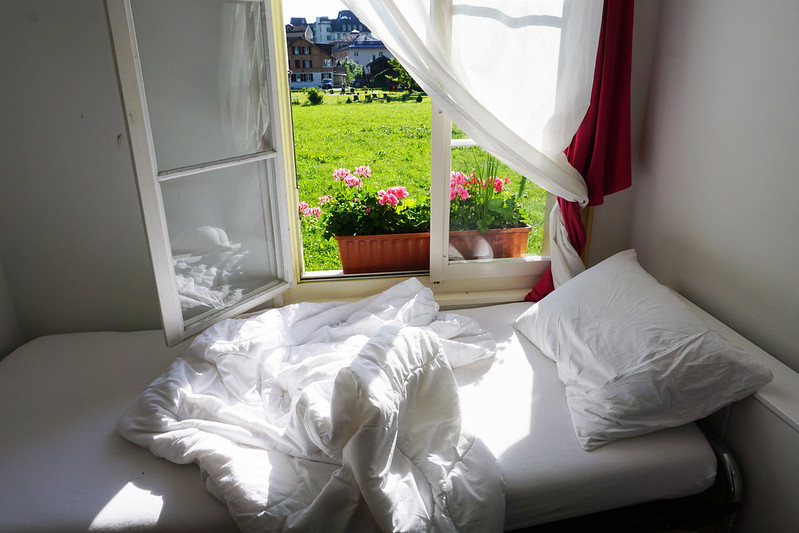
Food: Perhaps unsurprisingly, this foodie’s second highest expense is meals. I track my spending on groceries separately from my spending on eating out. I don’t put a budget ceiling on groceries because eating fresh, high-quality food is really important to me and I’d rather spend a bit more on groceries (and a bit less on other things) than take shortcuts with my health or joy.
In the states, I shopped at organic grocery stores and tried to buy healthier options, which were often a bit pricier. In Europe, I shop at fresh markets, local butchers, and tiny bakeries most of the time and stay away from imports that might have questionable chemicals or ingredients.
I always strive to only buy what I need and to buy it in the best quality, most local form I can. I mostly cook at home instead of eating out and when I do eat out I go for quality over quantity.
Recent grocery budgets have run about $393 ( Zagreb, Croatia ), $614 ( Thun, Switzerland ), $653 ( Bad Ischl, Austria ), and $429 ( Tartu, Estonia ). Eating out budgets in those same locations were around $257 (Zagreb), $0 (Thun), $41 (Bad Ischl), and $88 (Tartu). This means totals for those three places landed at $650 (Zagreb), $614 (Thun), $694 (Bad Ischl), and $517 (Tartu). As you can see, food spending varies, but not enormously. If you read my older budgets, you’ll also notice that the average has gone up over time (which makes sense, because inflation).

Transportation: Since I tend to stay longer in one place, transportation costs generally run pretty reasonable (e.g. far less than I spent when I owned a car). Every month or two, I buy a long-distance train ticket or two, and maybe once or twice a year I take a flight (though I try to fly as little as possible both because I hate flying and I try to be conscious of my environmental footprint).
In between big train journeys, I choose to walk whenever possible (which, in Europe, is nearly always) and only take buses and metros when the weather is walking-prohibitive, if the walk would be more than an hour long, if I’m carrying something heavy, or if I’m in a particularly busy city and the walk would be crowded or stressful.
These days, I spend anywhere from about $25 (Prague unlimited monthly transit pass) on a month where I’m staying put to $300ish (trains from Rennes, France, to Prague, Czech Republic) on a month when I’m moving from one base to another.

Luna the traveling pooch’s food and care: This varies a little from country to country, but rarely exceeds $200 per month. Luna eats a homemade diet primarily consisting of rabbit, fish, quinoa, and veggies (the diet was created with a veterinary nutritionist and if you decide to do the same, I highly recommend hiring one through your vet), and I’m not very strict about separating her food budget from mine, so expect that some of the grocery budget is actually going to Luna.
As with human health care, I’ve found vet care to be significantly more affordable in Europe (compared to the US). In Latvia, four injections, a blood test, two weeks of pancreatic enzyme pills, a vet consult, and an exam cost just over $100. In Dubrovnik, Croatia, in a similar vet emergency, the bill for the sedation, IV fluids, blood work, x-ray, exam, anti-nausea shot, and 100 days worth of pancreas pills was about $150. In the US, the cost would have been at least tripled in each of those cases. A single blood test in Colorado cost us upwards of $200 last time we were there.
Entertainment/fun money: When I’m traveling, most of my activities are free or cheap, so this line item is always pretty small compared to the others.
Supplies: These tend to run less abroad as well, in part because I am careful about what I buy, since I carry everything on my back, and, in part because I’m less bored and thus feel less of a need to shop. The ironic and wonderful thing about this is that the things I buy are often higher quality and more expensive, yet I generally spend less overall than I did in the states.

Health insurance and healthcare : Since I’m currently based in Portugal, I’m relying on the local health system. While traveling more extensively, I previously paid $268 per month for GeoBlue insurance that covered me anywhere in the world except the US. Before that, I tried travel insurance through World Nomads, which I found wildly frustrating (despite marketing themselves to travelers, they require you to jump through a LOT of paperwork hoops that require access to printers, scanners, and copy machines) and IMG Global, who ignored my emails and took months upon months to even acknowledge my claims after I was hospitalized on Malta. I would not recommend either company.
For anyone who’s used a healthcare system abroad, it’ll come as no surprise that pretty much everywhere in cheaper than the US. Pre-Obamacare, I paid $150 for three months of birth control pills in the US. A three-month supply (and a doctor visit to get the prescription) in Germany cost me under $100. In Switzerland, that number dropped to around $50. And in Vietnam, the same pills (same ingredients, different brand name) were $10 and available over the counter.
In all, I try to keep monthly spending under $2,500 (not including my business spending). And even with this as my budget ceiling, I often come in under. A few months ago, I did the math on the 30+ real Europe travel budgets linked below (scroll down for links) and the monthly average came in at $1,637 .

For those who’d like a more detailed look at my monthly budgets around the world, here they all are categorized by price range (click on the links for in-depth details on the budgets):
My real monthly budgets
From cheapest to most expensive monthly budget. Click on each location for a more detailed breakdown.
Non-European locations are marked with an *. My favorite places appear in bold. Cost is in parentheses. And I’ve indicated the year the budget is from (obviously account for some inflation when using budgets from 10 years ago) and whether the budget was solo travel or traveling with a partner/friend (partnered travel typically means lower housing costs).
Under $1350 per month:
Konjic, Bosnia and Herzegovina / one month ($1157) 2017 / partnered
Labin, Croatia / one month ($1175) 2021 / solo
Tartu, Estonia / one month ($1213) 2020 / partnered
Tulum, Mexico / one month ($1232)* 2018 / partnered
Kotor, Montenegro / one month ($1253) 2019 / partnered
Mostar, Bosnia and Herzegovina / one month ($1296) 2017 / partnered
Sayulita, Mexico / one month ($1301)* 2013 / solo
Riga, Latvia / one month ($1313) 2019 / partnered
Split, Croatia / one month ($1317 & $1241) 2019 & 2013 / partnered & solo
Zagreb, Croatia / one month ($1337) 2018 / solo
Playa del Carmen, Mexico / one month ($1350)* 2013 / solo

Under $1,500 per month:
Taormina, Italy / one month ($1364) 2017 / partnered
Porto, Portugal / one month ($1366) 2022 / solo, living full-time here
Kranjska Gora, Slovenia / one month ($1385) 2017 / partnered
Toledo, Spain / one month ($1388) 2015 / solo
Kobarid, Slovenia / one month ($1422) 2015 / solo
Brasov, Romania / one month ($1433) 2018 / partnered
Dubrovnik, Croatia / one month ($1443) 2017 / partnered
Tallinn, Estonia / one month ($1460) 2019 / partnered

Under $1,700 per month:
Interlaken, Switzerland / one month ($1558) 2019 / partnered
Ljubljana, Slovenia / two weeks ($808) 2015 / solo
Bad Ischl, Austria / one month ($1618) 2020 / partnered
Rennes, France / one month ($1648) 2018 / partnered
Nerja, Spain / one month ($1689) 2015 / solo
Edinburgh, Scotland / one month ($1697) 2012 / solo

Under $1,800 per month:
Ljubljana, Slovenia / second stay, one month ($1735) 2017 / partnered
Grenoble, France / one month ($1739) 2018 / partnered
Prague, Czechia / one month ($1752) 2018 / partnered

Under $2,000 per month:
Perugia, Italy / one month ($1882) 2013 / solo
Flagstaff, Arizona / one month ($1893)* 2016 / solo
Rome, Italy / one month ($1911) 2017 / partnered
Chamonix, France / two weeks ($962) 2015 / solo
Vancouver, Canada / one month ($1988)* 2016 / partnered
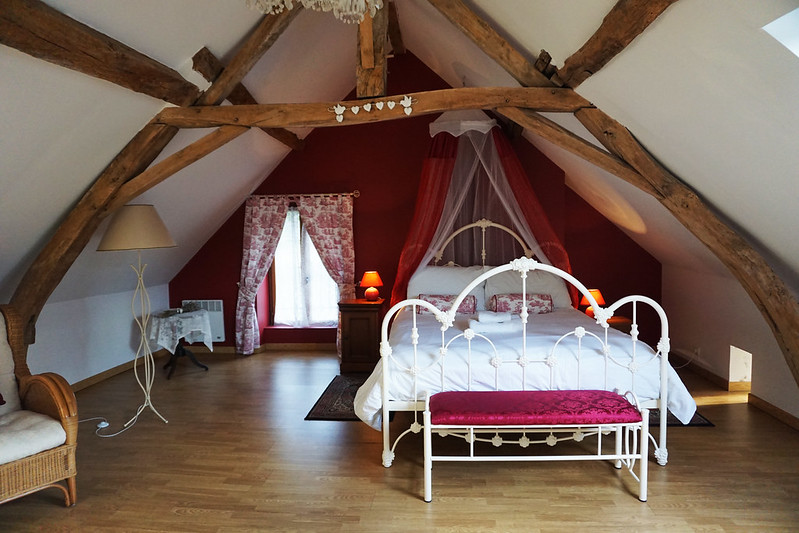
Over $2,000 per month:
Lauterbrunnen, Switzerland / three monthly budgets compared (varies) 2015 (and before) / solo
Amsterdam, Netherlands / two weeks ($1008) 2015 / partnered
Biarritz, France / one month ($2029) 2014 / solo
Innsbruck, Austria / one week ($511) 2018 / solo
Paris, France / one month ($2118) 2013 / solo
Thun, Switzerland / one month ($2124) 2021 / partnered
New York, New York, USA / one month ($2297)* 2018 / partnered
Zagreb, Croatia / one month splurge! ($2320) 2021 / solo
Opatija, Croatia / one month splurge! ($2897) 2021 / solo(ish)
Cycling across France / one month ($3091) 2015 / solo

My budgets for shorter trips
Now, what about short trips? Weekends, overnights, week-long vacations? I’ve got some real budgets on those too, though they’re fewer and farther between for me. Here are they, from cheapest to most expensive per-day:
Vrbovsko, Croatia / 3 days ($87 / $29 per day) 2021 / solo
Plitvice Lakes National Park, Croatia / 3 days ($184 / $62 per day) 2021 / solo
Denver to LA road trip / 2 days ($207 / $103 per day)* 2012 / solo
Tbilisi, Georgia / 10 days ($1050 / $105 per day)* 2019 / partnered
Colmar, France / 5 days ($539 / $108 per day) 2019 / partnered
Paris, France / 5 days ($663 / $133 per day) 2019 / partnered
Emilia Romagna, Italy / 5 days ($776 / $155 per day) 2014 / solo

Business costs
It’s worth noting that you won’t see any business costs in the above budgets. My business expenses vary greatly based on what I’m working on, how much active marketing/sales I’m doing, and what kind of side projects (blogs, self-published books, etc.) I’m taking on.
The few consistent things I pay for business-wise include:
Subscriptions for Microsoft Word, Adobe Photoshop, cloud storage, and a media subscription or two.
I now own a cell phone (turns out living full-time in Portugal requires one), but I also need a US number, so I use TextNow on my iPad for US calls/client calls. The basic number is free (because they serve up ads), but I pay a small fee in order to get a few extra benefits.
Business insurance , which runs me about $50 per month, and a yearly fee (about $100) for my registered agent to handle my LLC renewal and receive any business mail for me.
Once a year or once every few years, I also have expenses for web hosting and domain renewal for the website. This usually costs me less than $100 per year.

Taxes: Finally, a note on the most unavoidable of all expenses – taxes. In general (though not in every case), you are expected to pay taxes in the place you reside. If you live in the US, you pay in the US. If you live in Switzerland, you pay in Switzerland.
If you’re from the US, you’ll always have to file US taxes even if you’re a resident abroad, but you may be eligible for the FEIE , which is basically there to prevent you from paying double taxes. (Rather than get into it further here, I’ll suggest you book a consult with a US tax accountant. Many do free first consults and they will know so much more than I do about all the ins and outs of your particular situation.)
NOTE: If you’re paying in the states and self-employed, taxes are due quarterly, not yearly. This means when I’m paying in the States, I sit down every quarter and calculate the taxes I owe and send the government a check. At the end of the year, I hire a tax whiz (which generally runs me another $350 – $500) to help me make sure everything has been paid and filed properly.

Air travel expenses (& other big one-time costs)
There are a few things I don’t budget for monthly (or include in my monthly budget posts) because they are yearly or quarterly expenses and may vary greatly from month to month. One of these things is plane tickets .
I’m not a traveler who flies a lot, preferring to explore one continent thoroughly at a time and take trains where possible both because it’s simply a more pleasant way to travel, because it’s more environmentally responsible, and because the older I get the worse my motion-sickness gets, so flying has stopped being even a little bit fun.
So, since I’m not buying them monthly or even bi-monthly, I usually don’t track plane ticket costs monthly and instead factor them into my budget on a quarterly or yearly basis.
In 2021, I took four flights (one-way Switzerland to Croatia, one-way Croatia to Portugal, then round-trip Portugal – Croatia to collect my visa). In 2022, I only took one (one-way from Paris to Porto – I took trains in the other direction).
Replacing technology (my laptop or tablet), big one-time medical expenses, and other large one-time purchases (like my folding bike) are also something I look at quarterly or annually rather than monthly.

Saving money while traveling full-time
Finally, for me, part of feeling comfortable starting my business and then, a year or so later, leaving to travel full-time was having a decent financial buffer in the bank. I was advised while starting my business to have at least six months worth of expenses in the bank just in case. Being a bit neurotic about money, I waited until I had 10 months and enough clients that I was already almost breaking even.
Similarly, when I started traveling, even though I would be working normally and hopefully earning normally, part of feeling comfortable was the knowledge that I had a buffer. If all my clients ditched me in month one, I could live for a year without income (assuming I lived relatively frugally).

Everyone operates differently on this. When my aunt started her business, she quickly went into debt. Yet she was wildly successful over time. I’ve also heard stories of those who moved to a cheap part of Asia to start their business, which meant the limited funds they had could last them much longer while they got things off the ground. I know one man who told me it’s going to take $150,000 to start his business. Another woman told me a success story that started with just 3,000 euros in the bank. An old roommate told me she’s been traveling and working for years with just a few hundred euros to her name.
My income is variable , but I also try to set aside a decent percentage each month for the future –both to tackle unexpected expenses or emergencies, to be prepared for my yearly tax bills, and, of course, to create more security for myself in case I ever cannot or no longer want to work.

Any expenses you tend to have during travel that I haven’t mentioned? Any questions about travel expenses and budgeting? Toss them in the comments.
Share this post!
You may also like
What’s the cost difference between solo and partnered travel, how much does it cost to spend two weeks in ljubljana, slovenia, how much does a trip to switzerland’s bernese oberland cost, how much does it cost to spend a month in tartu, estonia, the real cost of one foodie’s week in paris, how much does it cost to spend a month in riga, latvia, leave a comment cancel reply.
Save my name, email, and website in this browser for the next time I comment.
17 comments
This is so cool. Thank you for this.
I’m living in a tiny house on a farm right now, but after my kid graduates high school I – or perhaps both of us – have considered living like this for a while. I’m building up my author/editor business, and it certainly would be nice to get around. I get really restless staying in one spot too long.
Glad you enjoyed it! And good luck!
Idnloke to know more about working abroad
If you are looking for info on my freelance career, here’s the skinny: https://gigigriffis.com/how-i-make-money-while-traveling-the-world-full-time-behind-the-scenes-with-a-location-independent-writer/
If you are looking for info on jobs abroad, I’m sorry to say I don’t have much info on that.
I’m not brave enough to try this with my husband and two kids, but I loved reading about how you do it! Kudos!!
Thanks for sharing your experience! This gives us an idea of how to budget for travel in Europe.
I am really enjoying following your adventures. I am waiting for a Portuguese residency permit and will be dipping my toe in the nomadic water soon. One question I am grappling with – what do you do for health insurance when you are back in the US?
For short trips, I get a temporary travel insurance plan (something like World Nomads even though their paperwork hassles are epic). But I think many European health plans also cover emergencies outside Europe, so might be worth looking into whether your Portuguese insurance will cover you once you’re resident there (I know in Switzerland the insurance we looked at covers US travel).
Amazing post!! Thanks for the detailed breakdowns. So happy to have found your site – it’s SO helpful and informative for slow travelers.
Great post! Thanks for sharing these insights with everyone. I wonder if you might answer a tax question. If one were to travel 1-3 months in each country, does that mean you need to file taxes in each of those countries plus the US?? I get if one were in the same country for over 6mo then that country would probably be considered the country of residence for tax filing purposes but what about when hoping county to county, never staying in any one country longer than 3mo??
Thanks in advance for any insights on my tax question!
Most countries don’t consider you a tax resident until you’ve been there more than 180 days in a year. Most tax accountants will do a free consult if you would like a professional perspective on your specific situation, though!
i’m a new dog owner (about 9 months) and also planning for a 6-month travel sabbatical in about 1.5 years. i’m still debating whether i should take my yoshi with me (he’s a 13 lb chiwienie). I’ve never flown with him before, and I’m wondering if you have any tips and tricks to help ease him into the process? you’re an inspiration!
Thanks! If you haven’t already, I’d read the Luna the traveling pooch section of the blog. https://gigigriffis.com/category/luna/ . There’s tons of stuff in there. The short answer is lots of treats and comfort toys inside the carrier (with the carrier open) in your house to get him used to and feeling safe in the carrier.
Thank you a million times over!
Thanks, Gigi. I needed this. It gives me courage as a single 55 yo American dude. I need some challenge in my life…something to conquer…something that will keep me on my toes. I’ve always suffered from bouts of wanderlust and I’m just plain DONE with corporate health/academic full time work. I did a back-of-the-envelope calculation on my expenses and came out around 2,200/mo traveling mostly in European Union with time in Serbia, Montenegro, B/H, SE Asia, Georgia and Turkey to mitigate the Schengen rules. Any reason you spent so little time in the Balkans? Is it a solo-female traveler thing? Sadly Russia appears off the list. I have spent a fair amount of time there before.
I have savings and a professional license (planning to do consulting over zoom). I plan to work part time (10-12 hours/wk) while honing film photography, reading for pleasure, learning about local history, and making friends. My budget is a bit lighter for accommodations (I don’t mind living in an Airbnb room) and heavier on LOCAL travel. I want to hike and spend time shooting landscapes in the areas I choose. This is a giant question mark in my mind. How to get to these places without a vehicle? I’m a bit reticent about using a scooter and don’t want to spend a fortune on taxi. I’m thinking there might be local bus service that gets me close in many places? Any insights here would be appreciated.
Your style is very much how I view my own journey. Stay in one place 1-2 months to maximize accommodation expenditures, minimize European touristy museums (been there done that—going to 1-2 local gems is my thought), mostly eat at home, and take rail day trips once a month with a night-over. Kudos for avoiding the BIG European cities. That is exactly my plan. I don’ think you could force me to spend time in Paris for more than 3 days, mirroring my aversion to New York, Chicago and LA. Lol.
Once again, thank you for the inspiration! Hit me up on email if you like. If you have any tips on making local friends in the places you traveled, I’m all ears. Stay safe and pleasant travels!
Hey! Glad it’s helpful and good luck!
To your questions:
1) I actually spent quite a lot of time in Croatia (in fact, got a visa for a year after living in Estonia 1.5 years during the whole covid fiasco). The Balkans outside Croatia are a touch trickier because of infrastructure (which goes to your second question, I suppose). There’s less train/bus access, so they are trickier to get to and trickier to get around without a car (and I detest driving). Croatia definitely has better infrastructure than some other spots, though I did enjoy my jaunt into Bosnia and Montenegro.
The other reason is the dog. They tend to be the less dog-friendly options in Europe. I felt fine as a woman traveling solo, but the dog complicates places like Bosnia (which I did spend some time in, despite this) and Albania.
2) The Schengen countries (for the most part, with a few exceptions) have great public transit, so I relied on that. For hiking/wilderness areas, I find that there is transit but it sometimes runs less frequently, so I just had to plan well and sometimes find myself a base very close to the wilderness areas to stay for at least a few days (I did this, for instance, for Bohemian Switzerland in Czechia). Other places (Switzerland, France) often have trails very integrated into every location and/or transit to even the remotest spots.
The places that are a bit more tricky tend to be places on the edges of Europe (the center is very well connected). So I had to get more creative in places like Portugal, Spain, and Estonia, which have somewhat less extensive public transit and more car culture. (Even so, I have never rented a car in any of those places and have relied on everything from infrequent buses to my bicycle to taxis or rideshares.)
Great! Thank you for the insights! I poked around your blog and found solid information on making friends. Funny, having a meal at home with a handful of people is definitely my style. :) I enjoyed many of the images on your blog. Particularly one from Italy with the path going along that turquoise river. Sublime! Excellent information on the hiking trails in different countries and your tip on staying close to trail systems for a handful of days. Lastly, your travels helped me to discover the inclusion of Portugal to the digital nomad parade! That’s particularly exciting to me as my younger brother and fam are planning a permanent move to Portugal (getting tired of Seattle/US health care/foods). Looks like potentially a more lengthy process? What an amazing time to see the world and work from anywhere! New DM visas are also popping up in SE Asia. Cheers!
This website uses cookies to improve your experience. Opt-out here if you wish! Accept Read more
Share on Mastodon
Travel Europe on a Budget
The Savvy Backpacker
City Guides .\33 a132798-3f3b-4585-954d-7e70cf863447{fill:#231f20}
How much does it cost to travel europe | in-depth breakdown real travel costs.
Let's take a look at how much you should budget for your trip to Europe!
Money & Budgeting

Everyone who has ever dreamed of visiting Paris, London, Rome, Barcelona, and other great European cities has had the same question— how much does it cost to travel to Europe?
Trying to wrap your head around all the travel costs is daunting, so that’s why I’ve analyzed the average food, accommodation, transportation, entertainment, and other prices from many of Europe’s top destinations to help you more accurately budget your travel expenses.
I’ve also factored in other common travel costs you might forget like pre-departure spending, airfare, train tickets, rail passes, travel gear, and more.
And since many of you have different travel styles, I’ve been sure to include the price breakdowns for backpacker-style travel , budget-conscious travel , and mid-level/higher-end travel — since that will obviously greatly affect your budgeting and spending.
Quick Look At Daily Europe Travel Costs By Travel Style

Before we dive deep into the costs of visiting Europe, let’s take a high-level look at typical day-to-day travel costs broken down by travel style.
Note: I’ve gone much more in-depth into these travel costs further on in this article — the prices in this section are ballpark figures.
Backpacker-Style Travel Costs: €45-€90/Day ($50-$100/day)
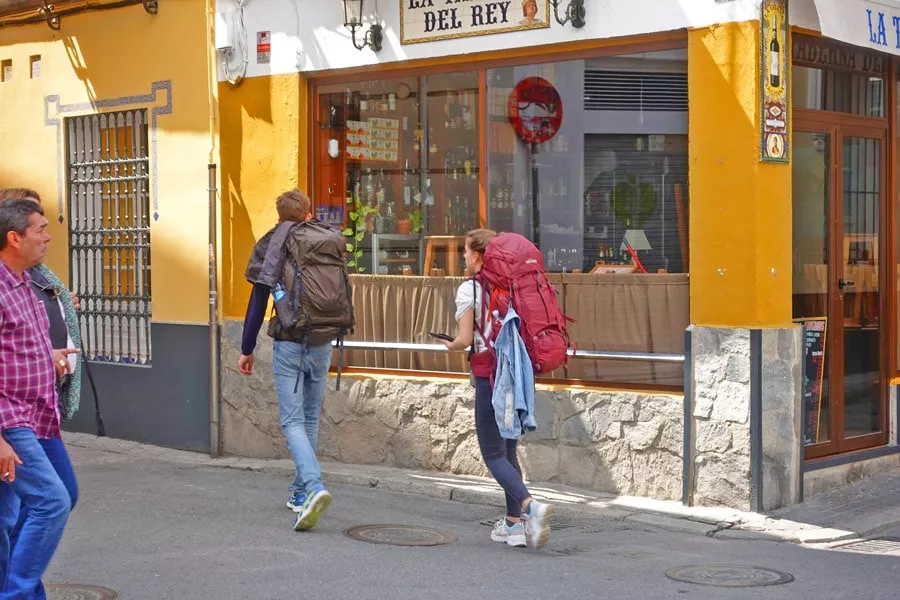
THIS IS YOU IF YOU’RE staying in hostels, eating cheap meals, or making your own food. You’re only drinking in dive/local bars, during happy hour, or buying alcohol from the grocery store. You’ll seek out cheap/free entertainment options. For transportation, you’ll use a rail pass or carefully pre-booking train tickets. You don’t mind foregoing creature comforts in the name of saving money.
In short, you’re looking to travel as cheaply as you can .
Average “Backpacker” Travel Cost Breakdown:
- Hostel Prices: A cheap bed in a quality hostel will cost anywhere from €15-€45/night. However, I’ve seen hostels run as high as €50-€75/night and as low as €10-€15/night depending on location, time of year, inventory, and room configuration. Check out Hostelworld to see hostel prices.
- Breakfast: I typically budget €3-€5/day for breakfast. This won’t get you much but it’s usually enough for a coffee and a croissant/pastry + maybe a piece of fruit. Sometimes hostels will provide a free breakfast.
- Lunch: If eating out, I budget anywhere from €6-€12 for lunch. This will get you a simple takeaway meal but you can cut this cost down if you make your own meal from a grocery store.
- Dinner: As with lunch, a takeaway meal will cost around €7-€10 but a meal at a cheap sit-down restaurant will cost around €8-€17. Obviously making your own meal will be a cheaper alternative.
- Alcohol: Beer and wine are cheap in grocery stores — a decent bottle of wine is €5-€6 and a 6-pack of beer is €5-€8. In bars/restaurants, a glass of wine is typically €3-€6 and beer is around €3.5-€7.
- Coffee: I budget €1-€1.5 for an espresso for a cheap caffeine fix.
- Desserts and Treats: I have a sweet tooth so I budget €2-€3 for random goodies.
- Attraction and Sightseeing Prices: I’m a big fan of free walking tours and I typically tip around €5-€8. Many museums have free days/times so that’s a good way to save — otherwise, museum tickets are typically €8-€20.
- Public Transportation: I tend to mostly walk so many days I don’t spend anything on transportation. Otherwise, I recommend budgeting €3-€5/day for the subway/buses.
Budget-Conscious Travel Costs: €90-€200/Day ($100-$220/day)

THIS IS YOU IF YOU’RE staying in affordable rental apartments, budget hotels, or you might get a private hostel room. You’re happy to spend €15-€25 on a meal now and then and you’ll splurge on a few treats as you explore. You don’t mind paying for experiences, and you’re happy to travel via train without booking weeks early to save a few dollars.
In short, you’re smart with your money but you don’t mind spending money on good values.
Average “Budget-Conscious” Travel Cost Breakdown:
- Rental Apartments: Airbnb is huge in Europe so it’s easy to find an affordable place in just about any city. A basic studio/1br will typically cost €60-€180/night.
- Budget Hotels: You can typically find a basic, yet clean and comfortable hotel for around €80-€120/night. I mainly use Booking.com when traveling in Europe.
- Private Hostel Rooms: Most hostels have private rooms that are about the same quality as a budget hotel — which is a nice option if you like the social vibe found in hostels. Expect to pay €60-€100/night for a private room.
- Breakfast: I typically budget €5-€6/day for breakfast since I need energy as I walk around all day. Different countries have different breakfast traditions so I tend to eat what the locals eat — which rarely tops €6. But, at the minimum, most cafes will have breakfast deals that include espresso and a pastry for around €3.
- Lunch: A cheap takeaway meal will set you back €5-€7. I try to seek out fixed-price lunch specials which typically run €9-€13.
- Dinner: A quality meal at a budget-friendly restaurant will set you back around €12-€20.
- Alcohol, Coffee, Treats, Etc.: Beer and wine are cheap in grocery stores — a decent bottle of wine is €5-€6 and a 6-pack of beer is €5-€8. In bars/restaurants, a glass of wine is typically €3-€6, and beer is around €3.5-€7. Cocktails can set you back €6-€12+.
- Coffee: I budget €1-€1.5 for an espresso. A cappuccino might cost anywhere from €1.50-€3.50.
- Desserts and Treats: I have a sweet tooth so I budget €3-€5 for random goodies like gelato and pastries.
- Attraction and Sightseeing Prices: Even as a budget traveler, I’m still a fan of free walking tours so I typically tip around €5-€8 for those — but a paid walking tour starts around €15-€20/person. Museum tickets are typically €8-€20.
- Public Transportation: I tend to walk everywhere but I still recommend budgeting €3-€6/day for the subway/buses.
Mid-Level Travel Costs: €150-€300/Day ($170-$340/day)

THIS IS YOU IF YOU’RE staying in nice (but not luxury) hotels or rental apartments. You’re not dining in high-end restaurants but dropping €25-€35 on a random meal isn’t that big a deal. You’re perfectly fine spending a little extra on train tickets for convenience and flexibility. You’re happy to visit all the museums/attractions without fear of busting your budget. You might even book a few “experiences” like a paid walking tour or a cooking class.
In short, you’re not “living large” but you’re comfortable spending a little extra here and there to enhance your experience and get the most from your travels.
Average “Mid-Level” Travel Cost Breakdown:
Budget Hotels, Rental Apartments, and Private Hostel Rooms: Accommodation prices are all over the place and constantly changing based on multiple factors. Obviously, traveling with other people will lower the per-person travel costs if you’re sharing a room/apartment.
- Rental Apartments: Airbnb is huge in Europe so finding a nice rental apartment isn’t difficult. A nice studio/1br will typically cost €120-€200/night.
- Hotels: A nice, but not fancy, hotel in a good location will typically cost €120-€180/night. I mainly use Booking.com when traveling in Europe.
- Breakfast: I typically budget around €6/day for a basic breakfast but a heartier one will be closer to €10.
- Dinner: A quality meal at a budget-friendly restaurant will set you back around €12-€20. A slightly nicer meal will be around €20-€30.
- Alcohol: In bars/restaurants, a glass of wine is typically €3-€6 and beer is around €3.5-€7. Cocktails can set you back €6-€12+.
- Coffee: Espresso starts around €1 and fancier drinks are €2.50-€4.
- Desserts and Treats: I have a sweet tooth so I budget €3-€5 for random goodies like gelato, pastries, and other sweet treats.
- Attraction and Sightseeing Prices: Museum tickets are typically €8-€20 each. Paid walking tours are anywhere from €15-€35. I enjoy cooking classes and those are anywhere from €45-€100+.
Pre-Departure Europe Travel Costs

Alright, let’s start doing a deeper dive into discovering how much it costs to go to Europe. We’ll start with pre-travel costs that should be factored into your budget.
High-Speed Mobile Data: $3-$10/Day
You can survive traveling to Europe without having mobile data on your phone but I don’t recommend it.
Your current mobile provider likely has their own international plan which will be around $10-$15/day. Or you can buy a European SIM or eSIM data plan that will cost under $5/day—for example, eSIM data plans from Orange or Holafly will cost you around $2-$4/day.
You can learn more on The Savvy Backpacker’s guide to the best eSIM for Europe and my guide to Data Plans and Smartphone Phones in Europe .
Travel Insurance: $30/Week
Travel insurance can really save your butt financially, so I build it into my travel budget. It’s usually fairly cheap and it might save you thousands of dollars in medical and travel costs. I use and recommend World Nomads for most travelers but there are a handful of other travel insurance companies.
As a rule of thumb, plan on spending around $30/week on travel insurance.
Luggage and Travel Gear: $0-$500+
In many cases, you might already have a suitcase or travel backpack so you may not even need to buy any special clothing for your trip to Europe.
But many people still choose to buy travel gear and/or clothing to help make their trip easier. Obviously, the amount you spend on this stuff can be $0 or it can easily top $500.
I’ve created a few packing lists and gear guides to help guide you:
- Backpacking Europe Packing List
- Travel Europe Packing List for Women
- Europe Packing List
- Winter Packing List for Europe
- Best Travel Backpacks
- Best Travel Backpacks for Women
- Best Carry-On Backpacks
- Best Travel Shoes
My Most-Recommended Travel Gear
Here are some things I never travel without (but see the guides above for more in-depth gear recommendations).
- Portable Phone Charger: I use my iPhone a ton when traveling and this kills the battery. That’s why I carry a small charger everywhere I go. You can find many options for $20-$30. Check Out Prices/Selection On Amazon
- I prefer carrying a stylish bag that doesn’t scream “tourist” — like something from Fajallraven , Herschel , and Aer . These bags range from $50-$90.
- Comfortable Shoes: A nice cool pair of comfortable sneakers will be your best friend when you’re traveling around Europe. Here is an article I wrote about wearing sneakers in Europe .
- Quality Socks: Treat your feet well and they’ll reward you with comfortable travel. I stick with socks from Smartwool and Darn Tough . A nice pair of socks will be $8-$14.
- Guide Books: Call me old-fashioned but I’m still a big can of guidebooks. For budget travel, I prefer Rick Steves and Lonely Planet. Check Amazon as they have a great selection of Europe guidebooks. Most guidebooks are around $20.
- Packable Rain Jacket: I hate umbrellas so I always pack a lightweight rain jacket that’s easy to store away in my daypack. The Patagonia Houdini weighs in at a crazy light 3.6oz and can be found online for $75-$99 (Available via REI and Amazon ).
- Apple AirPods: I love my AirPods. They make listening to music and watching movies on my iPad so much more convenient — especially on planes/trains. They’re cheaper on Amazon than from Apple.
Passport: $110+
It will cost you around $135 if you need a passport. Be sure to apply early because it will cost you another $60+ if you need one in less than 4-6 weeks. Passport photos will cost you about an extra $10 or you can print your own for free at ePassportPhoto .
Airfare Prices To Europe ( $750-$1200 )

It’s hard to nail down how much you’ll spend on your flight to Europe. Prices fluctuate wildly based on your location, the time of year, what days you’re traveling, where you’re flying to, how early you’re booking your flights, your flexibility, etc.
I’ve paid as little as $280 for a ticket from NYC to Copenhagen and I’ve paid $1,200+ for other flights to Europe. That said, I recommend budgeting at least $750-$1100 for your flight — hopefully, you’ll be able to find cheaper flights but this is a pretty good ballpark figure.
I use Google Flights and Momondo to look for flights. I also subscribe to Scott’s Cheap Flights newsletter which sends out daily cheap flight deals.
Estimating Transportation Costs Within Europe

Another large travel cost will be transportation — i.e. how much you’ll spend physically traveling around Europe.
There are generally four main modes of transportation:
- Train: My favorite travel option. It’s generally fast, convenient, comfortable, and affordable (if you book in advance). Train travel is also the most romantic way to travel around Europe.
- Plane: For long distances, I prefer flying as there are plenty of very cheap flights throughout Europe.
- Car: Driving can be a nice option if you’re traveling in a group as the cost gets spread out between multiple people. And you can visit smaller destinations more easily with a car (although just about every town in Europe is accessible via train). That said, I’d avoid driving in any major European city if possible.
- Bus: I’ve never like traveling via bus but it can be a very cheap way to travel.
Europe Train Ticket Prices

Each country prices its train tickets differently — some charge via distance traveled (€/mile) but most have dynamic pricing that fluctuates based on demand (i.e. similar to how airlines price their tickets). For this section, we’ll focus on high-speed trains as that’s what most travelers will use to travel between major cities.
For more information, read our Complete Guide To Train Travel In Europe .
Example High-Speed Train Prices For Popular European Routes
Note: I used Omio to find these train ticket prices — I’ve been using Omio to book all my European train tickets for the past few years. I love that their tickets are mostly digital/mobile (via their App) so no more standing in line to buy/collect tickets.
- Booked a few weeks before departure: €66-€100
- Booked two or three days before departure: €190-€250
- Booked a few weeks before departure: €70-€100
- Booked two or three days before departure: €135-€155
- Booked a few weeks before departure: €13-€22
- Booked two or three days before departure: €20-€40
- Booked a few weeks before departure: €45-€75
- Booked two or three days before departure: €45-€75
- Booked a few weeks before departure: €45-€70
- Booked two or three days before departure: €45-€70
- Booked a few weeks before departure: €24-€43
- Booked two or three days before departure: €24-€60
- Booked a few weeks before departure: €25-€35
- Booked two or three days before departure: €25-€35
- Booked a few weeks before departure: €91-€100
- Booked two or three days before departure: €91-€100
- Booked a few weeks before departure: €14-€30
- Booked two or three days before departure: €20-€35
- Booked a few weeks before departure: €99-€120
- Booked two or three days before departure: €133-€145
- Booked a few weeks before departure: €35-€45
Source: Omio
Eurail Pass Prices
If you want flexibility then you might consider picking up a Eurail Pass. These passes aren’t dirt cheap like they were in the past, but for many travelers, this is still an affordable way to travel. There are dozens of Eurail passes available to suit almost any need. Prices range from about $100 for a super basic pass to $2000 for a 3-month unlimited pass.
For more info, read our Guide To Rail Passes in Europe .
Airfare Prices Within Europe

Many first-time travelers are amazed at the number of budget carriers offering crazy low airfare within Europe — we’re talking €20 flights from London to Amsterdam and €35 from Paris to Rome. I’ve even seen flights for under €10.
That said, you can essentially fly between any two major European cities for less than €70 — but don’t forget to budget extra cash for transportation to/from the airport (train, taxi, Uber) bag fees, etc.
Quick Note About Budget Carriers and Cheap Fares: Budget carriers offer the bare minimum in terms of service and everything costs extra (bags, seat assignment, drinks, etc.). Also, many budget airlines fly out of smaller airports that are outside the cities they represent — for example, the Paris-Beauvais airport is more than an hour away from Paris so that’s an extra cost and inconvenience.
Example Cheap Airfare Prices For Popular European Routes
Note: These example fares are for one-way tickets—I suggest checking Momondo for your exact travel dates since prices constantly fluctuate.
- London To Paris : €32-€52
- Paris to Rome: €32-€100
- London to Rome: €60-€100
- Rome to Lisbon : €35-€45
- Paris to Lisbon: €70-€120
- Amsterdam to Berlin: €32-€45
- Madrid to Lisbon: €45-€70
- Paris to Barcelona : €25-€35
- Paris to Lyon : €50-€85
- Copenhagen to Paris: €65-€100
Cost To Rent A Car In Europe

Renting a car can be a reasonably affordable way to travel Europe — especially if you’re traveling in a group of three or more.
I just did a search for a weeklong rental in France for a compact car and it was around €200 total. However, there are other costs associated with driving in Europe:
- Gas ($6-$8/gallon)
- Tolls (I’ve seen €3-€30 per toll)
- Random taxes
- Extra insurance ($10-$20/day)
- Parking (€40+/day in major cities)
- Extra random fees
Here is our guide to renting a car in Europe that goes into more in-depth detail.
Cost of Coach/Bus Travel In Europe
Taking long-distance buses is probably the cheapest way to travel in Europe but it’s also the slowest and arguably the most uncomfortable. Personally, I won’t even consider the bus if the trip is more than a few hours as 8 hours on a bus sounds terrible. Either way, I use Omio to find and book bus tickets.
Example Long-Distance Bus Prices For Popular European Routes
- Paris to Strasburg: €17-€20
- Munich to Berlin: €22-€24
- Rome to Florence: €22-€30
- Barcelona to Madrid: €36-€38
- Munich to Salzburg: €17
Accommodation Costs For Traveling Europe
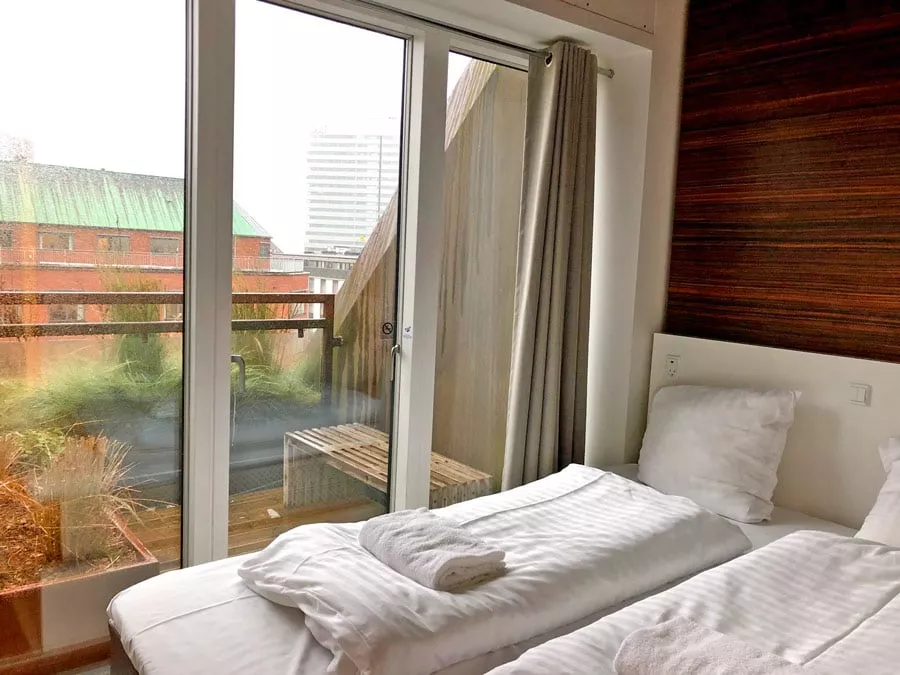
For most travelers, accommodation will be the largest expense so it’s important to know how much you should budget. Let’s dive into how much you’ll spend on accommodation (hotels, hostels, and rental apartments) while you’re traveling in Europe.
Average Hostel Prices in Europe
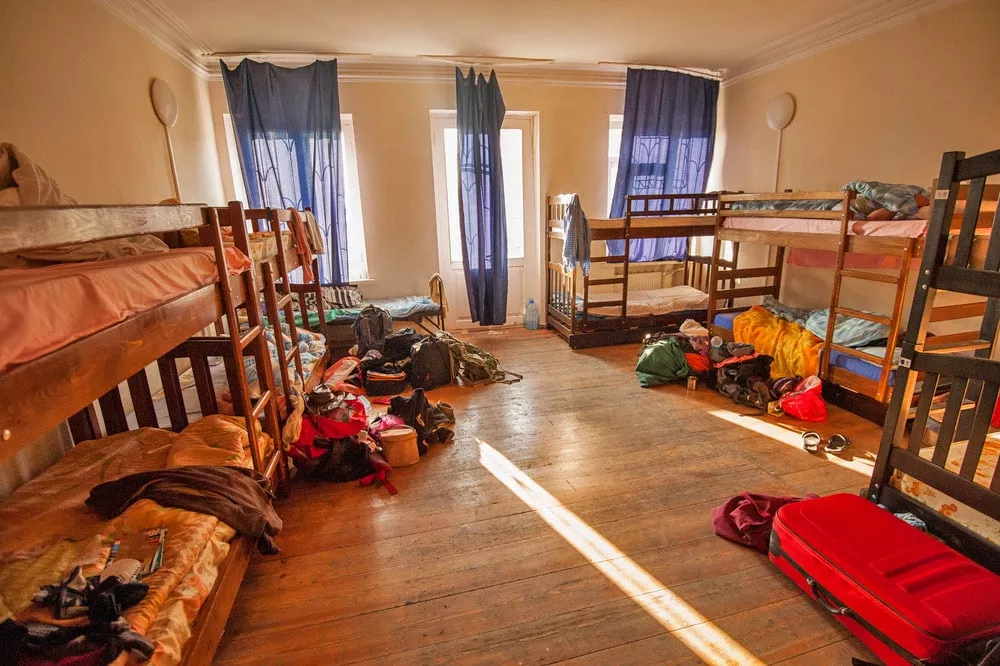
Here’s a look at the average nightly hostel price for Europe’s most popular cities. These prices reflect the cheapest option in well-rated hostels during a late June booking. These prices are from Hostelworld (my preferred hostel booking website).
- London: €30-€65/night
- Paris: €33-€65/night
- Dublin: €30-€60/night
- Amsterdam: €30-€60/night
- Munich: €35-€65/night
- Berlin: €20-€39/night
- Krakow: €14-€25/night
- Budapest: €16-€25/night
- Barcelona: €25-€45/night
- Rome: €23-€50/night
Source: Hostelworld
Average Hotel Prices in Europe
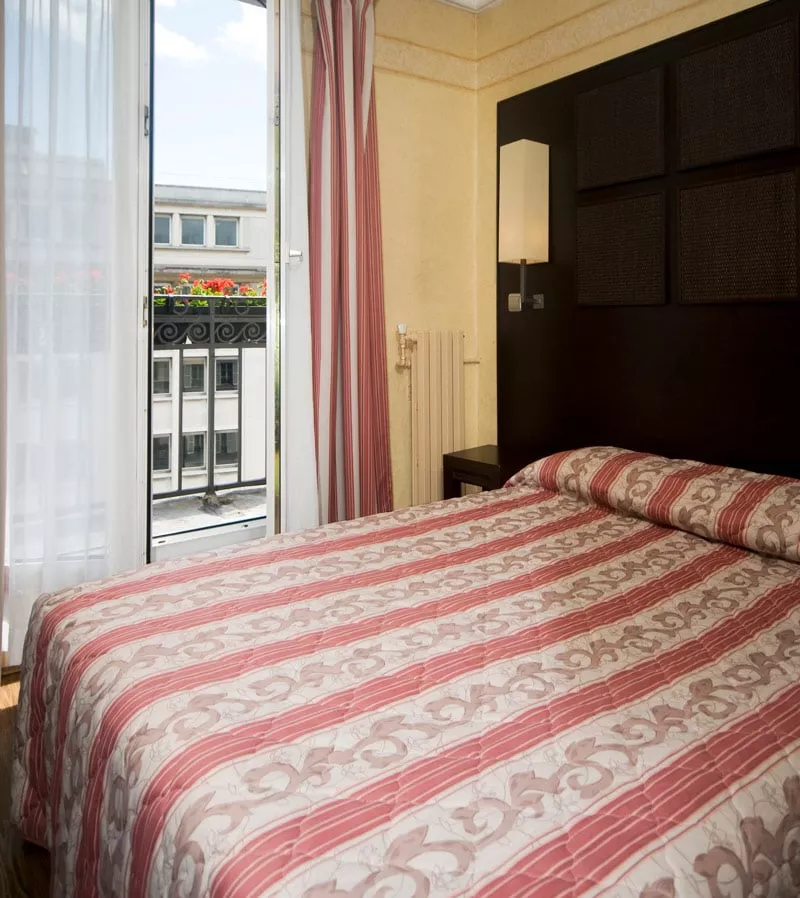
Here’s a look at the average nightly hotel price for Europe’s most popular cities.
Note: These prices reflect the cheapest option in well-rated hostels during a late June booking. These prices are from Booking.com (my preferred hotel search engine).
Nightly Price For A Budget Hotel in Europe
The prices on this list reflect budget hotels that are small, no-frills, and a little “rough around the edges” but they should be clean, comfortable, and located within the city. They get good ratings from past guests so these aren’t the bottom-of-the-barrel options.
- London: €80-€115/night
- Paris: €90-€110/night
- Dublin: €115-€140/night
- Amsterdam: €125-€145/night
- Munich: €90-€115/night
- Berlin: €85-€100/night
- Krakow: €50-€95/night
- Budapest: €50-€93/night
- Barcelona: €75-€100/night
- Rome: €80-€105/night
Source: Booking.com
Nightly Price For A Mid-Level Hotel in Europe
I consider a mid-level hotel to be clean, comfortable, fairly modern, and centrally located. The rooms will still be small and there might not be many “frills” but the hotel will be a noticeable step above the “budget” level.
- London: €140-€180/night
- Paris: €135-€190/night
- Dublin: €135-€195/night
- Amsterdam: €165-€200/night
- Munich: €110-€175/night
- Berlin: €110-€180/night
- Krakow: €75-€120/night
- Budapest: €125-€170/night
- Barcelona: €110-€160/night
- Rome: €110-€175/night
Average Rental Apartment Prices in Europe
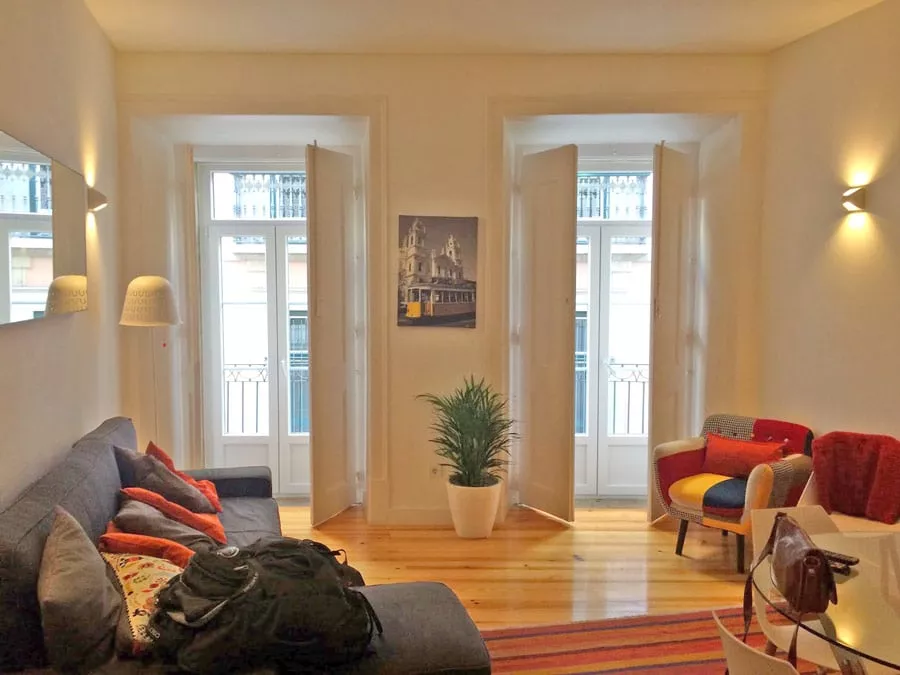
Short-term rental apartments are plentiful and often affordable in Europe, so it’s one of my favorite accommodation options when I travel.
Note: I’ve listed rental apartments from a price range for well-rated, and centrally located studio/1br Airbnb rentals that get solid reviews from former guests — I also tried to only include Superhosts to ensure a high level of service. You’ll be able to find cheaper options if you’re less picky.
- London: €190-€280/night
- Paris: €105-€160/night
- Amsterdam: €220-€300/night
- Berlin: €93-€160/night
- Krakow: €50-€85/night
- Budapest: €70-€105/night
- Barcelona: €140-€190/night
- Rome: €120-€165/night
Source: Airbnb —check out my guide to Airbnb Alternatives for more options.
Food & Alcohol Costs in Europe

Food, meals, and alcohol are other major costs that are difficult to estimate since there is a huge variation in prices. In general, I recommend budgeting higher than you think since it’s easy to go over budget without even realizing it.
To help give you an accurate idea of food prices, I’ve searched through actual menus from restaurants that span multiple price points. I’ve broken this list down by city to help you more accurately predict your potential food expenses.
Note: These prices come from well-rated restaurants that are recommended by locals. I’ve also linked to their restaurant’s Google listing.
Paris Food Prices
- Croissant: €2
- Cafe au lait: €3
- Espresso: €1-€1.50
- Sandwich from Grenier au Pain : €3.50-4.50
- Chicken and lamb kebab from Urfa Dürüm : € 6- € 8
- Burger and fries from Joe Burger : € 8- € 10
- Falafel and shawarma sandwich from L’As du Fallafel : €7-€9
- Crepes and sandwiches (takeaway) from Chez Alain Miam Miam : €7-€11
- Duck Confit from Le Petit Vendome : €17
- Duck Confit from Cafe de l’Industrie : € 13- € 14
- Crepes from Breizh Cafe : €7-€12
- Beef bourguignon (beef stew) from La Petite Rose des Sables : €13
- Pho from Pho 14 : €9
- A glass of wine: €3-€5
- A glass of beer: €4-€7
Note: See our guide to the best budget restaurants in Paris .
London Food Prices
- Full English breakfast from Breakfast Club : £10-£12
- Cappuccino from Kaffeine : £3.10
- A standard cup of coffee: £2.50
- Lamb Shawarma wrap from Hiba : £5.25-£6.25
- Vietnamese noodle dish from Phat Phuc Noodles : £8
- Traditional pie and mash from The Windmill. Mayfair : £13-£16
- Fish and Chips from Masters Superfish : £ 9- £ 10
- Fish and Chips from P oppie’s : £ 4- £ 18
- Mid-range Indian dish from Darjeeling Express : £13-£16
- Takeaway Indish dishes from TIFINBOX – Indian Street Food : £6-£8
- Dip and Flip burger from Dip & Flip : £10
- A pint of beer: £4.50-£6.50
- A glass of wine: £5.50-£7
- Mixed drink and cocktails: £8-£14+
Rome Food Prices
- Cornetto pastry and a cappuccino from Antico Forno Roscioli : €1 + €1.30
- Espresso from La Casa Del Caffè Tazza D’oro : €1
- Sandwich/panini from Panino Divino : €5-€6.50
- Takeout pizza (two slices) from Pizzarium or Pizza Florida : €5-€8
- Takeout pasta from Pasta Imperiale : €5.50-€6.50
- Pasta dish from Felice a Testaccio : €11-€15
- Cacio e Pepe from Trattoria Da Cesare al Casaletto : €11
- Carbonara pasta from Trattoria Perilli : €13
- Pizza from Ai Marmi : €7-€10
- A glass of wine: €4-€6
- A pint of beer: €4-€6
Berlin Food Prices
- Brunch and pancakes from Le Bon : €9-€10
- Breakfast and brunch items from Distrikt Coffee : €8-€11
- Espresso and Flat White from THE BARN Café : €3 & €4
- Doughnuts from Brammibal’s Donuts : €2.50
- Crepes and breakfast quiches from Cafe Creperie Melt : €3.50-€8
- Currywurst from Curry61 : €2.50
- Takeaway schnitzel from Scheers Schnitzel : €5.50-€8.50
- Burger from Burgermeister : €4.50-€5.56
- Kebab from Mustafa’s Gemüse Kebap : €4-€5.50
- Goulash and schnitzel from Tiergarten Quelle : €10.50 & €11.50
- Half chicken from Henne : €8.60
- Hearty traditional German dishes from Gasthaus Krombach : €11-€15
- A pint of beer: €2.50-€3.50
Amsterdam Food Prices
- Omelets and breakfast sandwiches from Omelegg : €6-€10
- Dutch and American pancakes and breakfast options from Prins Heerlijk : €4-€10
- Breakfast and lunch toasted sandwiches from Toastable Nieuwendijk : €5-€10
- Assorted pastries from Bakhuys : €3-€6
- Espresso and pour-over coffee from Bocca Coffee : €2.5 & €4
- Baked potatoes w/ toppings from Jacketz : €9-€14
- Roman-style pizza by the slice from Sugo Amsterdam : €3.50-€4.50/slice
- Kebab from Beste Doner : €5
- Fries with choice of sauce from Vlaams Friteshuis Vleminckx : €3-€4.50
- Fish and chips from The Good Companion : €14-€15
- Burgers from Burger Bar : €8-€11
- Simple pasta dishes from Hasta La Pasta or Pasta Pasta : €8-€14
- Traditional Dutch dishes from Hap-Hmm : €10-€14
- Wood-fired, thin-crust pizzas from Il Sogno : €10-€13
- A pint of beer: €3.50-€6.50
Barcelona Food Prices
- Churros dipped in melted chocolate from Churreria Laietana or Granja M Viader : €3.80
- Pancakes and granola/acai bowls from Brunch El Petit Princep : €4.5-€7
- Croissants and similar pastries from Baluard Barceloneta : €1.60-€3.50
- Double espresso and Flat White from Satan’s Coffee Corner : €3.20
- Espresso and drip coffee from Nomad Coffee Lab & Shop : €2.50-€4 & €3
- Affordable tapas and other local favorites from Bar Xapako : €2-€4/tapa
- Fixed menu of Spanish staples from Bar Casi : €12
- Pizza by the slice at Com a Italia : €3/slice
- Lebanese sandwiches and wraps from Teddy’s Saj Sandwiches : €4.50-€6
- Classic regional dishes from Can Culleretes (the oldest restaurant in Spain): €9-€19
- Regional rustic fare from El Glop : €9-€20
- Tapas from Quimet & Quimet : €2-€5/each
- Tapas from La Tasqueta de Blai : €5-€9/each
- Fish and chips from The Fish & Chips Shop : €8.50
- Beer (small glass): €1-€1.30
- Beer (bottle): €1.40-€3
- A glass of wine: €2.50-€4
- Glass of vermouth from Quimet & Quimet : €2.80
Madrid Food Prices
- Churros and hot chocolate from Chocolatería San Ginés : €4.20
- Torrijas (similar to french toast) from La Casa de las Torrijas : €2.50-€4
- Napolitana con Chocolate pastry from La Mallorquina : €2
- Espresso or coffee from Martina Cocina or Hola Coffee : €1.50-€3
- Fried calamari sandwiches from Bar La Campana : €3
- Small pork sandwiches from Bocadillos Oink : €4-€7
- Pizza by the slice or full pizza at La Pizzateca : €3-€4/slice or €9-€13/pizza
- Assorted tapas from Gandario , El miniBAR , and Tinto y Tapas : €2-€8/each
- Homestyle Spanish dishes from La Sanabresa : €18 (fixed price menu)
- Tortillas (Spanish omelet) from Pez Tortilla : €3/slice
- Deep-fried croquetas from Casa Julio : €7-€12
- Huevos Rotos (fried eggs and ham over french fries) from Los Huevos de Lucio or Antigua Huevería : €9-€18
- Glass of vermouth from Bodegas Ricla : €1.50
Lisbon Food Prices
- Double espresso and cappuccino from Fabrica Coffee Roasters : €2 & €2.80
- Pasteis de Nata from Pasteis de Belem , Manteigaria , or Fabrica da Nata : €1.15/each
- Various pastries from Pastelaria Alfama Doce : €.80-€1.20/each
- Pancakes and eggs from Quase Cafe : €4.50-€7.50
- Breakfast bowls and smoothies from Frutaria : €5 (breakfast bowls) & €5 (smoothies)
- Traditional local dishes at good prices from A Provinciana : €6-€9
- Pork sandwich ( bifanas ) from O Trevo : €2.50
- Burgers from Cultura do Hamburguer : €7-€10
- Grilled chicken, ribs, and sausage from Frangasqueira Nacional : €7-€1.50
- Hotdogs from Frankie : €3-€6
- Gyro from A Gama do Vasco : 7-9
- Traditional Portuguese dishes from husband and wife team at Crisfama : €9-€15
- Traditional Portuguese tavern favorites from Tasca Zé dos Cornos : €9-€13
- Large portions (enough for two) of traditional local dishes from Zé da Mouraria : €17-€22
- Beer at a bar or restaurant: €1.50-€3
- Beer at a grocery runs about €1.10
- A bottle of wine is around €4.50
Copenhagen Food Prices
- Double Espresso from The Coffee Collective : $4.20 (28 DKK)
- Cinnamon Roll from Skt. Peders Bageri : $2.75 (18 DKK)
- Breakfast Porridge from Grød : $7-$10 (45-65 DKK)
- Burger from Gasoline Grill : $11.50 (75DKK)
- Kebab/Turkish Dish from Kosk Kebab : $5.35-$11.50 (35-75 DKK)
- Hotdog from Hotdog Stand , John’s Hotdog Deli , or DOP $5.35 (35 DKK)
- Pizza from Gorm’s : $15-$19 (100-125 DKK)
- Classic homemade Danish cuisine from Restaurant Klubben : $16-$35
- Authentic Mexican food from Hija de Sanchez : $15 (three tacos)
- Vietnamese sandwiches, noodles, and other dishes from District Tonkin : $10-16
- High-End Cocktail from Ruby : $16.75-$20+ (110-120+ DKK)
- Craft Beer from Mikkeller Bar : $6.80-$10 (45-65 DKK)
Prague Food Prices
- Fancy pancakes from DEN NOC: Pancakes start under $5-$7.50
- Coffee from Cafe Ebel : $2-$4.50
- Gourmet doughnuts from Donuterie : $2.50/each
- Hot chocolate, waffles, and sweet treats from Chocafé : $3 (hot chocolate), $3.5 (waffles), $1.50-$3 (treats)
- Pancakes and coffee from Cafe No 3 : $2 (coffee) and $6 (pancakes)
- Traditional open face sandwiches from Sisters Bistro v Dlouhé : $2-$3
- Traditional Czech cuisine from Ferdinanda : $10-$14
- Traditional Czech cuisine from Restaurace Pod Vysehradem : $8-$14
- Large burgers from Sad Man’s Tongue Bar & Bistro : $11-$14
- Pizza and pizza slices from Johnny Pizza : $6.50 (pizza and soda)
- Hotdogs w/ toppings from Mr.HotDoG : $5-$6.50
- A pint of standard beer at the bar: $1.00-$2.00
- Pint of beer from a grocery store: $.65
Budapest Food Prices
- Cappuccino and espresso from 9BAR : $1.50-170
- Coffee and granola from VINYL & WOOD : 1.50 (coffee) & $4-$4.50 (granola)
- Huge cinnamon rolls, and chocolate rolls from Bite Bakery Cafe : $2.25
- Bagel sandwiches from Inez Bagel Shop : $3.50-$5
- Traditional Hungarian breakfast sandwiches from Duran Szendvics : $1-$4
- Authentic Hungarian food from Klauzal Cafe : $8-$12
- Sandwiches and soups from Bors GasztroBar : $4-$5
- Traditional Hungarian food from Regos Restaurant : $7.35-$12
- Hungarian sandwiches and burgers from Hoppacska : $5.60-$9.00
- Cheap burgers from Buddies Burger : $4-$5.50
- Local Korner: Excellent pizza in a super fun atmosphere.
- Pho from Hai Nam Vietnamese Bistro & Pho Bar : $5.75-$6.50
- A pint of standard beer at a bar: $1.30
- A pint of beer from a grocery store: $.85
- Bottle of (drinkable) wine from the grocery store: $4.75
Day-To-Day Travel Costs For Europe

As you travel you’ll run into various daily costs that you should take into account when you’re estimating your travel budget. Here are a few of the most common things you’ll spend money on when traveling.
Museums, Sightseeing, and Entertainment Costs
While you may not do something that requires an admission fee every day, we suggest budgeting $15-$20. Below is a list of admissions prices at some popular attractions in Europe so you can get a feel for how much things cost:
- Louvre Museum (Paris): $19.50
- Sagrada Familia: $19
- Centre Pompidou Museum (Paris): $17
- Tower of London: $35
- Van Gogh Museum (Amsterdam): $22
- Prague Castle: $3.50
- Neuschwanstein Castle: $15
- Acropolis: $12
- Colosseum: $15
- Szechenyi Baths in Budapest: $18
- Walking Tours: Free (guides work on tips) or $15-$35 for paid tours
- Bike Tours: $30-$60
- Food Walking Tours: $50-$100+
- Cooking Classes: $50-200+
- Venice Gondola Ride: $90-$110
Note: Many museums offer discounted or free tickets to students and/or people under the age of 26.
I briefly mentioned alcohol in the food section but I wanted to highlight it again since many travelers end up spending way more on alcohol than they anticipate — after all, one drink tends to lead to a few more.
Listed below are some sample alcohol prices from around Europe:
- London (pint of beer): $3.20-$8.50 but expect to pay more at trendy clubs/pubs.
- Paris (wine): $7-$15 for a cheap bottle of good wine from the store.
- Prague (pint of beer): $2 at a restaurant and around $.70 from a grocery store.
- Budapest (pint of beer): $2-$4 at a bar.
- Munich (beer): $10 for a huge mug at a beer garden and around $1.25 for a liter of beer from the store.
- Copenhagen (pint of beer): $9-$14 for a pint of craft beer from a bar.
Public Transportation, Taxis & Airport Transfers
Public transportation in most European cities is cheap and reliable. In general, you probably won’t spend more than $4-$6/day taking subways and buses.
However, taking taxis and Ubers can quickly become expensive. This is especially true when you’re going to/from the airport — which many travelers forget to factor into their budgets.
For reference, here are some taxi fares from major airports to the city center:
- Paris/CDG Airport: €50-€55
- London/Heathrow Airport: £45–£70
- Rome/Leonardo da Vinci-Fiumicino Airport: €48
- Amsterdam/Schiphol Airport: €39
- Milan/Malpensa Airport: €90
- Lisbon/Lisbon Portela Airport: €20
- Copenhagen/Copenhagen Kastrup Airport: 300 DDK ($45)
Snacks and Treats
I have a sweet tooth so I always know that things like ice cream, chocolate, pastries, and other random treats I see in store windows will catch my eye. That’s why I give myself a few extra Euros each day to be safe.
Souvenirs and Shopping
Don’t forget to put aside some cash for souvenirs and other shopping that you might do as you travel. I know I always end up buying a bunch of random things along the way. You might also end up spending money on random toiletries.

I hope this Europe price guide helped give you a better grasp of how to budget your trip to Europe. Feel free to leave a comment if you have any questions!
- Recent Posts
- Best eSIM For Europe Travel | Everything You Need To Know About European Prepaid eSIM Data Plans - June 6, 2024
- New York Pass Review | Is It A Good Value or Waste of Money? - May 20, 2024
- Paris Pass Review — A Good Value or Waste of Money? - May 13, 2024

No Funny Business
The Savvy Backpacker is reader-supported. That means when you buy products/services through links on the site, I may earn an affiliate commission—it doesn’t cost you anything extra and it helps support the site.
Thanks For Reading! — James
Questions? Learn more about our Strict Advertising Policy and How To Support Us .
Related Reads
Money & Budgeting , Trip Planning
Is Travel Insurance Worth It? Helping You Understand Travel Insurance
Everything you need to know about buying travel insurance
How Much To Tip In Europe | Guide To Tipping In Europe By Country
A country-by-country guide to tipping and gratuity customs in Europe
The Ultimate Guide To Using Credit Cards, Debit Cards, & ATMs in Europe
Everything you need to know about using your credit cards and debit/ATM cards in Europe.
Backpacking Through Europe Cost | How Much Does It Cost To Backpack Europe?
How much to budget for traveling to Europe.
City Guides
Choosing travel insurance, travel packing lists, budget travel newsletter.
The best budget travel tips sent straight to your inbox.
Join My Journey
Europe travel tips, advertising & privacy policies.
TheSavvyBackpacker.com is a participant in the Amazon Services LLC Associates Program, an affiliate advertising program designed to provide a means for sites to earn advertising fees by advertising and linking to amazon.com.
© 2010 - 2024 The Savvy Backpacker
Website Design by FHOKE

Wondering How Much a Trip to Europe Costs? Find Out What to Expect in 2024
When I first starting taking my family to Europe, I got a lot of side eye from other parents. You could almost see the thought bubble that says, “you must be rich.” There were also a lot of off-hand comments about how they couldn’t afford to go to Europe (from families that frequently dropped a few thousand dollars on trips to Disney.) TL;DR, we aren’t rich, but we do prioritize spending money on travel. The fact is, there are some misconceptions around how much a trip to Europe costs.
There were actually times when we decided to go to Europe because the flight was cheaper than getting to Florida! Of course, when, where, and how you travel can greatly impact your European trip budget. But after visiting 14 European countries, many multiple times, I’ve learned a lot about how much a trip to Europe costs.
Now I won’t lie, it can get REALLY expensive, especially if you are traveling with a family and need two or more rooms (this is why we have used Airbnb ), prefer private tours (worth it with kids!), or if you can only travel during the expensive summer months.
But, I have some tips to help you lower those costs and choose more affordable destinations. I’ll also walk you through average costs for a European vacation , including airfare, accommodations, activities, food, and transportation .

First, if you are interested in a specific country, I have very detailed cost breakdowns for:
- Iceland trip cost
- Ireland trip cost
- Scotland trip cost
- London trip cost
- Amsterdam trip cost
- Paris trip cost
- Portugal trip cost
- Italy trip cost
- Greece trip cost
Ways to Save on Your European Trip Cost
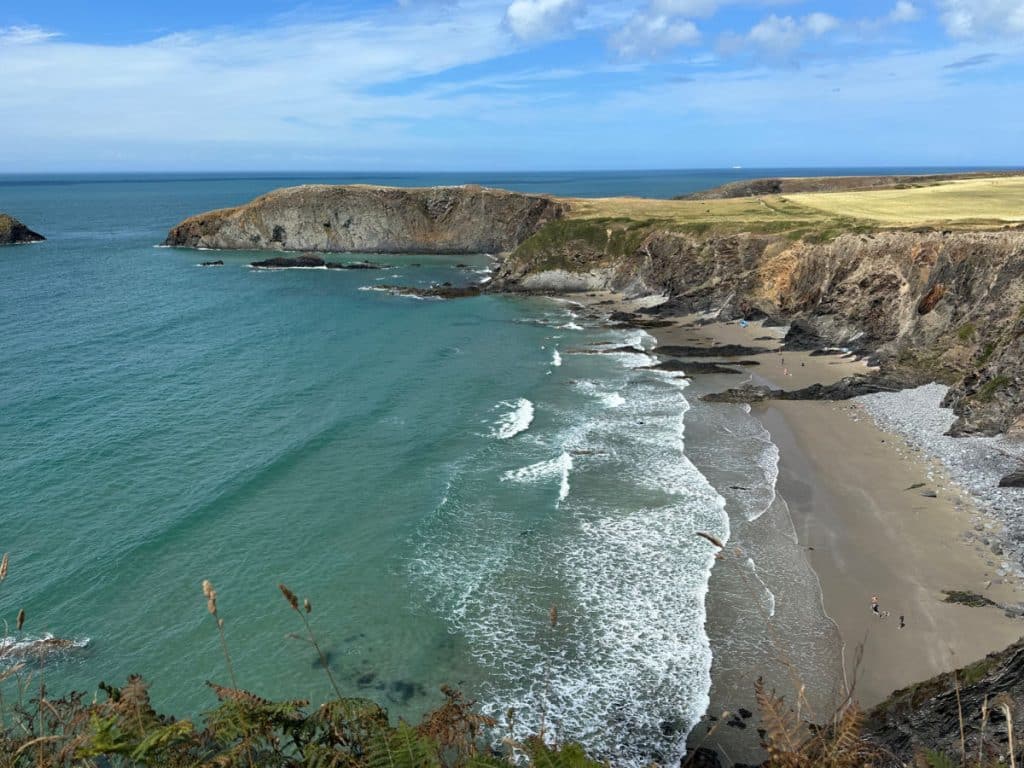
f you are looking for ways to save some money on your trip to Europe cost, here are some ideas;
Visit Less Expensive Countries
If you want to go to Iceland or Scandinavia, you are going to need a healthy budget. Even places that used to be considered budget-friendly, such as Portugal, have gotten pricier in the last few years as tourism has increased (although it is still cheaper than other Western European countries.).
However, if you go the bit off-the-beaten path, you can find great deals, it may just be a bit trickier to find direct flights. Look at destinations like Scotland , Wales , and Eastern European countries like Hungary or Slovenia.
Avoid Big Cities
Everyone wants to visit Paris , London , and Rome , but the less time you spend in these large European capitals, the better it is for your budget. Sevilla is going to be cheaper than Barcelona, and so on.
You can also stay in less-popular countryside destinations, like Piedmont or Umbria instead of Tuscany in Italy or Languedoc instead of Provence in France. We have stayed in gorgeous chateaus in the Languedoc region of France for half the cost of our hotel in Paris.
Stay in Rentals
If you are visiting Europe with kids , one way to save money is to find an apartment or villa rental through Airbnb, vrbo, or other vacation rental alternatives . Since it is hard to find family rooms in Europe that sleep four or more, often the cost of a two or three-bedroom apartment is cheaper than renting two hotel rooms or an expensive hotel suite.
Even couples will benefit from staying in agriturismos, which are farms that offer accommodations on-site in Italy, or something similar.
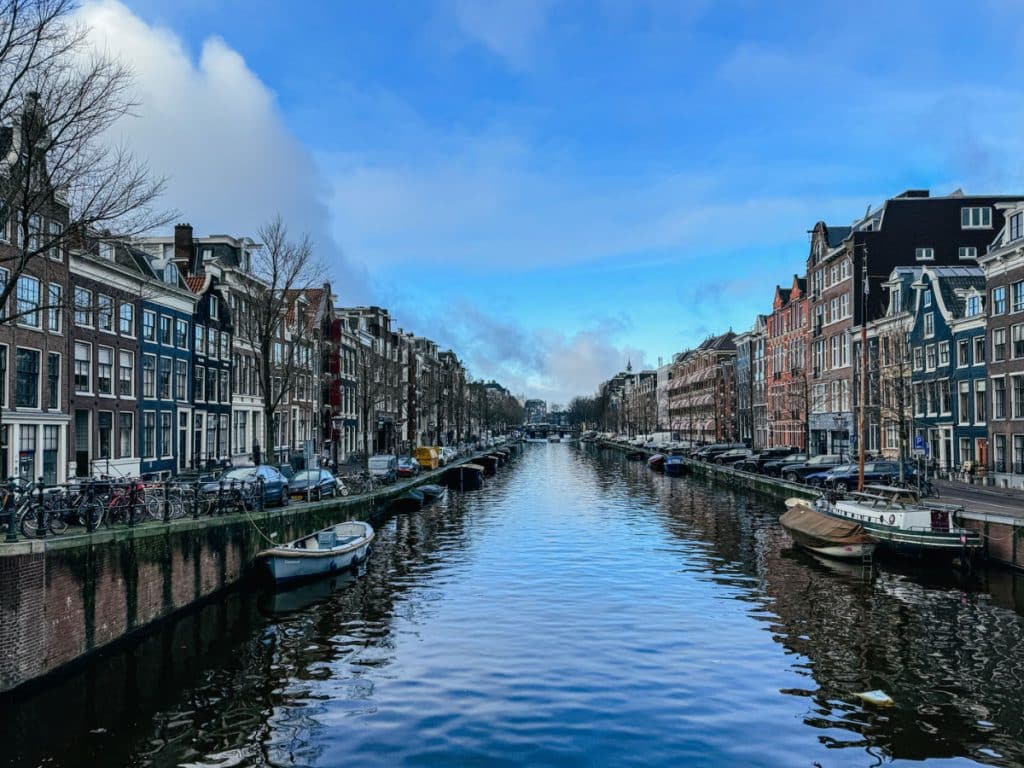
Travel Outside of Peak Season
I know it is hard to travel during shoulder season or low season if you have kids, but remember that Europe has different holidays and school schedules. You can find great deals around our U.S. Thanksgiving. And, if your kids get out of school early, you can still find better deals and availability in June than July or August, when European schools have summer break.
If you have more flexibility, traveling in late October through May (outside of holiday weeks) will save you some money. Just do some research about half-term or school break weeks.
Use Points and Miles or Low-Cost Carriers
There are a lot of ways to hack your way to free flights to Europe using sign up bonuses and flexible points transfers if you can easily meet the minimum spend amounts with your current spending. However, even if that isn’t an option, you can often find great deals on flights to Europe.
We have flown to London and Vienna for under $500 each. I highly recommend signing up for a flight deal subscription service such as Going . With the premium level you can set up your preferred airports and dream destinations and receive alerts on airfare sales and even points deals.
There are also a number of low cost carriers that offer flights from the United States including Norse Atlantic Airways, Condor, and French Bee. You can also use Play Airlines, which connects through Iceland.
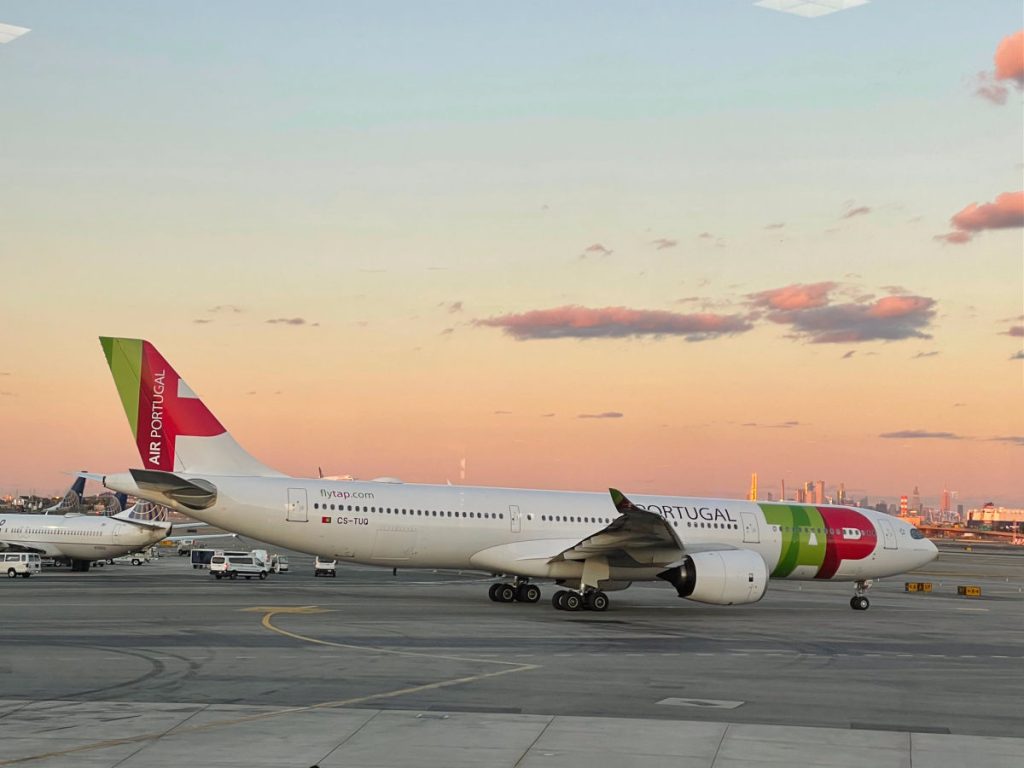
Fly to a Hub and Then Use a Low Cost Carrier
If you find a great flight deal to a major European city, you can then use a low-cost carrier such as Ryan Air, EasyJet, Vueling, or others to connect to your final destination. These flights are typically under $100 per person, but make sure you are aware of the luggage restrictions on weight and size, which are different from U.S. carriers.
Trains are also another option, but don’t assume they will be cheap, especially if you book first class with assigned seats and luggage storage. Be sure to research your options before you book.
How Much Does a Trip to Europe Cost
Note: This post contains affiliate links. If you click a link and make a purchase, I may receive a small commission at no cost to you.

Now let’s look at some average costs for a trip to Europe. I’ve based these on two people traveling to Europe from the United States for a one week (7 night) trip.
Airfare to Europe Cost
Airfare from the United States to Europe can range from $500 per person (if you find a great deal) to over $2,000 (if you book late and travel during high season on a standard carrier.) As I mentioned above, you can save money by looking for flight deals, traveling off-season, or using low-cost carriers or connecting flights.
However, you can assume an average cost of $1,000 per person.
Total Airfare Cost = $2,000 ($1,000 x 2 people)
European Accommodations Cost
Accommodation costs can vary greatly depending on if you are staying in a big city or elsewhere, or if you are in a luxury hotel or a rustic rental. You will usually want to split your trip between a city and somewhere in the countryside. If you only have a week, I’d suggest three nights in the city and four nights elsewhere. Think Rome or Florence + Tuscany, Milan + Piedmont, Paris + Burgundy, Edinburgh + Highlands, London + Wales, etc.
In the city, expect to spend $250-500 per night and $150-350 per night in another location. Remember, you can refer to each of my detailed cost breakdowns for specific hotel and itinerary recommendations for those various destinations.
Total Accommodations Cost = $2,050 ($350 x 3 nights + $250 x 4 nights)
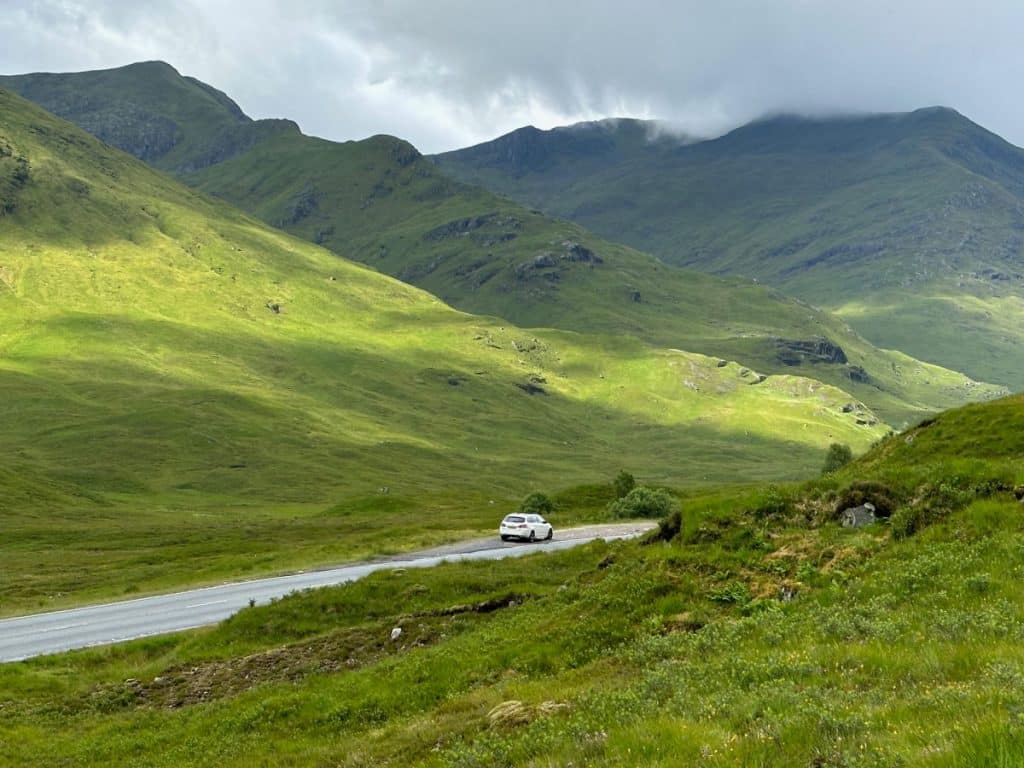
European Transportation Cost
Even if you plan to stay in one city for your entire trip to Europe, you will still need to spend some money on transportation. For example, when we went to Amsterdam for three days, we walked all over the city but we still took a transfer to and from the airport. So whether it is Uber, taxis, public transportation, or private transfers, you will need to budget for transportation expenses.
More likely, you will need to also either rent a car or take a train between destinations. If you are renting a car, be sure to book it early as the prices go up the closer you get to your arrival. Automatic transmission cars are also more expensive than manual transmission. Try to pack in carry on suitcases if possible so that you can rent a small to mid-size car. Driving in some countries (especially Ireland, the UK, and parts of Italy) can be challenging on small roads so you will appreciate it for more than the price point! Also keep in mind that gas is more expensive in Europe than the United States.
Total transportation cost = $800 (estimated)
European Activities Cost
Your activity costs vary greatly depending on where you go in Europe. For example, if you are visiting Scotland or Wales and you just want to spend a lot of time in the outdoors and maybe visit a few castles, your expenses will be minimal. But if you are going to Paris or Rome and you want to explore historic sites and museums and get the most of the experience, you will want to take a tour.
When in Greece, you can spend your days by the pool or the beach, but you will probably want to at least take a sunset sail and maybe a food or wine tour. I know it can get expensive, but don’t skimp on your activities. This is what you will remember most about your trip. More than your hotel. More than your airplane ride. It is also what matters the most when visiting a foreign country. After all, you want to experience the local culture. You want to learn more about the destination’s history. And you will want to see what makes a place unique.
Total Activities Cost = $1000

European Food Costs
It used to be that food in Europe was more expensive than in the United States but in the last couple of years, I have not found that to be the case. You can still spend a bundle on food if you elect for hotel breakfasts or fancy chef’s tasting menus. But in general, you can find affordable meals especially in destinations like Scotland, Wales, Portugal, and Italy.
You can also save money by preparing some of your own meals if you rent an apartment or stay in an aparthotel with a kitchenette. Remember, you don’t need to tip as much in Europe (or sometimes at all) and the alcohol is usually a lot cheaper because it isn’t marked up as much. These factors can make a big difference in your bottom line.
As a rule of thumb, plan to spend:
- $10 per person for breakfast (stop at a bakery for pastry and coffee or juice)
- $15-20 per person for lunch (think pizza, sandwiches, or street food)
- $25-50 per person for dinner (maybe plan for one splurge dinner too of up to $100 pp)
Total Food Cost = $1150
You may also want to budget some money for souvenirs and travel insurance.
Total Trip to Europe Cost
A seven-night trip to Europe for two people will cost an average of $7,900, or $564 per person, per day.
Save this to Pinterest
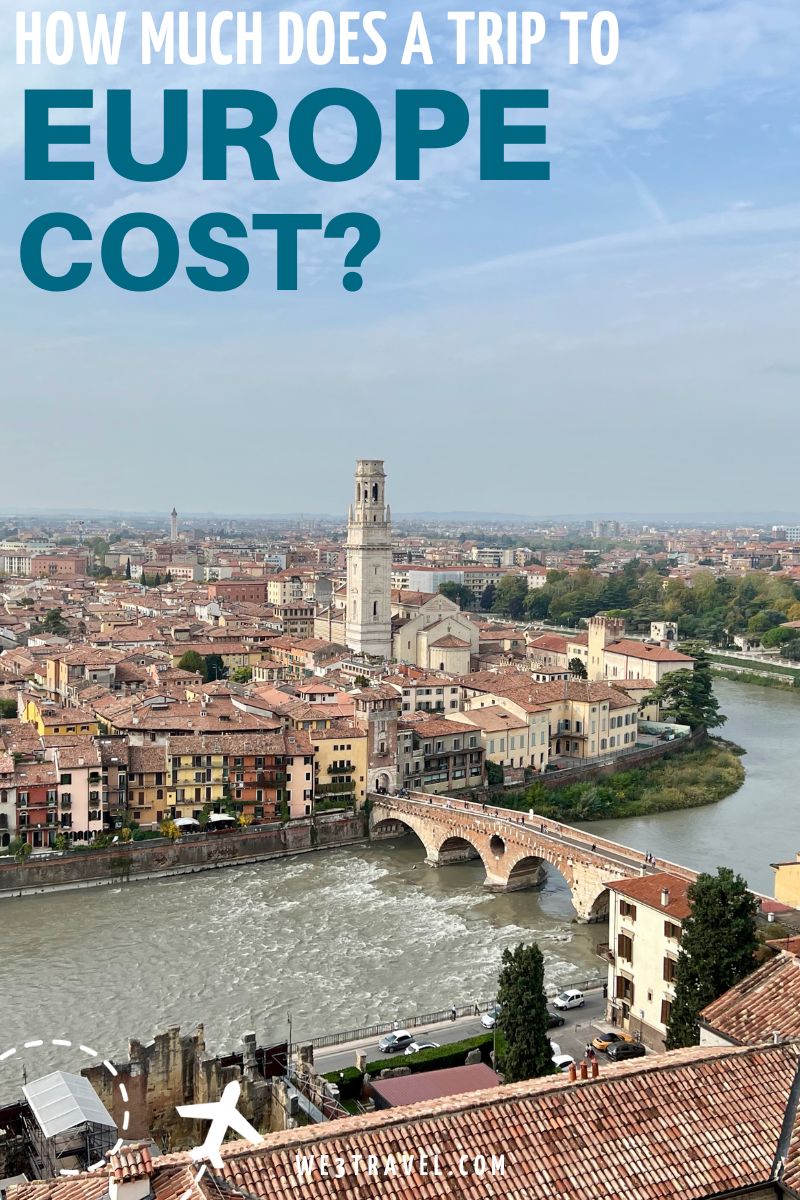
Tamara Gruber is the Founder and Publisher of We3Travel. A former marketing executive and travel advisor, Tamara is an award-winning travel writer and recognized expert in family travel. Tamara is a member of SATW and the Adventure Travel Trade Association, and serves on the Board of the Family Travel Association. She is also the publisher of YourTimetoFly.com and the co-host of the Vacation Mavens travel podcast.
Find this useful? Share it!
Publish Date: March 12, 2024

SIGN UP FOR OUR NEWSLETTER & RECEIVE A FAMILY VACATION PLANNING KIT!
We3Travel.com will use the information you provide on this form to send you newsletters. You can unsubscribe at any time by clicking the link in the footer of any email you receive from us, or by contacting [email protected] . By clicking below, you agree that we may process your information in accordance with these terms.

Start typing and press enter to search

Europe in 3 Weeks: 6 Itineraries
DISCLAIMER: This post might have links to travel services and products that we enjoy. We might make a commission from it at no extra cost to you.
I am confident many people have Europe on their bucket list of places to visit. This continent is filled with preserved historical sites, famous landmarks, UNESCO-certified heritage sites, various natural scenery, and diverse cultures from people of different nationalities.
There are tons of activities that you can do here as well. However, if you plan to stay a little longer than the usual vacation duration, it might cost you a lot, especially if you aren’t familiar with places to go without spending too much.
This guide is for people planning to travel around Europe in 3 weeks . Whether you are on a budget or looking to splurge a little, there’s something for everyone. In this guide, I am covering central and southern Europe – both have famous destinations. I also have itineraries for the eastern region for affordable, nordic areas for unique culture, and off-the-beaten path of Europe.
I want to ensure you spend the 3-week holiday that suits you. If you are new to travelling on a budget, check out these tips for budget travel . You can also read in below our estimate of how much a 3-week in Europe trip might cost.
THINGS TO KNOW BEFORE GOING TO EUROPE
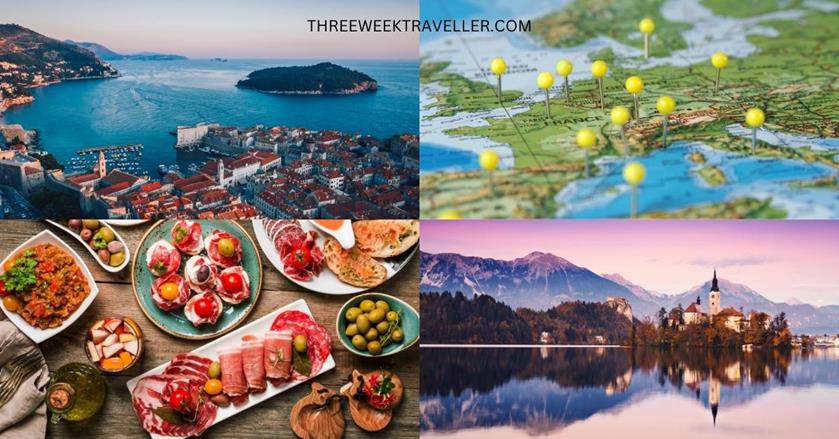
If you plan a trip for 3 weeks in Europe, stay with me as I lay down tips on travelling there on a budget. Decide where you want to go, when, how much you will spend, and what you plan to do once you go there.
I created a detailed outline to help you plan your 3-week Europe trip or you can also consider a 3-week cruise around Europe.
Where to go in Europe for 3 weeks
If you want a hassle-free trip, y ou could visit countries that share land borders or are near each other. You can also limit your visit to 3 countries to spend at least a week in each.
For example, France, Italy, and Spain are super popular and are easy to get from one to another. The same goes for Norway, Denmark, and Sweden. The Baltics (Lithuania, Latvia, and Estonia) is another example of Hungary, Croatia, and Greece/
That way, you could experience what each country offers without rushing. You wouldn’t be overwhelmed by the new cultural experiences and frequent environmental changes. You should check our compilation of 3-week travel itineraries for different (each) European countries .
When to go to Europe
This actually depends on what activities you want to do. For instance, summer would be perfect if you like swimming , various water activities, open-air concerts, and museums. If you’re going to try skiing, ice skating, sledging and see frozen waterfalls and snow in general, you should go during winter.
You can go hiking in spring and discover diverse flora and fauna along the way, as most flowers bloom during springtime. Europe also has various music and cooking festivals, while during fall, you can attend their world-famous festivals, enjoy the changing of the tree colours, and do lots of hiking and museum visits.
However, if you ask me, I like visiting Europe during late spring or late autumn, from March to April or September to October. These are shoulder seasons; the weather is neither too hot nor too cold, there are fewer tourists, and accommodation prices are a bit lower.
Check our list of best destinations to go for a beach trip and t op places to spend winter for 3 weeks .
You don’t have to write your itinerary from start to finish, day by day, but writing some sort of guideline will help you visualise your trip. You can check which destinations you can afford to book a private room and which places you have to book dorm rooms.
Y ou can join free walking tours in Europe, which are widespread . The great thing about this is that you only need to give a tip to the tour guide according to your satisfaction. You can also take local transportation such as trains, buses, or subways (they call them metro in Europe).
You can also check if you can rent bicycles. This means of transportation is enjoyable, and you would be able to appreciate the places you visit more when riding a bike.
Another way to save money when taking public transportation is by booking a shared ride (either from your hotel to the airport or the following city/country).
Pack lightweight
There are so many cheap flights across Europe, but the catch is that the baggage cost on flights often doubles the ticket costs.
That’s why you need only to bring the essentials and pack light. In this way, you also could move faster because you don’t need to rearranging your belongings or drag a heavy suitcase or backpack.
We have an amazing packing list for general travel , which comes with a free printable checklist. You can also check our packing list for summer or the packing list for winter .
Basic travel tools and sites
When planning your trip, check different sites for the most affordable and budget-friendly travel services, such as flights, accommodations, and even travel insurance. If your trip is not final, look for sites that offer flexible cancellations if anything changes.
For those sure of their trip, booking your hotels and flights in advance is best to have more options, especially affordable ones.
These are the websites and tools I personally use when booking my trip. The ones I book right away are flights (for international/intercontinental), hotels (to find the best deals), and car rentals.
3 WEEKS IN EUROPE AVERAGE COST
On average, one person should plan around $2,000 for 20 days in Europe . You should be able to stay in a private room and eat out most of the time. But that still depends on where you plan to go.
If you’re on a backpacker’s budget, you should be able to do it for $1,500 . Plan to stay in dorm rooms and cook when you can.
If you want to splurge, $4,500 for 3 weeks in Europe is very comfortable. You can book five-star hotels, eat at fancier restaurants, and book private tours.
Pro tip: Don’t include your airfare when computing your budget because airfares change drastically . You can also try to book during non-peak seasons to save more or wait for promos.
When computing how much a 3-week Europe trip costs, you should consider food, accommodation, and tours. Last-minute bookings are the most expensive. Hence if possible, book as early as three months before your planned trip.
How much is it really to travel to Europe for 3 weeks? It depends on the person, of course. However, personally, I spent about $1,200 on one summer. I also visited during winter, where I paid $1,000 in 3 weeks, mostly because I decided to head to East Europe . I also backpacked around for three months and spent about $2000.
In my opinion, Europe is not that expensive compared to North America or even Oceania. But it would help if you had a good plan and were okay with not always eating in fancy places. The great thing about Europe is the hostel community, it’s affordable and a great way to socialise.
I mainly stayed in hostels around Europe, took public transportation, walked a lot, ate street food and went to local grocery stores. I also made sure to see as many places as possible and enjoy some “luxury” here and there.
You can also book this 7-day tour of central Europe , which covers Germany, Czechia, Slovakia, Hungary, Austria, and Switzerland. Transportation, accommodation, tour manager, and breakfast are all included.
PINNED MAP OF DIFFERENT ITINERARIES
Click the enlarge button on the top right corner. Credit: map data: Google
EUROPE IN 3 WEEKS ITINERARIES
I created a list of various destinations according to season and budget preference. I included itemised lists of how much a 3-week Europe trip costs so you could know what you could do with specific budget ranges. Please note that this budget is for one person only, and you can adjust the cost according to the number of people.
>> We also have an article on affordable destinations to spend your 3-week vacation
Most Affordable Winter Destination – Portugal, Spain, Italy
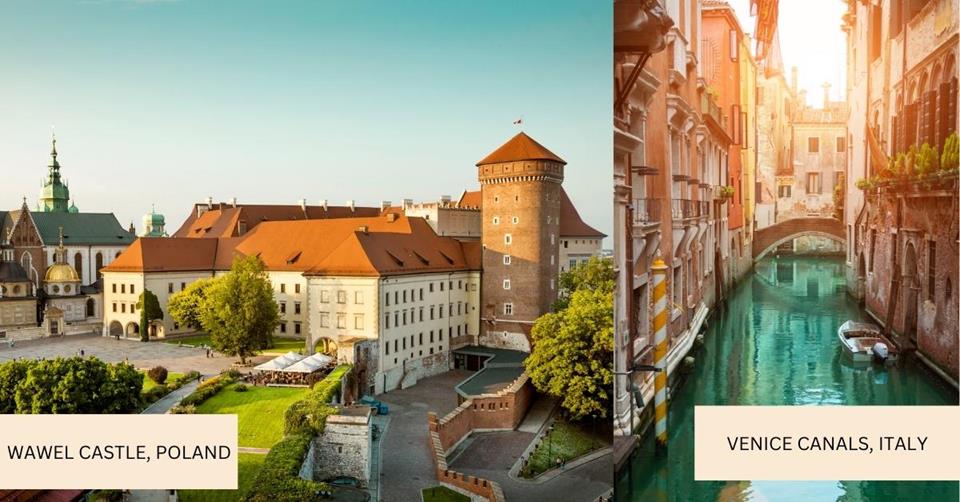
If you want to visit Europe during winter, consider visiting Portugal, Spain and Italy. These three are close to each other. They also have affordable accommodations and generally have fewer tourists during this season.
In Italy, you can enjoy the Colosseum without crowds , explore the mountains, and spend time in museums. You will also have the luxury of spending the entire 3 weeks in Italy , covering north to south. From mountains, vineyards, and historical places, to Mediterranean beaches. If you are foody, you definitely have to try these best Italian desserts .
On the other hand, Portugal doesn’t suffer from freezing temperatures even in the middle of the winter season, so you can still enjoy the sunlight and do various outdoor activities such as hiking. There are popular Instagrammable spots in Portugal that are worth a visit, and of course, wine and food.
You want to see Porto and Lisbon, especially if you want to hike the popular Santiago de Compostela route. Once you get to Porto, stay near a bus or metro stop, both budget-friendly ways to move around. If you don’t know where to stay in Porto, near the historic centre of Ribeira District, both offer affordable options.
Don’t forget Lagos; it offers such wonderful water activities. This is an incredible destination if you plan to visit during summer. Lagos is located in the Algarve region, a popular area for its coastal features. If the water is too cold during winter in the Algarve, there are other things you can do, such as hiking, visiting chapels, enjoy a road trip.
If you are heading to the capital, decide on the activities, from museums, beaches, hiking, and even night-out parties. Knowing what to pack for Lisbon will ensure you don’t waste your time and money. Check our itinerary for 3 weeks in Portugal .
Lastly, Spain holds some of the best festivals on the continent during this season . During winter, the best places to visit in Spain are Seville, Barcelona, Madrid, Granada, the Canary Islands, and Costa del Sol.
There are so many places to see in Madrid, and probably a good 5 days here is the perfect spot. At the same time, Barcelona for 2 days will allow you to cover too many attractions.
But please, do not miss the Canary Islands – like no other in Europe. We have 3 weeks in Spain. Below are the budget ranges you should allocate for food, guided tours and accommodation. You can also check out our 3 weeks in France, Italy, and Spain itinerary .
- food budget per day: $20
- guided tours cost per day: $15-$30
- accommodation cost per day: $25-$45 as a backpacker or $70+ for mid-range
- 3-week budget: $1,200-$1,800 (excluding flights to and back)
Mid-range – UK, France, Germany
If you want to spend more, visit the UK, France and Germany. These countries are rich in history and are close to each other, so much so that you can take trains to cross borders. They also have great wine and beers, so this option is perfect for wine and beer enthusiasts.
Check out our 3 weeks in Central Europe itinerary, which features Germany, Poland, Czechia, Switzerland, Austria, Slovakia, and Hungary. But if you prefer the West, we also have an itinerary for 3 weeks in Western Europe or a sole 3 weeks in Germany post.
If this is the region you want to visit, it’s best to come during the off-season, which is either from March to May or September to November. The prices are lower, and there are fewer crowds.
If you visit the UK, you can finally see Big Ben in London and London Bridge . You can spend your holiday in England, which hosts festive Christmas markets and drink hot chocolate while wandering about or seeing the world-famous Isle of Skye in Scotland.
There are many ways to explore the UK. We have a guide for 3 weeks in England only, or you can also explore the entire country and do 3 weeks in the UK .
However, if you have been to the UK before, you probably want to visit Ireland this tim e. You can combine Scotland, Northern Ireland, and Ireland. Please look at our 3 weeks in the UK and Ireland itinerary .
In France, you can take a picture of the Eiffel Tower or visit the Louvre if you’re a museum enthusiast. You can also try out their seasonal cuisines and go on a shopping spree as they have a government-mandated citywide sale during this season, also known as “soldes”. And yes, we have an itinerary for 3 weeks in France .
In Germany, you can go to thermal bathhouses to experience their outdoor pools and saunas . You can also ride their historic cable car, Merkurbergbahn, to see the snow-covered pine trees. Here are the daily price ranges for food, accommodation and tours.
- food budget per day: $25-$35
- guided tours cost per day: $30-$50
- accommodation cost per day: $35-$50 for backpackers or $80+ for mid-range
- 3-week budget: $1,900-$2,800 (excluding flights to and back)
Affordable Summer Destination – Italy, Croatia, Greece
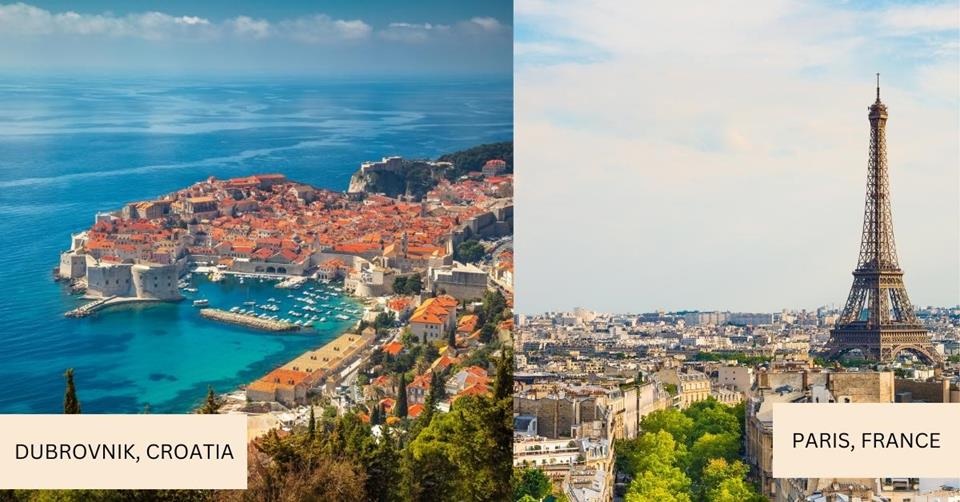
For affordable summer destinations, Italy, Croatia, and Greece are must-visits. They are not necessarily next to each other or affordable. Italy is expensive, but Greece and Croatia are a bit more affordable so that balances it out.
Another thing is that flights between these three countries are affordable. Plus, it’s in Southern Europe ; there’s no better place for a beach vacation in this region.
These 3 destinations serve great food, wine, and beer and are rich in natural scenic spots like beaches and mountains. Personally, I would say this is the best way to explore Europe in 3 weeks on a budget.
Italy is known for their fantastic food. You can go on a gondola ride in Venice and have wine tastings in Sorrento, which sounds like a perfect summer getaway. Venice is not really a budget-friendly destination.
But, if you want to make this trip affordable, check out the coastal cities on the southeast side of Italy. Not only are they cheaper for vacation in this expensive country, but they are also less crowded.
Greece is a famous summer spot as well. You can visit Mycenae, an ageless arch made with monumental stones that was once a dwelling place of some of the most famous people in Grecian history, including Agamemnon, Electra, and Orestes. You can also have a road trip with your friends around Pelion or just chill and have a slow day in Hydra.
This country is an excellent choice if you want to experience the Mediterranean Sea but want to do Europe in 3 weeks on a budget. 3 weeks in Greece is a little more affordable than Spain, France, and Italy.
Croatia is now known for its location in Game of Thrones, but it has more to offer. You can go coral diving during the summer season. You can also avail yourself of a boat trip, hike, swim, cycle or sail; honestly, the sky’s the limit with the number of things you could do here.
It’s another more affordable destination but located ion on the Mediterranean Sea. You can check our 3 weeks in Croatia itinerary too.
- accommodation cost per day: $25-$35 or $50 and up for mid-range
- 3-week budget: $1,000-$1,800(excluding flights to and back)
Drinks and Beach – France, Poland, Greece
If you are the type of person who wants to lounge along the beach while drinking wine or beer, then this triad is perfect for you . Aside from that, these countries are rich in historical artefacts and landmarks, and flight tickets are cheap.
One of the most famous beaches in France is Plage de la Cote des Basques in Biarritz, which you’ve probably read about in Hemingway’s The Sun Also Rises . Another famous beach is the Deauville beach in Normandy, where Coco Chanel opened her first clothing store and held historical value .
Sopot is one of the most famous beaches in Poland , especially for the locals, because aside from chilling and sipping wine along the bay, you can also take boat rides, and there are spas and saunas nearby.
Swinoujscie Beach is famous for its water sports because of the constant wind and waves. It also has a windmill nearby which is considered its most famous landmark. Greece has the most beautiful beaches in Europe, so you won’t have difficulty looking for a great beach there. Some of the most beautiful beaches are Mykonos, Crete and Santorini.
- accommodation cost per day: $25-$50
- 3-week budget: $1,700-$2,800 (excluding flights to and back)
CHECK-OUT: Best itineraries for 3 weeks in East Europe
A bit of splurge – Iceland, Norway, Denmark
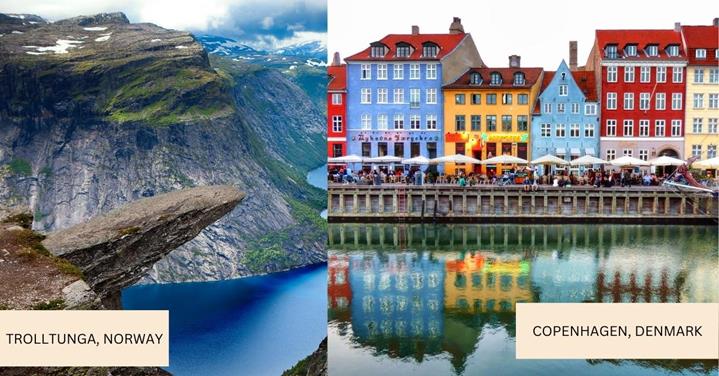
I know Scandinavia or the Nordic region doesn’t scream Europe in 3 weeks on a budget. But if you have a larger budget and want to splurge a little, Iceland, Norway, and Denmark are the perfect places to visit. The best way to make this plan affordable is to rent a car rather than relying on domestic flights, trains, or even buses.
Not super cheap, but it can be affordable if you plan and look for great deals. Remember these tips for visiting Iceland and travelling to Scandinavia for first-time travellers to this region.
You should look at flights and book accommodations 4-6 months in advance . Travelling in the northern hemisphere during the off-season, fall or winter, would be best.
Book hotels in advance to save money and also use local transportation. For instance, if you plan to go during the summer, flights are cheaper if you book them during the winter.
You can enjoy many free or affordable activities like hiking, sightseeing, or road-tripping. You can also enjoy their street foods at a lower price than at their restaurants.
If you are curious, some of the most famous places in Iceland include the Blue Lagoon in Grindavik, a geothermal spa and Strokkur Geysir, where spectacular geysers are found. You can also witness the northern lights if you’re lucky, as the time of their appearance is quite unpredictable.
Meanwhile, in Norway, you can visit the Lofoten Islands or the scenic city of Bergen, which form an archipelago and go to the Lofoten War Memorial Museum. Bygdoy Peninsula is also home to some of Oslo’s top tourist attractions.
In Denmark, you can visit the Tivoli Gardens found in Copenhagen and Nyhavn, the model of most postcards and can also be found in Copenhagen. Here, you will also see the statue of the Little Mermaid, yep, that story was written by the Danish writer, Hans Christian Andersen.
Do you know that you can spend 3 weeks in Scandinavia and cover Norway, Denmark, and Sweden on the same trip? We also have 3 weeks in Iceland itinerary if that’s something you have in mind and a Norway itinerary .
- food budget per day: $30-$50
- guided tours cost per day: $50-$70
- accommodation cost per day: $45-$60 for backpackers or $100+ for mid-range
- 3-week budget: $2,400-$3,500 (excluding flights to and back)
The Baltics – Lithuania, Latvia, Estonia
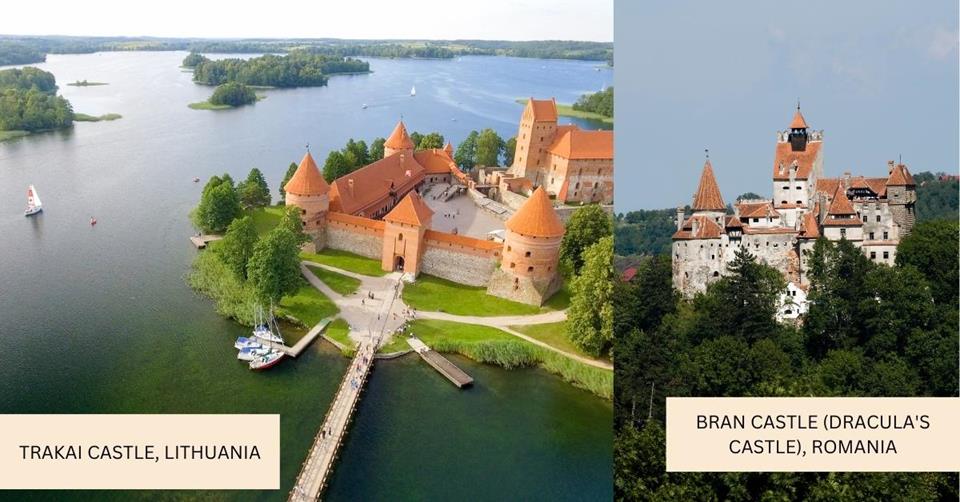
If I’m on a budget, these three countries are my favourite European destinations for Europe in 3 weeks . These places offer a calm and relaxing vibe, from beaches to hiking, to castles, without spending too much.
You can cross the borders via train or bus, saving you money instead of flying. I’m not going to lie. The Baltic beaches are not stunning, but they offer a tranquil scene and few tourists.
I recommend you enter either through Vilnius or Tallinn and make your way north or south. Don’t forget to try cider from this region. It’s one of the best in Europe. Few do this, but road-tripping through the Baltics is the best way to explore this area. It’s more affordable and gives you so much more freedom.
In Lithuania, make sure to visit Vilnius, Kaunas, and Klaipeda. These two cities offer different activities from one another. Vilnius for the cultural and historical experiences and the best nightlife in Lithuania. In comparison, Kaunas is known for its creative and street arts.
Even though it’s a small city, many things to do in Kaunas are related to art. Last but not least, Klaipeda for the beach and other water activities. Make sure to visit Trakai Castle and Uzupis.
From there, make your way to Riga, the coastal capital of Latvia. Enjoy museums, castles, fortresses, and the beach during summer. You can also visit Rezekne, where Raznas National Park is located. Here, you can enjoy hiking, fishing, and even canoeing.
And lastly, Tallinn. A vibrant and modern city, Estonia’s capital and known for being the leading digital powerhouse of the Baltics. Estonia is the pioneer of digital residencies and the first country to welcome digital nomads. Many museums show Estonia’s history and culture. Being on the coast, you can enjoy the beach during warm weather and other water activities.
- food budget per day: $15-$30
- accommodation cost per day: $35-$50 for backpackers and $60+ for mid-range hotels
- 3-week budget: $1,400-$2,300 (excluding flights to and back)
SUMMARY OF EUROPE IN 3 WEEKS
Europe might be expensive in general, but with enough planning and research, you should be able to create a travel plan for Europe without spending too much.
Our own guide to Europe in 3 weeks on a budget, consists of our personal list of places that I visited and perhaps you can visit them as well depending on your budget, season and activity preference.
These budget ranges are for participating in group tours and eating in bazaars, holiday fairs or mobile food carts instead of going to fancy restaurants.
Next summer, I plan to be in Europe for 3 weeks visiting Italy (can never get enough!, Slovenia, and Czechia.
We hope reading this has been enjoyable and informative for you as much as compiling this list has been delightful. We also hope you would consider going to Europe because there are many famous scenic spots and hidden gems just waiting to be visited.
SAVE THIS TRAVEL ITINERARY ON YOUR PINTEREST:
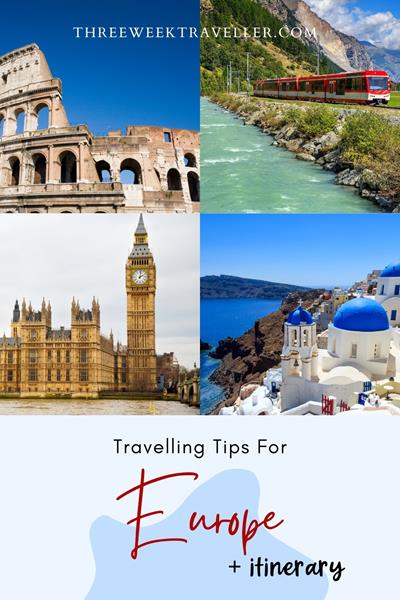

Accommodations
As you can imagine, your Europe trip cost will vary greatly depending on your style and where you visit. I recommend budgeting $150 a night for your hotel, which works out to $2,100 for 13 nights. From hostels to luxury hotels, Europe gives you many options to easily find accommodations that fit your budget.
If you’re backpacking through Europe, hostels will probably be your choice of accommodation. If you decide to go that route, the average price is $15 – $20 a night. Alternatively, there are a lot of great boutique hostels out there that cost more but offer a better experience since they’re competing with hotels and Airbnb.
Recommendations: YHA London Central (London), Barnacles hostel (Dublin), The Flying Pig Uptown (Amsterdam), Goodmorning Hostel (Lisbon)
Mid-range hotels
For those who think $150 is expensive, I would argue that it’s on the cheaper end. The reality is that hotels are expensive these days, so getting one for $150 a night is a pretty good deal. Remember, this is just an estimate. In some European countries, some hotels will cost you more while others will cost you less. You can also follow my guide on how to save money on hotels .
Recommendations: Alhambra Hotel (London), Stauntons on the Green (Dublin), Hotel Nicolaas Witsen (Amsterdam), Hotel Excelsior (Lisbon)
Luxury hotels
There will likely be luxury hotel options regardless of what city you’re visiting. If you like the experience or don’t mind spending the extra money, you may want to budget another $200 – $300 a night. Your Europe trip cost will skyrocket if you’re going for luxury stays.
Recommendations : The Langham (London), Clontarf Castle (Dublin), Amsterdam Marriott Hotel (Amsterdam), Iberostar Lisboa (Lisbon)
Depending on the city, I sometimes prefer to use Airbnb. I’ve been able to find private apartments in good locations for about $100 a night. If you’re travelling with kids or family, Airbnb can be a great deal since you should easily be able to find a space that fits your entire party. I do admit that Airbnb has become more expensive over the years, but it’s still a good hotel alternative.
If you have the right credit card, you can save a fair amount of money on hotels. Americans should strongly consider the Marriott Bonvoy Brilliant American Express Card since you can earn up to 95,000 Marriott Bonvoy points and $300 back at U.S. restaurants as a welcome bonus . Canadians should consider the Marriott Bonvoy American Express , which gives you up to 75,000 Marriott Bonvoy points. That’s enough points for a few free nights at some hotels, which could easily have a value of over $500.
Local transportation
Since I assume you’re doing thee cities during this trip, you’ll need to factor in flights and/or trains to each destination. I’m also assuming you’re booking a multi-destination ticket, so you don’t need to backtrack. Realistically speaking, budgeting $400 for location transportation may be a bit high, but remember, you must also pay for trips to/from the airport, day trips, and any other public transportation you use.
Generally speaking, getting a Eurail pass won’t be worth it if you’re in Europe for just two weeks and visiting three cities/countries. If you’re going to neighbouring countries or taking day trips, buying tickets as needed is fine. That said, buying your train tickets well in advance (even before you depart) is usually worth it, as you’ll get better prices and a confirmed seat.

Attractions
This is where things can get tricky. Attractions aren’t expensive, but if you keep going into them, you will naturally spend more. First off, always do the free things in every city. That means checking to see if any museums or art galleries have no entrance fee. Note that even museums with an admission charge (including big, famous museums like the Louvre Museum in Paris) usually have a free day, so you must see if the timing works out.
Parks are always free, and quite often, simply walking around neighbourhoods is the best way to see a new city, and that doesn’t cost you anything. In Europe, there are also many free walking tours – well, you need to pay a tip – but that’s a cheap way to learn about the city.
Finally, check to see if museum passes will help you save money. Many cities offer something such as free entry into a bunch of attractions for a fixed price for a set period of time, e.g. 24, 48, or 96 hours. You would need to do the math to see if the cost of the attractions you’re interested in makes up for the cost of the pass.
If you plan to pay for some attractions or do day trips into the countryside to see some of the local landscapes, check to see if Klook sells tickets. Buying your tickets in advance usually means you can get a small discount and skip the lines when you arrive.
Food and drink
The food and drink budget will vary by person, but a rough estimate for a meal, including drinks is as follows:
- Breakfast – $5
- Lunch – $10
- Dinner – $30
That works out to $45 per person per day, which some people think is too much, while others think it’s too low. If you like to drink alcohol, you’ll need to budget more. What I personally try to do is balance eating street/fast food with restaurants. I also go to grocery stores to get breakfast and snacks, which saves me a lot of money. Cutting back on eating out will help you see Europe on a budget.
Every city and country you visit will have some local delicacies which I highly recommend you try. To this day, I’m still mad at myself for not having tapas in Spain because I thought it was too expensive. I’m not suggesting you blow your budget on food, but it’s okay to splurge occasionally. Even then it doesn’t need to be fancy. A baguette and cheese in Paris is pretty cheap but also delicious.

Random spending
Many people forget to include shopping when planning their vacation budget. It’s silly to think that you’ll spend nothing on random things; you’ll buy gifts for people, right? Plus, you’ll want to pick up plenty of souvenirs for yourself, regardless of how tacky they appear. There’s nothing wrong with buying gifts for yourself or friends; you just want to make sure you budget for it.
As you can imagine, some cities have better shopping experiences than others, so you must consider where you’re going and budget accordingly. For example, you may be headed to Italy and intend to buy a leather purse. There’s nothing wrong with that. Just make sure you’ve set aside some money for that purchase.
As a general rule, you should set aside $200 or 200 Euros for those random expenses that come up. Heck, even spending some extra money on sightseeing can be worth it.
Cost to go to Europe
So how much does it cost to go to Europe for two weeks? You know the answer – it depends! But, a good estimate is about $4,280. One time I spent just $2,300 because I focused on doing it for as cheap as possible. Another time I spent closer to $8,000 (for two people) when visiting just three cities. The cost of a Europe trip depends on you, but it’s not hard to stretch your travel budget.
For more European inspiration, check out my guides to Scotland , Italy , Croatia , Austria , Malta , Greece , and Amsterdam on a budget .
Frequently asked questions
Is it possible to see europe on a budget.
Absolutely! But it will take some planning. The biggest thing to remember is what countries or cities you visit. Places like London, England, Paris, France, Copenhagen, Denmark, and Florence or Milan in Italy will cost a lot more than places like Romania, Poland, Bosnia, Slovenia, and even Croatia. There are also several other ways to help cut costs and see Europe on a budget, even in the pricier destinations. Take a look at my Europe on a budget article for more tips and advice on how to see and do more for less.
Is it safe to backpack Europe?
Generally speaking, yes. This is somewhat of a blanket statement as Europe is a huge place and different countries and even cities will have some not-so-savoury places that are best avoided. But that’s the same everywhere. Some cities are very backpacker-friendly, such as Berlin, Zagreb, Luxembourg, and Munich.
You should be fine if you travel smart, follow basic safety protocols, and trust your gut. At the end of the day, use common sense. Don’t go to a bar with strangers and get black-out drunk. That’s not a good idea anywhere.
If you are uncomfortable or unsure about doing it yourself, you can always book a package tour or even a cruise. However, these will dramatically increase your costs and don’t allow for as much flexibility.
Are rail passes worth it?
It depends. Rail passes, such as the Eurail Pass , can be great because they take out a lot of planning and leg work and make it easy, but you pay for that convenience. Oftentimes there are more affordable transit options that are just as comfortable. Many countries have slower local trains that you can take advantage of. In some places, like Ireland, the bus system is better connected (and cheaper) than trains, etc.
If you are trying to figure out how much does it cost to go to Europe because you are on a tighter budget, it’s worth taking the time to do a bit of planning and do it on your own. If money isn’t an issue and you are more concerned about convenience, then a rail pass might be worth it for your Europe tour.
What are some fun things to do in Europe?
Europe is a popular destination for North Americans because it’s so different from here in many ways. The history and architecture are incredible; it’s wild to think some buildings are centuries older than Canada. Food is another huge perk to travel in Europe. It’s so varied across the continent, and while we have plenty of food options from different cultures in Canada and the USA, it’s always better from the source.
You may also be interested in visiting Europe for specific events. Perhaps St. Patrick’s Day in Ireland, or Carnival in Venice, or the Christmas markets of Germany. Don’t worry about finding things to do in Europe, and there’s plenty.
What are the best places to visit in Europe?
This depends on your interests. Are you interested in history? Maybe cities like Berlin and Vienna will be the most interesting for you. Love art? Perhaps Paris is the best option. More into beaches and nature? Try Croatia. Some people have dreamt about the canals in Venice and the Leaning Tower of Pisa, so they make Italy their priority.
What are the five most important tourist attractions in Europe?
It depends on your likes and interests. What is interesting to me might not be interesting to you. That being said, the most popular tourist attractions in Europe include:
- The Eiffel Tower in Paris
- The Colosseum in Rome
- Neuschwanstein Castle in Germany
- The Acropolis in Athens
- Stonehenge, England
- Aurora Borealis in Iceland
What are some unusual things to do in Europe?
Europe has plenty of weird and wonderful things to do that you wouldn’t necessarily find in North America. A few recommendations include the following:
- Visiting Sedlec Ossuary just outside of Prague (It’s made of human bones)
- Eat haggis in Scotland
- Attend a Krampus Run in Austria (Krampus is essentially a Christmas demon that kidnaps and tortures children. Like an anti-Santa)
When is the best time to go to Europe?
This can depend on your goals and the destination itself, but generally speaking, the shoulder seasons (September/October and April/May) are great. It’s not too crowded, the weather is pleasant, and you can avoid peak season costs.
How long can I stay in Europe?
While many backpackers love to do European tours, you need to be mindful of the amount of time you are allowed to spend not just in a specific country but in an area. Many European countries are part of the Schengen Zone, and Canadians and Americans can only spend a total of 90 days within a 180-day period in these places. Examples of Schengen zone countries include Austria, Netherlands, Spain, Poland, Italy, Iceland, and more.

About Barry Choi
Barry Choi is a Toronto-based personal finance and travel expert who frequently makes media appearances. His blog Money We Have is one of Canada’s most trusted sources when it comes to money and travel. You can find him on Twitter: @barrychoi
128 Comments
Great post. Our vacation plans for this year is to go to Denmark and Sweden. I heard that Scandinavia is really expensive. I found airline tickets for $1,600 for 2 people. Still looking for accommodations at Airbnb. My plan is not to go over our budget of $5k for our 11 day trip.

I’ve actually heard Scandinavia is expensive so let me know what the real costs are after. The good thing is, flights to Scandinavia have never been cheaper. You can get cheap flights if you fly via Iceland and I’ve also seen cheap airfare on Noreweigian.
Hi Barry! I’m planning an all girls trip (around 6 girls) to Europe from Pakistan. Which countries/cities would you recommend? Also we all have a budget of $2500 per person. Do you think it would cost less on accommodation as the cost would split? And would love if you can give some tips?
So I recommend talking to your girlfriends and asking what cities/countries they’re most interested in first. From there, you can try to figure out logistics. Your flights will be the biggest expenses. If you fly into one city and out of another, you won’t need to backtrack. E.g. fly into Paris and out of London.
As for accommodations, since there are 6 of you, you could look for a hostel that has rooms for 6 – 8 with a private room. If you buy out every bed in the room, you’ll have the entire place to yourself. That will likely be cheaper than getting 2-3 hotel rooms each night. You could also look for an Airbnb that accommodates 6, but that might be tough.
$2,500 a person is doable (depending on the destinations) and how long you go for, but I always recommend budgeting extra. This sounds like a really fun trip for you and your friends, the last thing you want is to be watching your budget the entire time you’re there.
Hi I’m from south Africa and I’m looking to travel to barcelona for 2 weeks.
I’m a student so I’m looking for as cheap as possible but I dont want to miss out on anything.
I have a friend living in barcelona so accommodation is already paid for which is a big expense luckily.
We are looking to travel to Greece and Amsterdam during this time.
Was wondering if I take 2000 euros if that would be enough for the two weeks.
Kind regards Jonathan
Hi Jonathan, if you’re staying at hostels or inexpensive accommodations when you’re in Greece and Amsterdam, that should be enough. I’m assuming your flight isn’t part of that 2000 Euro budget.
Nice post but the airfare costs seem to have gone up from your estimates.
Lowest price to Germany from Toronto was $1000 and that was a deal where you are estimating $850 CDN. Plus $200 travel insurance.
Hey Heather,
Yes flight prices have gone up this summer. I expect them to drop during the fall, but I haven’t researched it thoroughly yet.
Thanks, Barry! You always have the best budget/travel advice 🙂
[…] is one of few places that actually has a decent choice of accommodations that won’t burst your travel budget. Hostels are always a favourite among solo travellers, and there are plenty to be found around the […]
I know this is a little old of a thread. I was able to backpack europe with a friend, and only staying in Airbnb. 980$ is what was spent on lodging. We were gone for 4 weeks. The total trip was $5,000 which included souvenirs, trains, rental cars, ferries to the Greek Islands and 4 flights. Two were one way tickets from JFK to Paris, then London to JFK. One of the flights was also $400 from Croatia to Greece. Some of the trains and ferries were accidentally booked first class (which after doing so, I recommend).
Thanks for sharing. Europe can definitely be cheaper if you want it to be. My prices were rough estimates with hotels in mind instead of Airbnb. I love how travellers can see Europe on any budget and as you mentioned, they may still get the luxury experience unintentionally.
Thanks for putting this site togehter. Im planning for a trip to Budapest and Athens, 1 week each, the first 2 weeks of October. Is it still tourist season at this time? Some say prices only drop mid way or end of October. Can you confirm or deny this?
October tends to be slower for Budapest, but depending on where you go in Greece, parts may still be busy since it’s now cruising season in Europe
Thanks for the rapid response, I’m planning on Athens since I’m greatly interested in the historic sites. Not going to any islands like Crete, Rhodes etc. Also out of interest a question if you don’t mind: do you think the recent economy stabilisation (although it probably won’t last long) will change the price of visiting Greece?
Generally speaking, October is the lower season, but since Athens is so popular, it’s not like you’ll see NO tourists, it’ll still be busy. As for their economic situation, I don’t there will be much change as their economy has been tanking for years without prices at hotels or restaurants falling.
I am planning a Euro trip from Canada. I am intending to visit Croatia, Amsterdam and France if possible London. My budget for me and my wife is 7000 USD.
Any advise is much appreciated. Such as where to start and end must visit places and best time to go.
With that budget, you should have no problems seeing those countries. London, Amsterdam, and Paris are quick train rides away from each other. Although Amsterdam and London can be a bit pricier, during the fall, you shouldn’t have many issues finding a reasonably priced hotel. Paris can be inexpensive if you choose a hotel outside of the main areas, just find a place near the metro.
Adding Croatia gets a bit tricky since it’s not really close to the other countries. THat being said, you can find discount air carriers from London, Amsterdam, or Paris to get there. Most people who visit Croatia see more than just one city which is why you need to decide how much of the country you want to see when planning your trip.
Hello! I’m planning out a ways (gives me something to look forward to) for Europe in spring, 2021. We’ll start at a friend’s relative’s in the Black Forest, then on to Paris by train, then Italy by train. Goals are Rome, Florence and Venice. I’m very excited, as I’ve never been to Europe. With staying free the first few nights in Germany, and then four of us sharing AirBnbs, I’m thinking (depending on airfair) that we might be able to do this for around $2,500 each. That’s the goal. I love the idea of looking for special food everywhere we go. In Puerto Rico, we ate the fried plantains, and I enjoyed those. Not sure what tapas is, but hope you get to go back and eat it!
That sounds like a reasonable budget since you have some of your accommodations covered. As for tapas, it’s basically small plates meant for sharing. I actually went back to Barcelona earlier this year and splurged on tapas this time around. It was worth it!
Good for you. Thanks for the tips. Anne
Hi there, I’ll be visiting Europe for 9 days in Feb-Mar flying directly from Newark to Rome, from there to Paris and end the trip in Madrid. On airfare I spent USD 500, in lodging thru AirBnb and hotels a total of 225. I was wondering how much money should I expect to spend on attractions and food? Note: the amount mention above is per person and we are going to be 6 people in total. Note 2: thank you for reminding me to have a category of random expenses!
How much you spend on food is really up to you. Generally speaking in Rome you can get takeaway pizza, sandwiches, or pasta for 5 – 7 Euros per person. Sit down places will probably cost you 10 – 15 Euros per person. I rented an apartment when I was in Rome last and saved a bunch by stocking up on water, drinks, and alcohol from the grocery store. That being said, food in Rome is EXCELLENT so you could easily end up spending more if you want to try more things. I ate gelato twice a day because it was so good there. I wasn’t even hungry, I just wanted it! I STRONGLY advise checking yelp or tripadvisor before dining at any restaurant as the quality can vary quite a bit. Be sure to ask your host for recommendations.
The costs in Paris will likely be similar to Rome, probably a little cheaper (wine is cheaper than water). I haven’t been to Madrid so I can’t comment there, but I would suggest splurging on tapas one day.
Random expenses ALWAYS come up which is why I always budget a little more.
Planning a 10-11 day vacation for family of three( two adults one 7year old) in July 2019 to London, Amsterdam and Paris planning for a 7000 budget. Does this seem reasonable? Round trip from lax to Heathrow are about 2400 planning on doing Airbnb and we are not shoppers. Most likely spend on food, drinks and attractions. First time big vacation so exited!!!!!! Any feedback would be appreciated
That sounds more than reasonable assuming you’re not staying at hotels that cost you $1,000 per night =D. In Paris, it’s easy to find cheaper accommodations. London hotels can be pricey, but there area areas that are more reasonable. Amsterdam tends to be expensive in general unless you stay in Amsterdam SOuth and the take the train into the main areas. That being said, with your budget, you can likely find hotels in good locations.
We are going to Budapest, Kiev, Chisinau, and a couple stops in western Europe (Paris and somewhere else) in June, 2019, for about 23 days. International tickets aside, and with free lodging in Kiev, do you think $50 per person per day is reasonable? Two adults and one 17 ye old are our ages. We are not backpacking and we feel too old to sleep on someone’s couch for three weeks. Thanks for your input.
Does that $50 a day include accommodations? If not, that’s probably way low for an estimate. Food alone will cost you $50 if not more per day. You also need to factor in local transportation, attractions, and any souvenirs you may buy.
Thank you for this article. I am planning an European vacation for next year during the summer, Our trip can be any time between the months of July and August, there will be three of us, myself and my two daughters, 18 and 12. My budget is about 20,000 USD, I´m going to try to make it as long as I can stretch it, maybe 3 weeks, could it be stretched to 4?. I am not sure where exactly to go, I am thinking England, Paris, Italy for now, but that might change depending on where we can fly in and out of the cheapest. I guess my questions are, given that summer is the most expensive time to travel, which cities would you recommend traveling into and out of? I´m in the east coast. Also, I have read about hostels and I’m aprehensive about using them with my daughters, what is your take on them? Another concern of mine is traveling with my daughters, with me being a woman, are there any cities I should stay clear off because of crime? Any help, guidance is greatly appreciated! Thank you!
Hi! Im playing on going on a 16 day eastern european trip to several countries with a budget of around $2500-2700. I plan to save a lot by going to grocery stores and using airbnb. However, I will be going in the wintertime when the world junior ice hockey championship is so the tickets of a couple games might cost $50-100. Is this a reasonable budget for 1 person?
It can be done, but your flights and accommodations will eat up a lot of your costs. It also depends on how many countries you plan on going to. If you’re going to do Airbnb, try renting a private room as opposed to a private apartment since they’re cheaper.
Is it reasonable to expect to find a ticket to Greece or Italy for the $650 estimated price if we book now for July? I haven’t flown much so not sure, but looking at prices from US on Google seem to be more in the $1000-1500 range. Do I just not no where to go for a reasonable deal on a ticket? Any help is appreciated.
July is the summer so prices tend to be higher. For whatever reason, it’s usually a bit more expensive to fly into Greece as opposed to other destinations within Europe. It might be cheaper to fly into a major hub such as London or Amsterdam and then catching a discount carrier from there.
Note, sorry, I just realized I commented on the wrong place before. I apologize.
That budget is pretty healthy so I think you’ll do alright. Here are some things to consider. Have you talked to your daughters about where they want to go? It may be worth letting each daughter choose one destination or country ad then you pick one. That will give you three spots to build your itinerary around. I do believe you could stretch our your itinerary to 4 weeks as long as you don’t go all out on everything. That being said, even at $250 USD per night for hotels, you’d only spend $7,000 for 28 nights.
Figure out your destinations first and then you can work out flights. Getting to Europe will be more expensive in the summer, but getting around once you’re there is realtively inexpensive due to discount carriers.
Hostels can be okay to save money, but again, your budget is quote high so you’d be better off getting a hotel. ALternatively, Airbnb can be a great option for 3 people. That being said, some hostels have private rooms that sleep 4 and have their own bathroom so they might be worth considering. I just think it would be better to use Airbnb.
As for crime. I don’t think it’s fair to say one city is more dangerous than the other. You should obviously do some research about local scams and find out if certain areas are less safe than others, but use common sense when you travel e.g. don’t show off valuables, don’t walk down dark streets alone.
Thank you for your quick response! I will definitely ask my daughters to pick a city/country they want to visit, and then go from there. I´ll also be reading more of your posts to help me along, and will be asking you questions as well,
Hi, I am trying to plan a 15 day trip (not counting 3 days for travel to and from the United States). We want to spend 3 days in Amsterdam, take a night sleeper train to Munich on night 3. Spend maybe a half day exploring Munich before heading to Italy for 5-6 days. From Italy we want to travel to France for 2 days. From France we will travel to Spain for the last few days and fly home from there. Its myself, my husband and our teenage children. I will probably only have between $10,000-$11,000 for our trip, our flights would not be coming out of that. Normally when we travel, we do bananas and oranges for breakfast to save money but we’ve only traveled in the US so I’m not sure how that would work. Is a trip like this doable on that budget?
It’s probably doable on that budget, but I think you’re packing in too much. You have 15 days and you want to go to the following:
Amsterdam Munich Italy (where I assume you’ll go to more than one place) France Spain
You’ll essentially be on the road every 3 days which is crazy busy. Based on your itinerary, Munich seems like the easiest destination to drop. I’d also even consider dropping Spain so you can spend more time in Italy and France.
There are plenty of grocery stores in Europe so you can eat for cheap for breakfast if you like.
Hi Berry, thank you for your reply. Originally my plan was Amsterdam, Italy and Spain but the sleeper train from Amsterdam to Germany makes since so we can sleep while traveling so we aren’t really losing time there and my husband wants to see France over Spain and its closer to Italy so I guess Spain is out. Yes in Italy we want to do Venice and Rome.
ALthough you would save on accommodations and technically travel, you’re still adding another destination. Right now you’re looking at:
Amsterdam Munich Rome Venice France
This is all in two weeks. Are you going to skip Florence? How much of France are you planning on doing?
Hello Barry!
My husband and I are planning a trip to Europe this summer around July for two weeks. We’re budgeting about $4000 (or a bit over depending) each person and want to visit at least 4 cities while we are there. Our top picks are London, Amsterdam, Paris, and somewhere in Italy! Is it doable with our budget? And will we have enough time in each city? We’re flying out from LA and wondering where we should start first. I think a lot of people fly out to UK and start there. Would that be the best course? And flights look most expensive in July and August. Will we be able to plan something in June or is that too soon?? (It’s almost April already) sorry I just bombarded you with so many questions. Any help is appreciated!! We’re super excited and want to make sure we get the best scenario for our trip!
I second this question from Gloria please!
We have 14-15 days and right now thinking spain, italy, france. Leaning towards warmer time of year where we can maybe go to a couple beaches. However we are open to weather in 60s or above. How soon in advance should we be booking this trip? Any suggestions would be greatly appreciated!
Yikes, I don’t know how I missed Gloria’s question last year.
With 14-15 days, I personally would stick to three locations at max with maybe a few day trips on the site. You could easily spend 14-15 days in each of the three countries you’ve listed. I personally recommend going with what your top priorities are. If you want beaches, Spain and France are probably your best bets. Maybe start in PAris, head to southern France and then make your way to Barcelona where you can fly home? I would save Italy for another trip where you do that country on its own.
Hello! My boyfriend and I are leaving May 9th and returning on June 5th (27 days). We are going to London (staying with family), Brussels, Bruges, Munich, Vienna, Salzburg, Interlaken, Milan, Barcelona & Madrid. We booked all of our hostels & aribnbs, bought the eurail pass and paid for our flights. How much should we bring with us for food, attractions, etc for those 27 days?
It really depends on how many attractions you want to see and if you’re foodies or not. Many attractions (especially in London are free), but you could also spend 10 – 20 Euros per museum which adds up quickly. Be sure to do your research to see what’s free and pick one attraction in each city that you’re willing to pay for. Food can be cheap if you visit the grocery store your entire trip and make sandwiches, but that gets boring fast. Between the two of you, you could spend $20 – $100 a day depending on what you like to eat. That being said, many hostels offer free or cheap breakfast so you won’t need to buy every meal.
I think we planned on doing a grocery store breakfast, street food for lunch, and a sit-down/casual meal for dinner. Naturally, we are trying to stick to free attractions. We both enjoy doing things on our own but definitely will at some point pay to get in.
I think we were each planning to bring $3,000 for 27 days ($6,000 total). This would be for food, miscellaneous transportation & attractions. Do you think this is enough? We don’t plan on living lavishly but also not living like “bums” 🙂
I truly appreciate your reply. I have been reading your articles and you are fantastic. Thank you for your advice!
Hey Audrey,
I think that’s a great budget and you’re being smart about your meals. One piece of advice, don’t save just for the sake of saving while there. Enjoy this month with your boyfriend. I personally would rather save money at home where I skip coffee/snack breaks and pack more lunches. You should be able to enjoy as much gelato as you want in Italy guilt free.
Don’t forget to factor in spending on things such as local transportation and souvenirs. You won’t spend a ton on that stuff, but it’s something many people forget to account for.
Hi, i’m planing to travel to Europe next year around Easter time with my teenage son for 2 weeks, our plans are to visit Barcelona, Madrid (soccer game) Paris and Italy, i estimated $6000 for our budget , planning on using Airbnb and trains and lot of walk , which it could be the more economic order to visit those countries?
Hi Alexandra,
Booking an award flight for 4 persons is challenging.
Hawaii being a popular vacation destination, finding award seats can be difficult. I would suggest to set up price alerts for Hawaii flights as this is a very competitive route. It’s often a better value to pay for the flight than using miles.
As for Asia, the biggest challenge is to find the transpacific flights. But if you book well in advance and are flexible on your dates you can find 4 award seats in business class on Air Canada to several destinations in Asia. You can also often find availability on Air China if you don’t mind a layover in China. United could also be a solution for some routes via one of their major hubs like Chicago, Houston, Washington or San Francisco. Finally, you can be lucky and find flights on EVA directly to Taiwan as they fly to Toronto, Vancouver and several US cities.
Once in Asia, you will have more options since there are more Star Alliance airlines to choose from including Asiana, Singapore Airlines, Air Nippon and Thai Airways. Finding availability is also easier since there are more flights and some airlines like Singapore Airline releases more business class award seats for short hauls than they release for long international flights.
Note that since Aeroplan search engine has limited capacity for long and complicated itineraries, you will have to search for each leg one by one as one-ways to see if there is availability.
In conclusion, it is possible to make such a trip for 4 people in business class, but it will require a fair amount of preparation and luck!
It depends on where you’re flying from and what direct routes you have available. Paris, Rome, and Barcelona are all major hubs so it might not be that difficult to figure out a route. You also need to factor in if there’s a certain date you need to be in Madrid for the soccer game.
Hi there! I came across this post while trying to research info about traveling to Europe. My 2 friends and I are trying to plan a trip to France, UK, and possibly Austria within 8-10 days in mid-December. We’re trying to figure out about how much the trip might cost for each of us if we are able to stay with people we know at these destinations. We threw around the number $2000-2500 USD, but I was wondering if you even thought this would be possible (esp so close to the holidays)? We are planning on taking in the sites as much as we can, and want to experience the culture of each of these places, yet we want to do it on a tight budget! Would love to know your thoughts and any advice you might have.
It’s possible, but your flight alone would eat up a fair amount of your budget. You also need to factor in the train and flights when you’re in Europe. Food can be cheap, but it can add up unless you’re just eating fast food or getting groceries. Many attractions are free, but there will be ones you want to pay for.
I think it would be tight, not impossible, but I’d personally budget a little more.
Thank you for a quick response! We’ll see what we can do – hopefully the trip will all work out!
I think it’s doable but just note that you’re choosing 4 expensive destinations. In Paris and Italy, you can likely find reasonable accommodations but London and Amsterdam are a bit on the more expensive side.
For two weeks, I think 4 cities is the maximum you can do. If you need to drop one, drop Italy as that country deserves a trip on its own. London, Paris, and Amsterdam are all within train distance which will make your life easier. Where you start and begin depends on what direct routes you have available to you and prices. Once you’re on the ground, it’s easy to get around. Heck a flight from London to Amsterdam might only cost you $110 USD one-way.
June is a great time to go, those cities don’t require too much planning.
Thank you so much Barry! We are so excited! 🙂
I will be in England, France & Scotland for 2 weeks in June. Thankfully, I will be staying with a friend. I’m not into buying tons of souvenirs, and I don’t expect we’ll be eating out much. Planning to go to lots of free museums & walks in London. We will take train into London & Paris. I’ve been reading every bit of advice I can. Thank you for your helpful articles!
Hi Barry, Im planning to go Europe trip 2 weeks.What 3 -4 cities can you suggest.Mostly do sightseeing, eat from grocery stores, staying at budget Airbnb or hostels, Do free stuff as possible.How much should be the cost.Including air fare.i will be going with my husband as our wedding anniversary. Thanks
My article gives you a good estimate of costs with some recommended cities. If you’re trying to do things cheap, you should look at eastern Europe. You also need to consider what flights you have available to you e.g. is it cheaper for you to fly direct to say Paris or Rome? There are so many variables in play that I can’t just give you a blanket statement or estimate.
Hi Barry Thanks for getting back to me. We plan to start from Paris then 1 day in Prague then Rome Italy to finish.I want to visit Amsterdam but this city is a bit pricey.I hope 2 weeks is enough to cover major attractions, try food and wander around.
Paris, Prague, and Rome aren’t close together but you can get to each one by taking discount carriers. You should probably restrict your itinerary to 4 cities at max or 3 with day trips. Every city can be affordable if you stay outside of the major tourist areas and use public transit.
Helpful site! But you don’t say where you are based out of, when you mention airfare costs. Info please! And thanks.
Hey Catherine,
I’m based out of Canada, but with flight prices, I tend to give an average from North America.
Where in North America? Big difference between east and west coast!
The east coast.
Hi Barry, So glad I stumbled upon this article, very useful info and helpful advice. Thank you! I am planning a trip to Europe perhaps end 2020 for my family of 6 (3 adults, 2 teenagers & a 11yo) for 2 weeks or max 3 from Malaysia/Singapore. 1st trip. Staying with friends in Manchester, hope to take a trip to London. Also visit friends in Geneva. What other cities would you recommend? possible for a budget of usd15k? Mainly Airbnb, groceries, some eating outs, buying food stuff home, minimal souvenirs, mainly doing free stuff if possible. Thanks Barry.
If you’re staying in Manchester and you plan on going to Geneva too, I would just look for another stop in between the two via a discount carrier. Paris and Amsterdam are likely cities that fit your route.
I think your budget is pretty reasonable. It’s the flights that will cost you the most.
We are currently living in Dubai. We (with my boyfriend) are planning to do a Europe Tour. Which country would you recommend most? Planning for a 3-4 week vacation. Would love to see Paris,Rome, Amsterdam, London, Norway,and Prague. What do you think? Any recommendations for perfect destination for us? And propose budget for both of us?
If you have 3-4 weeks, you can do quite a lot, but I would recommend to sticking to a route that’s logical and limits the amount of time you’re on sitting on trains. Right now you’ve listed all the major cities but Norway is sort of out of the way. If you’re going to Rome, you should probably check out Florence too.
I would recommend choosing 3-4 MUST SEE destinations first and then building your itinerary from there. I can’t recommend you the perfect destination as I don’t know what type of traveller you are or the type of person you are.
Thanks Barry, appreciate your input.
Me and my husband are planning to visit to Amsterdam, paris and swiss by the end of August 2019 from India. we have no clue how to plan a budget travel as we never been there in europe. please give your input to plan our budget travel. thanks in advance 🙂
Just start researching everything. Look up the cost of flights from India first then start looking at hotels or Airbnb in the destinations you want to go to. AMsterdam and Paris are a quick train ride away from each other, but if you want to go to Switzerland, you may need to fly. Switzerland can be quite expensive.
I am glad I stumbled across your website. I have not travelled much at all and never internationally, but I want to take my daughter, who just graduated from high school to France and possibly Germany in the next couple of months.Can you recommend what cities or areas we should see, definitely Paris, but I wasn’t sure if I should consider other areas? I was planning on probably 8-10 days in Europe. We love history and museums and music (my daughter is a cellist and singer). Also, since it’s just the 2 of us and we don’t have any international travel experience, do you think it would be better for us to stay at hotels or Airbnb?
Thank you for all your great suggestions!
Hi Stefanie,
If this is your first time travelling to Europe, you should ask your daughter what city she wants to see most and build around that. 8-10 days will give you enough time to see two cities with maybe one day trip. If she’s a cellist and singer, perhaps Vienna will appeal to her? Hotels or AIrbnb likely wouldn’t make a difference. Just go with what fits your budget.
Im planning a 2 and a half month, Western Europe trip in summer of ’21 and was wondering, if I am backpacking through France, Germany, Belgium, Netherlands, Czechia, Austria, Italy and Switzerland could I reasonably get by with 10,000? Airfare and a eurorail pass to get around wouldn’t be included. Just wanted to know if I am out of my mind or if thats a reasonable price if Im spending 100 a day, on hostels and food and then would have around 2.5 for a little bit of wiggle room. Just wanted someone who has done this before to get their opinion on it please!
If you’re slow travelling and staying in hostels, that amount will likely be more than enough. Some countries will cost more than others but everything should balance in the end.
This was great and gave me better idea’s on a visit to Europe, thank you very much. I’m a 68 year young woman and thinking about going to see my friend in Portsmouth. I don’t have a clue on budget. I’ve never been to Europe so I thought on a budget of $2000. I could possibly do this for 7 to 10 days staying with my friend of course. I’d like to see a couple of places, Rome and Paris.
That budget is tight and likely wouldn’t leave you much wiggle room. Even though you’ll stay with your friend in Portsmouth, you’ll need to get there first which may eat a lot of your budget depending on where you’re flying from. You’ll then need to factor in flights and hotels in Rome and Paris. There’s also food and attractions to consider.
Hi! I’m looking to plan a trip with a friend from LAX to Switzerland. I found round trip tickets to Zurich for $550 and definitely want to go to Grindelwald (we’re both hikers and Harry’s potter fans). It looks like accommodation in Grindelwald can work out to about $100 per day, so $50 per person. Is that a reasonable budget for Zurich as well? We’re not looking at hotels but Airbnb and hostels. We plan to eat maybe 1 meal a day at a restaurant and definitely breakfast at the hostel or Airbnb. Does a budget of about $1,000 per person for one week sounds reasonable to you? I was surprised while pricing it out that accommodation, travel etc. basically double the cost of the trip. Any recommendations for Switzerland (specifically near the Zurich and Grindelwald areas)?
The above $1,000 is for 6-7 days.
If you’re able to keep your accommodation costs down it’s doable, but note that Switzerland, in general, is expensive. You’ll also need to budget for food, transportation and attractions which can add up quickly.
Really a great article. I need your suggestion on my itenary and budget. I am from India and planning a first time trip to Europe covering 14 countries stating from Turkey to Greece (10 days), Italy(10 days), Paris (only) 5 days, Swizterland(4days), Luxembourg 3days, Belgium 4 days, Netherlands 4 days, Austria 7 days, Budapest 3 days, Prague 3 days, Denmark 3 days, Sweden 3 days, Norway 5 days and finally 10 days in Iceland. A total of 75 days in Schengen Area. and 5 days in Turkey. Me and my wife and our 1yr old son will be doing this trip and I plan to start in March 2020. My budget is 13000 Euros. I am planning on getting a EU global pass most of my europe travel will be in trains apart from a few places like India to Paris, Iceland to India and Athens to Venice, etc and staying at airbnb everywhere I go. I also want to do food cheap apart from eating/tasting local delicacies once per city, Only going to free attractions or buying citypasses.
Is this doable? what are your suggestions and comments?
Hi Shankar,
Thanks for reaching out. I think your budget is reasonable, but I think you’re being a bit ambitious with your itinerary. You could likely do it if it was just your wife and you, but with a 1 year old, it’ll be torture.
Train travel sounds easy with a 1 year old, but your son will be on your lap the entire time. Every time he gets adjusted to a new spot (don’t forget about jetlag), you’ll be on the move again.
When I traveller with my wife and 9 month old, we originally planned to do Copenhagen, Stockholm, Amsterdam and Brussels in about 21 days. We realized that we didn’t want to be on the move so much so we ended up doing Rome for 7 days and Amsterdam for 14 days. This made travelling and the experience much easier.
If I were you, I would personally cut back on locations quite a bit.
Thank you Barry. Will do and what locations should I remove If I reduce it to say 45 days If I start in March 2020. What would be my must see locations around March/May timeline.
Really appreciate the quick turn around and please help me with your suggestion
I think you and wife should just choose the locations you want to see most and work from there. I personally quite enjoyed Turkey and it’s not that expensive compared to some other cities. Italy is a bit more expensive but I loved it. March is still a bit cold in England and Scandanavia so maybe start from the east and make your way west?
With 45 days, you’ll still have LOTS of time. It’ll also allow you to enjoy cities more. I mentioned I did 15 days in Amsterdam, that’s considered long since the city doesn’t have much to see, but we enjoyed just going for walks and living like locals.
I’m going to Scotland and Ireland for 10 days in early September. Right now the budget is at $3870 per person. We booked a guided tour which includes all of our accomodations, bus transportation, tours and 19 meals. Plane tickets were $645 per person round trip from North America. Does that seem expensive? My significant other thinks that $387 a day is expensive for Europe. Some meals are not included based on the nature of the tour so we will be on our own.
It definitely seems on the higher side compared to if you booked things on your own, but it’s not an apples to apples comparison. As you mentioned, just about everything is included in your tour including a guide which is why prices are likely higher.
You could do Ireland and Scotland on your own for cheaper, but then you need to figure out all the logistics on your own.
We(4 members) are planning for Europe trip next year. Can i know best time to travel and what is the avg budget during that season. Do also have any travel tips and places to visit for sure. My trip will be 2 weeks period.
Hello I am planning for a family vacation to europe: paris, london, rome, for 4 adults, 2 kids, and 1 infant with budget of $10k which include ticket, hotel, for 10 days on january. Any thought. Do u think that is enough budget.. Is it doable for three places to go. Thanks
How and where can I get best deal for airline tickets
That budget is going to be tough as you’ll need 6 flights and probably two hotel rooms in each location. With just 10 days, doing 3 different locations is likely too much. I would personally stick to two or just one country. As for the best deal for airline websites, I like using Google Flights or KAYAK.
Hi, first thank you for your site and information! I’m planning a solo trip to Europe but not sure how much I should save. I’m flying from NYC and as of today the tickets to my top 3 destinations (Italy, Spain, Greece) are only $350 or less RT. I’ll only be going to only one of the countries and will only have 6-7 days to work with. I’d like to stay in a 3-4 star hotel. What are your thoughts on budget? Should I consider multiple destinations? I honestly don’t want to go over $2k-$3k but I want to pull the plug since the tickets are so cheap.
I know this is vague :/. Thank you so much for your help!
I am planning a trip to Germany – 4 nights, Austria 2 nights and Slovenia – 4 nights. With hotels, flights and innercity transfer its about $2200. I expect my total trip to cost around 3,400 after food, souvenirs, day trips etc Is that good for a solo travel or can i cut it down a bit?
I think that budget is fine. You’ve budgeted a lot for food, souvenirs and day trips, but I don’t think you’ll spend that much.
Hi! Do you have any suggestions for traveling with a wheelchair? We are planning a trip to Europe this summer, July, for 5 people including my son (mobile but in a wheelchair for any distance) and my 82 year old father. Do you have any suggestions? We have a little over two weeks and the only must do is Paris (and Disney). We don’t have a set budget yet but probably about 10,000 not including flights from US.
Unfortunately, as I’ve never travelled with a wheelchair, I can’t really comment. All I can really say is that many cities have quick a few stone roads e.g. Rome and Amsterdam where it may be slightly difficult with a wheelchair.
Hi Barry What is the most cheapest month to travel France? I’ll travel 20 days to France, specifically Le Havre, and the planned date to trip is October 2020.
I find October and April to be the cheapest but since you’re going to be in a smaller town, prices don’t tend to go down that much.
Hello Bary ,
so i’m from Egypt anyways yet I’m planning for an European round tour for around 15 days as max. ( Greece, Italy , Spain , France, Germany , Netherlands , Amsterdam ) with a plan of 2 days per city , The thing is this is my first solo trip abroad and also this is my first ever trip abroad and i am a bit scared from where to go and so on and also i don’t know how much money i should keep on me and how much should i expect to pay like on airplanes and hostels or even coach serving , i am also aware that this trip would be perfect if i made it on September or October so if you could help that would be awesome and highly appreciated , Thank you so much .
I’m Actually a bit torn between what i just mention and South Korea round tour as it’s my dream country anyways ! ♥
I just flew through Egypt. DO NOT try to do 6 countries in 15 days. Think about what you just said. 2 days per city and you’re not factoring in transit times. Each country also has multiple cities. You will NOT enjoy it. I recommend 4 cities at max in 15 days even that’s rushing things. 3 is safer with day trips when you can.
Hostels and airfare will be paid in advance. You can easily find out costs before you depart. Daily costs on food and attractions are up to you. Credit cards are widely accepted and you can just withdraw cash as you need it from ATMs.
If South Korea is your dream destination, I would personally go there first. If you want to do a tour, just look for a good tour operator. G Adventures is one of the best.
https://www.gadventures.com/destinations/asia/south-korea/
Hi Barry! I will be going to Europe for 12 days in March. (London, Paris, Switzerland and Italy). I have already paid for flights, hotels, transportation and breakfast. It was all a total of about $3,800. Now I have to focus on saving up for lunches, dinners, and little miscellaneous things (gondola rides, the louvre tickets, souvenirs, etc.) and that’s pretty much it. I have $5,000 saved up. Do you think that’s enough or should I save up more?
If all your flights, hotels, transportation and breakfast is covered, $5,000 is more than enough unless you like to eat and shop A LOT.
me and my friend are planning to follow an artist on tour through Europe and see him around ten times in maybe 2 months, how much would we have to save up for this trip? we’re both from the Netherlands which means we don’t need plane tickets to fly over from another continent.
i calculated it might be around €5000 euros each including food, hotels, concert tickets, random spendings and train/plane tickets.
also, would you advice going by train or by car?
I think your estimate is decent, but it shouldn’t be hard to get an accurate estimate since you know where the artist is playing. Just look at the tour dates and start figuring out when it makes sense to train and fly.
This is best budget and good information for travelling Europe. I want to travel Europe then I find best Europe Tour Packages from USA.
Hi Barry ! I am planning for 6 nights trip to europe for 2 of us in mid Feb 2021 flying from Canada
Want to visit Paris, London, Rome, Santorini and also Iceland(if possible) Will appreciate your advice for budget including transportation (trains or car rentals) and accommodations for 6 nights in different cities.
It is impossible to do 5 destinations in 6 nights. If you only have 6 nights, I would choose two destinations at max. A better idea would be to choose 1 spot and then do day trips. Once you narrow down your choices, I can help you out.
Hi barry, priceless article and info you have here. im planning a trip starting with st. petersburg and entering the eu at helsinki. i want to do stockholm, malmo, copenhagen with a side trip to ystad somewhere and then iceland. We are a family of 2 adults, a 14 yr old and an 8 yr old. We will be staying in airbnbs. We are ok with budget food options, take away food, fast food and such. how much should we budget for a month, excluding airfare and accomodation? Thanks.
I haven’t been to those areas, but from what I hear, Scandanavia is much more expensive compared to western Europe.
That said, if you’re not factoring in flights and accommodations, your food costs will likely be similar, or maybe to your monthly grocery / eating out budget at home. I assume you’ll cook some meals, but enjoy yourself at the same time.
Local transportation also needs to be factored in, but it shouldn’t be crazy expensive.
I appreciate these messages, questions and answers. We plan to go to Europe next year, considering the status of the CoronaVirus. We live in Texas. We know that travel from the East coast is much more convenient and less expensive. Would you suggest flying from Texas? Or would you travel in some other way to the East coast? I assume the flight or a train or car would take us to the East coast from which we would fly to England.
Can you also give us a guestimate of the cost of traveling to England from Texas?
Thank you. S. Briggs
All you need to do is just check the flight prices from where you live to London. That way you have an accurate estimate of flights. Once you do the search you can see if it’s cheaper to fly direct or via a connection.
All the other estimates in my article would still apply.
Hi Barry, thank you very much for all this information! I’m planning on doing and Europe trip next year for two weeks (preferably on the cheapest months I can find ex: September November I think?)
So how much do you think I would need if I only plan on doing Italy (Rome and/or Venice if possible) and part of Switzerland in two weeks since it’s close and I would love to do the train trip to Switzerland, it’s only for One person and I can adjust to anything.
Would you say $2500 is enough? Or how much would you say is a safer bet? Don’t wasn’t to be having second thoughts about having enough money for the whole trip while being there but I can definitely accommodate my expenses, would be my first trip to Europe specially 2 countries in 2 week but would love to know more from someone with much more experience! Thanks in advance.
Italy can be done on a budget, but Switzerland is one of the most expensive countries in Europe. I’m not sure where you’re coming from, but your airfare could eat up a fair amount of your budget. I personally recommend budgeting more and not trying to do Europe super cheap. I made that mistake the first time and I regretted it.
You can save money by staying at hostels or in cheaper parts of the city. You could also do Airbnb. Saving money on food is easy if you go to grocery stores. But, why go all the way to Italy and not try the local cuisine?
Here are some guides on Italy and Switzerland.
https://www.moneywehave.com/how-much-does-it-cost-to-go-to-italy/ https://www.moneywehave.com/how-much-does-it-cost-to-go-to-switzerland/
Thanks for your comments, I was just thinking if it would be possible to do a quick trip for Switzerland but spend most of the two weeks in Italy, I was more interested in the train trip to switz and watching some natural landscape anywhere in the country than actually visiting through the whole country, not sure if that would still be out of budget, but I’m thinking about what other train trips I can think of near Italy that go into the budget, do you have any recommendations if Switzerland if way out of budget even for a very quick trip? (Not sure about France since I’m not sure it would be as interesting) But I’ll have to keep an eye out for other train alternatives, thanks again!
Italy is big enough that you could spend two weeks, but if you’re looking to just cross the border since you’re nearby, it’s not a terrible idea. I would just prioritize what you want to see first.
I personally would only do Switzerland if you’re flying in or out of it. E.g. fly into Zurich, make your way down to Italy, fly out of Rome.
I loved reading this article and the comments. For the last 6 years we have been traveling internationally as a family of five. We were unable to travel in 2020 due to Covid. We have been to 15 countries so far (six of them twice). We tend to go to 2-4 cities/ countries each trip. We stay in AirBNB’s, eat out 1-2 times per day nothing too fancy and we eat fruit for breakfast. I splurge on guides and museums. I like to book through AirBNB Experiences. We usually travel 15-17 days. I usually spend $12,000 total for five people. This year we are traveling 26 days through Egypt- Spain- Turkey and we are spending $18,000 which feels very expensive to me. Our travels have meant the world to me as we have gotten to share so many amazing experiences with our children, however it’s not friendly on the wallet. If you have any suggestions of how I can do things cheaper please let me know. We take public transport, use miles for our tickets most of the time (not this coming trip) and eat breakfast at the AirBNB. I can’t give up the guides, day trips, and museums. I love history and want my family to have an appreciation for the history of other cultures and the guides truly bring everything to life and make everything so much more interesting (my children tend to listen to them intently). We did not have guides on our first trip through Japan and we missed out on so much. Interestingly enough I found out on our second trip to Japan how reasonable guides are in Japan compared to other countries. Please let me know how you think we are coming in on our budget.
I wish someone would write an article on traveling through Turkey and The Czech Republic because they are so affordable and interesting. I have truly enjoyed every country that we have been to. Thank you again for writing such a great article.
Hey Lizzie,
When you’re travelling as a family of 5, it’s hard to cut back on costs. I think you’ve already established your priorities and you’re spending accordingly.
The thing I would suggest (and you may already be doing this), is to try to save money when you’re not travelling. Any funds you save can be put towards your travel budget.
I personally try not to eat out much when I’m home. When I’m travelling, I have no problem splurging.
Also, you’re right about Turkey, it’s one of the cheaper places I’ve been. Egypt was cheap too relatively speaking. Jordan is a another destination that’s budget friendly. I enjoyed Jordan more than I did Egypt.
I am wanting to go to Jordan! We went to Israel and loved it. I feel like if we weren’t going to Egypt and Turkey this year we would be spending a lot more than 18k for our 26 day adventure. My children’s favorite country is Turkey. They loved all of the stray cats. I would love to see someone write an article on traveling on the cheap’s most yucky experiences 🙂 When we went to Turkey five years ago I rented an AirBNB that was VERY inexpensive ($60 a night for five people) there were slugs coming up through the wet bathroom drain….my husband dealt with that. The funny thing is my children loved that AirBNB more than any other and want to return to it because of the stray cats that snuck in through the open windows (we were on the third floor) in the middle of the night. They loved waking up with cats cuddling them hahaha. I hope that you write more articles I enjoyed reading this one very much 🙂
Ha, Airbnb is still great for families, but it’s getting pretty expensive in some destinations. I remember booking an Airbnb in Manhattan for $90 USD a night before Airbnb was a household name. Now it would be triple that price, plus cleaning fees.
As for other articles, I actually have a ton on different countries and cities – https://www.moneywehave.com/?s=how+much
Fabulous!! I am excited to read these articles 🙂 My husband doesn’t like AirBNB as much as I do. I like that all of our children can have their own beds and that we are all in the same apartment. I have splurged on maybe two AirBNB’s that had amazing views (France and Santorini) I am a sucker for a good view. I feel like one thing that has been really important to us enjoying our trips is staying within walking distance to the attractions, restaurants, and shopping areas. My children love to window shop, or “lick the windows” as they say in France. In Santorini we stayed out in the middle of nowhere. My family felt like they missed staying out late (9-10pm) walking around and people watching after dinner. I am going to have a great time reading your articles!! Thanks again 🙂
Hi. Planning to do trip in June. It’s a honeymoon trip and we are planning to cover Amsterdam, Switzerland, & Berlin. We are travelling for the first time. Can you please tell how much it will cost to us? We will be taking bus or train, plus hostels. Our trip is of 11 days. And we are coming from India. Please share your feedback of cost plus what places should be visit
These articles should give you a rough idea of costs. Note that 11 days for 3 cities for your honeymoon is A LOT. You’d be rushing many things and may not enjoy yourself.
https://www.moneywehave.com/how-much-does-it-cost-to-go-to-amsterdam/ https://www.moneywehave.com/how-much-does-it-cost-to-go-to-switzerland/ https://www.moneywehave.com/how-much-does-it-cost-to-go-to-germany/
Hi, We. are planning a trip next year November 2023, for 12 days, there’s 6 of us. Is Euro trail a good idea to hit just main capital in 10 days? From Paris, France, Amsterdam, Netherland, Berlin, Germany? Our budget would be $3000 each not including airfare.
Hey Ellene,
3 cities in 12 days is doable. I think a budget of $3,000 each is pretty good.
Hi Barry. Great information. Summer of 2024 I would like to take my family of four (Wife, myself and two kids). We would like to visit a few countries in Europe including England, France, Germany, Austria, and Italy. We would like to go for three weeks to a month.
We live in Vancouver. What city should we fly in to and what city should we fly out of? We really have no idea about traveling in Europe. Thanks for any insight.
So first I’d consider the age of your kids and determine how much they can handle. Three to four weeks is a lot of time in Europe so you could easily see quite a few places. That said, I would probably stick to 3-4 destinations and then do some day trips.
Try to figure out which is the top place you want to go to and make that your priority. You’ll then base your decisions around that. Alternatively, you could try to find the cheapest flights to Europe first and then determine where you want to go from there.
Generally, the earlier you book, the better chance you have at finding flights for a reasonable price. Google flights is a good way to quickly see the cheapest way for you to get to Europe.
We are planning a trip to Strasbourg for a wedding in August. We have our accommodations for 3 nights at the venue but we have contacted a travel agent to plan a 10 day trip. We will fly to Munich from Green Bay, WI. USA. Spend 3 nights. One day hopping on and off site seeing on own. One full day on the Romantic road trip. Then by train we go to Strasbourg and we have our hotel for 3 nights. She did book an optional wine tasting? We want to spend one day going to tourist sites and the other 2 with the wedding festivities. We are still trying to find out if there is a way to get around Strasbourg similar to the hop on and off like Munich. Our hotel is about .8 of a mile from some tram? The last leg of our trip takes us to Innsbruck via train thru Switzerland. Here we spend 3 nights and have 2 gondola excursions one goes up to the 007 Element. We wanted something where we get see the Alps not so much the Bond experience. We then go back to Munich for the night and fly home. Our cost is coming in around 5000.00 per person. Does this seem about average or high?
Considering where you’re flying to and from, plus everything else included, that sounds like a pretty reasonable cost.
Leave a Comment Cancel Reply
Get a FREE copy of Travel Hacking for Lazy People
Subscribe now to get your FREE eBook and learn how to travel in luxury for less

- January 19, 2022
Budget for a trip to Europe: How much do i need?

Table of Contents
That Europe is one of the most sought after destinations for tourism travel everyone already knows, we even have a list of 5 most visited countries in Europe and their incredible sights that certainly corroborates this conclusion! However, planning this trip can be a difficult task, since there are so many things to think, research and organize that can leave you lost, even more with the high costs that are a big problem for your plans, right? That’s exactly why we are here! We can help you with the basics or, if you prefer, you can start by taking a look at how to plan a trip to Europe during the pandemic and then come back here to create your budget for a trip .
So, have you gone and come back? Or did you prefer to stick around here? Well, roll your mouse over and find out all you need to know about how to make a cheap trip to Europe !
ON THE POINT: Writing down expenses
To plan a trip you should go through a basic itinerary of where you want to go, how many days you intend to stay, which places to visit and make reservations . This will all be part of your budget. As we are here to help you we recommend that you take into account two very important things: the external conditions and the standard expenses .
External conditions
When we talk about external conditions, we talk about a tip that can change everything! This is because each one of them greatly influences your pocket when it comes to buying and booking. They are:
- The country : some countries are cheaper than others and the difference can be quite significant, as you can check in Little Money: 3 countries to visit in Europe with little money ,
- The period : times with less tourist movement is called low season, and this term, like its name, is synonymous with low prices, ranging from tickets to accommodation and attractions.
- The European currency quote : the value of each currency is constantly changing and it is important to be aware of its current value to catch its best times.
Standard spending
The standard expenses are the essential costs of the trip – or at least the basics of a complete and still economical trip – that you should write down considering the above conditions and the time you intend to stay abroad:
- Return air tickets;
- Travel insurance;
- Accommodation;
- Tourist attractions.
Now that your expenses are organised, open your browser, take out your pencil, paper and calculator and get to work!
WHAT TO DO TO SAVE MONEY?

Before starting the calculations, it is best to follow a few steps thinking about the external conditions of your trip, so you will have an overview of the expenses, besides finding the cheapest prices for when you calculate the rest of your budget for a trip.
Step one: plan everything in advance!
- When it comes to planning, even more so when you want low prices, you have to be willing to be flexible with dates and times , plus the earlier you book the better it is!
- So the first step for your planning and subsequently your budget is to choose dates well ahead, such as booking tickets 2 to 6 months in advance .
Step two: look for a cheap city!
- The cities located in Eastern Europe are a bargain! With a list that includes Budapest , Krakow , Istanbul , Prague and Sofia and prices of up to 40 euros per day .
- Others between Greece, Italy, Spain and Portugal have a cheap average spend, between 50 and 60 euros per day .
- And there are still some very popular tourist destinations such as Berlin , in Germany, London , in England, Paris, in France, and Rome , in Italy, as well as Amsterdam , Barcelona , Brussels and Lisbon , with average prices ranging from 60 to 70 euros per day .
Step three : choose the best time!
- The period of your trip matters a lot, after all you can catch the low season at the right times, besides, of course, less suffocating with queues and crowds.
- In most places it occurs in the winter period as seen in some countries mentioned in 5 incredible places to visit in the European winter , starting in late autumn . From November to March are the months with the lowest prices .
- Spring is also a good time. In general, the landscapes in the season of dry leaves and flowers in bloom are beautiful and unite natural beauty with good prices.
Step four: keep an eye on the European currency!
- The value of the European currency changes constantly and even small amounts make a big difference when it comes to paying.
- Many hostels and locations only accept European currency.
- Therefore, you have 2 options: one is to convert it when calculating the expenses, always keeping in mind a margin of error; and the second and more practical option is to exchange the currency of your country for the Euro, so you reduce the difficulties of your trip.
- As the currency can overvalue or depreciate depending on the weather, it is good to exchange in advance.
- Also bear in mind that although the Euro is the official European currency, some regions make use of other currencies such as England with the Pound Sterling and the Swedish Krona and Czech Koruna , respectively of Sweden and the Czech Republic.
Step five: search for reliable sources and websites!
- Once you find it, you can search and book (in advance) your tickets and accommodation.
Lean more at How Much Does it Cost to go to Europe?
PRE-TRIP EXPENSES
After following the recommended steps, start to really calculate each of the standard expenses, starting with those that must be done in advance, because then it is less of a worry and it is enough to save for when the day of the trip comes.
As the item that should be purchased the furthest in advance, tickets should be your priority, and remember:
- As the goal is cheap tickets, we will follow the previous tips aiming at the low season period;
Flights booked in December with a date in March of the following year, that is 3 months, 4 days of stay in the city, being the time that interchanges the outward and return trip, and for 1 adult in economy travel, stay around
- Flight with (1) connection NY – Lisbon: from 181,22 euros;
- Direct flight NY – London: from €257.73;
- Direct flight NY – Paris: from 250.83 euros
- Direct flight NY – Rome: from 316.04 euros
* These cities were just some examples, the values may change depending on the place of embarkation and disembarkation.
Ps: don’t forget to look for flexible airlines! So, if necessary you can change the date of your trip without problems or having to pay extra for it.
Travel insurance
I’ m sure you’re already tired of hearing about travel insurance when it comes to Europe, right? But that just goes to show how essential it is. And if you’re lost about it, we recommend you check out how to travel safely to Europe during the pandemic in 2023 to learn how important it is. But to put you in context, this obligation is a guarantee that, in case you have an accident or something similar happens, you will be able to pay for the medical-hospital expenses.
So what do you need to know about them for your budget for a trip?
- Which countries require travel insurance . Not all of them, but many countries do, including the member countries of the Schengen Treaty (if you haven’t seen the first article mentioned, take the opportunity to check it out now, there is a list of all of them);
- What insurance covers . Of the main services offered from travel insurance, medical-hospital and pharmaceutical costs are top of the list, however insurance still covers other issues such as:
- Flight cancellation due to medical emergency or otherwise;
- Tracking and compensation in case of lost luggage;
- Compensation for disability or accidental death, as well as funeral assistance;
- Legal costs and bail bonds;
- The best plan for you . Depending on the length of your trip or what collateral you find most essential, you can choose an insurance plan that covers what you want, for the most affordable price. You can do this using simulators.
- The price of insurance is from 2,35 euros per day;
- From 13,80 euros per day without luggage insurance;
- And a more complete plan around 20 euros per day.
Ah, keep an eye on the European Travel Visa! Soon the Schengen Visa Waiver will come into effect, which will have a fee for the service, but its cost-benefit is also great, as it will be valid for 3 years. You can see more in United States and Europe: will you need a visa in 2023 ?
Accommodation
As well as the time of year, the country and the location of the accommodation you choose will also influence the price of the accommodation you choose, whether it is a simpler or more elegant hostel, budget hotels or flats for rent, always keeping the focus on the low price.
Best hostel options
- Lisbon (daily rate – 1 person): from 12,49 to 78,47 euros;
- London (daily rate – 1 person): from 12.24 to 70.39 euros;
- Paris (daily rate – 1 person): from 21,81 to 39,08 euros;
- Rome (daily rate – 1 person): from 12.56 to 53.52 euros.
Best options for flats
- Lisbon (daily rate – 1 person): around 53.83 to 152.86 euros;
- London (daily rate – 1 person): from around 47.87 to 166.67;
- Paris (daily rate – 1 person): from 45.36 to 137.64 euros;
- Rome (daily rate 1 person): from about 55,40 to 180,80 euros;
Best hotel options
- Lisbon (daily rate – 1 person): from 12 euros;
- London (daily rate – 1 person): from 18,05 euros;
- Paris (daily rate – 1 person): from 24.48 euros;
- Rome (daily rate – 1 person): from 33,27 euros.
Expenses during the trip
Now that you have seen the expenses before the trip, you need to know how much you will spend during the trip, which on average is around 50 euros per day for one person. Let’s break this down?
Sightseeing and tourist attractions
When talking about saving money, you have to be aware that it requires a lot of searching. Attractions are no different. They can vary a lot, from attractions that cost nothing or have very low prices , as is the case of Serra da Estrela, in the Portuguese winter period, or can be quite high, depending on its fame and how much is demanded.
However, on average the cat cost with attractions is 20 euros per day for a person, enough to visit the main sights. Even because, with the incredible landscapes
that there are, walking a little bit through the streets enjoying the view, is one of the best experiences and doesn’t cost anything! Of course you don’t have to miss out on an attraction you like because of the price, just make sure you control how many you go to so you don’t lose your hand on the budget and a lot of money in your pocket.
Transport when travelling is essential, especially if you don’t want to get lost in unknown lands. And it is even possible to go from city to city only with train rides , so it is a very interesting expense, don’t you agree? But you have to think well about the cost-benefit before spending. So, decide if you want to stay in one city only or travel between several.
- If you choose to stay in only one city, bus or train rides are very cheap, ranging from 1 to 3 euros . You can also buy 24 to 72 hour passes.
- From Lisbon to Madrid: 16 euros;
- From Madrid to Rome: 26 euros;
- From Rome to Paris: 23 euros;
- From Paris to London: 38 euros.
If you are interested, read more about how to travel by train in Europe: the best itineraries!
The cost of food to be cheap just depends on you! There are many famous restaurants in Europe, but the price can be discouraging. However, you can still choose a good option, get to know the cuisine and culture you want without having to spend too much!
- The first tip is: book hotels or hostels with breakfast included ! Even if it doesn’t, opt for the cheapest, so you can spend between 3 and 5 euros .
- The same tip goes for lunch; if possible, eat at the hotel . Or just leave lunch as your “out of town” meal. A simple meal will cost you around 12,56 euros .
- For dinner, you can eat at the hotel, which is much cheaper, or you can try the fast food at those times, which are always cheaper, and can be as low as 5 euros !
- Another cheap option is the “ Tourist Menu “, going for 9 euros .
- And then there are the markets, with excellent prices and a great alternative for buying meals.
- On average, opting for good quality and still economical, your meal will be around 20 to 25 euros per day.
SUMING IT ALL UP: How much does a cheap trip to Europe cost altogether?
After writing down all the expenses before and after the trip, choosing the best periods and following the tips for an economical trip, and taking the average of tickets and hotel accommodation for 4 days, the expense that a person would have to visit Europe for four days is 500 euros . Very economical, isn’t it? With this you can even spend a little more, since it is impossible to do a tour like this and not buy anything or take souvenirs home – which by the way are an expense of about 30 euros a day! And now, do you know everything to plan a budget for a trip and start your journey?
If not, we have a complete budget for a trip: Holidays in Portugal: how much money do I need?
If so, how about doing some more extensive planning and a 10-day trip to Europe?
Want to keep up with our blog?
Get our most valuable tips right inside your inbox, once per month!
- budget for a trip , Europe , travel cheap , travel cheaply , Travel in 2022
Related Posts

Madeira Expedition: Sunrise at Pico Ruivo and Camping in Encumeada
I woke up early, around 6:30 am, my goal there was to capture the best

Madeira Expedition: Lunch at Pico do Areeiro and camp on Pico Ruivo
I woke up there in Pico Alto, it was cold, it was 8 am, I

Madeira Camping Expedition: Funchal to Pico Alto
This is the article number 1 of this series I left work on a Friday

Exploring Lauterbrunnen: A Day in the Swiss Paradise
This was a special Saturday. It was a cloudy morning, rainy weather in Switzerland, and

Swiss Hiking Adventure: Lucerne to Mount Pilatus
That day I had arranged with my cousin to go to a lake near Estavayer-le-lac.

Venice to Lucerne: Exploring Swiss Beauty and Italian Flair
We got up early in Venice to catch the flixbus to Milan. We went from
LATEST ARTICLES
© all rights reserved. 2021.


2 Weeks in Europe: 6 Itineraries
DISCLAIMER: This post might have links to travel services and products that we enjoy. We might make a commission from it at no extra cost to you.
Europe is a continent consisting of 44 countries with diverse languages, climates, and cultures . It has numerous world-famous landmarks preserved from years upon years of history.
Spending 2 weeks in Europe will cover plenty of amazing places. It’s not much, but a good start, especially if it’s your first time here.bulga
Another great thing about Europe is that the places are close to each other, you can reach most of them via train, buses, and driving. Land borders separate the countries. However, many of them practice free movement across borders.
This continent has peninsulas, islands, and varied landforms, as well as seas, lakes, and other bodies of water. There are infinite fascinating places to see, foods to taste, and activities to try out during your 2 weeks in Europe.
TIP : This is a long-form article, I highly recommend you check the Table of Contents below to help you navigate the page easier and faster.
THINGS TO KNOW BEFORE VISITING EUROPE
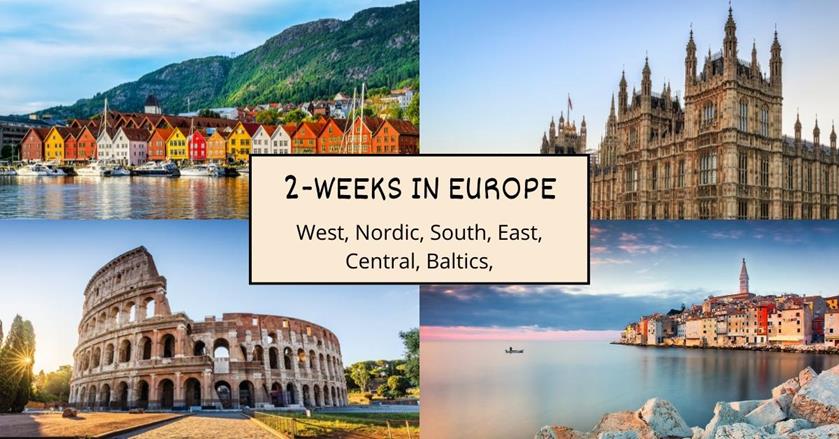
Before you go book your flight and hotels, take a look at the information below first. It will help you visualise and plan your itinerary better. You can get ideas on when to go, how to travel around, and what to pack.
When is the best time to go to Europe
This depends on what you plan to do. Most people go to Europe during summer, but of course, if you want to ski, come between December and February. I personally love going in spring and summer, during autumn, it’s also very pretty but it rains a lot.
You might want to consider travelling during the off-season because this is when there are fewer travellers and the prices of accommodations and tours aren’t sky-high so you’ll be able to save quite a bit.
Getting around Europe
The best way to get around Europe is to rent a car especially if the country you’re visiting are next to each other or have an open border agreement. It’s cheaper and gives you freedom of your time.
However, if you are crossing countries and they are not next to each other, you are probably better off flying than doing a long drive. Check first if your driver’s license is valid in Europe and check what type of cars each country you are going to have.
For example, Italy, Spain, and France are known for using a stick or manual transmission. While the UK and Ireland drive on the left.
Buses and trains are quite reliable and affordable. But there are also domestic flights which are affordable as long as you don’t pack too much unless you are willing to pay extra.
Language and currency
There are over 24 official languages in Europe. You should be able to get around with English but it’s important to also learn basic words to show respect for each country’s culture and easily communicate with locals.
Luckily though, most countries in Europe use Euro, except in the UK, Nordic countries, and maybe some countries in East Europe. It’s easy to pay with credit cards but carrying cash with you for emergencies is still advisable.
Visa and COVID-19 policy
Each country has different visa rules, however, if your destination is an EU member, they have the same visa policy; 90 days visa-free for visitors with a passport from North America, some Latin America, some Southeast Asia and East Asia, and most Oceania. This also applies to non-EU countries such as Switzerland and Norway.
For visitors with a passport from the EU or a European country, you should have freedom of movement for unlimited time except for some nationalities such as the UK and countries in East Europe.
Europe is open to COVID-1 vaccinated tourists. If you are unvaccinated, best to check if your destination has extra entry requirements. Depending on the airline and destination, you might be required to submit a test before boarding.
Wearing a mask is no longer required in many places in Europe, but it’s smart to carry one just in case you get to countries that still require them. Read about the EU reopening .
What is the average cost for 2 weeks in Europe
As diverse as the European culture is, the cost also varies a lot. The budget for 14 days in Europe depends on a few things such as the countries, type of tours, accommodation, and how you plan to move around.
$800 in Eastern Europe will not work for Scandinavia. $800 is a tight budget, but it might work for more affordable countries such as Eastern Europe or the Baltics (assuming this excludes the flights to the region and back). $1,000 will be fine for southern-east Europe, and $1,500 will be decent for central Europe. While west Europe and the Nordics plan to spend around $3,000.
The accommodation will cost the most expensive, but the food can be budgeted. Then the transportation. You can either use public transport or rent a push bike when moving around the cities. Take the bus or train when travelling to the next country or ride a plane.
Travelling during the peak season will also cost a lot more. Check under each itinerary to see the average cost of a 2-week trip in Europe.
Other basic travel tips
Planning a trip can be exhausting and often overwhelming. To make it a bit easier, I use travel sites and services that have flexible cancellation policies in case I change my mind or my travel dates. Here’s a list of travel tools I use. From flight selections, affordable hotels, wide-range options for car rentals, and even affordable travel insurance.
TOP PLACES IN EUROPE (pinned map)
Click the icon on the top right to enlarge the map. Credit: map data: Google
2 WEEKS IN EUROPE ITINERARIES
I will show your six itinerary options to choose from for your 14 days in Europe. Covering multiple countries and featuring famous attractions that are historical, cultural, and outdoor activities.
Deciding where to spend your 2 weeks in Europe can be hard. Should it be in Spain or Portugal? How about both? Should you visit Rome or Paris ? When unsure, there are a few things you can do to see which places are more suitable for you.
For example, Rome would be ideal if you love historical sites such as ruins. Perhaps you like history, but in the form of art, then Paris is the one. For food lovers, don’t miss visiting France, Spain, Italy, and Greece.
Itinerary #1 South Europe: Spain and France or France and Italy
We have two sub-options in our first itinerary for your 2 weeks in Europe. This includes either Spain and France or France and Italy. Spain is well-known for its lively culture, flamenco, arts, and literature, as well as its wines, beaches, and, of course, football.
If you feel like this itinerary is a little too expensive, you can instead go to Portugal. Take a look at how to spend 2 weeks in Portuga l or even just a few days in Lisbon. Spending 14 days in Southern Europe is a good place to do your first trip to this continent.
France, on the other hand, is well-known for macarons, wine, champagne, great pastries, as well as fashion, museums, and other historical sites. You could also do many water activities in France or if you plan to come during winter, you can head to the Alps for some skiing.
Italy is loved for its opera, its art cities, unique scenery, and good food. They are also among the four fashion capitals, with luxury brands, and of course, who could forget the Vespa?
If you have never been to Italy, make sure you visit Venice, Rome, Florence, and the southwest coast, where you can visit Naples for Amalfi and Sorrento. You can also consider 2 weeks in Greece for this itinerary. Not to mention, the south is a famous region to spend honeymoon in Europe .
Spain for 7 days

Spain is one of the most popular destinations in Europe, not only for foreign visitors but also for other European nations. With its stunning beaches, yummy food, and very welcoming culture, Spain is undeniably a must-visit when you come to Europe for 2 weeks.
Most people go to Madrid, the capital of Barcelona, a coastal city. However, if you want to get away from big crowds, head to Seville, Valencia, or even Zaragoza. For young travellers who love to dance and party, Ibiza is a top spot, while Palma, Tenerife, and Gran Canaria are awesome islands to explore and spend your vacation in.
We have a specific 2 weeks in Spain itinerary , which might help you plan a trip there if you decide to spend your trip in one European country only.
Here are some of the top-rated attractions in Spain :
- Alhambra and Generalife in Granada
- Palacio Real in Madrid – get your ticket in advance
- El Escorial near Madrid
- Aqueduct of Segovia – north of Madrid
- Sagrada Familia and Gaudi Sites in Barcelona – check tour prices
- Great Mosque in Cordoba, near Seville
- Guggenheim Museum in Bilbao
- Beaches of Gran Canaria
France for 7 days
Some of the options to reach France from Spain include flying, taking a train, riding the bus, using rideshare or driving. The most recommended option is to ride a plane, but if you have plenty of time, you should consider renting a car and driving on your own. We have an article with 3 different itineraries on how to spend 2 weeks in France .
France is a country famous for many reasons. The food is great, it is rich in culture, the abundance of historical sites, and thousands of wineries to explore. France is also known for Tour de France and is a great holiday destination any time of the year. You should geat a hop-on hop-off bu s that will take you to the top attractions of Paris.
Paris is an obvious place to visit, but if you don’t like big cities or have been here before, you can consider other places. For history buffs, head to Calais, Dunkirk, and Normandy. For those who love the outdoors, check out Lyon, Marseille, Nice, and Bordeaux (aka the Basque region).
Here are some of the top attractions n France:
- The Louvre in Paris – book a guided tour
- Cathédrale Notre-Dame de Chartres near Paris
- Eiffel Tower in Paris – get your skip-the-line ticket in advance
- Chateau de Versailles in Paris – visit with a garden access
- Mont Saint Michel
- Loire Valley Chateaux
- Côte d’Azur aka French Riviera in the South
- Provence for lavender fields
- Chamonix-Mont-Blanc for skiing in the Alps
Italy for 7 days
To reach Italy from France, you could either take the train or fly but taking the train is preferred by most tourists and locals alike because you’ll be able to reach your destination in less than five hours anyway. There are tons of routes to choose from if you want to see some interesting scenery and plan to drive instead.
2 weeks in Europe have to include Italy. It is loved for its dishes to die for, beautiful castles, amazing hiking trails, and warm culture. Just like in Spain and France, wine in Italy is world-class and their historical sites are well preserved.
Before you book anything, decide where you want to go. Rome and Venice are the top places to visit in Italy. But if you have been there, it’s time to explore Florence, Milan, Bologna, and Genoa in the north. For the south, head to Naples, Sicily, and all the way to Palermo. Check out our 4 itineraries for 2 weeks in Italy .
Some of the top tourist attractions in Italy include :
- Colosseum in Rome – get your ticket in advance to skip the very long queue
- Spanish Steps in Rome
- Trevi Fountain in Rome
- Venice Grand Canal – don’t skip the romantic gondola ride
- Gode Palace and St. Mark’s Basilica in Venice – explore with a tour guide and secure a ticket
- Leaning Tower of Pisa
- Vatican City near Rome; Basilica of St. Peter, Sistine Chapel & Vatican Museums – you can visit this in one go
- The Uffizi Gallery in Florence
- Cathedral of Santa Maria del Fiore in Florence
- Lake Como near Milan
- Cinque Terre
- Amalfi Coast
- Pompeii and Mount Vesuvius in Naples – visit this and the entirety of Naples on a day trip from Rome
Travel cost
These three destinations are one of the most expensive places in Europe. Budget around $2,000 for a 2-week trip around Spain, France, and Italy not including the flights from your location and back. Accommodation will be the most expensive cost while food is quite affordable in these places.
Of course, if you want to travel with luxury, you can easily spend $3,000-$5,000 which will allow you to stay at 4-5 star hotels, dine at fancy restaurants, and take a private car with a driver anywhere.
For those on a tight budget, $1,500 is possible , however, you will likely stay at youth hostels and share a room with other people in dorm/bunk rooms or even look at Couchsurfing. You can also save more money by looking at ready-to-eat meals at grocery stores or cooking in the hostel is possible. Join a free walking tour where you will be expected to give a tip based on the tour guide and the tour itself.
Itinerary #2 Central Europe: Germany and Poland
For this next itinerary, we’ll be covering 2 weeks in Central Europe, which consists of the countries Germany, Poland, Switzerland, Liechtenstein, Austria, Czechia, Slovakia, and Hungary. However, in this itinerary, we’ll only be covering Germany and Poland.
Germany is well-known for its cathedrals, castles, palaces, and colourful architecture, as well as its sausages and beers. It has many historical sites relating to World War I and II. Berlin is loved for being vegan-friendly, but meat-eaters shouldn’t have a problem finding their way around restaurants either.
Conversely, Poland is famous for its food, stunning geography, folklore, history, and friendly locals. In Poland, you’ll find Europe’s most ancient forest, Medieval Castle, the infamous Auschwitz-Birkenau Camp, amazing museums, and more.
Apart from that, you can also visit theme parks in Poland, such as Engerylandia Theme Park, Rabkoland, and Aquapark Sopot.

Germany for 8 days
Germany has so many things to offer that it would take 8 days to satiate your curiosity, and even then, you would barely scratch the surface. Don’t overwhelm yourself trying to see everything in 8 days. If you want t visit Germany only, we have these 2 weeks in Germany itineraries .
Most people will go to Berlin or Munich, but there are also other cities such as Hamburg, Frankfurt, Nuremberg and Cologne to name a few. I highly recommend you rent a car to move around easier, but taking a domestic flight or the train is also easy and affordable.
If you’re going to Berlin, the best way to see all the top attractions is by buying a hop-on hop-off bus with live a tour guide .
Here’s a list of the top attractions in Germany:
- Brandenburg Gate in Berlin
- Berlin Wall
- Cruise the River Spree – book a 2.5-hour boat tour
- Museum Island in Berlin
- Sachsenhausen Memorial – visit with a tour guide
- Neuschwanstein Castle near Munich
- Linderhof Palace near Munich – book a combo tour with Neuschwanstein Castle
- Marienplatz in Munich
- Pay respects at Dachau Concentration Camp – join a tour from Munich
- Kölner Dom in Cologne
- The Black Forest, Baden-Württemberg, near Stuttgart
- Miniatur Wunderland at Port of Hamburg
- Bamberg and the Bürgerstadt near Nuremberg
Poland for 8 days
There are tons of modes of transportation from Germany to Poland, including boarding a plane, using rideshare cars, trains, buses, or driving. Flights between these two countries are frequent and affordable.
Poland has a dark history, but the country is more than that. It has stunning lakes, UNESCO sites, and rather interesting cuisine, and it is in the top 20 safest countries in the world – a great place to discover if you are travelling alone.
Poland also has the biggest castle in the world, and many believe that vodka originated in Poland. In winter, you can ski in Poland, which is more affordable than France, Switzerland, and even Italy.
Many foreigners get confused and think Krakow is the capital of Piland, but it’s actually Warsaw. Apart from these two cities, you can also visit Gdansk, Wroclaw, Katowice, and Lublin. Most of the cities are connected via buses and trains hence moving around during your 2 weeks in Europe shouldn’t be a problem.
>>TIP: Check out our 2 weeks in Poland post if you prefer to explore that country on a single trip. There are two itineraries to choose from.
Here are some of the top tourist attractions in Poland:
- Wieliczka Salt Mine near Krakow
- Auschwitz- Birkenau Camps near Krakow – book a guided tour or combine it with the Wieliczka Salt Mine tour
- Oskar Schindler’s Enamel Factory in Krakow
- Wawel Royal Castle in Krakow
- Warsaw Old Marketplace
- Lazienki Park in Warsaw
- Malbork Castle near Gdansk
- Morskie Oko Lake and Hot Bath Pools near Zakopane – check tour prices
- Crooked Forest near Szczecin
Travel cost:
Central Europe in general can be costly, but only if you plan to visit Germany, Austria, and Switzerland. Poland and Czechia are both affordable destinations compared to their neighbouring countries. $2,000 will take you a long way if you choose one expensive place to spend a week and the other one is a more affordable country (e.g Germany and Poland or Switzerland and Czechia).
You can save even more money if you focus on Poland or Czechia only or book a trip to Switzerland just for 2-3 days instead of an entire week.
$5,000 will be a great budget for a luxury trip . This is suitable for couples who are on their honeymoon or retiree travellers. For young visitors and backpackers, you can probably get away with $1,000 to $1,500 for the 2 weeks trip .
Accommodation in Germany, Switzerland, and Austria is costly but affordable in Poland and Czechia. Rely on using public transportation in all countries, such as buses and trains, instead of renting a car or flying.
Itinerary #3 Baltics: Lithuania, Latvia, Estonia
The Baltics are one of the most affordable regions in Europe. Although it has its fair share of tourists, the streets and attractions don’t get too busy, even during the summer season. It’s an awesome place to spend your 2 weeks in Europe vacation without being surrounded by a big crowd.
Lithuania is famous for its natural scenery, including forests, lakes, flatlands, and other landscapes. There are also historical spots here to visit, and you must try their local ciders. I personally loved their local food, especially beetroot. If you’re a foody, check this Vilnius food guide for a list of must-try dishes.
Conversely, Latvia is known for its UNESCO World Heritage Sites and art nouveau architecture. It’s on the coast, hence if visiting during summer, don’t forget to dip your toes.
Last but definitely not least is Estonia, which is famous for its dense woods, thousands of uninhabited islands, and rich history. It experienced a boom in tourism recently since it implemented a digital nomad visa.
Estonia is among Europe’s most linguistic nations, is one of the countries with the cleanest air in the world, and half of the country is made up of forest, which probably explains the great air quality. We also have two itineraries specifically for 2 weeks in the Baltics only or 2 weeks in Eastern Europe itineraries .
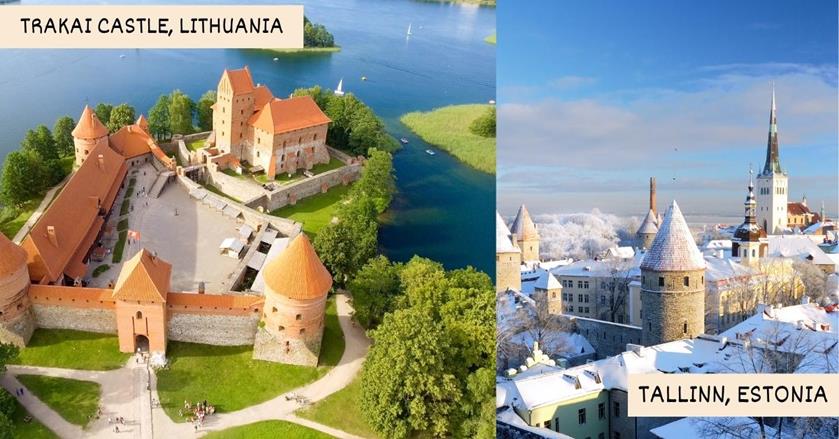
Lithuania for 5 days
Lithuania is rich in cultural preservation, so much so that UNESCO considered their folk dance as one of the intangible cultural heritages. They also have one of the oldest languages, even older than Greek, German, and Celtic, and the oldest tree in Europe could be found here as well.
With five days in Lithuania, you can do and see a lot of things. You can cover at least two major cities; the capital city Vilnius, and the cultural art city of Kaunas. If it’s warm enough, head to the coast and visit Klaipeda.
Here is a list of the best places to see in Lithuania:
- Gediminas Castle Tower in Vilnius
- Vilnius Cathedral Square
- Hot Air Balloon Flight – over Vilnius or Trakai Castle
- Energetikos ir technikos muziejus in Vilnius
- Museum of Occupations and Freedom Fights and A.Mickiewicz Memorial Museum in Vilnius
- MO Muziejus in Vilnius
- Gates of Dawn in Vilnius
- Three Crosses Monument in Vilnius – join a full-day tour from Vilnius
- Walk around Uzupis
- Trakai Castle near Vilnius
- Kaunas Castle
- Devils’ Museum in Kaunas
- Hill of Crosses near Šiauliai
Latvia for 4 days
You can go to Latvia from Lithuania by driving, riding a bus, plane, or taking the train. The most recommended option is through riding a bus as it is the cheapest and fastest. Latvia is also a great destination during summer. You can take a swim on its sandy beaches, lakes, and rivers.
You can either spend the entire 4 days in Riga, the capital city or take day trips to see Gauja National Park and Turaida Museum Reserve for example. You can also explore Riga on a segway tour .
Here are some of the top tourist attractions in Latvia :
- House of the Black Heads in Riga – get your ticket in advance
- Riga Cathedral
- Three Brothers, Latvian Museum of Architecture
- St. Peter’s Church
- The Freedom Monument in Riga
- Shop souvenirs at Riga Central Market – join a food-tasting tour
- Gauja National Park outside of Riga
- Rundale Palace and Museum ner Jelgava
Estonia for 4 days
To reach Estonia if you’re coming from Latvia, you could board a plane, ride a bus, take the train, or drive. The most recommended option would be to ride a plane as it’s the fastest, but the cheapest option would be to take the bus.
Estonia is very unique, they have islands but are inhabited – and that makes them interesting to visit. There, you can go fishing, sailing, canoeing, kayaking, and for those who love birds, birdwatching is a popular thing to do in Estonia.
Tallinn, the capital, is obviously the most popular destination. However, with 2 weeks in Europe, around the Baltics, you can also head to Parnu and Tartu – both are located in the south of Estonia. Go to Haeska, Kabili, and Matsalu for birdwatching and wildlife experiences.
Here are some of the sights to see in Estonia :
- Tallinn’s Old Town
- Lennusadam Seaplane Harbor in Tallinn
- Lahemaa National Parl – sign up to a day trip
- Patarei Prison Exhibition/Communism Prison in Tallinn
- Parnu’s Beaches
- Alpakafarm near Parnu
- Estonian National Museum in Tartu
- Tagurpidi Maja (Peapeal OÜ) / Upside Down House in Tartu
- TYPA Letterpress and Paper Art Centre in Tartu
- Kuressaare Castle in Saare
- Join a 3-hour food tour
Travelling around the Baltics is one of my favourite destinations and one I recommend if you’re on a budget. You will still experience the European culture, walk through the alleys and paves with cobbled stone, and eat delicious meals.
It’s honestly possible to travel here for around $1,000 for those on a budget . You will stay in a hostel and consume street food or grocery store meals. The tours also don’t cost that much. Accommodation is around $25 to $35 a night, but transportation is cheap.
$2,000 is the average cost where you get to have a private room and try out a few local restaurants. For a luxury trip, $3,000 will get you very comfortable.
Itinerary #4 East Europe: Hungary and Croatia or Romania and Bulgaria
East Europe is a massive region. You will have to choose 2-3 countries to cover during your visit and perhaps next time, you go to new places. Right now, we’ll only cover 4 destinations for your 12-day in Europe itinerary; Hungary and Croatia or Romania and Bulgaria.
Croatia has so much to offer, but in the last few years, being the filming location of Game of Thrones, this country attracted more tourists. Aside from that, they also have stunning waterfalls and gorgeous Adriatic Islands, among other landscapes.
Hungary on the other hand is famous for its ruin bars, paprikas, and goulash. It also has sought-after outdoor and public thermal bars and great nightlife. Outside the city, Hungary has a lot of nature preserves and can be an affordable ski destination in winter.
Bulgaria is the oldest country in Europe and has tons of hot springs. It’s undeniable how affordable Bulgaria is as a travel destination. It also sits right on the Black Sea, a popular spot during summer.
Nightlife in Bulgaria is another reason tourists come here for its affordability. Speaking of cuisine, the traditional Bulgarian food is something of a must-try.
Romania is famous for its Carpathian Mountains, Salt Mines, and Medieval Fortresses. Just like Bulgaria, it’s also located on the Black Sea. One might want to visit Romania since it’s famous for being the home of Dracula.
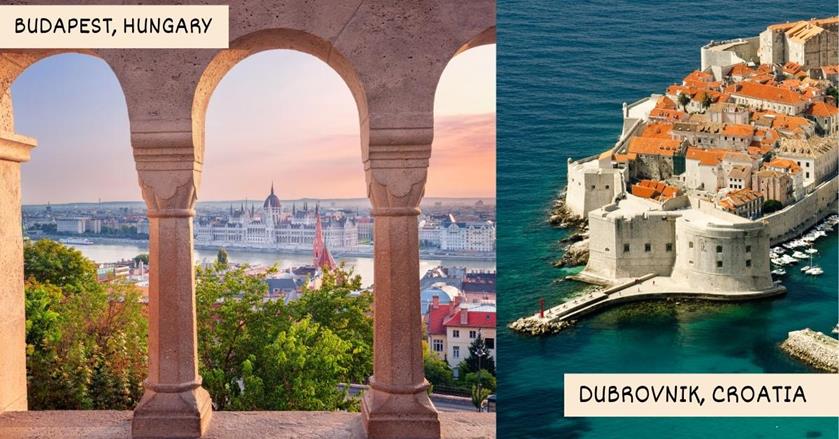
Hungary for 7 days
Hungary, like many other European countries, is a landlocked country. But it doesn’t mean you can’t enjoy summer in Hungary. This country has over 1,000 natural springs water, hence, the popularity of its thermal baths.
Budapest is not the only city worth visiting in Hungary, you should also consider Debrecen and Szeged. While Balaton Uplands National Park is the spot to you want to go hiking, join wine tours, and be around nature.
Here are some of the top tourist attractions in this country :
- Hungarian Parliament Building in Budapest
- Budapest’s Széchenyi Thermal Bath – book a full-day spa
- Buda Castle
- Buy souvenirs at Central Market Hall
- Take a boat cruise Danube River in Budapest – check cruise prices
- Matthias Church in Budapest
- Esztergom Basilica
- The Caves of Lillafured near Miskolc
- Lavender field at Tihany
Croatia for 7 days
It is relatively easy to travel to Croatia if you’re coming from Hungary as they are neighbouring countries. You could travel by bus, by train or by driving. Any option is fine, but the cheapest option would be to ride the night bus.
As mentioned before, Croatia is now popular for being the filming location for Game of Thrones, but there are other places to see in this magnificent country. Just like its neighbouring country of Italy, Croatia is also a fantastic beach destination and so much more affordable.
Zagreb is the capital of Croatia and a must-visit, then you can go to the coast. The most popular city is Split and Dubrovnik, but Zadar, Hvar, and Pula are an equally stunning area for swimming and other water activities.
Want to spend 14 days in Croatia ? Our guide has three itineraries you can check out and see which one suits you best.
Some of the top tourist attractions in this country include :
- Dubrovnik’s Old Town Walls – join a walking tour
- Trsteno Arboretum, Trsteno near Dubrovnik
- Dubrovnik’s Lovrijenac Fort
- Visit Game of Thrones filming locations – book a tour
- Nikola Tesla Technical Museum in Zagreb
- Diocletian’s Palace in Split – enjoy a walking tour with a local guide
- Blue Cave, near Split – book the 5 island boat tour
- Krka Waterfalls, near Split – visit on a boat tour
- Plitvice Lakes National Park near Zadar
- Kornati National Park near Zadar
- Euphrasian Basilica in Porec
- Pula’s Roman Arena
- Swim at Galebove Stijene in Pula
- Explore Brijuni/Brioni National Park near Pula
- Mulini Beach in Rovinj
Romania for 7 days
A massive country in East Europe, Romania has a lot to offer. From national parks, vibrant cities, historical sites, and beach access to the Black Sea. Bucharest is known for great nightlife, but apart from that, it’s also rich in cultural and historical spots.
Other than Bucharest, you have to go to the Transylvanian region, known as the home of Dracula. If it’s warm enough, head to Constanza, while Brasov and Cluj-Napoca are the areas to go to during winter for skiing and other winter activities.
Here are some of the places you could visit once you reached Romania:
- Romanian Athenaeum in Bucharest
- Grigore Antipa National Museum of Natural History in Bucharest
- National Museum of Romanian History in Bucharest
- Dimitrie Gusti National Village Museum in Bucharest
- Vaser Valley Forestry Railway
- Bran Castle aka Dracula’s Castle in Transylvania – book a tour combo with Peles and Brasov trip
- Sighisoara Historic Center
- Covered Stairway in Sighisoara
- The Clock Tower in Sighisoara
- The Black Church in Brasov
- Peles Castle near Brasov – book a 2-day tour from Bucharest to visit Brasov, Sibiu, and Sighisoara
- Bucegi Natural Park near Brasoc
- Transylvanian Alps
Bulgaria for 7 days
Just south of Romania, you can reach Bulgaria by train, bus, or driving. The quickest option would be to drive, which would take you more or less five hours, but the cheapest option is by riding a train.
Another country with the best nightlife, Bulgaria is popular with young tourists. But it doesn’t mean non-partygoers cannot enjoy Bulgaria. This country is a great place to explore the outdoors. There are many hiking trails and to ski here, you don’t have to spend too much.
Head to the capital city, Sofia, but for winter sports, you can go to Bansko, Borovets, and Pamporovo. If you are coming during the warm months, you can still go to the Black Sea by heading toward Varna.
Some of the top spots in Bulgaria are:
- National Palace of Culture in Sofia
- Sofia History Museum
- Rila Monastery – visit with combo tour to Boyana Church
- Seven Rila Lakes – check tour price from Sofia
- Tsarevets Fortress in Veliko Tarnovo
- Belogradchik Rocks
- Prohodna Cave in Karlukovo
- Krushuna Waterfalls
- The Rose Valley near Kazanluk
- The Ancient Theatre of Philippopolis in Plovdiv – join a tour of Plovdiv, Asen’s Fortress, and Bachkovo Monastery
- Pirin National Park near Plovdiv
- Thracian Tomb of Sveshtari near Shumen
East Europe is one of the most affordable regions in Europe. The accommodation alone can range between $20-$30 while food and the use of public transportation are also very affordable.
It’s easy to travel on a budget in eastern Europe, around $800 is feasible for backpackers and young travellers. If you want to be comfortable, $1,000 will be great and get you your own private room and dine at restaurants. $2,000 can easily be a luxury trip in this region for a 2-week adventure.
Itinerary #5 Nordic: Iceland, Norway, and Denmark
The next option would be the Nordic countries, which consist of Norway, Iceland, Sweden, Finland, and Denmark. However, in this itinerary, we will only cover Norway, Iceland, and Denmark.
Norway is also known as the Land of the Midnight Sun. It is famous for its fjords, lakes, and magical skies (Aurora Borealis), as well as Viking culture and folklore.
Iceland is also famous for a lot of natural wonders such as geysers, active volcanoes, and glaciers. You could also see the Northern Lights here. Iceland is relying 100% on renewable energy; hydropower, and geothermal.
Last but definitely not least is Denmark, which is well-known for its coastal towns, architecture, Royalty, and cuisine. Copenhagen is a must-visit. If you find yourself with extra time, you can hop on a train and head to Sweden.
You can also just visit Denmark, Norway, and Sweden using our 2 weeks in Scandinavia itinerary .

Iceland for 4 days
Iceland is the land of fire and ice, and you might be wondering why. They have glaciers but have volcanically heated pools at the same time, where you could swim all year round. That’s pretty fascinating.
Aside from that, it is also a literary-focused country. In fact, one out of ten Icelanders will publish a book even at least once in their lifetime.
Iceland is not a big country, but spending four days here is plenty. Most tourists love staying in Reykjavik, but you don’t have to. If you want to save money, you can stay outside the city and rent a car instead. You can easily move around in your own car, which means it doesn’t matter if your hotel is not in the city.
We have a complete guide and itinerary for 2 weeks in Iceland .
Top attractions in Iceland:
- Drive the Golden Circle
- Blue Lagoon – get your ticket in advance including Kerid Volcanic Crater
- Gullfoss Falls
- Seljalandsfoss
- Silfra – snorkel between 2 tectonic plates between North American and Europe
- Þingvellir National Park
- Jökulsárlón
- Chase the Northern Lights – join a tour to find the best spot
- Icelandic Phallological Museum
- National Museum of Iceland
- Reykjanesfólkvangur
- Whale Watching near Reykjavik – book a cruise
- Eystri-Fellsfjara / Diamond Beach
Norway for 6 days
You will need to ride a plane to reach Norway if you’re coming from Iceland. The fastest route takes more or less 6 hours. However, the journey would be worth it because there are so many sights and sceneries once you reach Norway.
This includes the world’s longest road tunnel and the world’s most remote island, among others. This is also an amazing place to ski during winter.
Many tourists usually go to Oslo and Bergen, but you can also add Stavanger, Kristiansand, and Tromso to your itinerary of 2 weeks in Europe.
If you want to see Fjords, you have to head west; from Trondheim all the way down to Stavanger. Check our 2 weeks in Norway itinerary list if you only want to see this country.
Here is a list of some of the best places to visit in Norway:
- Bygdoy Peninsula in Oslo
- Vigeland Sculpture Park in Oslo
- Viking Ship Museum in Oslo
- Naeroyfjorden
- Akershus Fortress in Oslo
- Oslo’s Fjords – check tour prices or a cruise to Nærøyfjorden, Flåm, and Stegastein
- Hanseviertel Bryggen in Bergen
- Sognefjord near Bergen
- Osterrjod and Mostraumen near Bergen – join a cruise
- Pulpit Rock (Preikestolen), in Stavanger
- Lofoten Islands
- Geirangerfjord
- Arctic Museum in Tromso
- Find the Northern Lights from Tromso – book a guided tour
- Atlantic Ocean Road
Denmark for 4 days
To reach Denmark from Norway, the best would be to take a plane. There is also a car ferry service, but with a limited time, it’s not ideal. Denmark has the oldest Monarchy in Europe.
Denmark is a small country but popular not only in Europe but around the world. For many years, it has been voted the happiest country in the world. It’s also known for being safe for tourists, the home birth of lego, and has the oldest monarchy in Europe and the oldest flag in the world.
Naturally, visitors will go to Copenhagen, but since the country (excluding Greenland and the Faroe Islands) is not that big, 4 days in Denmark is plenty
You can explore the entirety of Copenhagen and even have time to go to Odense, where the famous children’s book author Hans Christian Andersen was born. You can actually get to the city centre from Copenhagen airport in just 13 minutes – a great way to save time.
Here is a list of some of the best attractions in Denmark:
- The Little Mermaid (Den Lille Havfrue) – explore Copenhagen in a day
- Freetown Christiania
- The King’s Garden
- Amalienborg
- Rosenborg Castle
- Tivoli Gardens – get your ticket in advance
- Botanical Garden
- The Round Tower
- Memorial Anchor
- Copenhagen Opera House
- Walk around Strøget
- Ny Carlsberg Glyptotek
- Christiansborg Palace
- Danish Architecture Centre
- Ofelia Plads
- Legoland in Billund
- Hans Christian Andersen’s Childhood Home
- H. C. Andersens House
Nordic and Scandinavia is undeniably the most expensive place to travel around Europe. Accommodation alone could run $100, and dining and consuming alcohol are costly as well. But taking the bus and train is a little bearable.
To ensure that you will enjoy your 2 weeks in Europe around this region, plan to spend about $2,000 . If you are on a budget, you can probably do it for $1,700 but no less. But for l uxury, your trip cost will really skyrocket up to $5,000 .
Itinerary #6 West Europe: The UK, Netherlands, and Belgium
The last itinerary option for your 2 weeks in Europe includes the countries the UK, Netherlands, and Belgium, also known as the west of Europe.
The UK is popular for many things, including its monarchy, culture, history, and performers. Being the home of four different countries; England, Scotland, Wales, and Northern Ireland, you can easily say that it’s worth a visit. From bustling cities, amazing hiking trails, pubs to check out, and castles to explore.
There are tons of iconic places in the Netherlands despite it being a small country. The Netherlands is famous for many things . Here, you’ll be able to see windmills, cheese markets, bulb fields, and earthenware, among others. The Netherlands also have plenty of historical spots to discover including Anne Frank’s House.
The last country on our list is Belgium. They have high-quality chocolates, hence the name Belgian chocolate. This country is also well-known for waffles and beer and is the home to NATO headquarters.

The UK for 6 days
There are many things to see in the UK, and six days is definitely not going to be enough. But don’t panic. If this is your first time here, list the attractions you really want to see first. The world-famous Big Ben, London Eye, and River Thames can all be found here, and that’s just in London.
If you have been here before, perhaps, you can now explore less popular areas. Perhaps, you can focus on hiking instead of being in the city or just spend 14 days in England only, especially if it’s your first time.
It’s undeniable that the UK has the most famous monarchy in the world. London alone has a lot of attractions related to the British Monarchy and historical places. In order to make the most out of your trip, the recommended duration of stay is at least five days.
ALSO READ: 2 weeks in the UK , 2 weeks in England , and 2 weeks in Ireland and Northern Ireland itineraries.
List of some best places to see in the UK :
- Tower Bridge
- Stonehenge – book a combo tour with Windsor Castle and Bath
- Buckingham Palace
- The British Museum
- Tower of London and Crown Jewels Exhibition – buy your ticket in advance
- Kensington Palace
- Madame Tussauds – get your skip-the-line ticket
- Shakespeare’s Globe
- St. Paul’s Cathedral
- Book a Harry Potter tour – Warner Bros. Studio
- Scotney Castle
- Bodiam Castle
- Warwick Castle
- Lake District National Park
- Dean Village
- Edinburgh Castle – book a skip-the-line tour
- Palace of Holyroodhouse
- Loch Ness, Glencoe, and the Scottish Highlands – check the tour price from Edinburgh
- Loch Lomond & The Trossachs National Park
- Titanic Belfast – join a guided tour
- Crumlin Road Gaol
- Giants Causeway – visit with a stop at Dark Hedges, Dunluce, and Belfast
- Free Derry Corner
- The Derry Walls
The Netherlands for 4 days
You could either ride the train or drive if you want to reach the Netherlands from the UK. Once you reach the Netherlands, you could experience the biggest ice skating tour in the world, or join a cycling tour. You can also know more about world-famous painters like Van Gogh and Rembrandt.
Four days sounds too little but you can actually do a lot while in the Netherlands. You can of course explore Amsterdam, and head to The Hague, Rotterdam, and Groningen.
Some things to see and do in The Netherlands:
- Jordaan and Amsterdam’s Canals – book the famous canal cruise
- Anne Frank House
- Rijksmuseum
- Mauritshuis
- Van Gogh Museum – enjoy with an audio guide
- The Windmills of Kinderdijk
- Hoge Veluwe National Park
- Valkenburg Castle Ruins
Belgium for 4 days
To reach Belgium, you could ride the train, ride a bus, use rideshare, or drive. The cheapest option would be to use rideshare and the most recommended option would be to ride the train. It would take you almost 3 hours to reach your destination.
The popular cities in Belgium are Brussels which is the capital, Ghent, Antwerp, and Bruges. You can take buses, trains, or rent a car to travel between cities. Don’t forget to go try different beers and waffles which are two of my favourite part of my visit.
Popular attractions in Belgium:
- Grand Palace
- Atomium – get your entry ticket in advance
- Sign up for the famous Hungry Mary’s beer and chocolate tour or join chocolate making class
- Manneken Pis
- Day trip to Bruges and Ghent – enjoy with a tour guide
- The Canals of Bruges
- Battlefield in Flanders
- Belfry of Bruges
- Basilica of the Holy Blood
- Bruges Beer Experience
- Sint-Salvatorskathedraal
- Gravensteen
- Museum Aan de Stroom
- The Rubens House
What I enjoy about travelling in western Europe is how it’s honestly a pricey place but it can be done on a budget. If you think you can stay on your feet for long hours and walking around is not a problem, you can easily cut costs by taking the bus or taxi. The accommodation will surely get you, but dining can be affordable.
The street food in all these countries is fun, globally diverse, and easy to find. For budget travellers, $1,700 is required for your 2-week trip and most likely requires you to stay in a youth hostel. $ 2,500 offers comfort and a bit of luxury where you can dine at nice restaurants. $4,000 means you can stay in hotels right downtown and near the top attractions, With this budget, you can even hire taxis during your entire trip.
SUMMARY OF 2 WEEKS IN EUROPE
There are so many countries to choose from if you plan to visit Europe. Fortunately, Europe has amazing transportation between cities and countries, making it easy to travel around even with limited time.
When planning your 14-day itinerary for Europe, don’t try to cram it too much. It’s better to travel a bit slower, see fewer places, but be able to enjoy and process everything you have seen and experienced. Europe is not going anywhere, you can always visit again and check out a new place.
I hope that you found these 2 weeks in Europe itineraries helpful in planning your own.
TO SAVE THIS ITINERARY, PIN THIS IMAGE BELOW:

You are here
How much money do i need to travel europe.
For some people, setting a budget is just one more exciting thing to do when planning their European holiday. Mainly because it gives them an opportunity to dream about the castles and banquets they’ll be spending their euros on.
Then there are others who dread the whole ordeal – probably the same people who haven’t visited the dentist in a year.
Knowing things is hard. And who’s got time for calculations?*
Allow me to introduce you to the amazing Holiday Budget robot planner 3000! (Well, it’s not really called that). Planning a budget is hard, it’s not like you just know the cost of a bratwurst and a 1L jug of beer in Munich off the top of your head is it? That’s impressive if you do, but our Holiday Budget Planner actually does know that kind of stuff. Try it out below!
*Ain’t nobody got time for that.
Try our fancy new budget calculator (above) now!
How to plan a trip to Europe with a budget
First up, you need to figure out what you need to budget for.
To work out your rough costs, you’ll need to know:
- Where you’re going – for flight costs.
- How long you’ll be away – for nightly accommodation costs.
- How you want to get around – for transport costs.
It also helps to budget with those you’ll be travelling with, so you can work out what costs are solely yours and what you can share. It’s also a good way to set out what type of holiday you want to have. If you’re a budget traveller who wants to hostel-hop your way through Europe, your budget will be very different to the traveller that wants 5-star, all-inclusive, buffet breakfast, city-view, luxury hotels.
I_DemiQuinn_Mykonos-770x578_90kb.jpg
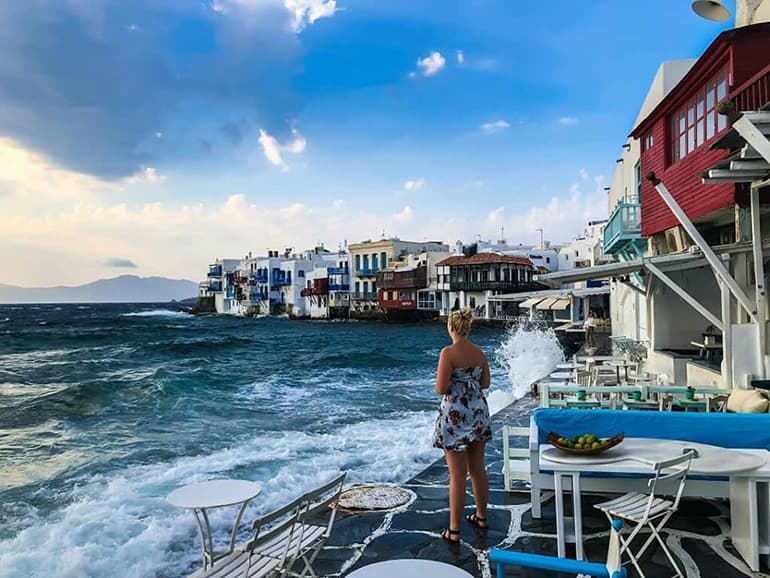
How much does a Europe trip cost?
Let’s take a look at a few examples of different kinds of holidays you could have in Europe, and address some of those big-ticket costs that need to be budgeted for.
The lovey-dovey couple
This romantic pair is travelling through London for 2 weeks during its beautiful, warm summer. Between them, they’ll need just under $10,000 AUD for flights, accommodation and daily transport.
The solo backpacker
This lucky vagabond is travelling Solo (not even Chewbacca is invited). They’re hitting up France , Spain , Italy and Greece for a whole month of adventure. Depending on how frugal they decide to be, they’ll need about $4,000AUD for flights, accommodation and public transport. Don’t forget to budget your meals and adventures though!
The fun family
This wonderful family of 2 adults and 2 kids (under age 11) is going on a cruise to visit Barcelona during the school holidays – lucky kids… The parents will need to save around $13,000AUD worth of pennies to afford the flights, cruise and accommodation for this trip.
Note that these are your core expenses. Other costs from travel insurance, daily expenses like food and drinks, sightseeing, activities and all those shopping trips aren’t taken into account.
Costs of travelling Europe per day
We’ve looked at the big stuff, now let’s get into the intricate expenses.
First of all, a good holiday budget will keep in mind where you can tighten up on expenses – and where you can splurge! Having this type of flexible holiday budget is essential because you never know when an opportunity might come up that you don’t want to miss out on.
For a middle-of-the-road holiday (neither budget nor luxury living) we recommend from:
AU$100 to AU$150 per person, per day.
This will cover sightseeing, food and drinks, shopping and other nitty-gritties. But of course, there are heaps of ways to cut down on this cost – or add to it – to create your preferred budget.
Travel Money Oz Infographics_14_Blog.jpg
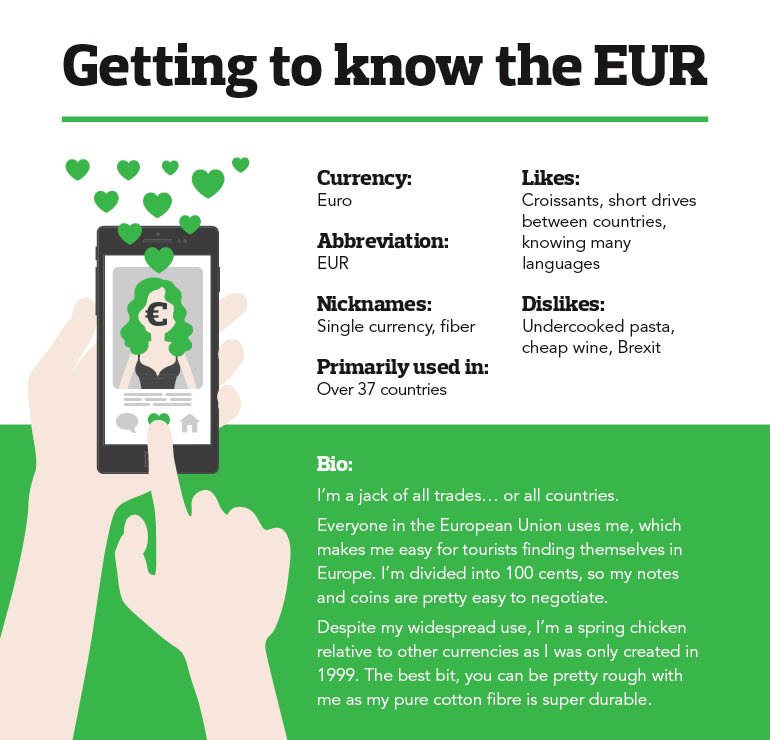
Consider your bookings
It helps knowing exactly what’s included in what you’ve booked. Does your hotel include breakfast in the per night cost? If it does, then that’s one less thing you need to budget for. Or does your accommodation have kitchen facilities? That gives you a cheap’n’easy, DIY meal option.
You can also look for other ways to save. Can you purchase a public transport pass, rather than buying single tickets (as usually, this will offer some savings)? Or can you purchase a sightseeing pass that includes entry costs and public transport? If you can, why not go for it and save.
Final words on budgeting
Well, that was probably a lot to take in, so let’s finish up with some easy-peasy dot points.
- It can help to have a pre-agreed cost for things (pre-agreed with yourself, or your travel companions if you’re splitting costs). This avoids arguments, stress and overspending.
- Put time and research into your ‘per day’ budget and include the things you really want to do. Once you know the costs, you have a goal to save for.
- It pays to book things in advance, but sometimes you might be able to find a cheaper price when you are in the country
- Don’t forget to factor in your pre-travel costs (e.g. travel insurance, immunisations and visas).
- Budget for cheap eats some days so you can gorge other days. From enjoying a glass of champagne at the top of the Eiffel Tower to devouring food at Germany’s food stalls.
- Don’t forget those sneaky costs (e.g. transfers, tours and tipping).
If you still need help with setting a holiday budget, our travel money experts have a handy budgeting tool available in any of our 165 stores across Australia and New Zealand.
*Flight costs based on search from www.flightcentre.com.au and are indicative costs only, based on prices available on 10 August 2018. ^Accommodation costs are based on an average per night price for budget , moderate or luxury hotels, as indicated in the table. ~Cruise cost is based on search from www.ncl.com for a 7 night Western Mediterranean cruise onboard Norwegian Epic, departing Barcelona in May 2019, and is an indicative cost only, based on prices available on 10 August 2018. **Rail Pass cost is based on search from http://www.eurail.com and is an indicative cost only. COST COMPARISON TABLE: All costs are based on estimated approximate costs from major metropolitan cities in each country. “From” costs indicate costs that start from the indicated price and may be higher than shown. Average prices indicate a typical estimated cost you would pay for the indicated item. Prices may vary from time to time, and in different cities and towns within each country. Cities included are: London, United Kingdom; Rome, Italy; Paris, France; Berlin, Germany; Barcelona, Spain; Athens, Greece; Budapest, Hungary; Prague, Czech Republic; Amsterdam, The Netherlands. This blog is provided for information only and does not take into consideration your objectives, financial situation or needs. You should consider whether the information and suggestions contained in any blog entry are appropriate for you, having regard to your own objectives, financial situation and needs. While we take reasonable care in providing the blog, we give no warranties or representations that it is complete or accurate, or is appropriate for you. We are not liable for any loss caused, whether due to negligence or otherwise, arising from use of, or reliance on, the information and/or suggestions contained in this blog.
AUD News: Global growth concerns continue to put a cap on Aussie dollars performance
Travel hacks: halloween hotspots around the world, more like this.

- EN - English
- PT - Portuguese
- ES - Spanish
- How it works
- Become a Host
- Download the app
Top Destinations
- United States
- United Kingdom
What type of experience are you looking for?
- Non-Profit School
- Permaculture project
- Eco Village
- Holistic Center
- Guest House
- How Worldpackers works

Learn from the most experienced travelers of the community
Traveling with worldpackers, planning and budgeting for travel, make a living while traveling as a lifestyle, travel with worldpackers.
- Using Worldpackers
- Work exchange
- Social impact
Plan your trip
- Women traveling
- Budget travel
- Solo travel
- Language learning
- Travel tips
- Get inspired
- Digital nomads
- Travel jobs
- Personal development
- Responsible travel
- Connect with nature
Top destinations
- South America
- Central America
- North America
- More destinations
- WP Life WP Life
- Exclusive discounts Discounts
- Europe travel tips
What is the average cost of a trip to Europe?
A summary of what a trip to Europe may cost, based on different travel styles, time frames, and destinations.
Gabrielle Budget Travel With Gabby
Mar 05, 2024

Europe is one of the most fascinating continents in the world. With 44 countries packed into a relatively small area, you can hop from country to country quickly and cheaply.
And between each country, the landscapes, cultures, and histories vary so much. You can jump on a bus or train for a few hours and end up in a completely different world from where you started.
Currency, language, architecture, traditions, cuisine, and lifestyles are so different in various European countries. It’s such an amazing place to travel because you can experience and learn so much in a shorter time than you could on other continents.
So for anyone who is planning a trip to Europe , you may be wondering how much money you need. As a whole, Europe is one of the more expensive continents to travel around. South America or Asia would be much cheaper.
But it is possible to explore Europe on a budget . And it is important to note that every traveler is different, so the average cost of a trip to Europe could vary greatly from person to person.
But we’ll provide a general Europe trip budget that can be used as a guideline. We’ll also explain some of the main factors that may affect your Europe trip cost, such as where you go, how long your go for, and your travel style. So let’s dive into the average cost of a trip to Europe.

Important to consider when creating a Europe trip budget
The cost of a European vacation will be different for every person because every traveler is different. But there are some factors that will greatly influence your Europe trip cost . Here are some important things to consider when planning a trip to Europe and estimating how much money you will need.
Some countries are cheaper than others
As I mentioned earlier, countries in Europe are completely different from each other despite being so close together geographically. When thinking about the average cost of a trip to Europe, it is important to think about which countries you will be visiting .
Generally speaking, countries in Eastern Europe are much more affordable than countries in Western and Northern Europe. Most tourists tend to head to Western Europe, whereas the eastern side of the continent isn’t as touristy. That means you get much better value for money in the east.
Some of the cheapest countries to visit in Eastern Europe include Albania , Romania , Bulgaria , Serbia , Montenegro , Hungary , and more. Countries like Greece and Croatia are a bit more touristy and expensive, but they are still generally cheaper than Western Europe. If you spend more time in these countries, your money will go much further.
The most expensive countries in Europe to visit include France , England , Sweden , Norway , Denmark , Switzerland , and Germany . All of these are in Western or Northern Europe, with Scandinavia being one of the most expensive regions in the world. If you spend lots of time here, you’ll need more money for your trip. Countries that are mid-range include Italy, Portugal, Czech Republic, Poland, Slovakia, Austria, Spain, Latvia, and more.
What is your travel style?
Another factor that will affect the average cost of a trip to Europe is your travel style. Are you a frugal budget traveler? Or do you enjoy luxury? The way you choose to spend your money will greatly affect your Europe travel budget.
For example, a luxury travel style may look like this: staying in 5-star hotels, eating in nice restaurants, getting cocktails in bars, booking expensive excursions and guided tours, shopping for clothes or souvenirs, taking private taxis everywhere, etc. This type of travel style means you will need a lot more money than the average person.
A budget traveler in Europe may have a travel style that is more like this: staying in backpacker hostels , couchsurfing, doing work exchanges , cooking their own meals, eating street food, taking public transport, hitchhiking, prioritizing free attractions, avoiding tourist traps and souvenir shops, flying budget airlines, drinking cheap beer and wine at happy hours, shopping at local markets, etc. With this type of travel style, you won’t spend as much money so you can do more with a smaller budget.
A mid-range traveler will be somewhere in between. It’s a good idea to have balance while traveling. You can travel longer with less money if you use some budget travel tips, but it’s fun to treat yourself as well.
Work exchanges are a great way to travel in Europe because you can save money on accommodation, get to know the locals, and use your saved money for other things like tours and attractions. Some examples of popular work exchanges in Europe include:
- Work in an organic kitchen at a sustainable community in Germany
- Volunteer at a permaculture project in Bulgaria
- Help take care of the local dogs at a homestay in Spain
- Work as a yoga teacher on an island in Greece
- Help with gardening and animal care at a guest house in Sweden
- Take care of the horses at a homestay in Ireland
- Work at a fun, social hostel in Croatia
- Learn to grow food at an eco farm in Slovenia
- Work with a local family at a winery in Italy
These are just a few examples of top-rated work exchanges in Europe where you can lower your trip costs.

Average cost of traveling to Europe on a budget
For the purpose of this article, I’ll be breaking down the average cost of traveling to Europe on a budget . This is the bare minimum you’ll be spending on your trip if you travel on a backpacker budget. So take into account your travel style and tack on more money accordingly.
Accommodation
Budget travelers in Europe have a few different options for accommodation . Hostels, work exchanges, and couchsurfing are the most popular. All of these options are significantly cheaper than staying in a hotel.
One night in a hostel dorm room in Europe will cost around 20 Euros , on average. This will vary depending on where in Europe you are staying. For example, expensive cities like London , Paris , Reykjavik , Amsterdam , Berlin , Stockholm , or Interlaken will have prices closer to 30 Euros per night. Cheap cities like Warsaw , Budapest , Sofia , Bucharest , and Tirana will have prices closer to 10 Euros per night.
And if you want to find free accommodation in Europe , work exchanges or couchsurfing is the way to go. Accommodation is usually the biggest expense while traveling, so finding free places to stay will significantly lower the average cost of a trip to Europe.
For a work exchange, you’ll work around 20 hours per week to get free accommodation and sometimes free meals. Couchsurfing is another option - It's an online platform where you can find locals that open up their homes to travelers for free.
Average cost of meals
How much money you spend on food in Europe is hugely dependent on the individual. Eating out can get very expensive, so budget travelers tend to mix in some nice meals with some cheap street food or cooking at your hostel or work exchange kitchen.
The cost of a meal in a restaurant also varies greatly around Europe. An average estimate is also about 20 Euros per meal . Lunch and breakfast are usually cheaper than dinner, especially if drinks are involved. In Western Europe, you’ll easily spend 20 Euros on just breakfast or lunch with a coffee or drink. Dinner could be 30 or 40 Euros with wines and cocktails. In Eastern Europe, you can eat a massive meal in a restaurant for 15 Euros or sometimes less.
Street food and cheap takeaway places around Europe sometimes sell sandwiches or meals for around 10 Euros. So if you’re a budget traveler, let’s say you’d spend an average of 30 Euros per day on food . Again this will vary, especially if you’re doing a work exchange and you get some or all of your meals provided. But if you’re buying some groceries, snacking on street food, and eating out for one meal a day, you’d spend roughly 30 Euros on average.

Transportation in Europe
If you’re a budget traveler, stick to public transport to save money . The amount you’ll spend on transport depends on where you are and how far you want to venture. Many cities in Europe are walkable, so if you get some comfy shoes you can walk to many attractions. But if you’re traveling in more rural areas, public transport, taxis, or renting a car may be necessary.
For the sake of this article, let’s just say you’re staying in a city. To get from place to place, you take public transport, whether it be the train , bus, metro, or anything else. You try to walk as often as possible. Public transport is usually affordable around Europe, even in expensive cities like London. A single journey is only a couple of Euros .
So in one day in a European city, you’ll probably spend around 10 Euros on public transport . Some days you may spend more, such as when you travel to and from the airport or take day trips, which usually cost more than an inner-city journey. But some days you may not use any, so we’ll say 10 Euros is average.
European attractions
Europe is full of touristy, paid attractions, and free attractions. Many churches, beaches, lookouts, museums, markets, statues, parks, gardens, and galleries are free around Europe -but many have a steep entry fee.
The average cost for museums and galleries around Europe is 10-20 Euros. Day tours are around 100 Euros, but lots of stuff is free as well. We’ll put an average spend of attractions at 20 Euros , to account for the cheaper and the more expensive options.
Keep in mind, this is just an estimate. Extreme budget travelers can very easily avoid paid attractions and just enjoy the sights around Europe for free. So you could definitely spend less than 20 Euros per day. But you also don’t want to miss out on things.
So to recap, the average cost of traveling to Europe on a budget is:
- Accommodation: 20 Euros per night
- Food: 30 Euros per day
- Transportation: 10 Euros per day
- Attractions: 20 Euros per day
This will vary from person to person, and of course, costs will be lower if you’re sticking to Europe’s cheaper countries. But it’s just a quick estimate.
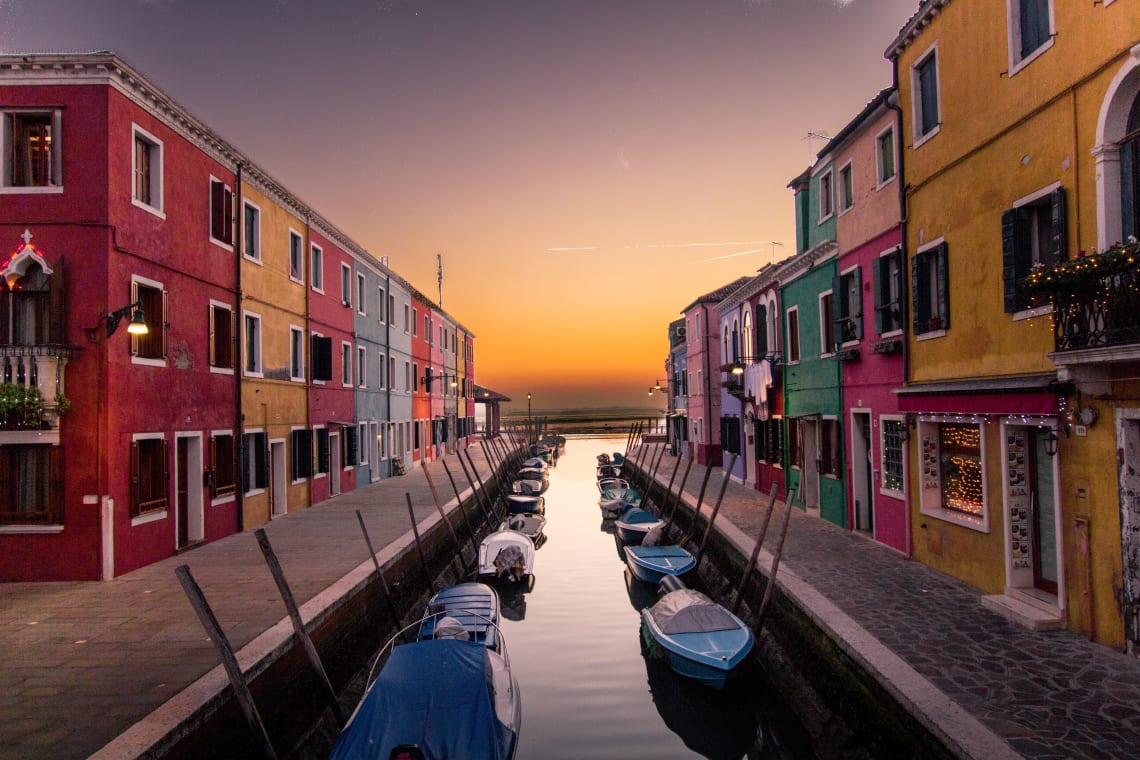
Average cost of a 2 weeks trip to Europe
Now let’s look at a two-week trip to Europe. Based on the information I just gave, you have an idea of what the daily expenses look like for a budget travele r in Europe. I’ll now summarize what the average cost of a 2 weeks trip to Europe might look like for each type of budget range (backpacker, mid-level, and splurge).
Backpackers traveling through Europe will be sleeping in hostels or doing work exchanges , cooking some meals at home, eating at cheap local restaurants or street markets, drinking local alcohol, and choosing free attractions.
Based on the prices I estimated in the above section, here is what 2 weeks in Europe may look like for a budget traveler:
- Accommodation: 20 Euros per night for 14 nights = 280 Euros
- Food: 30 Euros per day for 14 days = 420 Euros
- Transportation: 10 Euros per day for 14 days = 140 Euros
- Attractions: 20 Euros per day for 14 days = 280 Euros
So for 2 weeks in Europe, a budget traveler may spend around 1,120 Euros . This could be lower if you budget to the extreme. Keep in mind, a work exchange cuts your accommodation costs down to 0, and your food, transport, and activity costs may be lower as well depending on what your host offers.
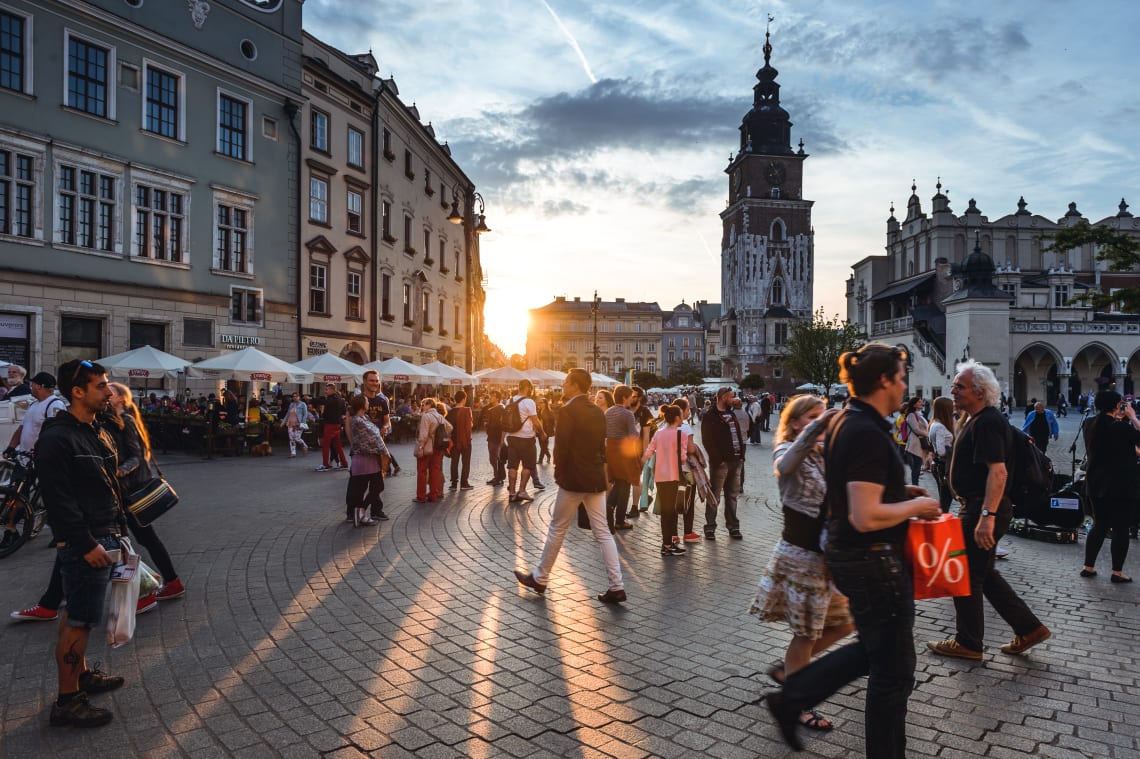
Mid-level budget
Two weeks in Europe on a mid-level budget will give you a combination of budget travel tips as well as plenty of opportunities to treat yourself. You may stay at a few hostels and a few nicer hotels, or maybe you’ll spend all of your time in affordable budget hotels.
You may also eat out somewhere nice once per day, and mix in some nights out with some affordable meals. Transportation will still be relatively low , unless you opt for taking taxis instead of buses or metros. And attractions will be about the same, with maybe a few expensive day trips or tours to take your trip to the next level.
Here is an estimate of what 2 weeks in Europe might look like for a traveler with a mid-range budget:
- Accommodation: 40 Euros per night for 14 nights = 560 Euros
- Food: 40 Euros per day for 14 days = 560 Euros
- Attractions: 50 Euros per day for 14 days = 700 Euros
So your total might be around 1,960 Euros for two weeks.
Splurge in Europe
If you have a budget with no limits, you can really live like a king or queen in Europe . There are so many fancy hotels, restaurants, and services that you can indulge in. The real luxury options will have outrageous price tags that suit the rich and famous, but even if you’re an average person who wants to splurge, you can keep the budget reasonable without missing out on anything.
Splurging in Europe, within reason, means staying at nice hotels, taking taxis, dining out, getting cocktails, and booking every attraction you want to regardless of the fees. Here is an overview of what two weeks in Europe on a high budget may look like:
- Accommodation: 200 Euros per night for 14 nights = 2,800 Euros
- Food: 80 Euros per day for 14 days = 1,120 Euros
- Transportation: 30 Euros per day for 14 days = 420 Euros
- Attractions : 70 Euros per day for 14 days = 980 Euros
That adds up to 5,320 for two weeks of luxury in Europe. This could easily be more, but it’s just a starting point.

Average cost of a trip to Europe wrap-up
The main factor you should take away from this article is that you are in charge of your own trip. These estimates are designed to help you formulate your own budget that suits your destinations and your travel style.
Also be sure to budget for flight costs , travel insurance , and any other purchases you think you might make abroad. And if you’re looking for the best way to cut costs while traveling in Europe, work exchanges are the way to go.
Check out our full list of work exchanges in Europe if you want to save money during your trip!
Join the community!
Create a free Worldpackers account to discover volunteer experiences perfect for you and get access to exclusive travel discounts!
Gabrielle Boucher
Budget Travel With Gabby
Hello! I am a 25 year old from the USA with a knack for traveling on a budget. I fell in love with traveling while studying in Europe, and that love grew even more when I started volunteering abroad in South America. Since then, I've worked odd jobs and volunteered all over the globe while cultivating passions for hiking, wildlife photography, food, wine, animals, permaculture, and more!
Be part of the Worldpackers Community
Already have an account, are you a host, leave your comment here.
Write here your questions and greetings to the author
May 10, 2023
my name is Arslanbek I need a job I can assemble furniture can you help me
May 14, 2023
How to pour from me
Jul 10, 2023
How to come...........?
I'm interested how can I contact you?
More about this topic

Germany on a budget: a guide with the best tips and the cheapest places to visit
Best way to travel europe: all you need to know to plan your trip.
Backpacking through europe: all you need to know
How do worldpackers trips work.
As a member, you can contact as many hosts and travel safely as many times as you want.
Choose your plan to travel with Worldpackers as many times as you like.
Complete your profile, watch the video lessons in the Academy, and earn certificates to stand out to hosts.
Apply to as many positions as you like, and get in contact with our verified hosts.
If a host thinks you’re a good fit for their position, they’ll pre-approve you.
Get your documents and tickets ready for your volunteer trip.
Confirm your trip to enjoy all of the safety of Worldpackers.
Have a transformative experience and make a positive impact on the world.
If anything doesn’t go as planned with a host, count on the WP Safeguard and our highly responsive support team!
After volunteering, you and your host exchange reviews.
With positive reviews, you’ll stand out to hosts and get even more benefits.
- How Much Does A Trip...
How Much Does a Trip to Europe Cost?

Content Editor
Every non-European has at least one big border-crossing adventure in them, but the question is, what kind of budget do you need for a trip to Europe ?
Countless backpackers, inter-railers and twenty-something hostel-hoppers traverse the ever-changing landscapes of Europe every single year. There are plenty of luxurious hotels, glamorous cities and premium experiences on offer, but thankfully Europe is also more than used to catering for the traveler with one eye on their bank account. Budget accommodation, long-distance travel passes and costless Euro city-strolling culture makes traveling in Europe on a budget more than doable.
This is all you need to know about the cost of a trip to Europe .
How much do flights to Europe cost?
With so many different destinations, prices can vary drastically for flights from the US to Europe. It can be as low as $400-500 but also well over $1,000. The strength of flight connections to your chosen destination can impact cost, as can peak season and travel demand. We always recommend the usual money-saving tricks, like checking multiple flight comparison tools, looking for airline discounts and always planning ahead and booking early. Being flexible with dates and flight times can also save you significant sums of money.
Luckily, peak season prices are pretty easy to track, since nearly all of Europe shares the same peak season – summer. July and August in particular, when most European schools break for several weeks, can be extremely expensive. So travelling off-peak, or even during shoulder season, is a great money-saving alternative.
Winter in Europe can be so charming, especially in countries like Germany , where fairytale towns are lit up by festive decorations and traditional Christmas markets. Springtime is glorious across all of Europe, as the weather becomes pleasant and rural areas blossom in color. In fact, city breaks in Spain , Greece or Italy can be much more pleasant in spring, when the heat is gently warming rather than scorching. Even fall is a great option for European travel, with luscious forests in country’s like Scotland and Georgia developing a gorgeous auburn tint.
Regional prices are not fixed and can vary significantly, but generally you can expect to pay more when flying to Scandinavian countries, as well as tourist favourites like Paris, Rome, Amsterdam and London. Central and Southern Europe tends to be cheaper, with flights to the likes of Barcelona, Budapest, Athens and Warsaw often more affordable.

Become a Culture Tripper!
Sign up to our newsletter to save up to $1,656 on our unique trips..
See privacy policy .
How much does it cost to travel around Europe?
As we said, a European travel budget can be very flexible. If you’re a carefree, cash-splashing globetrotter then you can have quite the glamorous time sunning it up in the French Riviera or skiing in the Alps, but you don’t need to be loaded to see this continent at its best.
The more expensive countries and cities – think northwestern Europe and major cities like Paris and London – have a pretty similar general cost to major US cities. Whether it’s food, transport or accommodation, you will need to set a budget aside. There are lots of extremely cheap destinations, however, especially the further east you go. Central and Eastern European nations have a far cheaper daily cost, while even large stretches of the glorious south will set you back far less for the basics.
There’s a great hostel culture throughout Europe, and most of mainland Europe is super connected by good quality train networks, which can be very affordable if you shop around or buy a travel pass. Food, meanwhile, plays such a big part in most cultures here that getting delicious authentic treats rarely breaks the bank.
The best thing about budget traveling in Europe is obvious – so much of the continent can be explored without spending a penny! Whether it’s giant mountain national parks or gorgeous beaches , the splendid countryside throughout Europe is yours to discover. Meanwhile Euro city culture is totally different to the US. You can quite easily spend a day in a European city doing nothing but meandering down cobblestone streets, taking in wide-open piazzas and visiting free-entry galleries and museums, stopping only for a tasty coffee and the local’s favourite pastry.
Of course a lot of museums are ticketed, as are major sightseeing spots like the Colosseum or Eiffel Tower, but generally it is very easy to discover the true joys of laid-back European life without paying a booking fee ahead of time.
Berlin to Budapest: Central Europe by Train
If there’s one trip in our collection that perfectly captures the spirit of traveling through Europe, it’s our 10-day border-crossing Rail Trip through Central Europe.
Our itinerary, carefully curated by experienced Travel Experts, is an ode to the romance of traversing the continent by train. Picture alpine lakes and forested mountains whizzing by your window, interrupted only by the occasional fairytale town. Imagine exploring some of the continent’s oldest and most culturally rich capitals by foot. All we’ve done is swap the dingy hostels for comfortable boutique hotels and brought in a knowledgable Local Insider to guide you around, bringing priceless insight and bang up-to-date recommendations to the table.
We’ll start off in Berlin – the perfect place to gain an understanding of Europe’s long and turbulent history. You’ll get to learn about it all in the German capital, but you’ll also get to experience the city’s vibrant, multicultural present day. Truly a city like no other to kick off our trip.
Next is Prague, the Czech capital, famous for being one of the most picturesque gothic medieval cities on Earth. You’ll be guided around the old town, castle and Charles Bridge before winding down with a beer tasting at a local brewery.
Next it’s onto the home of classical music, Vienna, for schnitzel, sachertorte and a little detour down the Danube, as we go cycling and wine tasting in the stunning Wachau Valley.
Our penultimate city is the hidden gem of our trip. Bratislava, the Slovakian capital, boasts one of the most beautiful old towns in all of Europe. You’ll get a full day and night here before hopping onboard a train to our final destination, Budapest. The Hungarian capital is teeming with history and European cafe culture. You’ll get to have a well-deserved soak in thermal baths, before getting together with the group at a trendy ruin bar to reflect on the ultimate European adventure .
So, with Culture Trip, a 10-day Europe trip’s cost is $2,375. Factor in good flights to Berlin and from Budapest, and you’re looking at easily less than $3,000.
Check out the full itinerary and book your spot today.

Other European trip suggestions
We have a beautiful selection of trips all over Europe. There’s another Rail Trip in Scotland , featuring a ride on the real-life Hogwarts Express, as well as an island-hopping exploration of Croatia’s shimmering Dalmatian Coast. Speaking of island-hopping, our Greek Island Odyssey is as dreamy as European travel gets – you can also read our guide to budgeting a trip to Greece .
You can get a little more adventurous with our Iceland adventure, or really go off the beaten path with a trip to Georgia (not that one, this gorgeous country is far east on the borders of Asia). Then, of course, we have a stunning selection of itineraries in Italy , from the classics of the north to the beaches of the south and the foodie delights of Sicily .
Finally, why just stick to Europe? We have two incredible itineraries that cross continental borders. Firstly there’s our Madrid to Marrakech Rail Trip , chartering the cultural, historical and culinary evolution from Iberia to North Africa. Alternatively, you can start with us on the European side of Istanbul , before heading across into Asia by visiting Cappadocia and Antalya on our Majestic Turkey trip .

Culture Trips launched in 2011 with a simple yet passionate mission: to inspire people to go beyond their boundaries and experience what makes a place, its people and its culture special and meaningful. We are proud that, for more than a decade, millions like you have trusted our award-winning recommendations by people who deeply understand what makes places and communities so special.
Our immersive trips , led by Local Insiders, are once-in-a-lifetime experiences and an invitation to travel the world with like-minded explorers. Our Travel Experts are on hand to help you make perfect memories. All our Trips are suitable for both solo travelers, couples and friends who want to explore the world together.
All our travel guides are curated by the Culture Trip team working in tandem with local experts. From unique experiences to essential tips on how to make the most of your future travels, we’ve got you covered.

Guides & Tips
The best private trips to book for your religious studies class.

The Best Private Trips to Book in Southern Europe

The Best Places to Travel in May 2024

Places to Stay
The best private trips to book for your classical studies class.

Five Places That Look Even More Beautiful Covered in Snow

The Best Trips for Sampling Amazing Mediterranean Food

The Best Rail Trips to Take in Europe

The Best Places to Travel in August 2024

The Best Private Trips to Book in Europe

The Best European Trips for Foodies

The Best Private Trips to Book With Your Support Group

The Best Places in Europe to Visit in 2024
Culture trip spring sale, save up to $1,656 on our unique small-group trips limited spots..

- Post ID: 1002242175
- Sponsored? No
- View Payload

Find cheap flights to Europe from $127
This is the cheapest one-way flight price found by a kayak user in the last 72 hours by searching for a flight from the united states to europe departing on 7/19. fares are subject to change and may not be available on all flights or dates of travel. click the price to replicate the search for this deal., search hundreds of travel sites at once for deals on flights to europe.
Save 21% or more Compare multiple travel sites with one search.
Track prices Not ready to book? Create a price alert for when prices drop.
Free to use There are no hidden charges or fees.
Filter your deals Choose cabin class, free Wi-Fi and more.
Best Europe Flight Deals
Cheapest round-trip prices found by our users on KAYAK in the last 72 hours
Good to know
Faqs - booking europe flights, what are some of the passport and visa requirements for united states citizens traveling to france.
Citizens of the United States need to have a valid passport and make sure that the passport remains valid for at least 90 days beyond their date of departure from France. When traveling on vacation, there is no need to get a visa so long as you plan on staying for less than 90 days in France.
If I plan on vacationing in Greece, what are some all the quickest ways I can get there from the United States?
Most Travelers in the United States flying to Greece will go to the Athens International Airport Eleftherios Venizelos (ATH). When you are departing from the west coast of the United States and an airport like the San Francisco International Airport (SFO), your quickest option will be a board one-stop flights offered by Lufthansa they have layovers at Munich Franz Josef Strauss Airport (MUC).
If I plan on traveling to Germany for Oktoberfest, what are the best airport choices?
By far, the best airport choice is to travel to Munich Airport (MUC), which is the city where this event is held. When traveling from the United States, you can find nonstop flights aboard Lufthansa from both Los Angeles International Airport and John F. Kennedy International Airport, and there are one-stop flights on the same airline from Dallas Fort Worth International Airport (DFW).

If I am traveling to the International Music Summit in Ibiza, what are some of the best ways to get there from the United States?
One of the most convenient airport choices to get to this event is to travel to the Ibiza Airport (IBZ). When traveling from John F. Kennedy International Airport, you will find one-stop flights aboard Air Europa and Iberia to this airport. If you are traveling from the West Coast of the United States from an airport such as Los Angeles International Airport, you can travel on one-stop flights aboard British Airways and Vueling.
If I would like to make my way to an eastern European country such as Poland, what are some good flight options from the United States?
Most Travelers in the United States making their way to this country will fly to the Warsaw Chopin Airport (WAW). If you’re departing from a large city on the East Coast United States such as the Boston Logan International Airport (BOS), the quickest trips occur on one-stop flights aboard Scandinavian Airlines that have layovers at Kastrup Copenhagen Airport (CPH).
Which airline is the best choice for nonstop flights to Sweden from the United States?
By far, your best choice is going to be SAS Airlines since they are based in Stockholm and have a reputation for offering great flight options to Sweden from the United States. One example of this would be the nonstop flights they offer between Chicago O' Hare International Airport (ORD) and Stockholm Arlanda Airport (ARN).
How long is the flight to Europe?
An average nonstop flight from the United States to Europe takes 8h 36m, covering a distance of 4043 miles. The most popular route is Newark - London with an average flight time of 6h 40m.
What is the cheapest flight to Europe?
The cheapest ticket to Europe from the United States found in the last 72 hours was $112 one-way, and $216 round-trip. The most popular route is Newark to London Heathrow and the cheapest round-trip airline ticket found on this route in the last 72 hours was $276.
Which airlines fly to Europe?
American Airlines, British Airways & Finnair fly the most frequently from the United States to Europe. The most popular route is from New York to London, and Austrian Airlines, Air Canada and United Airlines fly this route the most.
What are the most popular destinations in Europe?
Based on KAYAK flight searches, the most popular destination is London (44% of total searches to Europe). The next most popular destinations are Paris (20%) and Rome (10%). Searches for flights to Athens (8%), to Madrid (5%) and to Dublin (3%) are also popular.
How does KAYAK’s flight Price Forecast tool help me choose the right time to buy?
KAYAK’s flight Price Forecast tool uses historical data to determine whether the price for a given destination and date is likely to change within 7 days, so travelers know whether to wait or book now.
Top tips for finding cheap flights to Europe
- Enter your preferred departure airport and travel dates into the search form above to unlock the latest Europe flight deals.
- A popular city in Europe that people from Los Angeles often travel to is Paris. Most travelers will utilize Los Angeles International Airport (LAX) as their departure airport, and to Paris Orly Airport there are non-stop flights aboard French Bee and Air Caraibes, and to Charles de Gaulle International Airport (CDG) there are direct flights aboard Air France and Delta Airlines.
- A city that is quite popular with travelers departing from John F. Kennedy International Airport (JFK) is London. Some of the non-stop flight options available from the airport to London include flights aboard Finnair, Iberia, Virgin Atlantic, and American Airlines to Heathrow Airport (LHR), as well as non-stop flights aboard Norse Atlantic Airways, British Airways, and JetBlue to Gatwick Airport (LGW).
- Passengers in the United States traveling to any city in England and planning on renting a car should know that children must use a car seat until they are at least 12 years old. Parents can utilize the most appropriate type of child restraint based on the age and size of their child.
- When travelers in the center of the United States want to travel to the popular city of Berlin, they most often will depart on international flights from Chicago O' Hare International Airport (ORD). From this airport, passengers can find one-stop flights to Berlin Brandenburg Airport Willy Brandt (BER) aboard LOT Airlines, Icelandair, and Lufthansa.
- When parents plan on taking their children to France and will be driving a rental car, it is important to know that children up to 15 months of age must travel in a rear-facing car seat, and then up to four years old must travel in a forward-facing car seat. After that, any child up to 12 years of age needs to travel in either a booster seat or on a booster cushion.
- One of the most popular destinations in Europe for travelers from the United States is Madrid. When traveling from the large city of Boston and the Boston Logan International Airport (BOS), travelers can find nonstop flight options aboard Iberia, Finnair, and American Airlines to Adolfo Suárez Madrid–Barajas Airport (MAD).
- Another destination that is quite popular for visitors traveling to Europe is Vienna. When flying from Atlanta Hartsfield-Jackson International Airport (ATL), passengers can find a number of one-stop flights aboard both United Airlines and Lufthansa that travel to Vienna International Airport (VIE).
Top 5 airlines flying to Europe
Really bad baggage handling. Had my Rimowa bag badly damaged at the latches.
It was pretty good I was worried with the short Layover that I might not catch my connection but the gate was there
It was good until there was a 3 hour delay because there was not any pilots to fly the plane.
There was plenty of overhead room but half of the passengers were told they had to check their carryon bags. My partner and I checked in as early as possible and our seats were split across the aisle.
Friendly flight attendants. Comfort plus seats were very comfortable and had lots of leg room. 10A and 10 B.
I've flown many many times on Northwest and then Delta. The crew on this flight were absolutely the best I've had the pleasure of being looked after by.
Flew first class so everything was great. But maybe because the flights were red eye, no meals were served, just chips. I flew Alaska Air 1st class at 9PM (2 hour flight) and they served beef short rib sliders!
Had to change aircraft due to a faulty door. Surprisingly it only caused about an hour and a half of delay. Delta handled this situation as well as can be expected.
Awful. Flight was continuously getting delayed and gates kept changing without any reason. Flight was delayed for more then 3 hours
Paid premium for Delta only to be on safe but tired old 767 with ancient cabin in mediocre condition. Poor wifi and horrible inflight entertainment. Hardly a premium experience. Should have flown SW and had fun flight crew and no pretense
After the morning frenzy of 35 min wait through CLT security at 4;30 AM, it was nice to have a smooth pleasant boarding experience. This 6:30 AM flight was not full. We were able to get seated swiftly and took off promptly. Nice touch they distributed the old fashioned headsets with 8 mm jacks. Snacks were decent and arrival was uneventful.
My window shade didn’t work. So I missed coming into my city. ☹️
Flight was delayed in the gate by 5 hours and ultimately cancelled- rebooking service by United agents was terrible
Everything was pretty good except for food. They need to improve on it compared to other airlines.
Flight was delayed due to the late arrival of the catering truck, which is quite unacceptable. There was a beverage service, but no pretzel, or cookie, or nuts were served in coach.
Not worth the premium paid for the first class ticket
Not worth the price of premium class ticket paid, felt more like steerage.
Flighty delayed on boarding - then group 1 had to check their carry on bags but groups 3 and beyond could carry bags on - very inconvenient for weekend business trip with no checked baggage. Then delayed on the runway - before take off. No communication from pilot on why or how long. Wifi/Entertainment didn't work for 4+ flight. Upon arrival, attendants announced wrong carousel for baggage claim - everyone was waiting at the wrong place for their checked bags. This was a mess united!
I flew Delta last week and United Airlines is a poor substitute mechanical problems with the plane and shitty food among other things made my travel experience what’s become to be expected from United no way is it ever worth the money they make us pay
I had a great flight. Everything went smoothly and the flight arrived early.
This flight was canceled and delayed several times without explanation. The plane was freezing cold and no wifi for messaging. Getting off the plane was terribly unorganized and felt like it took forever….
The flight was delayed several times without explanation. The seats were terribly uncomfortable and wifi isn’t included. All these make for a less than ideal flight.
The flights was delayed by hours and it was the firmest landing I have experienced in my life. My back is still sore.
Internet service was erratic. Crew service was poor and slow. My luggage on this non-stop flight was lost and not recovered
Terrible. I didn’t fly and I had an important meeting the next day.
Missed this flight due to the first AA flight delay
Equipment swap led to 2+ hour delay on international flight. And to top it off, boarding took forever.
Wretched scheduling - they got themselves into a critical crew situation and didn’t try to address it until 15 minutes before they had to cancel my flight
They cancelled two flight and got us onto another airline, which was also delayed.
Nothing, terrible travel experience due to weather and maintenance delays and was left stranded in Austin.
Captain waited 45 minutes for late passengers boarding from Washington DC to Munich which was nice for them but caused our luggage to miss boarding our connection on to Bucharest. We then did not receive our luggage for about 48 hours after landing which was very inconvenient for our travel.
Poor, we had 1 hour to grab our checked luggage, go through customs, recheck bags and run across terminals to make our United flight. Poorly planned connections.
Check in in Albuquerque was awful. The people were great but they were over loaded. The procedures were terrible. We got through fine but it took 90+ minutes.
Will try to not fly with them again. Delays because of weather but got redirected to an airport where I could not make connection.
Staff didn’t care in business class. Closed the door on my mom while she was on the jetbridge and flight attendant told me she would make it from the connecting flight. They lied. My luggage was damaged on arrival. No success in filing damage claim.
Boston Logan is a crummy airport - signage is terrible or lacking in areas. Boarding seemed to be a free for all and with all the different airlines speaking, you couldn't tell who was supposed to be where and when. Plain and simple, airlines should board from the back of the plane to the front. Also someone was sitting in my seat. By the time that was figured out, I had to place my overhead behind me which made de-planing more difficult. Logan is not Lufthansa's fault so that is not on them, Boarding is on them! Still, overall it was a Good Experience flying with Lufthansa. This is not my first flight with them...
Overall, the flight was comfortable without any serious issues. Transit through Frankfurt airport was a little confusing, but not too difficult if you follow the signs
There was a screaming child behind our seats. This prevented us from getting any sleep during the night.
There was a screaming child just behind our seats. This prevented us from getting any sleep during the night!!
Staff disappeared after dinner service until breakfast, no help with beds, no help running to our gate to catch connection cause flight was late, our luggage didn’t make it, took over 24 hours to get luggage to hotel, no compensation!!
Economy class has no legroom so if you have the money worth to upgrade! Food was absolutely horrible! The crew was super nice!!!!!
The flight was provided by Aer Lingus and our seats were in a poor condition (15A & 15C). They looked like they needed repairing/replacing and were uncomfortable for such a long flight. Also the arm rests on Aer Lingus planes do not lift more than around 45 degrees, instead of the usual 90 degrees upright, meaning you cannot maximum the space between you & your travel companion so as to be more comfortable for such a long flight.
Flights were actually with Aer Lingus outward and American Airlines & Aer Lingus on the return journey. Outward flight with Aer Lingus was good but the return flight with them was not so good as our seats were in a poor condition (15A & 15C) and looked like they needed replacing! The American Airlines flight from Miami to JFK New York was good and the seats were very comfortable and spacious (32D & 32E)
Awful. Delay, lost vacation time and travel time now more than 24h
Awful. Flight delayed and we missed our long flight to Rome. It has been a nightmare and we have still not arrived. It was NOT a weather delay, just poor planning by AA
Boarding was as fast and efficient as possible. The flight crew were amazing and extremely friendly. We enjoyed our flight.
Very bed boarding, there was overbooked and make a lot of problems and noises
There was a problem in the luggage because there were not porters
On my way from Chicago to London, I was seated next to a quite heavy passenger. I could barely move. BA should have ensured that overweight customers are placed in comfortable seats and not to penalize also other passengers because BA is not willing to accommodate these passengers and their needs. No respect at all.
The flight as far as timings go was excellent. Unfortunately we ended up sat with someone on a night flight who had been drinking alcohol before boarding and BA staff were happily serving him more alcohol. He was very drunk which made our flight uncomfortable and awkward. My partner had this person lying on him whilst asleep. Alcohol should be served minimally. If there had been an emergency this person would not have been in a fit state to act accordingly.
Book Cheap Europe Plane Tickets
Recent round-trip flight deals, search by stops, search by airline, search by price, recent one-way flight deals, last minute flights to europe, last minute flight, train and bus deals, flights to europe, return flight deals:.
Europe - United States
Cabin classes:
Browse origins:.
- Flights »
- United States
Browse destinations:
- Worldwide »

Europe Travel Guide
Last Updated: April 18, 2024

From beautiful Paris to smoke-filled coffeeshops in Amsterdam, Oktoberfest to La Tomatina, Europe is a massive, diverse continent with an unlimited assortment of things to see and do. You won’t have any problem filling your time, whether you’re backpacking Europe for a few months on a budget or just spending a few weeks there on a well-earned vacation.
The continent boasts wonderful beaches, historical architecture, amazing wine, and tons of world-class festivals. Every country is incredibly different from the next too, providing limitless variety in what you do during your trip.
I first backpacked Europe in 2006 and was hooked immediately. I’ve been visiting every year since, have run tours around the continent, and even wrote a book on traveling in Europe . It’s a destination I love and never get tired of exploring.
This guide will give you an overview of Europe and the tips and tricks you need to start planning your trip. I’ve also written extensive travel guides to each country on the continent (linked below in this post) so you can get more in-depth information for your specific itinerary too!
Table of Contents
- Things to See and Do
- Typical Costs
- Suggested Budget
- Money-Saving Tips
- Where to Stay
- How to Get Around
- How to Stay Safe
- Best Places to Book Your Trip
- Related Blogs on Europe
Click Here for Country Guides
Top 5 things to see and do in europe.

1. Tour the Greek Islands
These islands are the mecca of summer beach fun and each is unique in its own great way. There’s Ios (beach party central with archeological ruins and awesome boat tours); Kos (ancient ruins and nature); Crete (Bronze Age ruins of Knossos, hiking, beaches, and wine), Santorini (iconic blue water, white buildings, and local wineries); Mykonos , (the upscale party island with beautiful beaches, villages, and sunsets), Naxos (best island in the Cyclades). Plus, Milos, Corfu, Lemnos, Zakynthos, and so many more! With hundreds of islands in the country, you can always find what you are looking for!
2. Ride the rails
Europe is famous for its international rail system. Rail passes like the Eurail Pass have been around forever and still make it very easy to get from country to country on a relatively small budget (and with lots of flexibility). Europe has some of the fastest trains in the world that travel up to an incredible 217 mph (350 kph). The whole continent is connected by trains and there’s a growing push for even more connections and long-distance, high-speed trains in order to reduce flying and help combat climate change. There’s nothing more quintessential than riding the trains in Europe and I encourage you to take as many trains as possible. It’s one of the best ways to see the continent.
3. Get lost in Paris
The “City of Lights” is everything people say it is. I fell in love with it the first time I stepped foot in Paris . The city is just magical. You have a ton of museums, cafes, jazz clubs, famous art, and beautiful architecture. I love just strolling around the streets of the Quartier Latin (Latin Quarter) or Montmartre neighborhood as it makes for a breathtaking day. Another one of my favorite things to do here is just sit in the Jardin des Champs-Élysées park and picnic like the Parisians. For something a bit different, check out the famous Catacombs and Paris Sewer Museum. With so much to offer in the way of culture, history, and gastronomy, it would take years to see everything here but you can still get a good feel of the city in a few days.
4. Go city hopping
There are so many amazing cities in Europe that we’d need a top 100 to list them all. Here are some of my personal favorites and must-see cities: London is rich in history, culture, and the famous Big Ben clock; Edinburgh is a vibrant medieval city with cozy pubs and a famous castle with a huge New Year’s Eve Party; Amsterdam has cozy coffee shops and canopied tree-covered canals; Berlin has a wild party scene, street art, and the Berlin Wall; Barcelona has tapas, beach, and unique Gaudi architecture; coastal Lisbon has colorful tiles, old tramcars, cobblestone streets and plenty of fresh seafood; Prague has a beautiful intact Old Town, incredible architecture and eclectic bars; Tallinn Estonia has beautiful medieval buildings with colorful roofs. Florence is a mecca for Italian Renaissance architecture, art history, and gelato; Stockholm mixes medieval architecture and modern art and design. Crisscross the continent, take in the culture, and enjoy all the historic cities!
5. Hit the Alps
Whether you go skiing in the winter or hiking in the summer, the Alps hold some of the most breathtaking views in all the world. You don’t even need to be an expert hiker because there are mountain trails for all levels and crystal-clear Alpine lakes. Check out the spectacular Eibsee trail loop in Bavaria at the foot of Die Zugspitze, Germany’s tallest mountain, for the clearest, multi-colored, sparkling lake you’ve ever seen. Or the Männlichen Kleine Scheidegg Panorama trail in Switzerland’s stunning green and snow-capped Alps. Or visit Italy’s Dolomites in South Tyrol for the scenic Seceda trail. The Alps have trails for every fitness level and in every season.
Other Things to See and Do in Europe
1. tour amsterdam.
I love Amsterdam so much that I lived here for a short period of time in 2006. Here cobblestone and brick streets weave around lovely canals as people ride their bikes to and fro. My favorite things to enjoy here are Amsterdam’s vibrant art and music scene and there are also a ton of interesting museums here like the Anne Frank House, FOAM, the history museum, and the hemp museum. Be sure you get out of the center into Jordaan and Oost with their wonderful outdoor cafes and fewer tourists. Also, a visit to Amsterdam wouldn’t be complete without a canal cruise to visit the many islands and there are many to choose from that include snacks and drinks, sunset cruises, live guided tours, and more.
2. Hang out in Barcelona
Barcelona is a city that goes 24 hours a day, 7 days a week. It truly could give NYC a run for the “city that never sleeps” title. Be prepared for late-night dinners and parties until dawn. Besides a great food and nightlife scene, there is a wonderful beach, tons of Gaudi architecture (including the fairytale-like Parc Güell, as well as the iconic Sagrada Familia , which has been under construction for over 100 years!), incredible food tours, one of the best history museums in the country, and lots of outdoor spaces. What I love about Barcelona is that when you’re ready to chill, you can wander around Parc de la Ciutadella and marvel at the majestic fountains, plant life, and buildings created from an ornate military fortress.
3. Visit Berlin
Hip and trendy Berlin is an energetic destination. It is one of Europe’s most affordable capital cities, with a vibrant music and art scene and a growing foodie movement. Be sure to spend some time learning about the city’s darker history via the many excellent museums, memorials, and landmarks. The East Side Gallery, a section of the Berlin Wall that’s now painted with murals, and the Memorial to the Murdered Jews of Europe are two especially powerful reminders of Germany’s past. For all periods of German history, don’t miss the Deutsches Historisches Museum (German Historical Museum) – it’s one of the best history museums in the world. Once you’ve had your fill of history, relax in Berlin’s many green spaces, from Tempelhof Field, the site of a former airfield and popular local hangout spot, to Tiergarten, a tree-covered former hunting ground for 17th-century aristocrats.
4. Drink beer at Oktoberfest
Oktoberfest is a must for anyone going to Germany at the end of September. While not a budget option since beers now cost 15 € a maß, I love the energy and friendly camaraderie this event inspires. For two weeks, millions of people from all over the world gather for lots of beer, excitement, music, and wild fun. Watching thousands of people sing together, raising quart-sized beer mugs for endless toasts, and enjoying the general party atmosphere makes you feel good about the world. (Or maybe that’s just the beer?) Just be sure to book your accommodation well in advance and be prepared to pay top prices for them. If you don’t have an outfit, don’t worry, there are plenty of shops even at the main train station where you can buy a Bavarian dirndl dress and men’s lederhosen.
5. Experience London
Get a taste of English culture in diverse London . The museums here are some of the best in the world (most are free) and include the Tate, the British Museum, the City Museum, the National Gallery, the Historical Museum. There’s no shortage of iconic sights here as well, with Big Ben, the House of Parliament, the London Eye, the Tower of London, Tower Bridge, and of course, Buckingham Palace. I love London’s diversity because of the countless international eateries with great food and wonderful pub culture, perfect for after a long day seeing the sights. Head to Brick Lane on the weekends for some amazing food and craft markets. I prefer Paris to London, but there is something sophisticated and fun about London. Just watch those pints — London is not a cheap destination!
6. Get outdoors in Scandinavia
My favorite region in Europe is Scandinavia. The quality of life here is high, the people are beautiful and friendly, and the cities are clean and historic. Cycling the cities, taking canal tours, hiking the vast forested areas, archipelago hopping, enjoying fika (a Swedish coffee break), and warming up in saunas are just a few of the popular activities that await you here. True, this area of Europe is not cheap, but there are plenty of ways to reduce your expenses. Don’t let the high prices scare you away. Highlights for me include Copenhagen , Stockholm , Gotland, Norway’s fjords, and Lapland in Finland .
7. Get enchanted in Prague
Prague has an amazing history and is one of the most beautiful and picturesque cities I’ve ever seen. Highlights include the 9th-century Prague Castle, the magnificent Charles Bridge (built in the 14th century and one of the oldest standing bridges in the world), the 10th-century old square with its iconic astronomical clock, and the winding Jewish Quarter. Even if you only have a few days there don’t miss the free walking tour which is one of my favorites in Europe and the best way to learn about the Old Town and the tragic history of the city that went from thriving Bohemian capital of art, music, and literature to part of the Iron Curtain after WWII. Some of my favorite gems here include the fantastic black light theater shows in 4D and the one-of-a-kind medieval dinner show in an old tavern complete with musicians and jugglers not to mention hearty food and drinks. During the weekends it heaves with people enjoying the bars, cheap beer, and delicious food so try to visit during the week (and in the spring or fall) to beat the crowds.
8. Relax on the French Riviera
Here, you can pretend to live the high life for a little bit. Have fun in the sun, relax on the beach, swim in azure blue water, hobnob with the rich and famous, and sail on (or gaze at) gigantic yachts. As for cities, Nice is nice with its palm-tree-lined promenade, old town, and many art museums. If you want to go see how the rich and famous live, spend an afternoon checking out Cannes to soak up some glamorous vibes on La Croisette where they hold the famous Cannes Film Festival. The kingdom of Monaco with its tiny streets, beautiful buildings, and world-famous casino is just a skip away too.
9. Enjoy the great outdoors in Interlaken
Located in the beautiful mountains of Switzerland, Interlaken is a gorgeous place to unwind with fantastic hiking, delicious hot chocolate, and plenty of outdoor sports. The area is full of natural attractions to explore, including the St. Beatus Caves (complete with a legendary dragon), the cascading 500-meter-high (1,640 feet) Giessbach Waterfalls, the Jungfraujoch mountain railway (which leads to the highest train station on the continent), and a plethora of lakes (hence the town’s name). It’s a good alternative to all the cities and museums. Interlaken is also a popular party destination for backpackers and other young travelers. By far, my favorite scenic and visually stunning trail was the Oberberghorn panoramic hike, where you can wander the green mountain ridge ogling the amazing views and the turquoise-blue Brienzersee.
10. Experience history in Rome
In this thriving historical city, you can’t walk two feet without stumbling over a ruin, making Rome a history buff’s dream. Its tiny streets are perfect for wandering as you explore the Colosseum, see the Forum and Palatine Hill, visit the Pantheon, spend time in Vatican City, admire the Spanish Steps, and toss coins into the famous Trevi Fountain. The skip-the-line tickets can definitely be worth it so you don’t waste time waiting outside attractions. Rome also has amazing food (it’s Italy, after all) and nightlife. Visit the Trastevere area for a taste of “local” Rome and chill bars. It’s my favorite area in the city because you feel like you’re in a small village in the middle of a big city.
11. Hike around the Cinque Terre
Cinque Terre is my favorite part of Italy. These five beautiful cliffside towns are perched near warm waters and beautiful olive and grape groves. There are wondrous and strenuous hikes in these hills; for a real challenge, take trail #8. Or just walk the coastline for something less difficult. Many activities here revolve around the coastline: kayaking, swimming, having a beach picnic or visiting the Technical Naval Museum. If you happen to be here in December or January, don’t miss the Nativity Manarola, the world’s biggest lighted nativity scene.
12. Tour Krakow
Krakow looks like it stepped out of a medieval postcard. It’s a hip, trendy, and youthful city that’s the center of education in Poland, meaning there are a lot of university students here. Most travelers come to party here (the vodka is cheap) but try to enjoy the city’s history and food besides just the bars. Walk the Royal Road through the Old Town to the 13th-century Wawel Castle, tour Schindler’s Factory (where Schindler saved over 1,200 Jews during World War II), and visit the sobering Auschwitz-Birkenau concentration camp. You can also take a fascinating day trip to the UNESCO World Heritage Wieliczka Salt Mine, a 13th-century mine with cavernous chambers, statues, chapels, chandeliers, and cathedrals all carved out of salt.
13. Visit the ruin bars in Budapest
The coolest nightlife in all of Europe is found in Budapest . Built in abandoned buildings, ruin bars feature funky art installations, repurposed furniture, and quirky decor. They are amazing, fun, and great places to meet locals, as people of all ages flock here. Open since 2001, Szimpla Kert is the original ruin bar and one of my favorites, along with Instant-Fogas Complex, which takes up an entire building and is actually many different bars in one. Don’t skip the ruin bars — they’re one of the most unique things about the city!
14. Explore Cornwall
The best part of England is outside London, yet unfortunately, not a lot of travelers leave London. Head west to the area of Cornwall for cheaper prices, welcoming locals, natural beauty, great hiking, rolling hills, plenty of medieval castles, and picturesque small towns. If you like biking, the Camel Trail from Bodmin to Padstow is worth the trip and you even pass by a local vineyard. It’s an easy way to spend a day (and it’s pretty flat so it’s not too hard to do.) Plus, I had the best fish and chips in Cornwall! Overall, it’s what you think of as “traditional England.”
15. Walk the Camino
El Camino de Santiago (The Way of Saint James) is an ancient pilgrimage route that stretches from France all the way across northern Spain. It is a 500 mile (800 km) trail that winds through incredible terrain, ending in Santiago de Compostela at the cathedral where St. James is supposedly buried. As a pilgrim, you get a “pilgrim’s passport” which allows you to stay in affordable pilgrim-only hostels, making this a surprisingly budget-friendly adventure. While it usually takes over a month to complete, you can just walk a section if you don’t have the time. To receive a “Compostela” (certificate of completion), you just need to walk the last 62 miles (100 km), which generally takes 4-5 days.
16. Throw tomatoes during La Tomatina
By far my favorite festival, the largest food fight in the world happens during the last Wednesday of August in Bunol, Spain. What started in 1945 as a local brawl has turned into a massive event drawing tens of thousands of people from all over the world. For about an hour, everyone throws tomatoes at each other, leaving streets ankle-deep in tomato juice. Afterward, everyone walks down to the river, cleans off, and then heads to the town square for sangria and music.
17. Find Dracula in Romania
Not a lot of people visit Romania but this underrated country in Eastern Europe has undiscovered yet picturesque medieval towns like Brasov (home to “Dracula’s castle”), Sighisoara, and Sibiu; gorgeous beaches on the Black Sea; and incredible hiking in the Fagaras Mountains — all at dirt-cheap prices. Other major sights include frescoed Byzantine monasteries, the steepled wooden churches of Transylvania, the hip university town Cluj-Napoca, the post-communist capital of Bucharest, and the Danube Delta, a huge nature reserve.
18. Drink whisky in Islay
Whisky has a long history on Islay , an island off Scotland’s west coast. It’s been made there since the 16th-century — first in backyards and then, starting in the 19th-century, in large distilleries. Over the years, whisky from the island came to be considered a specialty and was used to flavor a lot of other blends on the mainland. There are currently nine working distilleries on the island, all located along the island’s shores, with Laphroaig, Ardbeg, and Lagavulin being the most famous. Most distilleries here make single-malt Scotch, meaning that only one type of grain (barley) is used. My visit here was amazing and, even if you don’t like whisky, there are tons of good hikes and walks throughout this magnificent island.
19. Explore Iceland
Iceland is a magical country with majestic waterfalls, hidden hot springs around every corner, and sweeping vistas unlike anywhere else in the world. After my first visit, the country quickly became one of my favorite countries. With whale watching in the summer, the northern lights in the winter, and geothermal baths for soaking in year-round, there really is no bad time to visit! While Iceland’s main draw is the epic natural landscapes, it’s worth spending a couple of days in Reykjavik with its café culture, artsy feel, and brightly colored wooden row houses.
20. Sail the Croatian coast
With calm winds, short distances, a coastline littered with over 1,000 islands, and countless historical sites, Croatia is one of the world’s best sailing destinations. If you can, go during the shoulder season when you can find some great deals. Plan to stay at least a couple of days on one of the islands, with the most popular being Brac, Hvar, Krk, Cres, and Lošinj. However, don’t be afraid to get off the beaten path and explore some of the lesser-known islands such as Silba, Vis, and Lastovo. If you want to splash out and spend a week partying on a yacht, check out The Yacht Week, which hosts week-long parties, complete with DJs, from May-September. You can book a full boat to share with friends or just a cabin if you’re traveling solo. Prices start at 5,250 HRK per person and go up to 9,300 HRK.
21. Explore the Balkans
While the Balkans have become more popular with backpackers in recent years, it’s still largely overlooked by most budget travelers, despite being an extremely budget-friendly region. The Balkan peninsula is home to great (and again, overlooked) wine, beautiful medieval towns like Kotor and Mostar, stunning mountainous landscapes, beautiful pebble beaches, coffee culture, fresh, hearty yet inexpensive food, and museums covering the area’s history, including the most recent turbulent events of the early 1990s. I especially loved my time in Albania . Don’t miss the beautiful beaches in Ksamil, nicknamed the “Maldives of Europe’ as well as the mountain village of Gjirokastër, which was occupied by Romans, Byzantines, and Ottomans. The Balkans have so much to offer for every budget and every country has its unique cultural flavor.
22. Take a wine tour in the Loire Valley
Located in central France, the picturesque Loire Valley is a UNESCO World Heritage site and stretches 280 kilometers (174 miles) along the Loire River. One of the major wine-producing regions of France, the area is home to some of the best wines in the world, with over 1,000 vineyards open to the public. Even those who don’t drink wine will enjoy the beautiful small towns, great food, and the region’s over 300 impressive chateaux. I loved the medieval Chenonceau Castle and Chateau Villandry and the small villages like Saint-Florent-le-Vieil. Spring and Autumn are my favorite times to visit because you can go biking and do outdoor activities when it’s not too hot and there are fewer people. It’s an area not to be missed.
23. See Fado in Portugal
Fado is an important musical tradition in Portugal , originating in Lisbon and stretching back some 200 years. The word “fado” likely stems from the Latin word for fate, and it’s very haunting, poetic, and emotional music. Most of the songs follow themes of loss and mourning, and the music was popular with the working class (especially sailors). Performances normally take place in restaurants during dinner. In Lisbon, head to Clube de Fado, Tasca do Chico, Parreirinha de Alfama, or Senhor Vinho.
24. Tour green Slovenia
Slovenia is one of Europe’s least-visited destinations, which is mind-blowing to me because it’s an amazing place to visit. Slovenia offers all the beauty of Western Europe but at a fraction of the cost and with a fraction of the crowds. Perfect for outdoor adventure lovers, Slovenia offers rugged mountains, untouched landscapes, fantastic ski resorts, plentiful wine, sprawling cave systems, incredible food, and postcard-perfect lakes, such as the famous Lake Bled with its castle on an island. I loved Piran, Slovenia’s often overlooked coastal Venetian-style harbor town that was actually founded 3000 years ago. Stroll around its beautiful windy cobble-stoned streets, beautiful plazas, and take advantage of the many affordable restaurants right on the water. Make sure to also spend a few days in the country’s capital, Ljubljana, known as one of the continent’s greenest and most livable cities. Take a river cruise to see the city and enjoy the friendliness of the locals.
For more information on specific countries in Europe, check out the guides below:
- Albania Travel Guide
- Austria Travel Guide
- Belgium Travel Guide
- Belarus Travel Guide
- Bosnia & Herzegovina Travel Guide
- Bulgaria Travel Guide
- Czechia Travel Guide
- Croatia Travel Guide
- Denmark Travel Guide
- England Travel Guide
- Estonia Travel Guide
- Finland Travel Guide
- France Travel Guide
- Germany Travel Guide
- Greece Travel Guide
- Hungary Travel Guide
- Iceland Travel Guide
- Ireland Travel Guide
- Italy Travel Guide
- Latvia Travel Guide
- Lithuania Travel Guide
- Malta Travel Guide
- Moldova Travel Guide
- Montenegro Travel Guide
- Netherlands Travel Guide
- Norway Travel Guide
- Portugal Travel Guide
- Poland Travel Guide
- Romania Travel Guide
- Scotland Travel Guide
- Slovakia Travel Guide
- Slovenia Travel Guide
- Spain Travel Guide
- Sweden Travel Guide
- Switzerland Travel Guide
- Ukraine Travel Guide
Europe Travel Costs

Accommodation – Accommodation prices vary greatly by region. In Western Europe, hostel dorm rooms cost between 25-45 EUR per night, depending on the room’s size and the popularity of the hostel. I stayed in a 6-bed dorm in Berlin for 20 EUR, while the same one would have cost me around 45 EUR in Paris. A room in Paris costs on the higher end and a room in cheaper Athens costs on the lower end.
In Eastern Europe, hostel dorm rooms cost between 10-15 EUR per night depending on the size of the dorm room and the popularity of the hostel. The further east you go, the cheaper it gets. Expect to pay around 30-60 EUR per night for a private room that sleeps two.
In Scandinavia, hostel dorm beds cost around 25-45 EUR, while private rooms are 65-80 EUR. Budget hotels start around 85 EUR.
Most accommodations offer free linens, free Wi-Fi, and a lot offer free breakfast, but it’s important to check specific websites for exact amenities.
Campsites cost between 10-15 EUR per night for a basic plot for two without electricity.
Food – Food traditions in Europe run deep, stretching back centuries to become integral parts of each country’s culture. From baguettes in France to tapas in Spain, from hearty Eastern European stews and goulash to the fresh vegetables and olive oils of the Mediterranean, European cuisine varies as much as the countries themselves. Food prices differ greatly across the continent, so check individual country guides for specifics.
But no matter where you are, even in the more expensive countries, finding places to eat within your budget is easier than you might think. Throughout Western Europe, you can find small shops, street food stalls, or food trucks where you can get sandwiches, gyros, kebabs, slices of pizza, or sausages for between 3-7 EUR. These shops are most often found in train stations, bus stations, and main pedestrian areas, and offer cheap food alternatives that can have you eating on 12-17 EUR per day. Fast food (think McDonald’s) costs around 7-10 EUR for a combo meal.
Turkish, Middle Eastern, and Vietnamese eateries abound in Germany, while Indian food is incredible and everywhere in the United Kingdom. Meals at these restaurants usually cost between 8-12 EUR.
Restaurant meals in casual, traditional eateries generally cost around 13-25 EUR for a main dish and drink. Food is much cheaper in the east than in the west, and in the west, northern regions like Scandinavia and the UK are more expensive than southern countries like Spain, Portugal, and Italy.
In Eastern Europe, even if you are eating out for all your meals, you can still get by on a food budget of as little as 15 EUR per day.
For drinks, a pint of beer is 2-5 EUR, a glass of wine is 2-7 EUR, a cappuccino is 2-5 EUR, and cocktails range from 6-14 EUR.
If you eat out, do so at lunch and get the prix-fixe menu (two-course or three-course set menu). Restaurants offer this set menu during lunch, and with prices between 10-20 EUR, it’s a way better deal than the regular dinner menu. You can also get affordable lunches at outdoor markets. So many European cities have huge fresh food markets throughout town.
You can cook your own food for around 45-65 EUR per week. This gets you basic staples like rice, pasta, seasonal produce, bread, and some meat. You can save money by shopping at discount supermarkets like Profi, Lidl, Aldi, and Penny Market.
If you want to save big money on meals, head to one of the markets, pick up some cheese, wine, bread, meats, or anything else, and go to the park for a picnic. (Or grab a sandwich for later!) You’ll find the locals doing the same thing, and it’s one of the cheaper ways to get a true taste of local food.
Backpacking Europe Suggested Budgets
Prices for travel in Europe vary greatly depending on how far north, east, south, or west you travel. If you stick to the budget accommodations, food, and tours listed here and use all my tips on saving money, you need about 65-110 EUR per day in Western Europe, 40-50 EUR in Eastern Europe, and about 85-130 EUR in Scandinavia.
Those numbers reflect a traveler who stays in hostels, cooks some meals and eats out cheaply, enjoys a few drinks, and sticks to free and cheap activities like hiking, walking tours, and enjoying nature. This is your typical backpacker budget. You aren’t going to have a fancy time, but you aren’t going to want for anything either.
However, by getting tourist cards and rail passes, avoiding flights, occasionally Couchsurfing or camping, cooking all your meals, and not drinking, you can travel a lot cheaper. On this budget, you could do Western Europe on 35-45 EUR per day, Eastern Europe on 20-25 EUR, and Scandinavia on 50-65 EUR. That would require you to take a train or a bus or hitchhike everywhere, skip most museums, and limit how often you go out.
Generally, the suggested daily budget for Europe is 80-120 EUR. You can use the chart below to get an idea of how much you need to budget daily. Keep in mind these are daily averages – some days you’ll spend more, some days you’ll spend less (you might spend less every day). We just want to give you a general idea of how to make your budget. Prices are in EUR.
Europe Travel Guide: Money-Saving Tips
Individual country guides have more specific information on how to save money in them but here are some general tips on cutting your costs while you explore Europe:
- Picnic – This continent has a lot of little shops where you can buy pre-made sandwiches or ingredients to make your own. Many supermarkets have delis as well where you can get food to go. Buy some food, eat outside, and watch the city and its people go by. It’s a much more enjoyable and cheaper way to eat.
- Eat local and cheap – Not into picnicking? Eat at local sandwich shops, pizza parlors, Maoz, Wok to Walks, and outdoor street vendors. Avoiding restaurants and eating at a lot of the local “grab n’ go” places gives you a taste of the local cuisine at a much cheaper price. If you’re really on a budget, use your creative cooking skills to prepare meals at the hostel as well.
- Stay with a local – Hostels can add up really quickly. If you don’t have any friends with whom you can stay, consider using Couchsurfing , which connects you with locals who let you stay with them for free. Plus, they tend to also have meetups to meet other locals and travelers. It’s a great way to save on accommodation and meet a local who can share their insider tips and advice.
- Camp in a garden – A very good camping service specific to Europe is Campspace , which allows you to pitch a tent in someone’s backyard for free or for a small fee (around 10-20 EUR). All of the garden owners have profiles that tell you what services and facilities they offer. Also, many countries allow wild camping (like Sweden), which can save you a fortune if you have a tent.
- Take the bus – Budget bus companies like Flixbus can take you across the continent for cheap. I personally feel it’s best for day travel as sitting up for an overnight bus isn’t really ideal for sleeping. It isn’t glamorous, but with tickets starting at 5 EUR, you really can’t complain!
- Get a Rail Pass – Eurail Passes have saved me hundreds of dollars. If you are traveling far distances and through many countries, they are a great deal.
- Take the free city tours – One of the great things about Europe is that you can find free walking tours in all the major cities. They can be a great way to see the city attractions, take in some history, and learn your bearings without spending any money. Just make sure to tip your guide at the end!
- Plan accordingly – Plan your trip around Europe so you avoid doubling back. Transportation is a big expense so proper planning can save you a lot of money (and time). Go in a straight line or a loop. Booking your accommodation ahead helps you save as well since cheap, good places unsurprisingly get reserved first. One thing I’ve learned is that waiting until the last minute means you get stuck with expensive places or cheap places no one wants.
- Fly cheap – If you know where you are going and a train won’t do, try to book flights early. You can often get round trip fares for as little as 5 EUR from many of the European discount airlines like Ryanair or Wizz. Many capital cities have smaller airports farther from the city with ‘inconvenient’ times but cheaper fares. Keep in mind you might need to factor in an early morning Uber or taxi if the busses aren’t running and you have an early flight!
- Drink less – Those 5 EUR beers add up. Hit happy hours or pick and choose when you party. Hostel bars are a good place to get cheap drinks or buy your alcohol at the supermarket. Plus, in Europe, it’s legal to drink outside in parks, plazas, by the lakes or rivers. You’ll find you can save a lot of money by not going to bars and clubs. Partying your way across the continent will destroy your bank balance in no time.
- Get a city tourist card – Many local tourism offices sell a tourism card for all their attractions, tours, and restaurants. This card gives you free entry and substantial discounts on all the attractions and tours in a city, free local public transportation (a huge plus), and discounts at a few restaurants and shopping malls. They save a ton of money. If you plan on doing a lot of sightseeing, get one of these cards.
- Rideshare – If you’re flexible in your schedule, use the ridesharing service BlaBlaCar to catch rides with locals between cities (or countries) by paying a small fee. It’s like Airbnb but for rides. I used this service in Switzerland and, not only did I save a lot of money, but I got to meet interesting people and learn about local culture and life. Drivers are verified and it’s perfectly safe, though sometimes rides cancel at the last minute (which is why you need to be flexible). Check their ratings first and try to use rides where the person has done many trips.
- Bring a water bottle – The tap water is safe to drink in most of Europe, so bring a reusable water bottle to save money and reduce your plastic use. LifeStraw is my go-to brand as their bottles have built-in filters to ensure your water is always clean and safe.
- Get a HostelPass – HostelPass is a discount membership for hostels in Europe. Members get 10-20% off select hostels around Europe, as well as perks like free breakfast or free drinks. There are discounts on tours and activities too. It’s a great way to save money if you’re bouncing around Europe as they have hostels in 18 countries around the continent.
Where to Stay in Europe
Europe has a ton of budget accommodation options. The individual country and city guides have tons of recommendations but here’s a short list of some of my favorite budget hostels and hotels around Europe:
- The Flying Pig (Amsterdam, The Netherlands)
- Hotel 54 (Barcelona, Spain)
- Generator Hostel (Copenhagen, Denmark)
- Harcourt Hotel (Dublin, Ireland)
- Castle Rock (Edinburgh, Scotland)
- Ios Palm Pansion (Ios, Greece)
- Greg and Tom’s Party Hostel (Krakow, Poland)
- Largo da Sé Guest House (Lisbon, Portugal)
- Sophie’s Hostel (Prague, Czech Republic)
- The Yellow (Rome, Italy)
- City Backpackers (Stockholm, Sweden)
How to Get Around Europe

Public transportation – Transportation around most European cities is by tram, subway, or bus. Prices are typically around 2 EUR for a one-way ticket in Western Europe and closer to 1 EUR in Eastern Europe. Most large cities also have day passes available that offer unlimited public transportation. These passes are usually 5-12 EUR per day.
In large cities with international airports, there is usually a bus or train available that ferries travelers from the downtown core to the airport. Expect to pay around 5-15 EUR to get to/from the airport.
Bus – Buses are not quite as comfortable as Europe’s trains, although certain lines do have great amenities (like roomy seats and Wi-Fi). While buses are not the most efficient way to travel around the continent, they’re certainly dependable, reliable, and cheap. You can find last-minute rides for as little as 5 EUR. A route from Berlin to Munich is about 25 EUR, while Paris to Bordeaux can be as low as 10 EUR. Longer routes, like Amsterdam to Copenhagen, start at around 47 EUR.
Each country has its own national bus service, but some lines also take you long distances internationally. Megabus and Flixbus (which now owns Eurolines) are the most popular companies.
Train – Train travel is a great way to see Europe. Intercity train prices vary wildly from country to country, depending on whether you take the slow train or a high-speed train and how far in advance you book. For example, a high-speed train from Berlin to Munich costs around 38-60 EUR, Bordeaux to Paris is about 50-85 EUR, and Madrid to Barcelona ranges from 45-85 EUR. Non-high-speed trains and other intercity lines are a lot cheaper, generally costing about 40-50% of the price of high-speed trains. Eastern Europe inter-country trains usually cost between 45-100 EUR when the ticket is booked last minute. Short train rides of 2-3 hours within countries cost about 27 EUR.
To find routes and prices for trains around Europe, use Trainline .
You may also want to consider getting a Eurail Pass , which allows travelers to explore Europe by providing a set number of stops in a specific time period. These passes are continent-wide, country-specific, or regional. It can potentially save you hundreds of dollars.
Ridesharing/Car sharing – If your schedule is flexible, use a ridesharing service and catch rides with locals between cities (or countries). Drivers are verified and it’s perfectly safe. BlaBlaCar is the most popular.
If you’d rather rent a car yourself and find passengers to share a ride with, use Discover Cars to find the best car rental prices.
Flying – Budget airlines are so prolific that competition helps keep fares low. You can often find tickets where the fare is just 5 EUR round-trip! Companies like EasyJet, Ryanair, Wizz, and Vueling offer mind-blowingly cheap flights throughout Europe. Book at least a month early to scoop up great deals.
Make sure that the airport they fly into isn’t too far out of your way (transportation from the secondary airport sometimes negates the savings from using the budget airline itself).
Keep in mind that you’ll have to pay to check your baggage on these cheap flights. It costs about 25-39 EUR for one checked bag. If you wait to pay for your luggage at the gate, you end up paying almost double. Travel carry-on only to avoid this added cost.
Hitchhiking – Hitchhiking in Europe is very safe, but it’s not for everyone. Hitching is quite common around the continent and I’ve met a number of travelers who have done it (I, myself, traveled this way in Bulgaria and Iceland). Some countries are very supportive (Romania, Iceland, Germany) while others may be a bit more time-consuming (Italy, Spain). HitchWiki is the best website for hitchhiking info.
Here are my suggested articles for how to get around Europe:
- 7 Cheap Ways to Travel Across Europe
- Are Eurail Passes a Giant Scam or Do They Save You Money?
- The Ultimate Guide to Finding Cheap Flights
When to Go to Europe
There’s no wrong time to visit Europe. Peak season is summer, when Europe gets crowded and August is the time most European families are at the beach so everything becomes more crowded and expensive. But the overall atmosphere and weather are great during this time, so it’s still worth visiting during peak season (just book your accommodation in advance — especially in August). Keep in mind it’s much hotter in summer so if you like AC, be sure to check that your hostel or hotel has it before you book. You can expect the most crowds in Western Europe. For this reason, I feel summer is a great time to visit the Balkans and the Baltics because many people head to the beaches in Spain, France, Italy, Croatia, and Greece.
Shoulder season is spring and fall (April-May and September-October). It’s still warm during this time but there aren’t as many crowds and prices are cheaper. This is my favorite time to visit hotspot places like Spain, Croatia and Greece, where it’s still hot enough to swim in the sea but you have way more room on the beach. It’s also a good time to go hiking in the Alps in Germany, northern Italy, Slovenia and Switzerland because it’s cooler during the day so you’re much less sweaty on the mountain without shade. The weather is good, the crowds are smaller, and the prices lower.
Winter is from November to February but in much of Central Europe, it’s wet and cold until March or April. It gets cold, even as far south as it gets (like Greece). On the other hand, the Christmas season has Christmas markets and festivals galore! Even if it’s cold, this is a cultural tradition you can’t miss and why I love Europe in December. There is hot mulled wine, sweets, and plenty of hot snacks, which vary by country. One of my favorites is Prague because the Old Town Square is lit up with a gigantic tree with aromas of crispy cinnamon pastries and mulled wine. Berlin takes their Christmas markets very seriously, so there are around 80 different markets with special themes.
Winter is fantastic in Europe for skiing and snowboarding but it doesn’t have to break the bank if you plan carefully. While Switzerland and France are probably the most famous, they are also expensive, but there are plenty of budget winter options.
How to Stay Safe in Europe
Europe is very safe for backpacking and solo traveling, even if you’re traveling solo, and even as a solo female traveler. Violent crimes against tourists are very rare. In fact, some of the safest countries in the world are in Europe. (I wrote a whole article about how Europe is safe to visit right now .)
That said, there are scams and petty crimes you should watch out for, especially around popular tourist landmarks. The most important thing to be aware of is pickpockets in crowds and on public transportation. Zip your bags and don’t put your mobile phone in a jacket pocket where someone could quickly take it. This should be obvious but don’t flash your money to let everyone know you have a huge wad of cash.
When choosing a hostel, look for ones with lockers. It’s always a good idea to carry around a padlock or combination lock. Most hostels are safe and travelers respect each other and I’ve rarely seen things happen to people’s valuables. Nevertheless, I always think that prevention is better.
As anywhere, the standard precautions apply (never leave your drink unattended at the bar, never walk home alone intoxicated, etc.). When at the bar, always keep an eye on your drink. Avoid walking home alone at night if you’re intoxicated.
For female travelers in particular, it’s always a good idea to have a bit of extra money on you just in case you need to take an Uber or taxi back by yourself so you don’t take unnecessary risks to save money. If you’re using apps to date people while traveling, please use common sense and meet in public places. Since I’m not a female traveler, please check out the numerous female bloggers who have first hand knowledge of this.
If you’re worried about scams, you can read about common travel scams to avoid here.
If you rent a vehicle, don’t leave any valuables in it overnight. Break-ins are rare, but it’s always better to be safe than sorry. Be aware that the UK drives on the left and that most rental cars in Europe will have manual transmissions unless you request otherwise.
When hiking, always bring water, sunscreen, and bandaids or foot plasters. There is nothing worse than being halfway up the mountain with a blister and nothing you can do about it!
Likewise, when at the coast, don’t forget not only to wear sunscreen! I can’t tell you how many times I’ve seen people get burnt to a crisp the first day. Be sure to check the weather before you depart and dress accordingly.
If you do experience an emergency, dial 112 for assistance.
Always trust your gut instinct. Make copies of your personal documents, including your passport and ID. Forward your itinerary to loved ones so they know where you are.
The most important piece of advice I can offer is to purchase good travel insurance. Travel insurance will protect you against illness, injury, theft, and cancellations. It’s comprehensive protection in case anything goes wrong. I never go on a trip without it as I’ve had to use it many times in the past. You can use the widget below to find the policy right for you:
Europe Travel Guide: The Best Booking Resources
These are my favorite companies to use when I travel. They consistently have the best deals, offer world-class customer service and great value, and overall, are better than their competitors. They are the companies I use the most and are always the starting point in my search for travel deals.
- Skyscanner – Skyscanner is my favorite flight search engine. They search small websites and budget airlines that larger search sites tend to miss. They are hands down the number one place to start.
- Hostelworld – This is the best hostel accommodation site out there with the largest inventory, best search interface, and widest availability.
- Booking.com – The best all around booking site that constantly provides the cheapest and lowest rates. They have the widest selection of budget accommodation. In all my tests, they’ve always had the cheapest rates out of all the booking websites.
- HostelPass – This new card gives you up to 20% off hostels throughout Europe. It’s a great way to save money. They’re constantly adding new hostels too. I’ve always wanted something like this and glad it finallt exists.
- Get Your Guide – Get Your Guide is a huge online marketplace for tours and excursions. They have tons of tour options available in cities all around the world, including everything from cooking classes, walking tours, street art lessons, and more!
- The Man in Seat 61 – This website is the ultimate guide to train travel anywhere in the world. They have the most comprehensive information on routes, times, prices, and train conditions. If you are planning a long train journey or some epic train trip, consult this site.
- Rome2Rio – This website allows you to see how to get from point A to point B the best and cheapest way possible. It will give you all the bus, train, plane, or boat routes that can get you there as well as how much they cost.
- FlixBus – Flixbus has routes between 20 European countries with prices starting as low 5 EUR! Their buses include WiFi, electrical outlets, a free checked bag.
- SafetyWing – Safety Wing offers convenient and affordable plans tailored to digital nomads and long-term travelers. They have cheap monthly plans, great customer service, and an easy-to-use claims process that makes it perfect for those on the road.
- LifeStraw – My go-to company for reusable water bottles with built-in filters so you can ensure your drinking water is always clean and safe.
- Unbound Merino – They make lightweight, durable, easy-to-clean travel clothing.
- Top Travel Credit Cards – Points are the best way to cut down travel expenses. Here’s my favorite point earning credit cards so you can get free travel!
GO DEEPER: Nomadic Matt’s In-Depth Budget Guide to Europe!

While I have a lot of free tips on Europe, I also wrote an entire book that goes into great detail on everything you need to plan a trip here on a budget! You’ll get suggested itineraries, budgets, even more ways to save money, my favorite restaurants, prices, practical information (i.e. phone numbers, websites, prices, safety advice, etc etc), and cultural tips.
I’ll give the insider view of Europe that I got from years of traveling and living here! The downloadable guide can be used on your Kindle, iPad, phone, or computer so you can have it with you when you go. Click here to learn more about my book on Europe!
Europe Travel Guide: Related Articles
Want more tips for your trip? Check out all the articles I’ve written on Europe travel and continue planning your trip:

The 7 Best Hotels in London

10 Scotland Road Trip Tips You Need to Know Before You Go

The Perfect 7-Day Croatia Itinerary

The 6 Best Hotels in Copenhagen

The 6 Best Hotels in Florence

The 7 Best Hotels in Madrid
Get your free travel starter kit.
Enter your email and get planning cheatsheets including a step by step checklist, packing list, tips cheat sheet, and more so you can plan like a pro!

- Where To Stay
- Transportation
- Booking Resources
- Related Blogs
- Travel Planning Guide
The Prices of Tours to Europe

- Package Tour Options
- Typical Tour Costs
- The Best Tours
- Budget Tours
- Luxury Tours
- Three-Day Tours
- Other Types of Tours
Are group tours to Europe worth it?
Is a group tour cheaper than solo travel to europe.
- Group Tours vs. Indepenent Travel in Europe
How far in advance should I book my tour to Europe?
How many people are in group tours to europe, how much time do i need for a group tour to europe.

Recommended
Grand classical tour of greece plus mani and…, what are the package tour options in europe.
You'll be surprised at the array of tours in Europe, as there is something for everyone. It's no wonder that visitors can't get enough of these tours, boasting an impressive average guest rating of 4.43 out of 5 stars. Picture yourself joining a group of like-minded adventurers, with an average maximum size of 45 people, ensuring a fantastic blend of social and personalized experiences. The average tour length spans 9 days, with tours ranging from 2 to 269 days long. For physical activity , the tours are marked as easy, moderate, relaxing, serious, and heart-pumping, with a prevalent number on easy tours. When it comes to transportation , tour options are organized as coach / bus, ocean cruise, self drive, and train & rail, with a majority being coach / bus tours. For travel styles , you'll find tours classified as family, romantic, honeymoon, and gay travel, with most of them being family. With our thorough analysis of 9,424 tours, we've found the best. So rest assured that Europe has something to captivate every kind of traveler.
- The length of tours range from 2 to 269 days.
- The maximum group size of tours range from 1 to 2500 people.
The tour packages are also categorized as follows:
- Easy (6438)
- Moderate (1325)
- Relaxing (409)
- Serious (282)
- Heart-pumping (29)
- Coach / Bus (1133)
- Ocean Cruise (127)
- Self Drive (113)
- Train & Rail (103)
- Family (6049)
- Romantic (18)
- Honeymoon (12)
- Gay Travel (7)
- Tours Available 9424
- Average Rating (out of 5) 4.43
- Average Max Group Size 45
- See More See Tours in Europe
How much do organized tour packages to Europe cost? Are tours expensive?
When we look at all available tours, there's a world of exciting options for travelers. Considering the financial aspect, the average daily price for tours in Europe stands at a remarkably economical $281 per day . Analyzing the comprehensive data gathered from 9,424 tours, the overall average cost of all tours is calculated to be $2,749 . Delving further into the pricing details, the cheapest tour starts at an attractive $0, while the most luxurious experience tops out at an impressive $59,517. So, whether you're looking for a wallet-friendly adventure or aiming to pamper yourself with opulence, Europe boasts an array of tours that cater to diverse preferences and ensure an unforgettable experience.
- Tours to Europe range in price from $0 to $59,517, based on data from 9424 tours.
How much should I pay for a tour through Europe?
This table shows the range of guided, organized, and all-inclusive tour prices that visit, start in, or end in Europe. If you're trying to figure out how much you should pay for an organized tour, this table breaks down the costs by price range.
(All tour prices are in US Dollars before taxes, and come from a base price that is reported by TourRadar. Peak season prices can vary significantly, particularly in destinations where seasonal travel fluctuates dramatically. Price costs can also vary by group size, amenities offered, transportation type, promotional sale prices, and addons not inlcuded in the base prices.)
Prices for the Best Tours to Europe
What are Europe's top rated tour packages? And how much do they cost? These tours are the highest rated tours by previous guests.
Considering only the top 25% highest rated tours, the array of tour options available in Europe is diverse. The average daily price for the highest-rated tours stands at a very reasonable $266 per day . Drawing from an extensive analysis of 2,356 tours, we've determined that the overall average cost of all tours is a modest $2,596 . It's worth noting that among these options, the cheapest tour can be enjoyed for as little as $39 per person, while those looking to splurge a bit more can opt for the most expensive tour at $17,700. The popularity of these tours speaks volumes, with an average guest rating of 4.83 out of 5 stars, showcasing the satisfaction and appreciation expressed by previous customers.
What are the best tours to Europe?
These are the highest rated tours from previous customers.
12 Days Grand Tour of Iceland
Splendid off-season tour in greece: unesco sites and other beautiful…, grand classical tour of greece plus mani and monemvasia (small…, 17 days self-drive | complete iceland tour, prices for the best budget tours to europe.
When looking at tours in the budget category , the array of tour options available in Europe is diverse. The average daily price for budget tours stands at a very reasonable $197 per day . Drawing from an extensive analysis of 1,213 tours, we've determined that the overall average cost of all tours is a modest $1,915 . It's worth noting that among these options, the cheapest tour can be enjoyed for as little as $38 per person, while those looking to splurge a bit more can opt for the most expensive tour at $19,311. The popularity of these tours speaks volumes, with an average guest rating of 4.34 out of 5 stars, showcasing the satisfaction and appreciation expressed by previous customers.
What are the best budget tours to Europe?
6 day - iceland ring road small-group tour, iceland group overland tour, authentic ireland - multi-day - small group tour of ireland, georgia on my mind, prices for the best luxury tours to europe.
Considering only luxury level tours, visitors will find a wide range of terrific options when choosing a tour to Europe. The average daily price for luxury tours to Europe is a surprisingly affordable $261 per day , with the overall average cost of all tours being $2,530 (based on data from 6,534 tours). The cheapest tour is $0, and the most expensive tour is $24,689. Also, visitors tend to love all of these tours because the average guest rating is 4.43 out of 5 stars.
What are the best luxury tours to Europe?
The great round tour: around iceland in 13 days, prices for the best 3-days or less tours to europe.
Considering only the shorter 3-days or less tours, a wide range of terrific options in Europe are offered. Based on data from 597 tours, the average daily price for 3-day tours to Europe is a surprisingly affordable $270 per day , and the overall average total price is $682 . The cheapest tour is $29, and the most expensive tour is $10,000. Also, previous customers have mostly enjoyed these tours because the average guest rating is 4.6 out of 5 stars. If you're looking for a 3-day tour to Europe, these are some terrific options.
What are the best 3-days or shorter tours to Europe?
The peloponnese wine roads (3 days - small group/escorted/cultural/culinary, 3 days 4×4 jeep tour in south albanian coastline, 3 day south iceland tour - private tour, 3-day lake district explorer small-group tour from manchester, prices for family tours to europe.
Considering these specific tours, visitors will find a wide range of terrific options when choosing a tour to Europe. The average daily price for family tours to Europe is a surprisingly affordable $275 per day , with the overall average cost of all tours being $2,671 (based on data from 6,049 tours). The cheapest tour is $29, and the most expensive tour is $59,517. Also, visitors tend to love all of these tours because the average guest rating is 4.39 out of 5 stars.
What are the best family tours to Europe?
Prices for in-depth cultural tours to europe.
For this specific type of tour, in Europe you'll discover plenty of fantastic in-depth cultural options. Get ready to be pleasantly surprised, as the average daily price in this category is an affordable $267 per day . Furthermore, the overall average cost of all tours stands at a reasonable $2,630 , based on data from 2,906 available tour options. Now, for the overall price range: the cheapest tour available comes in at a pocket-friendly $40, while the most luxurious option reaches a maximum of $27,370. What's more, visitors can rest assured that these tours are well liked, as they boast an impressive average guest rating of 4.43 out of 5 stars. So, get ready to explore Europe and embark on an unforgettable journey that will make the memories of a lifetime.
What are the best in-depth cultural tours to Europe?
Prices for historical tours to europe.
For these tours, the array of tour options available in Europe is diverse. The average daily price for historical tours stands at a very reasonable $284 per day . Drawing from an extensive analysis of 2,620 tours, we've determined that the overall average cost of all tours is a modest $3,235 . It's worth noting that among these options, the cheapest tour can be enjoyed for as little as $39 per person, while those looking to splurge a bit more can opt for the most expensive tour at $24,689. The popularity of these tours speaks volumes, with an average guest rating of 4.35 out of 5 stars, showcasing the satisfaction and appreciation expressed by previous customers.
What are the best historical tours to Europe?
Italian indulgence, ultimate italy (standard, 22 days), prices for discovery tours to europe.
Considering these specific tours, in Europe you'll discover plenty of fantastic discovery options. Get ready to be pleasantly surprised, as the average daily price in this category is an affordable $365 per day . Furthermore, the overall average cost of all tours stands at a reasonable $3,682 , based on data from 1,331 available tour options. Now, for the overall price range: the cheapest tour available comes in at a pocket-friendly $38, while the most luxurious option reaches a maximum of $24,689. What's more, visitors can rest assured that these tours are well liked, as they boast an impressive average guest rating of 4.35 out of 5 stars. So, get ready to explore Europe and embark on an unforgettable journey that will make the memories of a lifetime.
What are the best discovery tours to Europe?
German riverscapes from passau to trier (passau - trier), paris & normandy (2025) (paris to paris, 2025), prices for coach / bus tours to europe.
For these tours, visitors will find a wide range of terrific options when choosing a tour to Europe. The average daily price for coach / bus tours to Europe is a surprisingly affordable $249 per day , with the overall average cost of all tours being $3,034 (based on data from 1,133 tours). The cheapest tour is $139, and the most expensive tour is $15,841. Also, visitors tend to love all of these tours because the average guest rating is 4.33 out of 5 stars.
What are the best coach / bus tours to Europe?
Prices for river cruise tours to europe.
When analyzing this category of tours, Europe has you covered with an array of fantastic options. You'll be thrilled to know that the average daily price for river cruise tours is a very economical $397 per day . Looking at the bigger picture, the overall average cost of all tours comes in at a reasonable $4,142 , based on data from 1,007 incredible options. The cheapest tour available is a great deal at just $118, while the most lavish option reaches up to $24,689. Rest assured, these tours have captured the hearts of visitors, as they boast an impressive average guest rating of 4.31 out of 5 stars. So, get ready to explore Europe and its amazing destination, and prepare for an unforgettable journey filled with awe-inspiring experiences.
What are the best river cruise tours to Europe?
Prices for sightseeing tours to europe.
Looking at this type of tour, in Europe you'll discover plenty of fantastic sightseeing options. Get ready to be pleasantly surprised, as the average daily price in this category is an affordable $247 per day . Furthermore, the overall average cost of all tours stands at a reasonable $2,531 , based on data from 975 available tour options. Now, for the overall price range: the cheapest tour available comes in at a pocket-friendly $60, while the most luxurious option reaches a maximum of $16,845. What's more, visitors can rest assured that these tours are well liked, as they boast an impressive average guest rating of 4.36 out of 5 stars. So, get ready to explore Europe and embark on an unforgettable journey that will make the memories of a lifetime.
What are the best sightseeing tours to Europe?
Scenic norway, sensational spain, prices for bicycle tours to europe.
For just this category, the array of tour options available in Europe is diverse. The average daily price for bicycle tours stands at a very reasonable $261 per day . Drawing from an extensive analysis of 726 tours, we've determined that the overall average cost of all tours is a modest $2,090 . It's worth noting that among these options, the cheapest tour can be enjoyed for as little as $63 per person, while those looking to splurge a bit more can opt for the most expensive tour at $10,795. The popularity of these tours speaks volumes, with an average guest rating of 4.6 out of 5 stars, showcasing the satisfaction and appreciation expressed by previous customers.
What are the best bicycle tours to Europe?
Bike split north traditional ensuite, lanzarote, land of volcanoes self-guided cycling tour, prices for hiking & trekking tours to europe.
Considering these specific tours, a wide range of terrific options in Europe are offered. Based on data from 638 tours, the average daily price for hiking & trekking tours to Europe is a surprisingly affordable $235 per day , and the overall average total price is $1,895 . The cheapest tour is $38, and the most expensive tour is $8,704. Also, previous customers have mostly enjoyed these tours because the average guest rating is 4.59 out of 5 stars. If you're looking for a hiking & trekking tour to Europe, these are some terrific options.
What are the best hiking & trekking tours to Europe?
Best of the spanish camino, sicily grand tour walking & hiking, prices for active adventure tours to europe.
When we look at this type of tour, visitors will find a wide range of terrific options when choosing a tour to Europe. The average daily price for active adventure tours to Europe is a surprisingly affordable $282 per day , with the overall average cost of all tours being $2,509 (based on data from 633 tours). The cheapest tour is $38, and the most expensive tour is $19,311. Also, visitors tend to love all of these tours because the average guest rating is 4.53 out of 5 stars.
What are the best active adventure tours to Europe?
7 day self-drive tour | geysers, glaciers and waterfalls, iceland complete: around iceland in 10 days, prices for wine tasting tours to europe.
For these tours, in Europe you'll discover plenty of fantastic wine tasting options. Get ready to be pleasantly surprised, as the average daily price in this category is an affordable $374 per day . Furthermore, the overall average cost of all tours stands at a reasonable $3,829 , based on data from 336 available tour options. Now, for the overall price range: the cheapest tour available comes in at a pocket-friendly $120, while the most luxurious option reaches a maximum of $17,507. What's more, visitors can rest assured that these tours are well liked, as they boast an impressive average guest rating of 4.62 out of 5 stars. So, get ready to explore Europe and embark on an unforgettable journey that will make the memories of a lifetime.
What are the best wine tasting tours to Europe?
Paradisial peloponnese (all inclusive & guided in-depth tour), prices for sailing tours to europe.
When analyzing this category of tours, the array of tour options available in Europe is diverse. The average daily price for sailing tours stands at a very reasonable $216 per day . Drawing from an extensive analysis of 290 tours, we've determined that the overall average cost of all tours is a modest $1,897 . It's worth noting that among these options, the cheapest tour can be enjoyed for as little as $49 per person, while those looking to splurge a bit more can opt for the most expensive tour at $17,507. The popularity of these tours speaks volumes, with an average guest rating of 4.41 out of 5 stars, showcasing the satisfaction and appreciation expressed by previous customers.
What are the best sailing tours to Europe?
Sailing greece - santorini to athens, prices for self-guided cycling tours to europe.
For just this category, visitors will find a wide range of terrific options when choosing a tour to Europe. The average daily price for self-guided cycling tours to Europe is a surprisingly affordable $181 per day , with the overall average cost of all tours being $1,367 (based on data from 280 tours). The cheapest tour is $291, and the most expensive tour is $4,070. Also, visitors tend to love all of these tours because the average guest rating is 4.31 out of 5 stars.
What are the best self-guided cycling tours to Europe?
Cycling in sardinia, provence classic 7 nights - uzès, saint remy....
While independent travel is an option in Europe, the complexities of planning and navigating the challenging transportation options can make booking a tour a better choice. Considering the convenience and potential challenges of visting the region, most travelers find the investment in a package tour to be well justified. Given the potential difficulties of creating your own itinerary, verses leaving the transportation, lodging, activities, and meals to experienced experts with a tour ensures a stress-free experience, allowing you to fully enjoy your trip.
Navigating the travel costs of Europe often reveals that tours can be a pocket-friendly alternative to independent travel, depending on the tour's specifics such as the destinations, travel style, duration, and other factors. Naturally, every tour and independent trip will be different and have its own cost. Typically, tour providers bundle an array of offerings into an attractively competitive price, often rivalling the expenditure of an independent journey with a similar level of luxury. The average daily expenses for a tour in Europe is calculated to be approximately $281, yet numerous tours fall below this price. Prices for tours in Europe span from $0 to $59,517. When comparing tour costs against independent trips in Europe, it's wise to factor in that most organized guided tours include accommodations, transport, guides, meals, entry tickets, and much more. So, when comparing tour packages with trips planned by yourself, keep in mind the differences because it's not always an equal comparison. To paint an accurate picture of the trip and its costs, make sure you know what is included in the tour package before comparing its price against your own trip plans. Also, diving deep into the costs of independent travel in Europe is also necessary to find an accurate comparison.
Group Tours vs. Independent Travel in Europe
For many travelers, the decision between an organized tour package and independent travel can be quite challenging. However, considering the variety of enticing deals and sales available, traveling in Europe during 2024 or 2025 presents an excellent opportunity to explore the benefits of organized tour packages. These packages, which typically cover accommodations, entry tickets, food, and transportation, offer exceptional value. Moreover, the inclusion of knowledgeable guides ensures a seamless and enriching experience, alleviating the need for extensive trip planning. Conversely, independent travel provides the advantage of greater flexibility and control over your travel plans, allowing you to adjust your schedule and budget to suit your preferences. It also facilitates a closer connection with local cultures and enables you to visit destinations that may not be included in organized tours.
What are the benefits of a package tour to Europe?
Opting for a tour while traveling brings numerous benefits. One of the best parts of a tour is the unmatched convenience of having every aspect of your journey meticulously arranged. With transportation, accommodations, and activities planned out, you can enjoy a stress-free experience, knowing that all the essentials have been taken care of. This eliminates the need to worry about finding suitable accommodations, organizing logistics, or potentially overlooking any key attractions. Furthermore, the majority of tours offer all-inclusive pricing, allowing you to know the exact cost of your trip beforehand. Benefits of a tour include
- fixed budget
- reliable service and schedule
- knowledgeable guides
- comfortable amenities
- not having to plan
- meeting other like-minded travelers
- eliminating risks
What are the benefits of independent travel in Europe?
Independent travel provides freedom, control, and flexibility that that many travelers love. By traveling on your own, you have the freedom to choose your accommodation, visit the attractions that interest you, eat at your preferred times, and explore the destination at your own pace. This level of independence also allows you to have more control over your budget, schedule, itinerary, and the level of comfort you desire during your travels. Benefits also include:
- flexible budget
- flexible schedules
- in-depth cultural opportunities
- off-the-beaten-path destinations
For your tour to Europe, it is advisable to plan and book well in advance, ideally a few months or more beforehand. While it is not uncommon for some individuals to secure their tours up to a year in advance, our experience suggests that reserving your spot approximately 6 to 9 months prior to the departure date is usually sufficient. It is important to note that many tours tend to reach full capacity early, so booking early guarantees your place on the trip. Additionally, booking early often comes with the advantage of potentially significant cost savings, as tour companies frequently provide early booking sales and discounted prices. However, it is worth noting that some tour companies may occasionally offer last-minute discounts for tours that have available spots. Yet, waiting for such discounts carries the risk of missing out on a spot if the tour becomes fully booked.
The number of travelers on tours in Europe can vary greatly, ranging from 1 to 2500 individuals, with an average group size of 45 people. However, it is important to note that the size of the tour does not necessarily determine its quality or price.
You'll likely need around 9 days for a tour to Europe, as this is the average length of most organized tour packages. Tours in Europe can last anywhere from 2 to 269 days, or sometimes longer. Keep in mind that longer tours tend to cost more money, but will actually get cheaper by the day. Also, longer tours will usually allow you to see more destinations at a reasonable pace, making them a generally better value.
Where do group tours go in Europe?
When it comes to tours in Europe, there is no shortage of options that take you to different locations within the region. These tours are known for their popular stops at Athens, Rome, Vienna, Venice, Florence, Paris, Budapest, and Istanbul, giving you the opportunity to discover the variety and allure of the region.
What tour and travel companies offer packages to Europe?
A wide range of tour companies offer trips to Europe. Some companies are large international brands, while others are more regionally or locally based. The benefits and challenges of each company can vary based on its size and level of experience. International companies often have well-established reputations, and tours are rarely canceled due to low turnout. However, they might not have the same local perspectives and insights that you'll find with a smaller, locally based company.
The most popular companies offering tours in Europe are Europamundo , Avalon Waterways , On The Go Tours , Exodus Travels , and Contiki . Some are larger than others, while some are focused on specific regions or types of trips.
What is the best tour company offering trips to Europe?
TravelShop Turkey stands out as the top tour operator in Europe, boasting the highest-rated tours. Their commitment to excellence and memorable adventures has resulted in a large number of rave reviews from satisfied travelers.
More Information
See also The Best Family-Friendly Tours to Europe , The Best Wildlife Tours to Europe , The Best Hiking & Trekking Tours in Europe , The Best Historical Tours in Europe , The Best 10-Day Tours in Europe , The Best One Week (7-Day) Tours in Europe , The Best 3-Day Tours in Europe , The Best 2-Week Tours in Europe , The Best 3-Week Tours in Europe , The Best 4-Week (1-Month) Tours in Europe , The Best Extended Trip Tours in Europe, One Month or Longer , The Best River Cruises in Europe , The Best Bicycle Tours in Europe , Tours for Outdoor and Nature Lovers in Europe , The Best Christmas & New Years Tours in Europe , The Best Christmas Market Tours in Europe , The Best Coach Bus Tours in Europe , The Best Adventure Tours to Europe , The Best Eco Tours in Europe , The Best Train & Rail Tours in Europe , The Best Thrill-Seeking Tours in Europe , The Best Cruise Tours and Packages in Europe , The Best Art History, Museums, and Cultural Tours Tours in Europe , The Best Sightseeing Tours in Europe , The Best Cultural Tours in Europe , The Best Vineyard & Wine Tours in Europe , The Best Food and Culinary Tours in Europe , The Best Music Tours in Europe , The Tours for Animal Lovers in Europe , The Best Photography Tours in Europe , The Best Camping Tours in Europe , The Best Romantic Tours for Couples in Europe , The Best Self Drive Tours in Europe , The Best Polar Tours & Cruises in Europe , The Best Nightlife Tours in Europe , The Best Religious Tours in Europe , The Best Walking Tours in Europe , The Best Northern Lights Tours in Europe , The Best Honeymoon Tours in Europe , The Best Tours Under $1000 in Europe , The Best Luxury Tours to Europe , The Best Budget Tours to Europe , The Best Tours for Seniors to Europe , The Best Contiki Tours to Europe , or The Best G Adventures Tours to Europe for more tour ideas. With so many options, there's a guided tour or vacation package for every type of traveler.
Subscribe to our Newsletter
By signing up for our email newsletter, you will receive occasional updates from us with sales and discounts from major travel companies , plus tips and advice from experienced budget travelers!
Budget Your Trip

Some of the links on this website are sponsored or affiliate links which help to financially support this site. By clicking the link and making a purchase, we may receive a small commission, but this does not affect the price of your purchase.
- Privacy / Terms of Use
- Activities, Day Trips, Things To Do, and Excursions
Personal investors
Workplace retirement
Employers and plan sponsors
Financial professionals

Tuesday , June 11, 2024
How to budget for a European vacation

By Erin Gobler
Europe is one of the top travel destinations in the world. But for many people, it may seem out of reach (or out of budget). The good news is that it doesn’t have to be the case, and it’s entirely possible to travel to Europe on a budget.
Our goal is to help you figure out just how much you can expect to pay on a trip to Europe and how to save money along the way. Keep reading to learn everything you need to know about how to budget for a European vacation.
How much does a European vacation cost?
The cost of a European vacation can vary widely depending on where you’re traveling to and the type of vacation you’re planning. One person might plan on a budget trip for just a couple thousand dollars, while someone else might plan a $10,000 vacation. It’s easy to spend a lot on a trip to Europe, but it’s also easy to cut costs when traveling.
The table below shows how much you can expect to pay for the major components of your trip to Europe:
Keep in mind that if you have an unlimited budget, you could easily spend far more than the estimates listed above. For example, if you eat at high-end restaurants each day and eat out for every meal, your food costs could easily top hundreds of dollars per day. However, the numbers above are designed to cover what people would typically spend.
Budgeting for your trip to Europe
Your airfare is likely to be one of the most expensive parts of your European vacation. The amount you’ll pay for a plane ticket depends on many factors including:
- Your airport of departure
- Your airport of arrival
- The airline you fly with
- Whether it’s a direct flight
- The time of year you travel
- When you book your flight
- The day of the week
You’ll find that airfare prices vary, even from one day to the next. A flight to London might cost $1,200 during one part of the week but $500 less during a different part of the week. Sites like Google Flights make it easy to see flight trends, including what airlines and days are cheapest to fly.
You’ll be able to save the most on airfare if you can be flexible with your travel and adjust your itinerary to fly on the cheapest days. You can also save by being flexible with your destination, opting to fly to the cheapest airport in the area.
Your accommodations will be another major cost on your trip to Europe. You have many options for where to stay, including Airbnb, hotels, hostels, and more.
Hostel travel is quite common in Europe, and you can expect most hostels to be relatively safe. Some have dorm-style rooms with many beds, while others offer private rooms. If you aren’t comfortable with the style of accommodation, you might consider a hotel or Airbnb.
When booking your lodging, ask yourself what you really need. Is it worth paying for a hotel that has all the bells and whistles if you’ll be out most of the time? Many people don’t spend much of their trip in their hotel room, meaning a fancy hotel may not be worth the splurge.
Transportation
In addition to considering your transportation to Europe, you should also think about your transportation once you arrive. If you’re traveling to a large city, public transportation is likely sufficient to get you where you need to go. Many cities have trams and buses that are easy to navigate and can bring you all over the city.
If you’re not staying in a large city or are visiting multiple cities, you’ll have to put more thought into your transportation.
Europe makes it incredibly easy to travel around the continent on a budget. Trains, buses, and budget airlines can get you from one city to another — even one country to another — at a fraction of the cost you’d pay for travel in the United States.
Depending on the type of trip, it may also be worth renting a vehicle. You might consider a rental car if you’re planning to hit many different spots in a country, especially if you’ll be traveling to some less urban areas.
Food and drink
Food and drinks end up being one of the biggest costs of many European vacations and more expensive than many people plan for.
The good news is that food and drinks can cost as much or as little as you want. Just like your food spending at home, you can save money by buying groceries and cooking budget meals, or you can splurge by eating out for most of your meals.
You can save money on food by booking lodging with a kitchen or staying somewhere that offers at least one free meal per day. Consider choosing one meal per day to eat out while buying groceries for your other meals.
When it comes to eating out, there are still ways to save money. First, consider eating like a local and avoiding touristy restaurants. European cities have many hidden gems that are beloved by the locals. And the food is probably more authentic.
You may also save money by choosing lunch as your meal to eat out each day. Because dinner tends to be more expensive, consider cooking your dinners at home and enjoying a nice long restaurant lunch each day.
More tips to save money on a trip to Europe
In the section above, we talked about how to budget for and save money on the big-ticket expenses for your European vacation. But your airfare, lodging, transportation, and food aren’t the only decisions that will impact the cost of your trip. Below are some additional tips to help you save money on your trip to Europe.
Take advantage of credit card points
One of the best ways to reduce the out-of-pocket cost of your European vacation is to use credit card points instead.
There are plenty of credit cards that allow you to earn points on various purchases. Most rewards cards let you earn a small number of points on every purchase. But some offer elevated point levels for certain spending categories. For example, some credit cards may offer 5X the points on travel or 3X the points on dining.
A major advantage of saving for your trip in this way is that you’re earning “free” points with purchases you were already going to make. We would never suggest that you make unnecessary purchases to earn credit card points. But you’d be surprised just how quickly the points rack up when you use your credit card for your regular spending on groceries, gas, and more.
Once you’ve earned your credit card points, many credit card companies allow you to redeem them either by transferring them to a partner airline or hotel chain or by booking your travel directly through the credit card company’s website.
Save for your trip ahead of time
No matter how much you plan to spend on your trip to Europe, it’s important to save ahead of time to make sure you can afford the trip.
One of the best way to save for your trip to Europe is to set a monthly savings goal. For example, if you’re budgeting $3,000 for your trip and it’s nine months away, you’ll need to save about $333 per month to reach your goal.
It can be tempting to just put the trip on a credit card and pay it off later. The downside — other than spending money you don’t have — is that your trip can actually end up being more expensive. Interest rates on credit cards are notoriously high, meaning you could end up spending hundreds of dollars more by the time you pay off the trip.
Track your spending during your trip
Just as it’s important to save for your trip ahead of time, you’ll also want to track your spending throughout the trip. It’s easy to get carried away with spending, and if you aren’t tracking it during your vacation, you may find yourself arriving back home to find you’ve gone way over budget.
A simple way to track your spending during your trip is to create a travel budget in whatever budgeting app you already use. You can also create a spreadsheet that you can access from your smartphone that has room to enter your spending each day, as well as your running total. That way, you can quickly check to see whether you’re on track or if you need to cut back a bit.
Opt for cheaper cities
It probably comes as no surprise that some countries and cities within Europe are cheaper to travel to than others. Cities like Paris and Venice might be popular, but they’re also pricey.
Generally speaking, the most expensive part of Europe to visit is Scandinavia. Cities like, Copenhagen, Oslo, and Stockholm will be the priciest to travel to. On the other end of the spectrum, you can save money by traveling to Eastern Europe instead of Western Europe or Scandinavia.
Because these countries may not be as popular as tourist destinations, they also tend to be more affordable. Don’t let the price tag fool you, though. These countries still have plenty to offer.
Choose cheap or free attractions
Expensive attractions can increase the cost of your European vacation in a big way. Of course, everyone wants to see famous museums and popular tourist spots. But every European destination has just as many — if not more — cheap or free attractions.
If you have an expensive attraction on your wishlist, you don’t necessarily need to skip it altogether. But find a balance so that you’re visiting mostly cheap and free attractions, with one or two more expensive ones sprinkled in.
Visit in the off-season
Everyone wishes for perfect weather on their vacation, but you can actually save by traveling during the off-season. Because most tourists tend to visit during the peak season, flights, accommodations, and other travel expenses may be more affordable when fewer people are traveling.
The off-season depends on where you’re traveling to, but in Europe, it typically lines up with the off-season in the United States. Most travelers tend to visit between June and August. April through May and September through October are the shoulder season, meaning costs might be slightly lower. But the real savings will come from traveling in November through March.
Travel within Europe
If you’ve traveled to Europe — or even just window-shopped for flights — you know it can be expensive to get there. But the good news is that once you get to Europe, it’s relatively cheap to get around.
One way to save on your European adventures is to extend your trip and travel within the continent. Using trains, buses, and cheap airlines, you can check multiple destinations off your wishlist in one trip. As a result, you can see all the places you want to in fewer trips, saving you money in the long run.
Enjoy free city tours
Taking a guided tour of your destination can help you learn about its history and see all of the most popular spots in the city. And many popular tourist spots have these tours for free. You simply sign up and meet the guide at a designated spot in the city. You’re encouraged to tip your tour guide but can still save money over a traditional paid tour.
Another type of tour to consider — though it’s not free — is a hop-on-hop-off bus tour. These bus tours exist in many large European cities.
The benefit is that, while you have to pay, you can get on or off the bus at any popular tourist spot, and it essentially serves as both your tour guide and your transportation during your trip. It can help you save a lot of money on public transportation, especially if you would otherwise be relying on Uber and other cab services.
Plan the trip you can afford
There is no shortage of beautiful places to visit within Europe. And it’s easy to feel FOMO when you see travel influencers and friends visiting destinations or staying at hotels that may be out of your budget.
At the time, it may feel worth spending more than you can afford to experience the European dream vacation. But you truly can enjoy Europe on a budget. And in the long run, you’ll thank yourself for not sacrificing your other financial goals for one trip.
Need help navigating your finances?
Our free money tools bring your accounts together in one place so you can monitor your investments and plan for your big financial goals.
RO2729425-0223
Want to stay in the know?
Power up with the latest money news, sent every week to your inbox.
*If you’re already registered with Empower, please use the same email address as your existing account.
Email Subscribe
Recent Articles

What are catch-up contributions?
If you’re age 50 or older, the IRS lets you save more than the typical limit.

One thing: Crude awakening
One thing moving markets is the decelerating price of crude oil, potentially leading to lower prices at the pump — and perhaps even inflation, too.

Destination retirement: Traveling to pick your paradise
Living in the moment now can also pay off for future considerations: Here’s how your 2024 travels can help you envision your retirement.

Erin Gobler
Contributor.
Erin Gobler is a money coach who helps people pay off debt and reach their big financial goals without giving up spending on the things they love. She is a freelance writer for Empower.
Author is not a client of Empower Advisory Group, LLC, and is compensated as a freelance writer.
The content contained in this blog post is intended for general informational purposes only and is not meant to constitute legal, tax, accounting or investment advice. You should consult a qualified legal or tax professional regarding your specific situation. No part of this blog, nor the links contained therein is a solicitation or offer to sell securities. Compensation for freelance contributions not to exceed $1,250. Third-party data is obtained from sources believed to be reliable; however, Empower cannot guarantee the accuracy, timeliness, completeness or fitness of this data for any particular purpose. Third-party links are provided solely as a convenience and do not imply an affiliation, endorsement or approval by Empower of the contents on such third-party websites.
Certain sections of this blog may contain forward-looking statements that are based on our reasonable expectations, estimates, projections and assumptions. Past performance is not a guarantee of future return, nor is it indicative of future performance. Investing involves risk. The value of your investment will fluctuate and you may lose money.
Certified Financial Planner Board of Standards Inc. (CFP Board) owns the certification marks CFP®, CERTIFIED FINANCIAL PLANNER™, CFP® (with plaque design), and CFP® (with flame design) in the U.S., which it authorizes use of by individuals who successfully complete CFP Board's initial and ongoing certification requirements.
Advisory services are provided for a fee by Empower Advisory Group, LLC (“EAG”). EAG is a registered investment adviser with the Securities and Exchange Commission (“SEC”) and subsidiary of Empower Annuity Insurance Company of America. Registration does not imply a certain level of skill or training.

Our Budget for One Month in Europe
By Sydney Tong on November 23, 2016 . Read time: 6 mins .
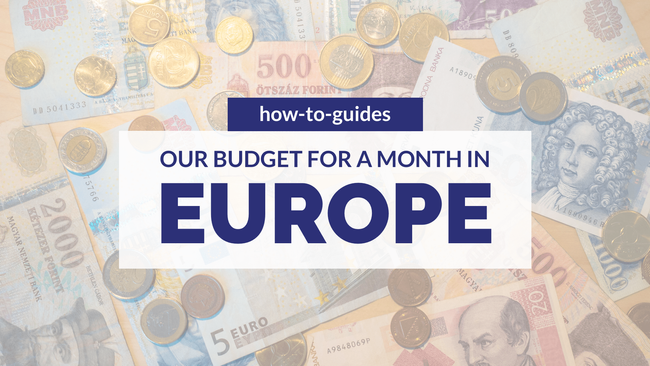
Traveling does not always have to come with an expensive price tag. The more we travel, the better we are at managing our money while on our adventures. Stepping out of the vacationer mindset and into the traveler's shoes has given us richer and more meaningful experiences, and giving ourselves a budget has forced us to be more proactive while on the go. We hope that our information will help and inspire you with your next trip to Europe
Accommodations $733/person
Transportation $961/person, food $509/person, adventures & souvenirs $292/person.
People have approached us asking how we can afford to travel and how much our trips cost. We started this website with the goal to be completely transparent. In this article, we will break down our one month long trip around Europe and give you a rough outline on our expenses. Our primary costs are into transportation, accommodations, food, and entertainment.
We spent $2,523/person ($5,047 total). This figure includes all flights, trains, accommodations, food, museums, souvenirs and other miscellaneous items during the month.
We only planned and scheduled the first week of our trip. The rest of the time we closely monitored airfare/bus/ and train rates to decide what our next destination would be. This method allowed for more flexibility but also resulted in slightly higher ticket prices.
Planning and purchasing the tickets in advance is an excellent way to save money.
We decided to visit a combination of higher and lower cost cities. We went to Amsterdam, Barcelona, Dubrovnik, Mostar, Sarajevo, Zagreb, Vienna, Budapest and Belgium. Spending several days in each location.
- High-cost cities: Amsterdam, Dubrovnik, Vienna, Belgium
- Moderate-cost cities: Budapest, Barcelona, Zagreb
- Low-cost cities: Mostar, Sarajevo
The entire month we used Airbnb for accommodations. It is important for us to have a reliable place to work, cook, do laundry and sleep. For two people we found this method to be more economical. Hostels end up costing more for a couple that would otherwise end up splitting the bill anyway.
For accommodations, we spent $733/person for the entire month ($1,466 total), the average night costing $27.50/person, which was a little higher than our original goal of$20. It helps to be somewhat flexible for those last minute experiences you can not pass up. Otherwise, try to make a habit of staying within the budget.
Hostels are located in convenient areas, and since we stayed in Airbnb, it took some effort to find a home that was centrally located. We managed to find places that were located near the things we wanted to do. We are confident that with a little patience you will be able to do the same. Our bookings were entire apartments except for our last night in Amsterdam which was a private room in someone's home.
Excuse the mess! We took all these photos after we had settled into our temporary space.
CHECK OUT AIRBNB NOW
Here are average figures for two people renting an entire home on Airbnb. This number includes all the fees and taxes that are associated with Airbnb. We spent less than average and were very comfortable. Prices may differ season to season.
- Amsterdam - $136 average/night
- Barcelona - $124 average/night
- Dubrovnik - $89 average/night
- Mostar - $48 average/night
- Sarajevo - $48 average/night
- Zagreb - $53 average/night
- Vienna - $81 average/night
- Budapest - $52 average/night
We recommend Airbnb to anyone who does not need all the guaranteed amenities that hotels provide. Although in many cases the Airbnb we stayed in provided coffee makers, kitchens, washing machines, and homey features. Airbnb hosts benefit from providing exceptional service. All stays require reviews by the guests and are made publicly available. Many hosts take pride in their homes, so they are always available to make your stay the best. We use Airbnb a lot and have always had good experiences.
Solo travelers often get a lower rate when looking to book apartments on Airbnb.
We increasingly rely on Scott's Cheap Flights for great promotions on international airfare. This service alerts us immediately when there are cheap flights from our area. In some cases, the prices are mistakes by the airline, in which case you would have to book immediately before it is corrected.
SCOTT'S CHEAP FLIGHTS
Google Flights is the best tool to use when looking for flights. We like to use the calendar view so we can see when the best times to fly are. Before Scott's Cheap Flights came out, we exclusively used Google to find cheap fares. Make sure you always book directly with the company, it is much easier to make changes to reservations if you do so.
Delta and their Dutch partner KLM have recently started flying from SLC to AMS direct and we were able to buy direct round-trip tickets for $606/person. Normally, these tickets cost$1,200/person, so this helped cut travel costs by $1,188! Finding good deals on tickets is so important and can help add money to the "fun" budget.
We spent $355/person ($710 total) on domestic trains, flights, and busses. We opted out of getting the Eurail pass because it did not go to eastern Europe. Also, the Eurail pass is only worth it if it saves money. We highly suggest doing some math ahead of time to see if it is worth it to you. In our case, it was better to purchase all of the tickets separately. You are typically paying a premium for the train, because of legroom, convenience, and ease of travel.
We purchased all of our tickets a few days in advance or day of. Planning a trip a whole month in advance could have been quite complicated but will definitely save money in the long-run.
We purchased all of our tickets a few days in advance or day of. Planning a trip a whole month in advance could have been quite complicated but will save money in the long-run.
When we travel for extended periods of time we try to cook more than we eat out. It is hard to eat a huge meal and then walk 10 miles while exploring a new city. We love shopping at local stores and markets and our meals revolve around the fruits, veggies, and spices that are available to us.
When we do eat out we put a lot of thought into the restaurants and bars we visit. We want an authentic experience, quality food, and good service. Typically, we eat out once a day and cook the other meals at home or grab something light to go. Trying local beers, wines and liquors are also included in this budget.
We tie food, with culture and it is a big travel expense for us. This trip, we spent $509/person ($1,019 total) on food & drinks. Each person spent $311 ($623 total) at restaurants and $198 ($396 total) on groceries.
Each of us spent $292 ($584 total) on tours, museums, and adventures. We typically do one to two museums and a tour of each city. We also try to do something unusual or different or something outdoors. When traveling, we try to stick to activities that are unique to the area.
Becoming a pro at spotting tourist traps is another great way to save money. A lot of attractions or tours are gimmicky and tend to be expensive. If it is not unique and can be done in other places then we suggest caution. Prices for these types of attractions are usually jacked up, be cautious, so you are not taken advantage of. We suggest asking locals what they enjoy doing. If you take a walking tour ask your guide for a list of tourist traps and how to avoid them. Do not forget to tip if the tour is free.
We hope you have found this rough summary useful when deciding how much moolah you will need for your adventure. We will regularly update this article as new information and tips come through. Subscribe to our newsletter and be alerted right away. Please leave any tips you have in the comments below, or ask and the community can help. We will do our best to answer your questions promptly.
If you like it, Pin It!
Join our weekly adventures
Gain access to our exclusive travel tips and more! Expect exotic destinations, big adventures, flavorful food and unforgettable stories from our travels.
Related Articles

Our 10 Favorite Destinations

Five Getaways That Won't Break the Bank
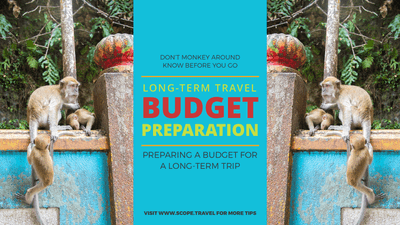
Budgeting for Long-term Travel

Using Airbnb Like a Pro

Cost of Backpacking in Europe & Budget Calculator (2024)
Wondering how much it costs to backpack Europe?
You’ve come to the right article as I’m a full-time budget traveller and I’ve travelled across more than 20 countries in Europe.
The cost of backpacking in Europe is one of the main turn-offs people have about travelling across the continent on a budget.
I’ll be honest from the start- no, it’s nowhere near as cheap as Asia , Central and South America or Africa.
You won’t be finding $3-a-night hostels in Europe, unfortunately. So how much does it cost?
Well, I’ve written a complete guide and even created a budget calculator so you know exactly how much to budget.
How much does Backpacking Europe cost?
The cost of backpacking Europe isn’t as straightforward as saying “It will cost this much each month”.
There are so many factors which affect a backpacking budget , especially in Europe.
These factors are:
- Which countries you backpack
- How long you backpack
- What type of backpacker you are
It might sound obvious when it’s written out, but it’s true. Naturally, the longer you backpack for, the more it’s going to cost.

And where you are backpacking in Europe will affect it too. There are some really expensive countries in Europe like Denmark or Switzerland. In Denmark, I spent about $50 a day, for example.
In the western part of Europe, countries are averagely expensive. France, Germany, Belgium, etc., all have similar economies and things cost pretty much the same price in each country. In these countries, my average daily cost is usually around $30.
But as you move further east, things get cheaper. Italy, for example, is cheaper than France. And Croatia is cheaper than Italy. And Romania is cheaper than Croatia. For example, in Poland, I spent about $20 a day when I visited Gdańsk.
A general rule of thumb is “West, expensive, east, cheap”.

To give you an idea of the difference in budgets, a month in France for an average backpacker would be $1500 USD but a month in Bulgaria for the average backpacker would be $750. That’s half the price!
So it really is impossible to give a “one size fits all” answer to how much it costs to backpack Europe.
Naturally, though, backpacking is cheaper than travelling “normally” as you aren’t staying in hotels or booking expensive activities, and you’re trying to save money wherever possible.

If I had to put a figure to it, I would say an average budget of $1500 a month in Western Europe and $900 a month in Eastern Europe . This doesn’t include flights- only bus/train travel, accommodation, food and activities.
There are also lots of different currencies used across Europe, obviously, the main one is the euro , but there are still lots of countries which don’t use it. Except for Scandinavia and Switzerland, most countries which have their own currencies are cheaper like Poland , Czech Republic or Hungary.
But don’t worry- I know that you want a clear answer to know how much to budget for your backpacking trip. So I’ll go into further detail now- or you can skip to my budget calculator if you want to personalise your budget to you.

Cost of Backpacking Europe by Country
As I said, the cost of backpacking in Europe depends very heavily on which countries you are visiting. So to give you a rough idea, here’s a rough budget for 3 different types of backpackers in every country in Europe.
A shoestring backpacker is someone who spends as little money as possible and sacrifices basically everything. Making your own meals, cheapest hostel no matter the quality, walk everywhere, free walking tours, etc.
The average backpacker is what I categorise myself in. I’ll stay in a hostel, do a few paid activities but mostly free or cheap, take public transport, and I eat out for one main meal a day whether that’s fast food or street food.
A flashpacker is a backpacker with some more luxuries. They might book a private room in a hostel, or eat in a proper restaurant instead of fast food or street food, take taxis, and they do all of the main attractions, no matter the price.
There’s no right or wrong way to backpack , but obviously how you backpack will affect your budget. So here are some rough budgets for each country in Europe.
- Shoestring: $15
- Average: $30
- Flashpacker: $60
- Shoestring: $20
- Average: $45
- Flashpacker: $70
- Shoestring: $10
- Average: $25
- Flashpacker: $50
- Shoestring: $25
- Average: $50
- Flashpacker: $80
- Shoestring: $12
- Average: $28
- Flashpacker: $55

Bosnia and Herzegovina
- Average: $40
- Flashpacker: $65
- Shoestring: $18
- Average: $35
Czech Republic
- Shoestring: $30
- Average: $60
- Flashpacker: $90
Copenhagen was the first expensive city I visited, and it was quite the shock to my budget-orientated system. But I really loved it there and I’m going back later this year.

- Shoestring: $35
- Average: $70
- Flashpacker: $100
Iceland is one of the most expensive countries in Europe for sure, I couldn’t believe how much things cost when I visited.

When I visited Rome, I was surprised by how reasonable it was price-wise , I expected it to be so expensive because it was such a popular city to visit.
- Average: $24
- Flashpacker: $48
Liechtenstein
Even though Luxembourg is the richest country in the world, I actually didn’t find it to be extortionately expensive .

- Average: $20
- Flashpacker: $40
Netherlands

North Macedonia
- Flashpacker: $105

- Average: $36
- Flashpacker: $54

Stockholm is particularly expensive as it’s the capital city and the most popular place to visit, but other destinations like Gothenburg and Malmo are also expensive.
Switzerland
There are lots of reasons why Switzerland is expensive but to sum it up: their quality of living is much higher than other European countries.
United Kingdom

Backpacking Europe Budget Calculator
To give you a rough idea of how much to budget for a backpacking trip of Europe, I’ve created this custom calculator.
Simply select the country you are going to visit, what type of backpacker you are based on my definitions above, and how long you’ll be in that country.
Do that for each country you’re visiting and then you’ll have a rough total cost for your trip.
Note that this does not include international or domestic flights, visas, vaccines or travel insurance. It does include accommodation (hostels), food, transport and activities.
Budget Calculator
I got the calculator to overestimate budgets ever so slightly because, in my opinion, it’s better to budget more than you need than to need more than you’ve budgeted.

Cost of Backpacking Europe: FAQ
Below are some questions related to the cost of backpacking Europe along with my answers to each question.
A realistic daily budget for backpacking Europe can range from 20 to 80 euros per day depending on the country and how strict you are with your budget. Countries in Western Europe are more expensive than countries in Eastern Europe.
For a month-long backpacking trip, you could spend anywhere from 900 to 2000 euros. This varies heavily depending on where you are and how you travel. This estimate includes accommodation, food, transportation, and some paid attractions.
The price of a 3-week tour of Europe depends on which part of Europe you are travelling. Western Europe is much more expensive and can cost anywhere from €1200+ per person (backpacker budget) whereas Eastern Europe can cost anywhere from €600+ (backpacker budget)
The cost of a 1-month trip varies depending on which European cities and countries you visit and how you travel. A backpacker might spend anywhere from €900 for a month whereas an average traveller might spend €3000 for a month of travel.
Final Thoughts: Europe Backpacking Budget
And there you have it, a complete guide to the cost of backpacking in Europe.
Remember, it d epends on which countries you visit, how long you visit, and how you travel.
If you want the cheapest countries to visit in Europe, head to the East as it’s much cheaper than the West.
Now that you know how much it costs to visit Europe on a budget, it’s time to start planning where to go. I’d recommend checking out Rome- it’s not too expensive and is one of my favourite cities in the world.
Josh Band is the founder of A Backpacker's World. He is a full-time traveller currently on a mission to visit every country in the world. As a full-time traveller, Josh knows exactly how to make the most of any trip and shares these tips with his readers. Josh mostly travels as a backpacker on a budget, so he is also an expert when it comes to getting the most of your money while travelling.
Live Adventure Travel contains affiliate links and is a member of the Amazon Services LLC Associates Program. If you make a purchase using one of these Amazon links, I may receive compensation at no extra cost to you. See my Disclosure Policy for more information.
How much does Backpacking Europe Cost? (My actually spending breakdown)
In the summer of 2022, I ventured on a 4-month backpacking trip across Europe. I made it my mission to keep track of my spending so I could report back to you just how much backpacking in Europe ACTUALLY costs. You see, there are A LOT of guides online estimating ‘the perfect budget’ but the problem is many of them are using figures from pre-2019. AND…well…we all know the years leading up to 22′ haven’t been exactly normal. We have since seen a drastic rise in prices of fuel, accommodation, and everyday living expenses. Now, the good news is, it is still possible to backpack Europe on a Budget but it is also important to be realistic about that budget. That is why I am going to break down step by step just how much I spent on each ‘category’ as well as giving an estimated budget for those who want to spend a little less, and those who want to spend a little more. I will be spilling the beans on the real Backpacking Europe Cost!
What kind of backpacker are you?
Now, before we dive deep into the budget, it is important to determine what kind of backpacker you are because it is pointless for me to tell you how much I spent when in reality, we have completely different spending habits. I have made a little table down below explaining the different types of backpacking styles, a shoestring backpacker, a mid-budget backpacker and a high-budget backpacker. I suggest you read the table and see which one suits you the most.
I personally fall into the mid-budget backpacker, I will travel on a budget when it comes to accommodation, food and transport with the occasional splurge, however, I am very experience led, in other words, if there is something I really want to do, whether that is parasailing, white water rafting or a guided tour I won’t let money get in the way. Later in the post, I will divide my spending into 6 different categories, accommodation, food, transport, alcohol and others. For each category, I will give examples of how I spent my money to help you calculate if you a likely to spend more or less. Yes, I could give you the final figure and call it a day, but the reality is everyone’s final figure is going to be different depending on their spending habits.
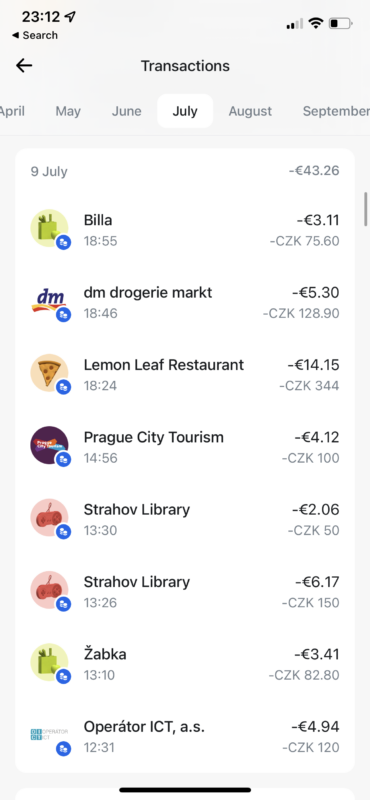
The PERFECT banking card to keep on track with your backpacking Europe budget!
One more thing I want to mention before breaking down the cost of backpacking Europe is banking cards.
Of course, you can go the old fashion route of keeping track of your spending on a spreadsheet every night, but… let’s be honest…that is incredibly time-consuming. And odds are you will lose track of your budget!
I personally, would have been lost without my Revolut pay-as-you-go card. I used it for literally every purchase and it never let me down.
Basically, you add money onto the card as you need and can pay by using your phone or a Revolut debit card. I used to add €500 every Thursday onto my card and that would be my spending money for the week. It felt so good some weeks when I was under.
Revolut is currently running an offer for a FREE card and an additional €10 once you make your first purchase. So, it’s a win-win really. If you are in the market for a Travel banking card then I recommend getting your Revolut card today .
I have highlighted down below some of Revolut’s travel-friendly features.
One of the nicest features of the Revolut mobile app is the budget tracker . Revolut tells you how much you spend each day. I have attached a screenshot above as an example, on the 9th of July, I spent €43.26. The app notifies you each time you make a purchase with your total spent so far that day. Of course, you can turn it off, but I liked it on as it kept me aware of my spending. It also allows you to set a monthly or weekly budget. When you are set to go over that budget the app notifies you! Therefore, you can track your spending while travelling without having to physically think about it.
Another travel-friendly feature of the app is the categories . When you pay for something Revolut automatically stores that payment under a suitable category. Therefore, you can keep track of how much you are spending on accommodation, transport, food etc..
Finally, I want to talk about Revolut’s currency features , it is easy to exchange currencies back and forth through the app. If you are in a country with a currency different to your own, Revolut automatically exchanges your purchase into your home currency. Making it much easier to keep track of what you are spending in a currency you might not otherwise understand. An example of this can also be seen in the screenshot above, I was in the Czech Republic on the 9th of July and all my spending has been converted back into Euro. It’s a super handy feature.
If you are in the market for a travel-friendly banking app I’d highly recommend Revolut. And with my link , you can order a FREE card straight to your home + avail of the extra €10 offer.
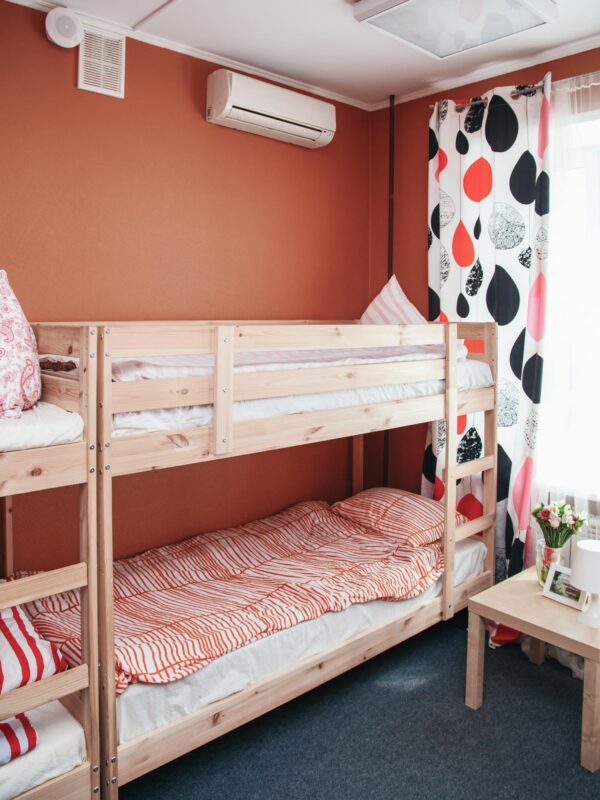
Backpacking Europe Cost Breakdown: Accommodation
The first category I am going to break down is accommodation.
Now, it is important to take into consideration what part of Europe you will be travelling through. In peak season, nightly prices in hostels can vary greatly depending on which country you are travelling to.
Below is a breakdown of the average nightly cost of each country I visited. If you are looking for my honest opinion of each hostel I stayed in then check out this post .
Generally, I stayed in 6-10 bed dorms with the exception of a week’s stay in a private room in Krakow Poland.
The table down below shows a big range of the average nightly cost depending on the destination.
Backpacking Europe Cost Video Guide
Before we continue, I wanted to mention that I do have an intensive video guide version of this blog post. So, if you prefer to watch rather than read this is the guide for you!

Backpacking through Europe Cost Breakdown: Food
The next spending category I want to highlight is food. While I was away I made the majority of my food in my hostels with the occasional splurge on fast food, street food and restaurant meals. Again, the cost of food varies greatly depending on what country you are visiting. However, it is possible to keep costs down by making your own meals.
I purchased this collapsable lunch box on amazon and it proved to be very useful throughout my trip. If I was staying somewhere for longer than 3 days I would make up a big dinner the first night, then store the leftovers in the fridge for the remaining days.
I would usually do a breakfast and dinner shop for 3/4 days which would range from €25 to €35 euros. Which meant I could be spending as little €8 per day on food.
Now, that is not to say I do not recommend splashing out from time to time, it’s nice to try some of the local foods too. Whether that is eating in a boulangerie in Paris, or taking a food tour in Munich .

Backpacking Europe Costs: Drink/Alcohol
Another thing to consider while researching the cost of backpacking in Europe is Alcoholic Beverages. Drinking is a common way to socialize and make friends in hostels, where you’ll likely be staying on your trip. Whether it’s grabbing a beer at the hostel bar or going out with fellow travellers, alcohol is a big part of the social scene.
It can also be tempting to buy a drink while you’re out and about, trying new foods and exploring new cities.
But, trust me, those little purchases add up quickly and can take a big bite out of your budget. On my trip, I didn’t drink a ton of alcohol, so my budget for drinks was lower than the average traveller.
But you may notice, that Croatia is considerably higher than the rest of my trip. That is because it was my first stop and I got sucked into the ‘hostel lifestyle’. But once I added up how much the alcohol cost I quickly reevaluated my spending. Don’t get me wrong, I still took part in the nighttime ventures but I didn’t feel the need to drink every time.
However, I still made sure to set aside some funds specifically for drinks so I wouldn’t be caught off guard. It’s always better to be prepared and budgeting for drinks is a small but important part of the overall backpacking experience, especially if you want to fully immerse yourself in the social scene and make new friends along the way.

Cost to backpack Europe: Activities
However, if you are planning on taking part in day tours, visiting national parks, or booking into adventure activities , then I recommend putting some additional funds aside.
One of the more expensive elements of backpacking in Europe is activities and tourist attractions. Of course, there are plenty of things to do on a budget.
It means that you can try everything you want to do in a destination without feeling like you are spending too much money. The last thing you want is to regret not visiting places like the fairytale setting of the Neuschwanstein Castle in Germany or the taking part in the iconic Boat Tours in Budapest .
Personally, I am very satisfied with how much I spent on tours and activities. Yes, some things were expensive like day trips through the Julian Alps or Rafting in Croatia. But I have many amazing memories from these experiences.

How much does it cost to backpack Europe: Transport
There are many convenient ways to travel across Europe, the main ones being train, bus and ferry. The continent is well connected and it is easy to get from A to B. Many people will argue that using busses is the most budget-friendly option while backpacking Europe. And this may be true to some extent, I believe travelling by train is a much better option.
If you purchase a continuous interrail pass you can travel between most destinations without needing to pre-book your tickets. Meaning you’ll have full flexibility when you decide to move on from each stop. It also allows you to make use of the convenient night train services .
If you want to find out more about how the Interrail Pass works you can check out my Youtube video here .
It is also important to keep a bit of money for transport set aside, many European cities have great Uber services, like Rome , while others like Budapest only have traditional taxi services which will cost a fair bit more. In saying that walking and public transportation is a much cost affective way of getting around.
For my first month of travelling (Croatia), I made my way around by bus or ferry. I then activated my 3-month interrail pass for the remainder of my trip. Below is a breakdown of how much I spent on transport over the 4 months.

Backpack Europe Budget: Other Expenses
The next category covers all other expenses, these are the little things that you need to buy throughout your trip that you never really thought of adding to your predicted budget. For example, washing your clothing tends, this price vary’s from place to place with it costing around €8 in places more eastern/central cities like Split and Budapest . And €10/12 Europe in more northern countries like Italy.
Trips to the pharmacy really add up, especially if you are away for a long period of time. Hygiene products like shampoo, tooth paste and deodorant.
Cash withdrawals where you can’t quite remember what you spent the money on 🤣
And clothing, I DID NOT pack right for my trip and ended up spending a lot more money on clothes than I wish to admit. I did not account for this in my original budget.
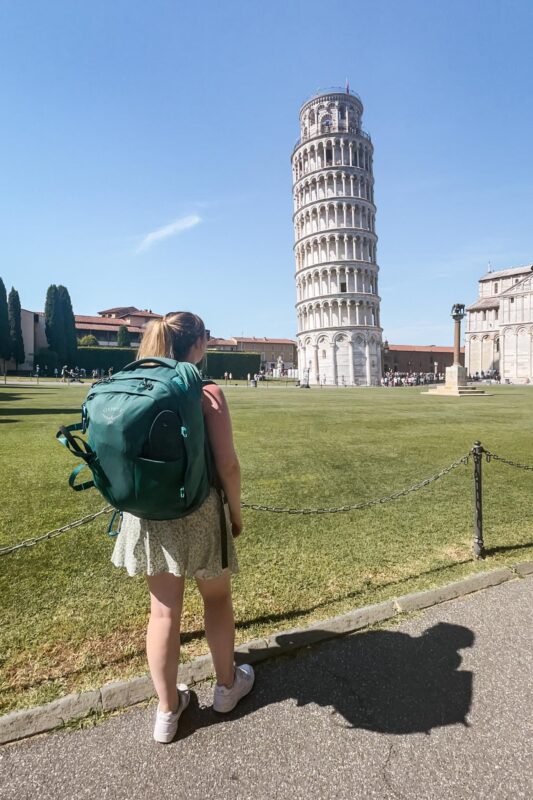
The total cost of backpacking Europe
And now, for the grand total of how much I spent while backpacking Europe. Drum roll please…
I spent a total of €8,336 over the course of 114 days in Europe which equals to an average of €73 per day.
Now, if you are planning your own Europe trip, please take this as a rough guide as there are many circumstances that may lead to that price being higher or lower.
For example, accommodation types, certain countries, activities, eating habits and backpacking style.
I have broken down below the total spend of each country to give you an ever-deeper understanding of my spending.

Tips on how to travel Europe on a Budget
1. bring a reusable bottle:.
This may seem like a simple concept, but not only is it environmentally friendly you will also save yourself €1 to €4 every time you need a drink. Most major European cities have free and safe drinking water. I recommend this reusable bottle. I love that it has a clip so I can add it to the outside of my bag.
2. Do NOT withdraw cash from just any bank machines
In Europe, there are ATM machines EVERYWHERE. Every time you turn a corner there are at least 3 machines BUT… these machines tend to have the largest withdrawn fees. I recommend finding an ATM that is attached to a bank as it will be a lot more affordable to withdraw money.
3. Walk as much as possible!
Avoid taking busses, taxis and paid modes of transport. A lot of European cities are walkable and while a simple bus journey may only cost a couple of euros. Using them repeatedly can really add up. Walking will save you some extra cash and you may come across a hidden gem or two as you stroll.
4. SIM Cards
If you are visiting from outside the EU, odds are you will need to purchase a sim card. I was lucky, as my phone works as normal in most European countries. However, I made friends with fellow backpackers who were stung by high prices when purchasing sim cards and phone plans from shops in train stations and airports. My advice would be to wait until you get into a city before shopping for plans.
5. Travel in the off-season
It can be tempting to plan your trip in the summer months but the reality is this is when Europe is at it’s most expensive. Considering travelling the shoulder season between March-May or September – October. You will still have mild to warm temperatures in most countries but accommodation and activities will be a fraction of the price.
6. Plan your route ahead of time
Plan your Europe Route before starting your trip, I don’t mean you need to prebook everything but have an idea of where you want to go. This way you will avoid travelling back and forward and ultimately spending more money on transportation than needed.
So, for example, say you plan to visit Budapest , have a look to see what other destinations are near by before jumping to say Lisbon which is on the otherside of the continent.
7. Eastern VS Western Europe
Eastern Europe is considerably more affordable than Western Europe. So, if you are trying to have your money go as far as possible try to stay out of the West. The Balkans is also a budget-friendly spot to travel around and is completely underrated. You will pay a fraction of the price in the likes of Poland, Slovenia and Croatia, compared to the likes of Lisbon , Rome or Dublin .
8. Make friends to share the budget with
If you plan on staying in hostels you will find it easy to make friends with fellow travellers. Odds are one of them will want to take part in the same activities whether that is renting a boat, going on a day tour or taking part in an experience. Generally, there a group discounts, its best to take advantage of this as much as possible.
9. Shop around for you flights
Ok, so I didn’t actually include the price of my flight in this final cost breakdown because this expense will vary from person to person depending from where you are travelling from. For example, some may be starting from a country in mainland Europe, therefore, no flights would be needed.
Where as me, I travelled from Dublin, which tends to be rather expensive compared to other European destinations.
Then you have backpacker coming from different continents, they will need to factor in the cost of flights as they will be considerable more.
10. Don’t skip out on the hidden gems
Ok, so it can be easy to want to visit some of Europe’s top travel destinations while backpacking but do not sleep on the off the beaten path locations. Like Hallstatt in Austria or Lauterbrunnen in Switzerland.
This also applys to cities, like did you know that one of Rome’s top hidden gems in a pyramid, or that Budapest has a underground cave system that you can take an adrenaline tour through?
And yes some of these experiences cost money but I highly recommend keeping some cash aside for them as they will leave you with a life time of memories.
11. Don’t let expenses get in the way of your saftey
It can be easy to decide to walk somewhere at night alone because it is the more cost effective way of getting there. However, even in safe cities such as Budapest or Rome , I would not advise doing so. Yes, hopping in an Uber may eat a little bit into your budget but it means you get to you hostel safetly.
Similar Posts

Packing List for Ireland: A Local’s Guide to 4 seasons in the one day!
Packing List for Ireland: A Local’s Guide to 4 seasons in one day! As an Irish girl born and bred, I like to think I know a thing or two about the unpredictable Irish weather. So much so, that I have learned to accept that seeing rain, sleet and sunshine all in one day are…

Best Hostels in Europe for Solo Travellers
Best Hostels in Europe for Solo Travellers Picking the ‘right’ hostel is never an easy task, especially when there are so many to choose from. I’m currently backpacking my way through Europe ticking off one hostel at a time. I wanted to create this guide to help you find the perfect hostel for your trip….
Leave a Reply Cancel reply
Your email address will not be published. Required fields are marked *
Save my name, email, and website in this browser for the next time I comment.
Traveling to Europe using points and miles in 2024

May 23, 2024 • 17 min read
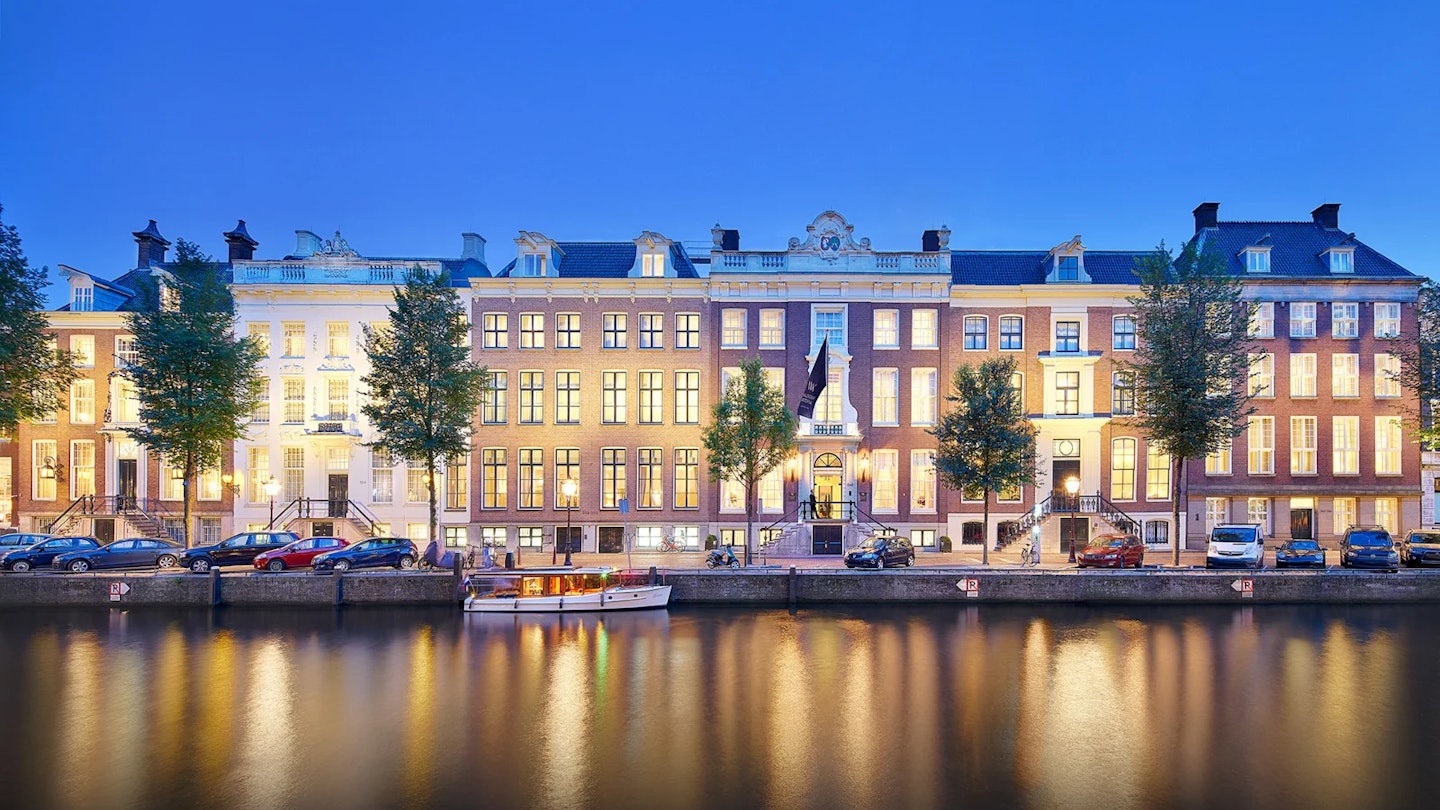
Read on for the best miles and points conversion to stay at the iconic Waldorf Astoria Amsterdam © Waldorf Astoria Amsterdam
This series of articles about credit cards, points and miles, and budgeting for travel is brought to you in partnership with The Points Guy .
Advertiser Disclosure: This post contains references to products from one or more of our advertisers. We may receive compensation when you click on links to those products. Terms apply to the offers listed on this page. This relationship may impact how and where links appear on this site. This site does not include all financial companies or all available financial offers.
All information about the American Express® Green Card*, the Citi Premier® Card, the Marriott Bonvoy Bountiful™ credit card, the Hilton Honors Aspire Card, the World of Hyatt Credit Card, the World of Hyatt Business Credit Card, and the Hilton Honors American Express Business Card has been collected independently by Lonely Planet. These cards are not available through Lonely Planet.
Since pandemic-era travel restrictions have lifted, tourists have been flocking to Europe all summer. While summer has always been a popular time to visit cities like London, Rome and Paris, this resurgence in travel demand has been unprecedented. If you’re looking to travel to Europe at any time this year or next, you’ll see a marked increase in airfare and hotel prices. An excellent workaround for dealing with steep prices is by collecting points and miles .
Not only can you save money by using points for your next trip to Europe, you can fly in premium cabins and stay at some of the best hotels in the world. All at a fraction of the cost of a budget vacation. Here’s everything you need to know about traveling to Europe using points and miles.
How to make a travel budget using points and miles

The cheapest award flights to Europe
Flying to Europe can be expensive, but points and miles can save you a substantial sum – especially if you’re flexible with your travel dates. The cheapest award flights to Europe are typically found during off-peak travel season (typically winter and early spring). Airlines like American, British Airways and Air France offer discounted award tickets during these times, saving you money and points.
But even if you hope to travel in the summer, you can find decent award space by booking far in advance. Meanwhile, Lufthansa has been known to release award space within 1-2 weeks of travel for business and first-class travel. Knowing these things can make booking flights to Europe with miles a less stressful experience.
Here’s a look at the cheapest award flights to Europe and how to earn enough miles for a redemption:
- Cheapest economy class ticket to Europe: From 20,000 Virgin Atlantic Flying Club miles round-trip to the UK.
- Cheapest business class ticket to Europe: From 68,000 Iberia Avios round-trip to Spain.
- Cheapest first-class ticket to Europe: 165,000 ANA Mileage Club miles round-trip.
The best travel credit cards

Award space to London is usually plentiful due to a slightly annoying reason: fuel surcharges. Airlines like Virgin Atlantic and British Airways add these pesky fees to flights passing through UK airports like London Heathrow (LHR). Fuel surcharges are egregiously high on business and first-class tickets (which can go well over $1,500 round-trip). However, they’re not too bad on economy flights or flights originating in cities outside of the UK.
A popular way to avoid fuel surcharges is by flying into London and then returning from Paris, which has much more reasonable taxes. Virgin Atlantic offers the cheapest economy flights to London, at just 20,000 miles roundtrip.
If you want to upgrade to business class, All Nippon Airways (ANA) Mileage Club offers a bargain of just 88,000 miles round-trip. A first-class ticket will set you back 165,000 ANA miles. At this rate, you’re better off sticking to business class for a flatbed seat that offers plenty of comfort on the transatlantic flight. Here are the best rates by class for travel to London:
- Economy class: From 20,000 Virgin Atlantic Flying Club miles round-trip
- Business class: 88,000 ANA Mileage Club miles round-trip
- First class: 165,000 ANA miles round-trip

How to earn miles for a flight to London
Virgin Atlantic miles are easy to earn, thanks to transfer partnerships with American Express Membership Rewards, Bilt Rewards, Capital One, Chase Ultimate Rewards and the Citi ThankYou rewards.
If you’re not a Bilt cardholder, you can transfer points to Flying Club at a 1:1 ratio with the following credit cards:
- The Business Platinum Card® from American Express *: Earn 150,000 Membership Rewards® points after you spend $20,000 in eligible purchases on the Card within the first 3 months of Card Membership.
- Platinum Card® from American Express *: Earn 80,000 points after spending $8,000 in the first six months of card membership.
- Capital One Venture Rewards Credit Card: Earn 75,000 bonus miles once you spend $4,000 on purchases within the first three months from account opening.
- Capital One Venture X Rewards Credit Card: Earn 75,000 bonus miles once you spend $4,000 on purchases within the first three months from account opening.
- American Express® Business Gold Card *: Earn 70,000 points after spending $10,000 within the first three months of card membership.
- American Express® Gold Card *: Earn 60,000 points after spending $6,000 within the first six months of card membership.
- American Express® Green Card: Earn 40,000 points after spending $3,000 within the first six months of card membership.
- Citi Premier® Card: Earn 60,000 points after spending $4,000 in the first three months of account opening.
- Chase Sapphire Reserve® : Earn 75,000 bonus points after you spend $4,000 on purchases in the first 3 months from account opening. That's $1,125 toward travel when you redeem through Chase Travel℠.
- Chase Sapphire Preferred® Card : Earn 75,000 bonus points after you spend $4,000 on purchases in the first 3 months from account opening. That's over $900 when you redeem through Chase Travel℠.
Meanwhile, ANA Mileage Club only partners with Amex Membership Rewards. You can transfer points earned from the Amex Platinum, Gold and Green cards.
Best travel credit cards for hotels

Between the art scene of Barcelona and the sandy beaches of Majorca, Spain has much to offer travelers. Iberia Airways offers one of the best ways to fly to Spain on points and miles, with direct flights to Madrid and Barcelona.
Iberia Airways offers especially great deals on air to Spain in the off-season. Even award tickets are incredibly affordable, with round-trip business class costing the same as most airlines charge for one-way business class awards.
- Economy class: From 34,000 Avios round-trip on Iberia Airways
- Business class: From 68,000 Avios round-trip on Iberia Airways
How to travel to Spain using points and miles
How to earn miles for a flight to Madrid
The Iberia Plus program earns Avios, which you can transfer from your British Airways or Aer Lingus account. This also means you get access to a vast network of transferable currencies you can tap into to earn those miles. Iberia Plus is a 1:1 transfer partner of Amex Membership Rewards and Chase Ultimate Rewards, so you can earn points from cards like the Amex Gold or Chase Sapphire Preferred.
Iberia also has its own Iberia Visa Signature® Card, which has a $95 annual fee and features a time offer to earn 85,000 Avios after you spend $5,000 on purchases within the first three months of account opening. Earn an additional 25,000 Avios after you spend $20,000 within the first 12 months of account opening.
How to use points and miles to save money on travel

If you have dreams of visiting a fashion-forward city , exploring the picturesque countryside and refilling your water bottle in a historical fountain (just kidding, don’t do that!), then Rome is a great place to start your European adventure . Thanks to ANA Mileage Club, you can fly to Rome on a Star Alliance carrier like United or Lufthansa from just 55,000 miles round-trip. Business class is your best bet at 88,000 miles. It’s worth noting that ANA doesn’t allow one-way award redemptions, so you need the total miles for a round-trip to be able to book these flights.
- Economy class: 55,000 ANA miles round-trip
- Business class: 88,000 ANA miles round-trip
How to travel to Italy with points and miles

How to earn miles for a flight to Rome
You can earn enough miles for a round-trip flight to Rome by transferring Amex Membership Rewards points to ANA MileageClub at a 1:1 ratio. With the welcome bonus from The Business Platinum Card® from American Express , you can cover up to two round-trip economy class tickets or one business class.
Best credit cards for international travel

Amsterdam or Paris
Thanks to Air France and KLM’s joint Flying Blue loyalty program, using points for flights to Amsterdam and Paris is fairly easy. The program prices out award flights differently based on distance, but there isn’t a massive difference in price for West Coast vs. East Coast flights. Flying Blue’s rates are already affordable, but you can save even more with Promo Rewards . These discounted fares are updated monthly and offer savings as high as 50%.
- Economy class: From 30,000 miles round-trip
- Business class: From 113,000 miles round-trip
10 incredible branded hotels that have boutique hotel vibes
How to earn miles for a flight to Amsterdam or Paris
Transfer partnerships allow you to stock up on Flying Blue miles for award tickets to Amsterdam or Paris. Flying Blue is a 1:1 transfer partner of Amex Membership Rewards, Bilt Rewards, Capital One, Chase Ultimate Rewards and Citi ThankYou rewards. With the right credit card, you can easily cover at least one round-trip flight with points – maybe even two.
- The Business Platinum Card® from American Express : Earn 150,000 Membership Rewards® points after you spend $20,000 in eligible purchases on the Card within the first 3 months of Card Membership.
- The Platinum Card® from American Express : Earn 80,000 points after spending $8,000 in the first six months of card membership.
- Capital One Venture Rewards Credit Card : Earn 75,000 bonus miles once you spend $4,000 on purchases within the first three months from account opening.
- Capital One Venture X Rewards Credit Card : Earn 75,000 bonus miles once you spend $4,000 on purchases within the first three months from account opening.
- American Express Business Gold Card : Earn 70,000 points after spending $10,000 within the first three months of card membership.
- American Express® Gold Card : Earn 60,000 points after spending $6,000 within the first six months of card membership.
Should you book travel with cash or points?

Iconic hotels you can book with points
Now that airfare is covered, it’s time to focus on hotels. No matter where you travel to in Europe, the continent has a massive hotel market, so you’re bound to find something for your budget and travel needs. When using points, you can’t go wrong with IHG, Hilton, Hyatt and Marriott – these chains have thousands of properties worldwide, including some of the most iconic hotels in Europe. These hotels are especially attainable if you sign up for a new hotel credit card .
If you’re looking for an upscale experience and don’t want to pay the high price tag, there are lots of exceptional hotels to choose from. Here’s a look at some of the most upscale European hotels you can book with points and miles :
10 amazing hotels around the world you can book with points

The St. Pancras Renaissance Hotel London
The St. Pancras Renaissance Hotel London is a landmark property that opened in 1873 and combines grandeur with convenient access to everything the city offers. The hotel shares a building with St. Pancras station, from which you can hop a train to Paris, Brussels, Amsterdam and more. It’s an ideal base to explore Europe without stepping foot in an airport.
Guests can enjoy resort-like amenities, including the on-site gym, spa, pool, sauna and steam room. For 44,000 Marriott points per night, you can book a Deluxe room in the Barlow House wing with soundproof windows and beds fitted with down mattress toppers and Egyptian cotton sheets.
The best credit cards with no international fees
How to earn points
You can earn Marriott points by transferring them from Amex Membership Rewards or Chase Ultimate Rewards. Marriott also has six different credit cards offering welcome bonuses as high as 150,000 bonus points:
- Marriott Bonvoy Brilliant™ American Express® Card : Earn 95,000 Marriott Bonvoy bonus points after you use your new Card to make $6,000 in purchases within the first 6 months of Card Membership.
- Marriott Bonvoy Bevy™ American Express® Card : Earn 85,000 Marriott Bonvoy bonus points after you use your new Card to make $5,000 in purchases within the first 6 months of Card Membership.
- Marriott Bonvoy Bountiful™ credit card: Earn 85,000 points after you spend $4,000 in the first three months from account opening.
- Marriott Bonvoy Business® American Express® Card : Limited Time Offer: Earn 5 Free Night Awards, valued at up to 50K points each for eligible stays. Offer ends 7/10. Resort fees & terms apply.
- Marriott Bonvoy Boundless® Credit Card : Earn 3 Free Night Awards (each night valued up to 50,000 points) after spending $3,000 on purchases in your first three months from account opening.
- Marriott Bonvoy Bold® credit card : Earn 30,000 bonus points after you spend $1,000 on eligible purchases within the first six months from account opening. Plus, earn up to 14X total points for every $1 spent at thousands of hotels participating in Marriott Bonvoy.

St. Regis Rome
When in Rome, you might want a hotel that provides the opulence of a 19th-century palazzo. The award-winning St Regis Rome delivers just that. Built in 1894, the hotel offers lavishly appointed rooms with marble bathrooms, nightly turndown and butler service. Rates start at 80,000 points per night. While steep, you can save 20% by taking advantage of Marriott’s fifth-night free benefit on award stays.
The hotel is within walking distance of the National Gallery of Ancient Art and close to tourist attractions like the Trevi Fountain and Colosseum.
Best credit cards for adventure travel

The Principal Madrid
Hyatt has some great hotel options in Madrid at very reasonable rates. The Principal Madrid Hotel hotel is a great choice, with rooms starting at just 21,000 Hyatt points per night. Standard rooms are relatively small at just over 200 sqft but boast plenty of natural light. The Principal has the distinction of being the first five-star hotel in Madrid’s famed Gran Via, close to shopping and tourist attractions.
How to travel to Greece using points and miles
How to earn Hyatt points
Earning Hyatt points for a stay at The Principal Madrid is as easy as transferring Bilt or Chase Ultimate Rewards points. You can also top up your account with one of Hyatt’s co-branded credit cards, which can cover up to three nights at this hotel.
- World of Hyatt Credit Card: Earn 30,000 Bonus Points after you spend $3,000 on purchases in your first 3 months from account opening. Plus, up to 30,000 More Bonus Points by earning 2 Bonus Points total per $1 spent in the first 6 months from account opening on purchases that normally earn 1 Bonus Point, on up to $15,000 spent.
- World of Hyatt Business Credit Card: 60,000 Bonus Points after you spend $5,000 on purchases in your first 3 months from account opening.
American Express Membership Rewards vs. Chase Ultimate Rewards
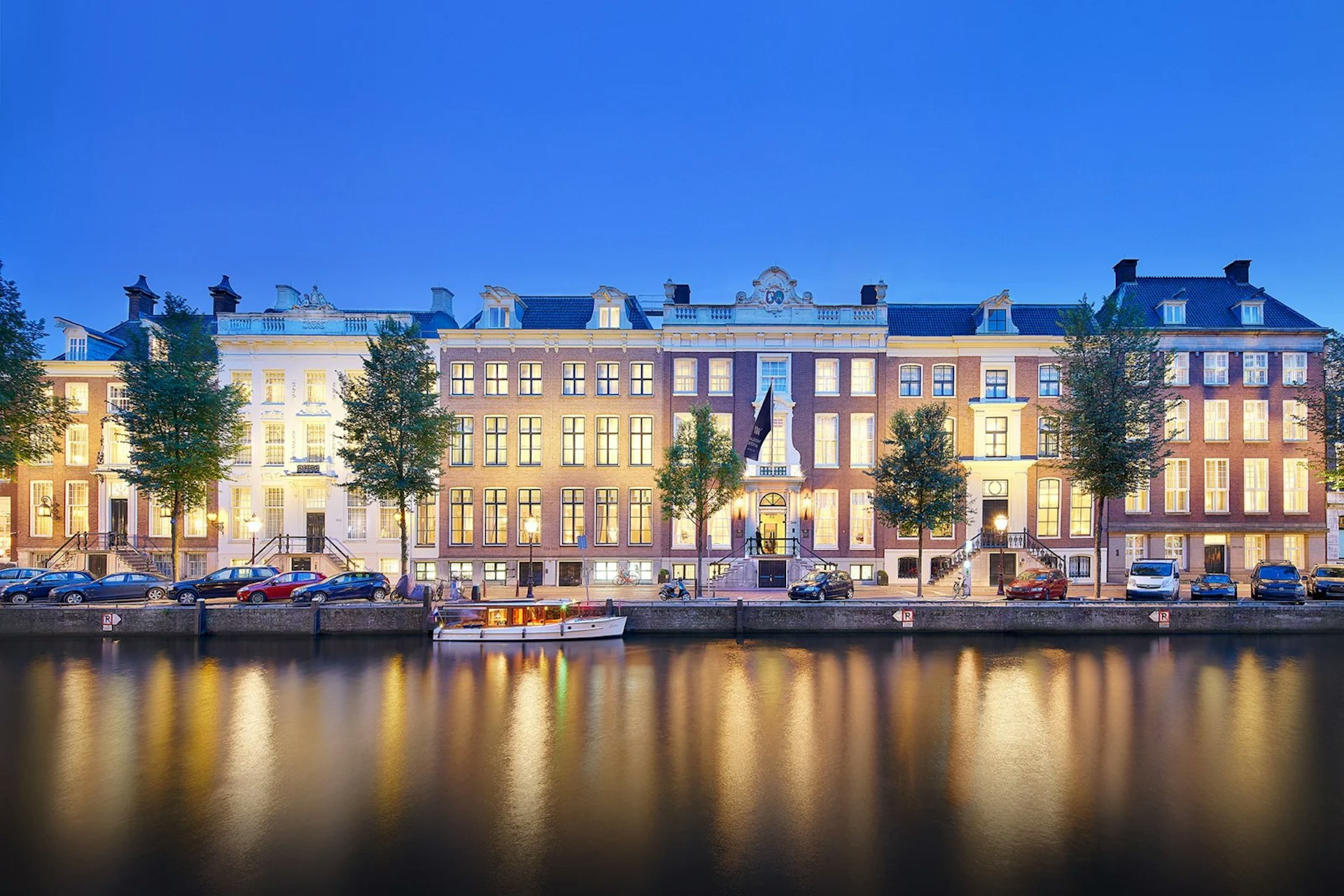
Waldorf Astoria Amsterdam
The Waldorf Amsterdam strikes a perfect balance between embodying the city’s renowned charm in a luxury setting. The hotel is located inside six 17th and 18th-century palaces on the UNESCO heritage site of Herengracht Canal. The hotel boasts two Michelin-starred restaurants and provides easy access to the city’s main tourist attractions, like the Hermitage Museum. Guests are also just a 12-minute tram ride from the city’s Centraal Station, making getting around the city and to the airport easy.
Award rates start at 110,000 Hilton points per night for a Superior Room, which is spacious by European standards at 301-355 sqft. Superior rooms are outfitted with Egyptian cotton sheets, a marble bathroom and large windows to let in lots of natural light.
The best credit cards for Global Entry
How to earn Hilton points
The Hilton Honors program is a 1:2 transfer partner of Amex Membership Rewards, though this isn’t the best use of points. A better way to boost your Hilton points balance is by acquiring one of the Hilton credit cards. You can piece together multiple nights with the welcome bonus, annual spending bonus and generous earn rates on everyday spending. You’ll even get valuable elite status perks that can translate to room upgrades, complimentary breakfast and other enhancements to your travel experience.
- Hilton Honors Aspire Card: Earn 150,000 Hilton Honors bonus points after you spend $6,000 in purchases in the first six months of card membership.
- Hilton Honors American Express Surpass® Card : Earn 130,000 Hilton Honors Bonus Points plus a Free Night Reward after you spend $3,000 in purchases on the Hilton Honors American Express Surpass® Card in the first 6 months of Card Membership. Offer Ends 7/31/2024.
- The Hilton Honors American Express Business Card: Earn 175,000 Hilton Honors Bonus Points after you spend $8,000 in purchases on the Hilton Honors Business Card within the first six months of Card Membership. Offer Ends 6/5/24.
- Hilton Honors American Express Card : Earn 70,000 Hilton Honors Bonus Points plus a Free Night Reward after you spend $2,000 in purchases on the Hilton Honors American Express Card in the first 6 months of Card Membership. Offer Ends 7/31/2024.
Related: Best credit cards for road trips

Intercontinental Paris Le Grand
Paris has no shortage of exceptional hotels that provide grandeur and comfort. If you’re looking for old-world luxury with a historical background, you can’t go wrong with the Intercontinental Paris Le Grand. This hotel opened in 1862 (sans the Intercontinental brand) and hosts the famed Café de la Paix, the preferred hangout spot for renowned writers like Ernest Hemingway and Victor Hugo.
Award rates at this iconic property start at 66,000 IHG One points per night for a 215 sqft. “Cozy room” with a courtyard view. The hotel boasts an excellent location across the street from Palais Garnier and a short walk to tourist hot spots like the Jardin des Tuileries and the Louvre. Whether it’s your first time visiting The City of Lights or your tenth, the Intercontinental Paris Le Grand is an excellent choice for a point stay.
Best travel credit cards for foodies
How to earn IHG points
If you want to earn enough IHG points for a stay at the Intercontinental Paris Le Grand, you can transfer Chase Ultimate Rewards or Bilt points to IHG at a 1:1 ratio. Alternatively, you can pick up an IHG credit card to earn 140,000 points and elite status perks. Cardholders also get the fourth night free on award stays, along with other valuable perks.
- IHG One Rewards Premier Credit Card : Earn 140,000 Bonus Points after spending $3,000 on purchases in the first 3 months from account opening.
- IHG One Rewards Premier Business Credit Card : Earn 140,000 Bonus Points after spending $4,000 on purchases in the first 3 months from account opening.
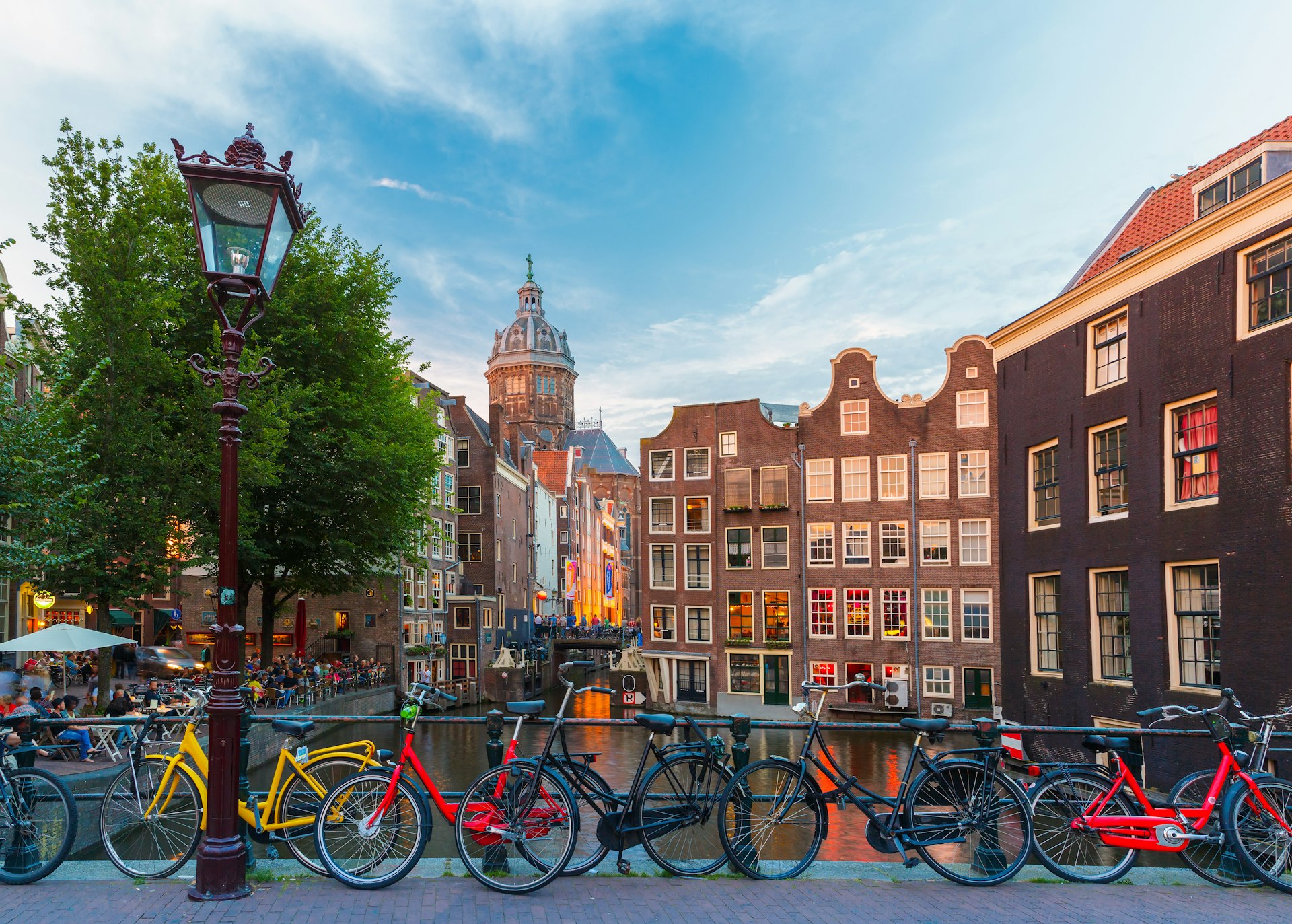
Bottom line
Travel to Europe is more expensive than ever, but you can reduce the cost with points and miles. A European vacation can fit anyone's budget with flights starting at just 20,000 miles round-trip and luxury hotel options like the Intercontinental Paris Le Grand.
How to get major perks at global events and concerts with your credit card
* Eligibility and Benefit level varies by Card. Terms, Conditions, and Limitations Apply. Please visit americanexpress.com/benefitsguide for more details. Underwritten by Amex Assurance Company.
Terms apply to American Express benefits and offers. Enrollment may be required for select American Express benefits and offers. Visit americanexpress.com to learn more.
Editorial disclaimer: Opinions expressed here are the author’s alone, not those of any bank, credit card issuer, airline or hotel chain, and have not been reviewed, approved or otherwise endorsed by any of these entities.
This article was first published Sep 8, 2023 and updated May 23, 2024.
Explore related stories

Destination Practicalities
May 30, 2024 • 10 min read
Our first-time guide to Palma de Mallorca gives you a taste of what’s here, but you’re sure to find treasures of your own, too.

May 27, 2024 • 6 min read

May 21, 2024 • 10 min read

May 21, 2024 • 11 min read

May 20, 2024 • 5 min read

May 3, 2024 • 6 min read

Apr 30, 2024 • 4 min read

Apr 19, 2024 • 10 min read

Apr 7, 2024 • 11 min read

Mar 31, 2024 • 6 min read
- Logout Login
- Adventure Holidays
- Weekend Getaways
- Driving Holidays
- Travel News
Top Searches
Schengen Visa Fee
World Natural Wonders
Monsoon India Destinations
Delhi Heatwave
Jaipur Amer Fort
Vaishno Devi Temple
How much does a budget trip to Europe cost? Detailed travel plan and tips
Times of India TIMESOFINDIA.COM / TRAVEL TRENDS , WORLD / Created : Jun 7, 2024, 16:00 IST
You're Reading
Europe is a dream destination for many travellers, offering rich experiences without breaking the bank. Choosing affordable destinations like Portugal, Spain, Greece, Hungary, and Poland can make for a memorable and budget-friendl … Read more
Europe is a dream destination for many travellers, offering rich experiences without breaking the bank. Choosing affordable destinations like Portugal, Spain, Greece, Hungary, and Poland can make for a memorable and budget-friendly trip. Read less

More from Travel News

Most beautiful places in Asia that inspire travel

Comments (0)

Refrain from posting comments that are obscene, defamatory or inflammatory, and do not indulge in personal attacks, name calling or inciting hatred against any community. Help us delete comments that do not follow these guidelines by marking them offensive . Let's work together to keep the conversation civil.
Comments ( ) Sort: Newest UpVoted Oldest Discussed Down Voted closecomments

SIGN IN WITH
Or post without registration.

Visual Stories

Popular Galleries

Top places in the world where gravity doesn't work TRAVEL TRENDS , WORLD

Discovering the depths: 7 deepest lakes in the world TRAVEL TRENDS , WORLD

10 museums in India to visit once in a lifetime TRAVEL TRENDS , INDIA
Trending stories.
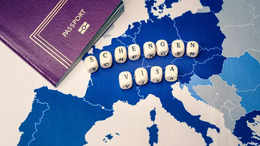
- Schengen Visa fee hike: Your Europe trips to become costlier from today; details inside

- Chail: A perfect summer escape from Delhi

Most beautiful roads for ultimate driving holidays in India

Discovering the depths: 7 deepest lakes in the world

How to plan for a successful trekking adventure
- 1 How much does a budget trip to Europe cost? Detailed travel plan and tips
- 2 Top 5 national parks to visit in the USA
- 3 Odisha's Bhitarkanika mangrove forest is an ecological gem; here’s why
- 4 Exploring Kashmir in a 3-day itinerary
- 5 People are Googling these 7 places the most for travelling

THE DEFINITIVE GUIDE TO DESTINATIONS, ITINERARIES, THINGS TO DO, RESTAURANTS, NIGHTLIFE and LOTS MORE!
FOLLOW US ON
Places to visit.
- Places to visit in Bangalore
- Places to visit in Mumbai
- Places to visit in Delhi
- Places to visit in Goa
- Hotels in Goa
- Hotels in Jaipur
- Hotels in Shimla
- Hotels in Mumbai
Things To do
- Things to do in Goa
- Things to do in Mumbai
- Things to do in Bangalore
- Things to do in Delhi
Travel Inspiration
- Visa on arrival for Indians
- Honeymoon Places in india
- Hill Stations in India
- Weekend getaways in Mumbai
- Weather in Delhi
- Weather in Chennai
- Weather in Bangalore
- Weather in Mumbai
Best Beaches
- Goa Beaches
- Mumbai Beaches
- Pondicherry Beaches
- Kerala Beaches
- Restaurants in Bangalore
- Restaurants in Chennai
- Restaurants in Pune
- Restaurants in Jaipur
- Hill Station near Delhi
- Winter trip to Ladakh
- Places to visit in Kerala
- Winter Honeymoon Destinations
- UK visa guide for Indians
- Winter Trip to Manali
- Vaishno Devi Yatra
- Special Train Ticket Booking
- HP inter-state Bus
- Honeymoon Destinations India
Latest News
- Thailand opens doors: Two-month visa-free travel for Indian passport holders
- 5 reasons to choose Nepal for your next travel destination
Congratulations!
You have been successfully added to the mailing list of Times of India Travel. To complete the subscription process, kindly open your inbox and click on the confirmation link which has been emailed to you.
Share with friends
Thank You for sharing! Your friend will receive the article link on email mentioned.
- (For more than one recipient, type addresses separated by commas)

Europe is a dream destination for many travellers, offering rich experiences without breaking the bank. Choosing affordable destinations like Portugal, Spain, Greece, Hungary, and Poland can make for ...

- Your current location
Price per liter
Your route preferences.
- Auto Insurance Best Car Insurance Cheapest Car Insurance Compare Car Insurance Quotes Best Car Insurance For Young Drivers Best Auto & Home Bundles Cheapest Cars To Insure
- Home Insurance Best Home Insurance Best Renters Insurance Cheapest Homeowners Insurance Types Of Homeowners Insurance
- Life Insurance Best Life Insurance Best Term Life Insurance Best Senior Life Insurance Best Whole Life Insurance Best No Exam Life Insurance
- Pet Insurance Best Pet Insurance Cheap Pet Insurance Pet Insurance Costs Compare Pet Insurance Quotes
- Travel Insurance Best Travel Insurance Cancel For Any Reason Travel Insurance Best Cruise Travel Insurance Best Senior Travel Insurance
- Health Insurance Best Health Insurance Plans Best Affordable Health Insurance Best Dental Insurance Best Vision Insurance Best Disability Insurance
- Credit Cards Best Credit Cards 2024 Best Balance Transfer Credit Cards Best Rewards Credit Cards Best Cash Back Credit Cards Best Travel Rewards Credit Cards Best 0% APR Credit Cards Best Business Credit Cards Best Credit Cards for Startups Best Credit Cards For Bad Credit Best Cards for Students without Credit
- Credit Card Reviews Chase Sapphire Preferred Wells Fargo Active Cash® Chase Sapphire Reserve Citi Double Cash Citi Diamond Preferred Chase Ink Business Unlimited American Express Blue Business Plus
- Credit Card by Issuer Best Chase Credit Cards Best American Express Credit Cards Best Bank of America Credit Cards Best Visa Credit Cards
- Credit Score Best Credit Monitoring Services Best Identity Theft Protection
- CDs Best CD Rates Best No Penalty CDs Best Jumbo CD Rates Best 3 Month CD Rates Best 6 Month CD Rates Best 9 Month CD Rates Best 1 Year CD Rates Best 2 Year CD Rates Best 5 Year CD Rates
- Checking Best High-Yield Checking Accounts Best Checking Accounts Best No Fee Checking Accounts Best Teen Checking Accounts Best Student Checking Accounts Best Joint Checking Accounts Best Business Checking Accounts Best Free Checking Accounts
- Savings Best High-Yield Savings Accounts Best Free No-Fee Savings Accounts Simple Savings Calculator Monthly Budget Calculator: 50/30/20
- Mortgages Best Mortgage Lenders Best Online Mortgage Lenders Current Mortgage Rates Best HELOC Rates Best Mortgage Refinance Lenders Best Home Equity Loan Lenders Best VA Mortgage Lenders Mortgage Refinance Rates Mortgage Interest Rate Forecast
- Personal Loans Best Personal Loans Best Debt Consolidation Loans Best Emergency Loans Best Home Improvement Loans Best Bad Credit Loans Best Installment Loans For Bad Credit Best Personal Loans For Fair Credit Best Low Interest Personal Loans
- Student Loans Best Student Loans Best Student Loan Refinance Best Student Loans for Bad or No Credit Best Low-Interest Student Loans
- Business Loans Best Business Loans Best Business Lines of Credit Apply For A Business Loan Business Loan vs. Business Line Of Credit What Is An SBA Loan?
- Investing Best Online Brokers Top 10 Cryptocurrencies Best Low-Risk Investments Best Cheap Stocks To Buy Now Best S&P 500 Index Funds Best Stocks For Beginners How To Make Money From Investing In Stocks
- Retirement Best Roth IRAs Best Gold IRAs Best Investments for a Roth IRA Best Bitcoin IRAs Protecting Your 401(k) In a Recession Types of IRAs Roth vs Traditional IRA How To Open A Roth IRA
- Business Formation Best LLC Services Best Registered Agent Services How To Start An LLC How To Start A Business
- Web Design & Hosting Best Website Builders Best E-commerce Platforms Best Domain Registrar
- HR & Payroll Best Payroll Software Best HR Software Best HRIS Systems Best Recruiting Software Best Applicant Tracking Systems
- Payment Processing Best Credit Card Processing Companies Best POS Systems Best Merchant Services Best Credit Card Readers How To Accept Credit Cards
- More Business Solutions Best VPNs Best VoIP Services Best Project Management Software Best CRM Software Best Accounting Software
- Debt relief Best debt management Best debt settlement Do you need a debt management plan? What is debt settlement? Debt consolidation vs. debt settlement Should you settle your debt or pay in full? How to negotiate a debt settlement on your own
- Debt collection Can a debt collector garnish my bank account or my wages? Can credit card companies garnish your wages? What is the Fair Debt Collection Practices Act?
- Bankruptcy How much does it cost to file for bankruptcy? What is Chapter 7 bankruptcy? What is Chapter 13 bankruptcy? Can medical bankruptcy help with medical bills?
- More payoff strategies Tips to get rid of your debt in a year Don't make these mistakes when climbing out of debt How credit counseling can help you get out of debt What is the debt avalanche method? What is the debt snowball method?
- Manage Topics
- Investigations
- Visual Explainers
- Newsletters
- Abortion news
- Coronavirus
- Climate Change
- Vertical Storytelling
- Corrections Policy
- College Football
- High School Sports
- H.S. Sports Awards
- Sports Betting
- College Basketball (M)
- College Basketball (W)
- For The Win
- Sports Pulse
- Weekly Pulse
- Buy Tickets
- Sports Seriously
- Sports+ States
- Celebrities
- Entertainment This!
- Celebrity Deaths
- American Influencer Awards
- Women of the Century
- Problem Solved
- Personal Finance
- Small Business
- Consumer Recalls
- Video Games
- Product Reviews
- Destinations
- Airline News
- Experience America
- Today's Debate
- Suzette Hackney
- Policing the USA
- Meet the Editorial Board
- How to Submit Content
- Hidden Common Ground
- Race in America
Personal Loans
Best personal loans
Auto Insurance
Best car insurance
Best high-yield savings
CREDIT CARDS
Best credit cards
Advertiser Disclosure
Blueprint is an independent, advertising-supported comparison service focused on helping readers make smarter decisions. We receive compensation from the companies that advertise on Blueprint which may impact how and where products appear on this site. The compensation we receive from advertisers does not influence the recommendations or advice our editorial team provides in our articles or otherwise impact any of the editorial content on Blueprint. Blueprint does not include all companies, products or offers that may be available to you within the market. A list of selected affiliate partners is available here .
Travel insurance
Best travel insurance companies of June 2024
Amy Fontinelle

Heidi Gollub
“Verified by an expert” means that this article has been thoroughly reviewed and evaluated for accuracy.
Updated 2:16 p.m. UTC June 7, 2024
- path]:fill-[#49619B]" alt="Facebook" width="18" height="18" viewBox="0 0 18 18" fill="none" xmlns="http://www.w3.org/2000/svg">
- path]:fill-[#202020]" alt="Email" width="19" height="14" viewBox="0 0 19 14" fill="none" xmlns="http://www.w3.org/2000/svg">
Editorial Note: Blueprint may earn a commission from affiliate partner links featured here on our site. This commission does not influence our editors' opinions or evaluations. Please view our full advertiser disclosure policy .
WorldTrips is the best travel insurance company of 2024 , based on our in-depth analysis of travel insurance policies. Its Atlas Journey Elevate plan gets the top score in our rating because of the extensive coverage it provides for the price. It offers best-in-class emergency medical and evacuation benefits, as well as high limits for baggage insurance.
Best travel insurance of 2024
- WorldTrips : Best travel insurance.
- Travel Insured International : Best for emergency evacuation.
- TravelSafe : Best for missed connections.
- Aegis : Cheapest travel insurance.
- Travelex : Best for families.
- AIG : Best for add-on coverage options.
- Nationwide : Best for cruise itinerary changes.
Why trust our travel insurance experts
Our travel insurance experts evaluate hundreds of insurance products and analyze thousands of data points to help you find the best trip insurance for your situation. We use a data-driven methodology to determine each rating. Advertisers do not influence our editorial content . You can read more about our methodology below.
- 1,855 coverage details evaluated.
- 567 rates reviewed.
- 5 levels of fact-checking.
Travel insurance quotes comparison
Best travel insurance companies, best travel insurance.

Top travel insurance plans
Average cost, medical limit per person, why it’s the best.
If you’re looking for the best travel insurance for international travel , WorldTrips’ Atlas Journey Elevate plan gives you $250,000 in travel medical insurance with primary coverage. This plan is a good option if health insurance for international travel is a priority. It also has $1 million in emergency evacuation coverage.
See our full WorldTrips travel insurance review .
Pros and cons
- $250,000 in primary medical coverage.
- $1 million per person in medical evacuation coverage.
- Primary damage or loss baggage coverage of $500 per item, up to $2,500.
- 5 optional upgrades, including pet care, adventure sports and rental car damage and theft.
- No non-medical evacuation coverage.
Customer reviews
WorldTrips has a rating of 4.27 stars out of 5 on Squaremouth, based on 428 reviews of policies purchased through the travel insurance comparison site since 2008.
Heidi’s expert take: “WorldTrips offers primary coverage for emergency medical expense and for baggage damage or loss. This means the insurer will pay for your claim first and then seek recovery from any responsible third party, such as your health insurance provider, airline or homeowners insurance company (if your belongings are stolen). Travel insurance with secondary medical coverage might be cheaper, but then you’d have to file claims with third parties yourself, before you could turn to your travel insurance for help.” Heidi Gollub, Managing Editor of Insurance, USA TODAY Blueprint
Best travel insurance for emergency evacuation
Travel insured international.

Top travel insurance plan
If you’re traveling to a remote area, consider Travel Insured International’s Worldwide Trip Protector. It has the best travel insurance for emergency evacuation of travel insurance policies in our rating. This top travel insurance plan provides up to $1 million in emergency evacuation coverage per person and $150,000 in non-medical evacuation per person. It also has primary coverage for travel medical insurance benefits.
- Only plan in our rating that offers $150,000 in non-medical evacuation coverage.
- $500 per person baggage delay benefit only requires a 3-hour delay.
- Optional rental car damage benefit up to $50,000.
- Missed connection benefit of $500 per person is only available for cruises and tours.
Travel Insured International has a rating of 4.39 stars out of 5 on Squaremouth, based on 3,402 reviews of policies purchased on the travel insurance comparison site since 2004.
Heidi’s expert take: The Worldwide Trip Protector plan provides rare non-medical evacuation benefits of up to $150,000. If you’re traveling to an area at risk of a political, security or national disaster, this emergency evacuation coverage could help get you back to safety. Heidi Gollub, Managing Editor of Insurance, USA TODAY Blueprint
Best travel insurance for missed connections

TravelSafe offers good travel insurance for missed connections , with $2,500 in missed connection coverage for each person on the plan.
- Best-in-class $2,500 per person in missed connection coverage.
- $1 million per person in medical evacuation and $25,000 in non-medical evacuation coverage.
- Generous $2,500 per person baggage and personal items loss benefit.
- Most expensive of our best-rated travel insurance plans.
- No “interruption for any reason” coverage option.
- Weak baggage delay coverage of $250 per person after 12 hours.
TravelSafe has a rating of 4.3 stars out of 5 on Squaremouth, based on 1,506 reviews of policies purchased on the travel insurance comparison site since 2004.
Heidi’s expert take: “If you miss out on prepaid vacation plans because you didn’t make a connecting flight, you’ll be glad for the $2,500 missed connection coverage. Some policies only provide missed connection coverage for cruises and tours, but TravelSafe Classic doesn’t impose that restriction.” Heidi Gollub, Managing Editor of Insurance, USA TODAY Blueprint
Cheapest travel insurance

Go Ready Choice by Aegis has the most affordable travel insurance of the best-rated travel insurance companies in our rating. This is based on the average cost of seven international trips of varying lengths and values for travelers of different ages.
See our full Aegis travel insurance review .
- Cheapest of our best trip insurance plans.
- Pet care benefit of $500 under travel delay benefits.
- Low emergency medical and evacuation limits.
- Low missed connection benefit of $500 per person for cruises and tours only.
- Low baggage and personal items loss benefit of $500 per person.
Aegis has a rating of 4.06 stars out of 5 on Squaremouth, based on 1,111 reviews of policies purchased on the travel insurance comparison site since 2013.
Heidi’s expert take: “If you’re looking for a budget travel insurance policy , Go Ready Choice may fit the bill. It has comparably low coverage limits, but if you have health insurance that will cover you on your trip, its $50,000 in secondary medical coverage may be sufficient.” Heidi Gollub, Managing Editor of Insurance, USA TODAY Blueprint
Best travel insurance for families

Top-scoring plan
Travelex Insurance Services has the best travel insurance for families because you can add kids aged 17 and younger to your Travel Select plan at no additional charge.
See our full Travelex travel insurance review .
- Free coverage for children 17 and under on the same policy.
- Robust travel delay coverage of $2,000 per person ($250 per day) after 5 hours.
- Hurricane and weather coverage after a common carrier delay of any amount of time.
- Low emergency medical coverage of $50,000 per person.
- Non-medical evacuation is not included.
- Low baggage delay coverage of $200 requires a 12-hour delay.
Travelex has a rating of 4.43 stars out of 5 on Squaremouth, based on 2,048 reviews of policies purchased on the travel insurance comparison site since 2004.
Heidi’s expert take: “If you’re traveling with kids, a Travelex policy will cover them, too. The number of children you can add to your policy is unlimited and they’ll get travel protection at no additional cost.” Heidi Gollub, Managing Editor of Insurance, USA TODAY Blueprint
Best travel insurance for add-on coverage options

Travel Guard Preferred from AIG allows you to customize your policy with a host of available upgrades, making it the best traveler insurance for add-on options . These include “cancel for any reason” (CFAR) coverage , rental vehicle damage coverage and bundles that offer additional benefits for adventure sports, travel inconvenience, quarantine, pets, security and weddings.
There’s also a medical bundle that increases the travel medical benefit to $100,000 and emergency evacuation to $1 million. This is a good option if you’re looking for foreign travel health insurance.
See our full AIG travel insurance review .
- Bundle upgrades allow you to customize your travel insurance policy.
- Emergency medical and evacuation limits can be doubled with optional upgrade.
- Base travel insurance policy has relatively low medical limits.
- $300 baggage delay benefit requires a 12-hour delay.
- Optional CFAR upgrade only reimburses up to 50% of trip cost.
Heidi’s expert take: “You can add riders to your AIG travel insurance policy to maximize your coverage. Choose from these bundles: adventure sports, medical, pet, quarantine, security and wedding. You may also want to add “cancel for any reason” coverage and rental vehicle damage coverage.” Heidi Gollub, Managing Editor of Insurance, USA TODAY Blueprint
Best travel insurance for cruise itinerary changes

Nationwide’s Choice Cruise is good travel insurance for cruises . It has a $500 per person benefit if a cruise itinerary change causes you to miss a prepaid excursion.
Choice Cruise also has a missed connections benefit of $1,500 per person after only a 3-hour delay when you’re taking a cruise or tour. But note that this coverage is secondary coverage to any compensation provided by a common carrier.
See our full Nationwide travel insurance review .
- Benefits for cruise itinerary changes, ship-based mechanical breakdowns and covered shipboard service disruptions.
- Non-medical evacuation benefit of $25,000 per person.
- Missed connection coverage of $1,500 per person for tours and cruises, after a 3-hour delay.
- Baggage loss benefits of $2,500 per person.
- Travel medical coverage is secondary.
- Trip cancellation benefit for losing your job requires three years of continuous employment.
- No “cancel for any reason” upgrade available.
Nationwide has a rating of 4.02 stars out of 5 on Squaremouth, based on 570 reviews of policies purchased on the travel insurance comparison site since 2018.
Heidi’s expert take: “This plan has protections for cruisers when it comes to prepaid expenses. But its emergency medical coverage is secondary, which means you’d have to file medical claims with your health insurance company first. Since U.S. health insurance won’t help you at sea, you may want to look for cruise travel insurance with primary medical coverage instead.” Heidi Gollub, Managing Editor of Insurance, USA TODAY Blueprint
Compare the best travel insurance plans

Via Compare Coverage’s website

Heidi’s expert take: “Here are my tips on how to buy travel insurance that gets you the most coverage for the lowest price: Buy early . Getting travel insurance within two weeks of making your first trip deposit may qualify you for coverage of pre-existing medical conditions, and it won’t cost you any extra. Look for primary emergency medical coverage . If you buy a plan with secondary coverage, you’ll have to file a claim with your health insurance first, even if you know it will be denied. Don’t overinsure . Calculate the value of only your prepaid, nonrefundable trip expenses that are not already covered by other insurance (like credit card travel insurance or health insurance, if your coverage extends to where you are traveling). Even if this value is $0, you can still buy travel insurance for the travel medical insurance benefits, and you’ll only be paying for the insurance you need. Understand exclusions . If you are planning to go scuba diving, for instance, make sure this adventure activity is not excluded from a policy’s coverage. If so, you may need to pay for a rider or shop for another plan that offers the coverage you need.” Heidi Gollub, Managing Editor of Insurance, USA TODAY Blueprint
What is the best travel insurance?
The best travel insurance for international travel is sold by WorldTrips, according to our in-depth trip insurance comparison.
The best travel insurance plan for you will depend on the trip you are planning and the coverage areas that are most important to you.
- Best cruise travel insurance
- Best COVID travel insurance
- Best “cancel for any reason” travel insurance
- Best senior travel insurance
Best travel insurance for cruises
The best cruise travel insurance is Atlas Journey Preferred sold by WorldTrips . This plan offers solid travel insurance for cruises for a low rate.

Best travel insurance for COVID-19
The best COVID travel insurance is the Trip Protection Basic plan sold by Seven Corners . It is a relatively low cost travel insurance plan with optional “cancel for any reason” coverage that reimburses up to 75% of your prepaid, nonrefundable trip expenses.

Best travel insurance for “cancel for any reason”
The best “cancel for any reason” (CFAR) travel insurance is Seven Corners’ Trip Protection Basic. Adding CFAR coverage to a RoundTrip Basic plan only increases the cost by about 40%, which is lower than other plans we analyzed. For the extra cost, you get coverage of 75% of your prepaid, nonrefundable trip expenses, as long as you cancel at least 48 hours before your scheduled departure.
Best travel insurance for seniors
The best senior travel insurance is the Gold plan sold by Tin Leg . It is an affordable travel insurance plan with travel medical primary coverage of $500,000 and a pre-existing conditions waiver if you insure the full amount of your trip within 14 days of your first trip deposit.

How much is travel insurance?
The average cost of travel insurance is 5% to 6% of your prepaid, nonrefundable trip costs .
How much you pay for travel insurance will depend on:
- The cost of your trip.
- Your destination.
- The length of your trip.
- The ages of travelers being insured.
- Your state of residence.
- The travel insurance policy you choose.
- The total coverage amounts in your policy.
- Any travel insurance add-ons you select.
Here are average travel insurance rates for a 30-year-old female who is insuring a 14-day trip to Mexico.
Looking to save? Discover cheap travel insurance options.
How much travel insurance should I buy?
Travel insurance companies typically offer several plans with varying maximum limits. The higher the coverage limits, the more you’ll pay for travel insurance.
Squaremouth, a travel insurance comparison site, recommends the following coverage limits for international travel:
- Emergency medical coverage: At least $50,000.
- Medical evacuation coverage: At least $100,000.
If you’re going on a cruise, or to a remote location, Squaremouth recommends:
- Emergency medical coverage: At least $100,000.
- Medical evacuation coverage: At least $250,000.
When evaluating travel insurance plans, our team of insurance analysts considered the best medical travel insurance policies to have at least $250,000 in emergency medical coverage and at least $500,000 in medical evacuation coverage.
When should I buy travel insurance?
The best time to buy travel insurance is within two weeks of making your first nonrefundable travel payment, whether it’s for a plane ticket, hotel stay, cruise or excursion.
Travel insurance costs the same whether you buy it early or last minute, and buying it early has added benefits:
- You may be able to add on “ cancel for any reason” (CFAR) coverage , an upgrade that is typically only available for a limited time after you’ve started paying for your trip.
- You may qualify for a pre-existing medical conditions exclusion waiver, meaning your pre-existing conditions will be covered by travel insurance. This waiver is generally added to your policy automatically, provided you buy the travel insurance within a certain window after your first trip deposit.
- You will be covered over a longer period of time for unforeseen events that could cause you to cancel your trip, such as medical emergencies, inclement weather and natural disasters.
Expert tip: You can buy travel insurance up to the day before you leave on your trip, but waiting may cost you the opportunity to qualify for a pre-existing conditions exclusion waiver or to buy a “cancel for any reason” upgrade.
Where can I buy travel insurance?
You can buy a travel insurance plan:
- Online. Visit a travel insurance company’s website to buy a policy directly or use a comparison website like Squaremouth or Travelinsurance.com to see your options and compare plans. You may also be able to purchase travel insurance online through an airline, cruise, hotel, rental car company or other provider you book a ticket with.
- In person. A travel agent or insurance agent may be able to assist you in buying travel insurance.
Travel insurance trends in 2024
Americans are changing the way they travel and this includes buying travel insurance when they might have skipped it in the past. As spending on trips continues to rise , travelers have more to lose if their plans are disrupted.
Based on travel insurance quote requests on the Squaremouth website last month, these are the main benefits travelers are looking for in a travel insurance policy.
*Source: Squaremouth.com. Travel insurance quote filter usage from April 28 to May 28, 2024.
Methodology
Our insurance experts reviewed 1,855 coverage details and 567 rates to determine the best travel insurance of 2024. For companies with more than one travel insurance plan, we shared information about the highest-scoring plan.
Insurers could score up to 100 points based on the following factors:
- $3,000, 8-day trip to Mexico for two travelers age 30.
- $3,000, 8-day trip to Mexico for two travelers age 70.
- $6,000, 17-day trip to Italy for two travelers age 40.
- $6,000, 17-day trip to Italy for two travelers age 65.
- $15,000, 17-day trip to Italy for four travelers ages 40, 40, 10 and 7.
- $15,000, 17-day trip to France for four travelers ages 40, 40, 10 and 7.
- $15,000, 17-day trip to the U.K. for four travelers ages 40, 40, 10 and 7.
- Medical expenses: 10 points. We scored travel medical insurance by the coverage amount available. Travel insurance policies with emergency medical expense benefits of $250,000 or more per person were given the highest score of 10 points.
- Medical evacuation: 10 points. We scored each plan’s emergency medical evacuation coverage by coverage amount. Travel insurance policies with medical evacuation expense benefits of $500,000 or more per person were given the highest score of 10 points.
- Pre-existing medical condition exclusion waiver: 10 points. We gave full points to travel insurance policies that cover pre-existing medical conditions if certain conditions are met.
- Missed connection: 10 points. Travel insurance plans with missed connection benefits of $1,000 per person or more received full points.
- “Cancel for any reason” upgrade: 5 points. We gave points to travel insurance plans with optional “cancel for any reason” coverage that reimburses up to 75%.
- Travel delay required waiting time: 5 points. We gave 5 points to travel insurance policies with travel delay benefits that kick in after a delay of 6 hours or less.
- Cancel for work reasons: 5 points. If a travel insurance plan allows you to cancel your trip for work reasons, such as your boss requiring you to stay and work, we gave it 5 points.
- Hurricane and severe weather: 5 points. Travel insurance plans that have a required waiting period for hurricane and weather coverage of 12 hours or less received 5 points.
Some travel insurance companies may offer plans with additional benefits or lower prices than the plans that scored the highest, so make sure to compare travel insurance quotes to see your full range of options.
Best travel insurance FAQs
According to our analysis, WorldTrips has the best trip insurance. Two of its plans — Atlas Journey Explore and Atlas Journey Elevate — get 5 stars in our rating.
The best travel insurance policy for you will depend on what type of coverage you need. With so many different policies and carriers, the policy that was best for your friend’s trip to California might not be ideal for your trip to Japan. If you’re looking for the best travel insurance for international travel, you may be willing to pay more for higher coverage levels.
A comprehensive travel insurance plan bundles several types of travel insurance coverage, each with its own limits. To ensure you have adequate financial protection for your trip, your travel insurance policy should include the following travel insurance coverages:
- Trip cancellation . With trip cancellation insurance , you’re covered if you need to call off your trip because of a reason listed in your policy, such as unexpected illness, injury or death of you, a family member or a travel companion, severe weather, jury duty and your travel supplier going out of business.
- Travel delay. Once your trip has started, travel delay insurance reimburses you for unexpected expenses you incur after a minimum delay, such as five hours. It can cover needs like airport meals, transportation and even overnight accommodation.
- Trip interruption. If you need to cut your trip early for a reason listed in your policy, trip interruption insurance can reimburse you for any prepaid, nonrefundable payments you’ll lose by leaving early. It can also pay for a last-minute one-way ticket home.
- Travel medical . Emergency medical benefits are especially important if you need international health insurance for travel outside of the country. Your domestic health insurance may provide limited coverage once you leave the U.S. The best travel medical insurance pays for ambulance service, doctor visits, hospital stays, X-rays, lab work and prescription medication you may require while traveling.
- Emergency medical evacuation. If you’re traveling to a remote area, or planning excursions such as boating to an island, emergency medical evacuation coverage is a good idea. This coverage pays to transport you to the nearest adequate medical facility if you are injured or sick while traveling.
- Baggage delay. After a certain waiting period, such as six or 12 hours, this coverage will reimburse you for necessities you need to buy to tide you over while you wait for your bag to arrive. Be sure to save your receipts and look at your coverage limit, as some caps are low, like $200.
- Baggage loss. Baggage insurance can reimburse you if your bag never arrives, or if your personal belongings are stolen during your travels. Coverage limits apply here, as well as exclusions for certain items such as electronics.
“Typically, travelers are expected to pay their expenses out of pocket, and then file a claim for reimbursement,” said James Clark, spokesperson for Squaremouth. “However, there are medical situations in which a provider may be required to pre-authorize payment to make sure the policyholder receives the treatment they need.”
According to Clark, “Providers can pre-authorize payment for medical care and emergency evacuations. With that said, every circumstance is unique, and providers will handle each situation on a case-by-case basis.”
Travel insurance covers your prepaid, nonrefundable trip costs — as well as extra money you may need to spend due to unforeseen circumstances and emergencies — both before and during your trip.
Travel insurance coverage varies by plan, but in general travel insurance covers costs associated with these problems:
- Bankruptcy of a travel insurance company, such as your airline or tour operator.
- Dangerous weather conditions.
- Delayed and lost luggage.
- Illness or death in your family that requires you to stay home or cut your trip short.
- Illness that needs medical attention.
- Injury requiring medical evacuation.
- Jury duty.
- Travel delays and missed connections.
- Theft of your personal belongings while traveling.
- Unexpected job loss.
Travel insurance policies often exclude or limit “foreseeable” losses. Typical travel insurance exclusions include:
- Accidents or injuries caused by drinking or drug use.
- Canceling your trip because you changed your mind.
- Ending your trip early because you changed your mind.
- Losses caused by intentional self harm, including suicide.
- Losses due to war, civil disorder or riots.
- Medical tourism.
- Medical treatment for pre-existing conditions.
- Mental health care.
- Natural disasters that begin before you buy travel insurance.
- Non-medical evacuation.
- Normal pregnancy.
- Medical treatment related to high-risk activities.
- Routine medical care, such as physicals or dental care.
- Search and rescue.
Your U.S. health insurance may provide little or no coverage in foreign countries. Check with your health insurance company to see if you have any global benefits and ask how they work. If your health care does extend across the border, the benefits it provides abroad may not be the same benefits it provides domestically.
Medicare usually won’t pay for health care outside of the United States and its territories, so older travelers planning an international trip should look into the best senior travel insurance with robust medical benefits.
The best time to buy travel insurance is immediately after booking your trip and making a nonrefundable payment — in other words, as soon as you’re at risk of losing money. This way, you’ll know the total cost that you need to insure and you’ll have the longest window to take advantage of your policy’s benefits if something goes wrong.
You can’t wait until something goes wrong and then buy travel insurance to get reimbursed for your loss. Travel insurance only covers unexpected losses.
Travel insurance companies can decline to cover travel to certain countries. For example, you may find that some trip insurance companies don’t offer coverage to countries with a Level 4: Do Not Travel advisory from the U.S. State Department.
Travel insurance policies also frequently exclude certain risks that you’re more likely to encounter in Level 4 or Level 3 countries. For example, your policy may not cover losses related to declared or undeclared wars or acts of war or losses related to known or foreseeable conditions or events.
Some credit cards , such as the Chase Sapphire Preferred® Card , offer benefits such as trip cancellation and interruption insurance, baggage delay insurance and trip delay reimbursement when you use your card to pay for your trip.
Ask your credit card issuer for your card’s benefits guide to see what coverage you may have. Keep in mind that it may not cover all the risks you want to protect against, such as the cost of international health care or emergency medical evacuation .
Business travel insurance makes sense if you are self-employed and paying for your own travel expenses, or if you are traveling internationally and want medical coverage abroad.
You might also consider buying travel insurance for a business trip if your company won’t cover extra expenses if your flight is delayed or you need to head home early.
Cruise travel insurance can help protect you financially if you need emergency medical care in a remote location, or if a delayed flight causes you to miss embarkation and you need to pay extra to catch up to your cruise.
Experts caution that travel insurance you buy through a cruise line may not be as comprehensive as plans you can buy directly from travel insurance companies.
Some travel insurance plans cover rental cars as an optional upgrade, for an additional cost. The 5-star rated travel insurance companies in our rating offer these optional rental car benefits:
- Travel Insured International — Rental car damage and theft coverage of $50,000.
- WorldTrips — Rental car damage and theft coverage of $50,000 with a $250 deductible.
Travel insurance typically only covers a single trip, although your insured trip can have multiple destinations.
If you’re looking to insure several trips in the same year, annual travel insurance may be a good option for you.
Travel insurance may be required, depending on the country you plan to visit. But it’s smart to consider buying a travel insurance policy for international travel, even when it is not required. A good travel insurance policy can protect you financially if you need emergency medical assistance when traveling, or if you need to cut your trip short and buy a last-minute plane ticket home because an immediate family member is ill.
Wondering if travel insurance is worth it? What travel insurance covers
Editor’s Note: This article contains updated information from previously published stories:
- Spirit Airlines scrubs 60% of its Wednesday flights, says cancellations will drop ‘in the days to come.’
- ‘Just a parade of incompetency’: Spirit Airlines passengers with ‘nightmare’ stories want more than apology, $50 vouchers
- ‘This is not our proudest moment’: Spirit Airlines CEO says more flight cancellations expected this weekend
- Hurricane Irma: Flight cancellations top 12,500; even more expected
- Is an annual travel insurance policy right for you?
- How 2020 and COVID-19 changed travel forever – and what that means for you
- COVID-19 or delta variant have you ready to scrap your trip? Here’s how to cancel like a pro
- Sunday: Snow is over, but flight cancellations top 12,000
- After nearly 13,000 Harvey cancellations, Irma is new threat to airline flights
- What’s the difference between travel insurance and trip ‘protection’?
- How to choose the right travel insurance for your next vacation
- Travel insurance can save the day
- Angry passengers brawl after Spirit cancels flights
- What to do when travel insurance doesn’t work
- How lockdowns, quarantines and COVID-19 testing will change summer travel in 2021
- Travelers will pay and worry more on summer vacation this year. But they won’t cancel
- How to find a hotel with COVID testing and quarantine facilities wherever you travel
- Yearning to travel in 2022? First, figure out your budget – then pick a destination
- Pro tips for surviving a long flight during a pandemic: Get the right mask, bring a pillow
- Want to steer clear of contracting COVID-19 on your next vacation? Follow these guidelines
- Post-pandemic travel: Is it OK to ask another passenger’s vaccine status or request they mask up?
- These days, forgetting these important travel items could cost you thousands of dollars
- International travel hacks: When to book flights and hotels, how to deal with COVID-19 rules
- Traveling post-coronavirus: How do you book your next trip when so much remains uncertain?
- The COVID-19 guide to holiday travel – and the case for why you shouldn’t go this year
- Should you travel during the holidays? Americans struggle with their decision
- ‘There’s still pent-up demand’: What you should know about fall travel
- Planning for life after coronavirus: When will we know it’s safe to travel again?
- ‘Busiest camping season’: Travelers choose outdoor recreation close to home amid COVID-19 pandemic
- Considering a camping trip this summer? Tips to make sure your gear is good to go
- RVing for the first time? 8 tips for newbies I wish I’d known during my first trip
- Five myths about travel agents
- Should I buy travel insurance?
- Is travel insurance stacked against you?
- Five myths about travel insurance and terrorism
- These eight things could get your travel insurance claims rejected
- There’s a good chance that your credit card already gives you some kind of travel insurance coverage
- How to avoid a hotel cancellation penalty
- Change fees and travel insurance continue to rise
Blueprint is an independent publisher and comparison service, not an investment advisor. The information provided is for educational purposes only and we encourage you to seek personalized advice from qualified professionals regarding specific financial decisions. Past performance is not indicative of future results.
Blueprint has an advertiser disclosure policy . The opinions, analyses, reviews or recommendations expressed in this article are those of the Blueprint editorial staff alone. Blueprint adheres to strict editorial integrity standards. The information is accurate as of the publish date, but always check the provider’s website for the most current information.

Amy Fontinelle has more than 15 years of experience helping people make informed decisions about their money, whether they’re refinancing a mortgage, buying insurance or choosing a credit card. As a freelance writer trained in journalism and specializing in personal finance, Amy digs into the details to explain the products and strategies that can help (or hurt) people seeking greater financial security and wealth. Her work has been published by Forbes Advisor, Capital One, MassMutual, Investopedia and many other outlets.
Heidi Gollub is the USA TODAY Blueprint managing editor of insurance. She was previously lead editor of insurance at Forbes Advisor and led the insurance team at U.S. News & World Report as assistant managing editor of 360 Reviews. Heidi has an MBA from Emporia State University and is a licensed property and casualty insurance expert.

10 worst US airports for flight cancellations last week
Travel insurance Heidi Gollub

10 worst US airports for flight cancellations this week

Our travel insurance ratings methodology

AXA Assistance USA travel insurance review 2024
Travel insurance Jennifer Simonson

Cheapest travel insurance of June 2024
Travel insurance Mandy Sleight

Average flight costs: Travel, airfare and flight statistics 2024
Travel insurance Timothy Moore

John Hancock travel insurance review 2024

HTH Worldwide travel insurance review 2024

Airfare at major airports is up 29% since 2021

USI Affinity travel insurance review 2024

Trawick International travel insurance review 2024

Travel insurance for Canada

Travelex travel insurance review 2024

Best travel insurance for a Disney World vacation in 2024

World Nomads travel insurance review 2024

COMMENTS
Average Trip to Europe Cost in 2024. An average seven-day vacation in Europe costs close to $1,800. This can be broken down as follows: Average Accommodation Cost: $455. Average Flight Cost: $750. Food, Drinks & Activities: $378. Transportation: $200. Total Cost: $1,783.
The most expensive countries for travel in Europe are currently Switzerland (€259.16), France (€233.73), Liechtenstein (€225.73), Monaco (€210.99), Iceland (€192.05), Luxembourg (€183.97), Greece (€182.51), Denmark (€179.35), United Kingdom (€178.67), and Netherlands (€175.49). As the smallest of all the continents and with ...
More insights into how I travel full-time and what it costs to live and travel in Europe. First, though, let's talk about travel styles… Luna sporting bedhead in Gozo, Malta. What full-time travel looks like for me. First, it's important to say that there's no right or wrong way to travel full time. There's no standard.
Rental Apartments: Airbnb is huge in Europe so it's easy to find an affordable place in just about any city. A basic studio/1br will typically cost €60-€180/night. Budget Hotels: You can typically find a basic, yet clean and comfortable hotel for around €80-€120/night. I mainly use Booking.com when traveling in Europe.
In the city, expect to spend $250-500 per night and $150-350 per night in another location. Remember, you can refer to each of my detailed cost breakdowns for specific hotel and itinerary recommendations for those various destinations. Total Accommodations Cost = $2,050 ($350 x 3 nights + $250 x 4 nights)
Below are the budget ranges you should allocate for food, guided tours and accommodation. You can also check out our 3 weeks in France, Italy, and Spain itinerary. food budget per day: $20. guided tours cost per day: $15-$30. accommodation cost per day: $25-$45 as a backpacker or $70+ for mid-range.
How much does a trip to Europe cost? Learn more about Europe tour budget, cheapest and most expensive destinations to travel.
Nov 6, 2023. One-Month Europe Trip on a Budget: A Full Itinerary and Cost breakdown. This guide includes my full itinerary and cost breakdown for accommodations and transportation between cities. It also contains things to do and where to stay in London, Paris, Ghent, Bruges, Barcelona, Seville, Granada, Cordoba, and Madrid.
But, a good estimate is about $4,280. One time I spent just $2,300 because I focused on doing it for as cheap as possible. Another time I spent closer to $8,000 (for two people) when visiting just three cities. The cost of a Europe trip depends on you, but it's not hard to stretch your travel budget.
Food: $515. Transportation: $58. Flights: $6. TOTAL: $888. Prior to my trip, I had two main travel gear expenses- my new all-time favorite travel backpack, the Osprey Aura 65, and some Europe-appropriate clothing that I was lacking (dresses, light jackets, shorts, etc.) My 3-month journey abroad began in New York.
If you choose to stay in only one city, bus or train rides are very cheap, ranging from 1 to 3 euros. You can also buy 24 to 72 hour passes. If you choose intercity travel, average prices are: From Lisbon to Madrid: 16 euros; From Madrid to Rome: 26 euros; From Rome to Paris: 23 euros; From Paris to London: 38 euros.
How much a 2 week trip to Europe costs including accommodations & round-trip flights: $3048.02 per person. I hope this answers your questions about how much does a trip to Europe cost. Although these prices can change drastically, this gives you a good idea of how much things will cost.
Travel cost. Nordic and Scandinavia is undeniably the most expensive place to travel around Europe. Accommodation alone could run $100, and dining and consuming alcohol are costly as well. But taking the bus and train is a little bearable. To ensure that you will enjoy your 2 weeks in Europe around this region, plan to spend about $2,000.
From AU$1,680^ per person. 7 nights in Paris, 7 nights in Barcelona, 7 nights in Rome and 7 nights in Athens (in budget accommodation) Public Transport. AU$450. For a youth, 2nd class ticket that allows travel on 5 days within 1 month, for 5 European countries of more. Total.
The average cost for museums and galleries around Europe is 10-20 Euros. Day tours are around 100 Euros, but lots of stuff is free as well. We'll put an average spend of attractions at 20 Euros, to account for the cheaper and the more expensive options. Keep in mind, this is just an estimate.
You'll get to have a well-deserved soak in thermal baths, before getting together with the group at a trendy ruin bar to reflect on the ultimate European adventure. So, with Culture Trip, a 10-day Europe trip's cost is $2,375. Factor in good flights to Berlin and from Budapest, and you're looking at easily less than $3,000.
An average nonstop flight from the United States to Europe takes 8h 16m, covering a distance of 4007 miles. The most popular route is Newark - London with an average flight time of 6h 40m. What is the cheapest flight to Europe? The cheapest ticket to Europe from the United States found in the last 72 hours was $114 one-way, and $205 round-trip.
However, by getting tourist cards and rail passes, avoiding flights, occasionally Couchsurfing or camping, cooking all your meals, and not drinking, you can travel a lot cheaper. On this budget, you could do Western Europe on 35-45 EUR per day, Eastern Europe on 20-25 EUR, and Scandinavia on 50-65 EUR.
The average daily price for active adventure tours to Europe is a surprisingly affordable $288 per day, with the overall average cost of all tours being $2,602 (based on data from 639 tours). The cheapest tour is $40, and the most expensive tour is $20,387.
The table below shows how much you can expect to pay for the major components of your trip to Europe: Expense. Estimated cost. Airfare. $500 to $1,500 for economy. $2,500 to $25,000 for first class. Accommodation. $15 to $50 per night for a hotel. $150+ per night for a mid-range hotel.
In this article, we will break down our one month long trip around Europe and give you a rough outline on our expenses. Our primary costs are into transportation, accommodations, food, and entertainment. We spent $2,523/person ($5,047 total). This figure includes all flights, trains, accommodations, food, museums, souvenirs and other ...
How much does a 1 month Europe trip cost? The cost of a 1-month trip varies depending on which European cities and countries you visit and how you travel. A backpacker might spend anywhere from €900 for a month whereas an average traveller might spend €3000 for a month of travel.
In the summer of 2022, I ventured on a 4-month backpacking trip across Europe. I made it my mission to keep track of my spending so I could report back to you just how much backpacking in Europe ACTUALLY costs. You see, there are A LOT of guides online estimating 'the perfect budget' but the problem is many of them are using figures from ...
Here's a look at the cheapest award flights to Europe and how to earn enough miles for a redemption: Cheapest economy class ticket to Europe: From 20,000 Virgin Atlantic Flying Club miles round-trip to the UK. Cheapest business class ticket to Europe: From 68,000 Iberia Avios round-trip to Spain.
How much does a budget trip to Europe cost? Detailed travel plan and tips Times of India TIMESOFINDIA.COM / TRAVEL TRENDS , WORLD / Created : Jun 7, 2024, 16:00 IST
ViaMichelin can provide a detailed journey cost for any car or motorcycle route: fuel cost (with details on fuel costs for motorways and other roads) and toll costs (information for each toll used). If you have entered your vehicle model, the cost will be calculated according to its consumption levels. ViaMichelin also enables you to spread the cost of your trip based on the number of people ...
The average cost of travel insurance is 5% to 6% of your prepaid, nonrefundable trip costs. How much you pay for travel insurance will depend on: The cost of your trip. Your destination.
Cost (25% of score): We analyzed the average cost for each travel insurance policy for trips to popular destinations: Couple, age 30 for a Mexico trip costing $3,000. Couple, age 40, for an Italy ...
US President Joe Biden will touch down in Paris on Wednesday for a trip marking the 80th anniversary of D-Day and engaging in a State Visit hosted by French President Emmanuel Macron.